Early Los Angeles Historical Buildings (1925 +)
Historical Photos of Early Los Angeles |
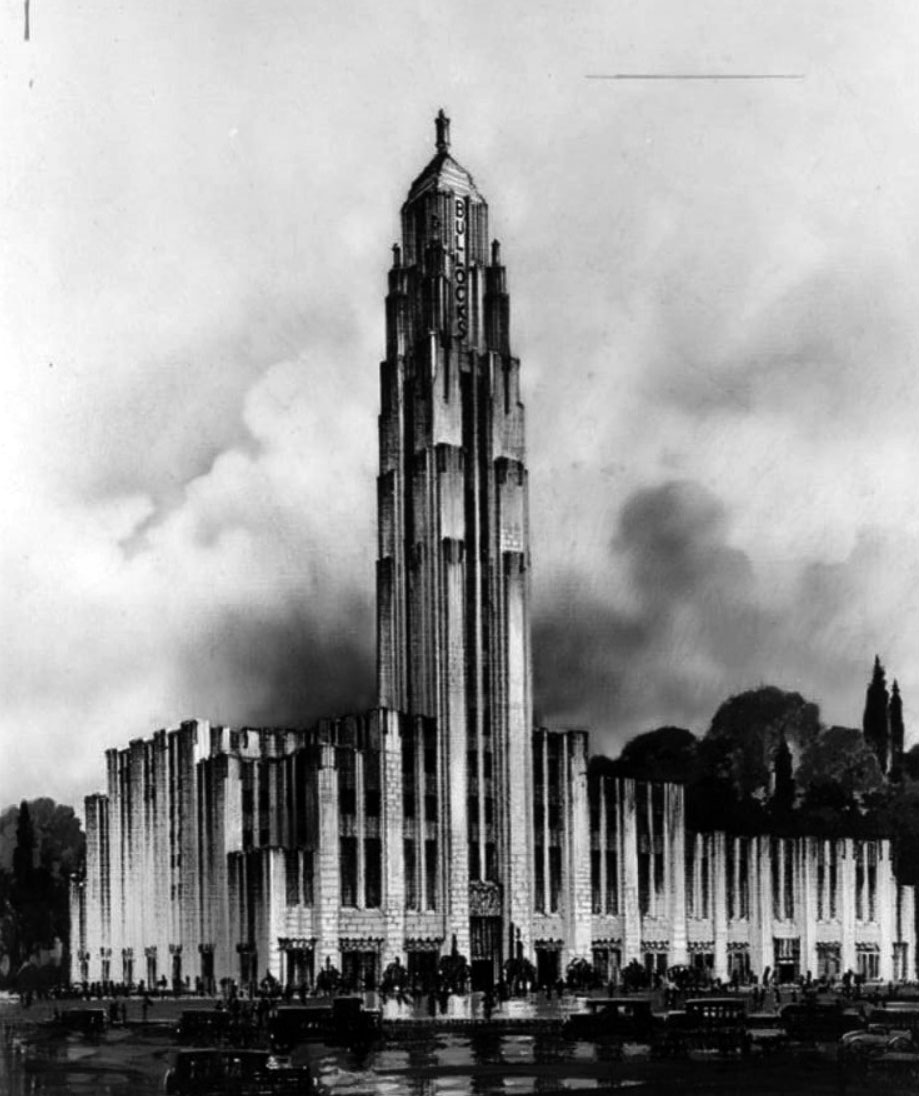 |
|
| (1928)* - Sketch of the new Bullock’s Wilshire store to be erected, as announced by John C. Bullock, president of the firm. |
Historical Notes It was conceived by business partners John G. Bullock and P.G. Winnett to house the upscale Bullock's Wilshire Department Store. But while the building’s function was an ordinary one, its creators had grand ambitions for its design. After visiting the 1925 Exposition of Decorative and Modern Arts in Paris, where the art deco, or moderne, style was introduced, Winnett and architect Donald Parkinson agreed to use this new aesthetic as the inspiration for the department store. When it opened in 1929, the building was one of the first Art Deco structures built in the United States.^ |
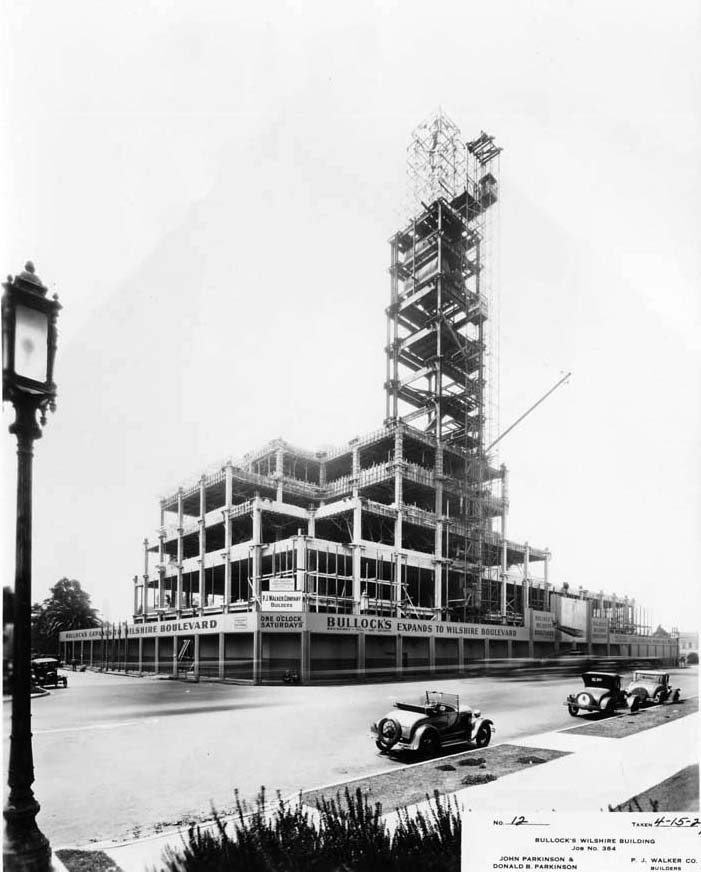 |
|
| (1929)^*# - View of the Bullock's Wilshire Building during middle stages of construction. |
Historical Notes The first Bullocks department store opened at 7th and Broadway downtown in 1907, and was a cornerstone of the elegant entertainment district that thrived there for decades. In 1929, the company expanded to the far-flung suburbs of Wilshire and Vermont, with a magnificent new tower designed by architects John and Donald Parkinson, who also brought you Union Station and Los Angeles City Hall. |
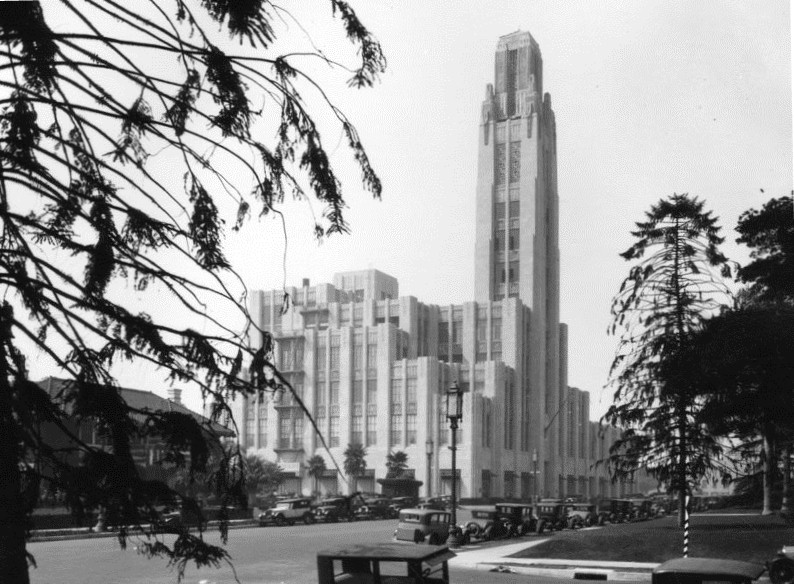 |
|
| (1929)* - View of Bullock's Wilshire department store from a block east at Virgil Avenue where it meets Wilshire Blvd. Various models of old cars are seen on both sides of Wilshire Blvd. |
Historical Notes The Bullock's Wilshire Building was designed by Architects Parkinson & Parkinson in 1928. The building was completed in 1929 as a luxury department store for owner John G. Bullock (owner of the more mainstream Bullock's in Downtown Los Angeles). The exterior is notable for its 241-foot tower whose top is sheathed in copper, tarnished green. At one time, the tower peak had a light that could be seen for miles around.^ |
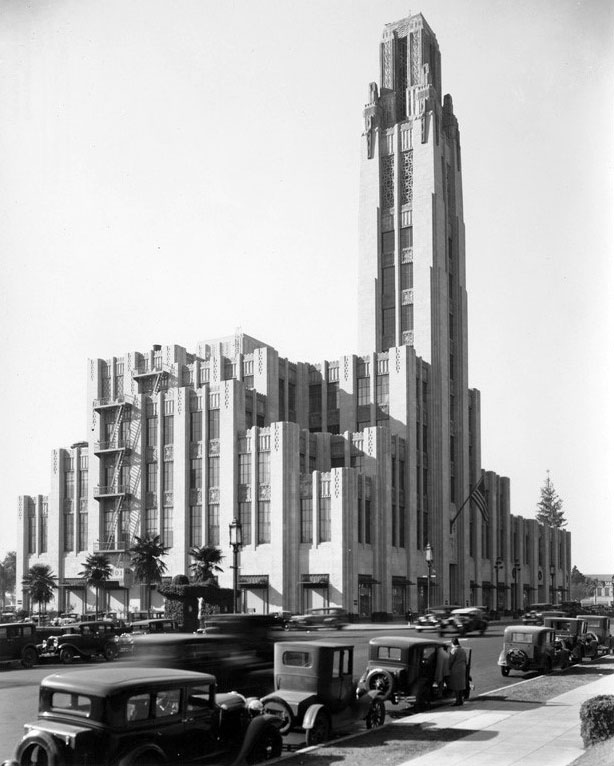 |
|
| (ca. 1929)^*# – View looking toward the southwest corner of Wilshire Boulevard and Wilshire Place showing the Art Deco style Bullock’s Wilshire. Designed by John Parkinson. Click HERE for contemporary view. |
Historical Notes The Bullock’s Wilshire building, and its beautifully appointed penthouse Tea Room, regularly drew Hollywood elites such as John Wayne, Greta Garbo, Alfred Hitchcock, Marlene Dietrich, Clark Gable and Mae West, as well as residents of the wealthy surrounding communities of Hancock Park, Windsor Square and Fremont Place. This gilded clientele helped the store survive the Great Depression, which began a month after its opening—a grand affair that drew 30,000 people.^ |
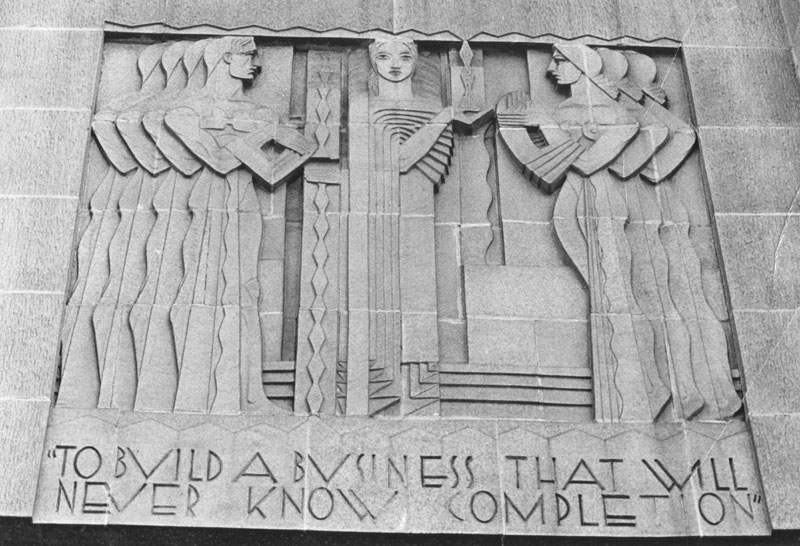 |
|
| (1983)* - Art Deco design by Cedric Gibbons, father of Oscar statuette, is above Bullock's Wilshire's overlooked front entrance. The bas-relief was designed by Cedric Gibbons and sculpted by George Stanley. |
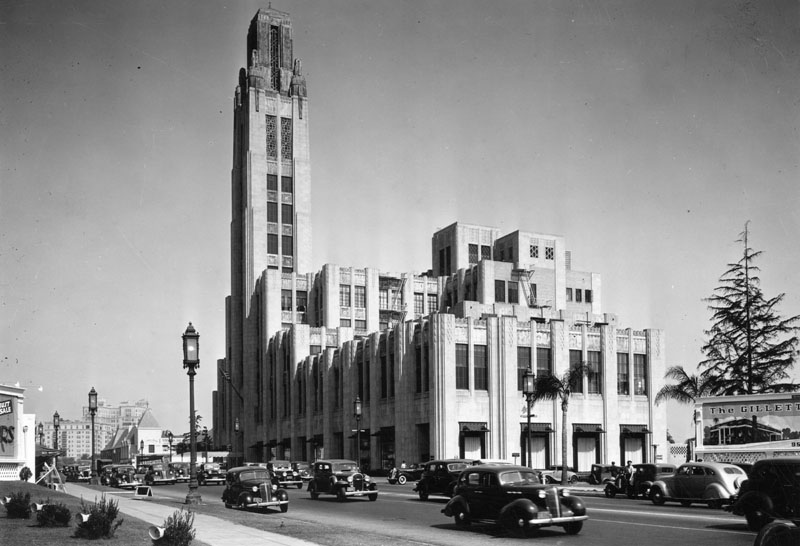 |
|
| (1936)* - View of Bullock's Wilshire from the west. Cars are seen traveling east and west on Wilshire Blvd. James Webb, Engraving and Stationery store, is present in the background on the left. |
Historical Notes Bullock's Wilshire's innovation was that it was one of the first department stores in Los Angeles to cater to the burgeoning automobile culture. It was located in a then-mostly residential district, its objective to attract shoppers who wanted a closer place to shop than Downtown Los Angeles.^ |
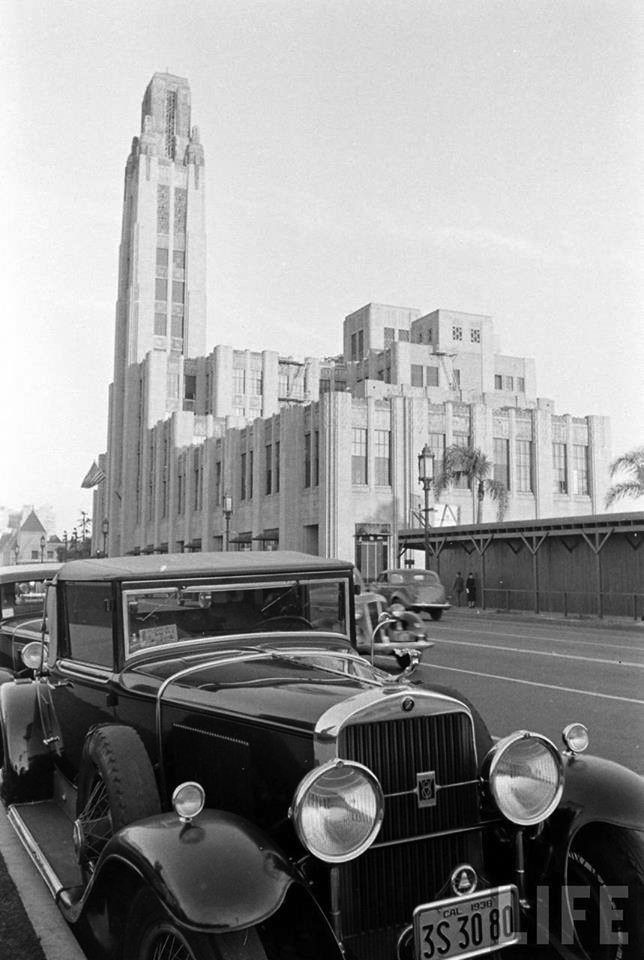 |
|
| (1938)^.^ - View showing a 1929 Cadillac V8 2-Door Convertible Coupe with Body by Fisher, Style #8680 with Bullock's Wilshire seen across the street. |
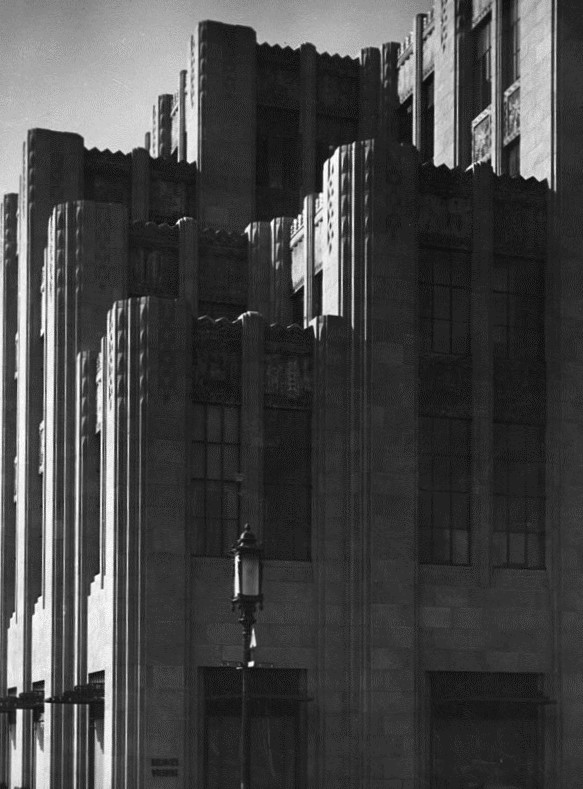 |
|
| (1938)* - Close-up view of a portion of the western side of Bullock's Wilshire. An ornate “Wilshire Special” streetlight stands in front of the art deco building. Click HERE to see more in Early L.A. Streetlights. |
 |
|
| (1946)^*# - Front view of the Bullock's Wilshire Building located at 3050 Wilshire Boulevard as seen from across the street. |
Historical Notes Traditional display windows faced the sidewalk, but they were decorated to catch the eyes of motorists. Since most customers would arrive by vehicle, the most appealing entrance was placed in the rear. Under the city's first department store porte cochere, valets in livery welcomed patrons and parked their cars.^ |
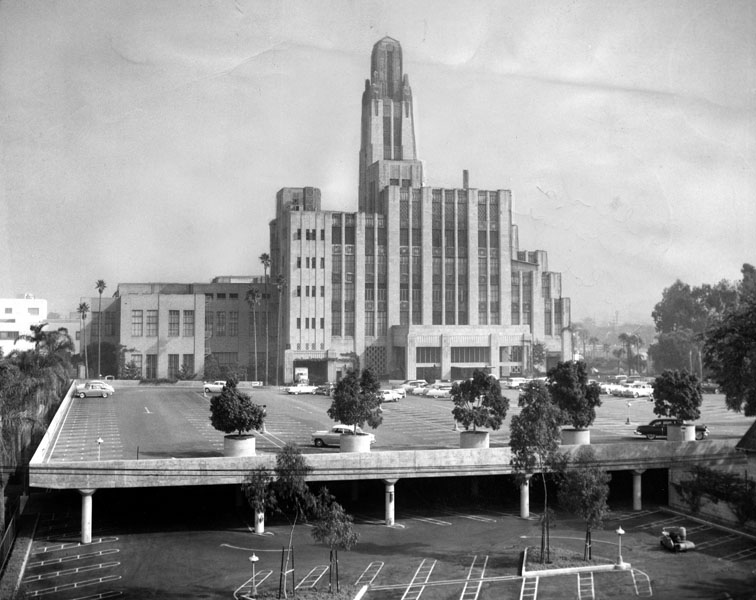 |
|
| (1950)* - Exterior view of Bullock's Wilshire store, hailed as "a cathedral of commerce" a quarter of a century ago. It was the first large store in the nation planned for the convenience of auto patrons. Beauty and utility are blended in the art deco design of the building. |
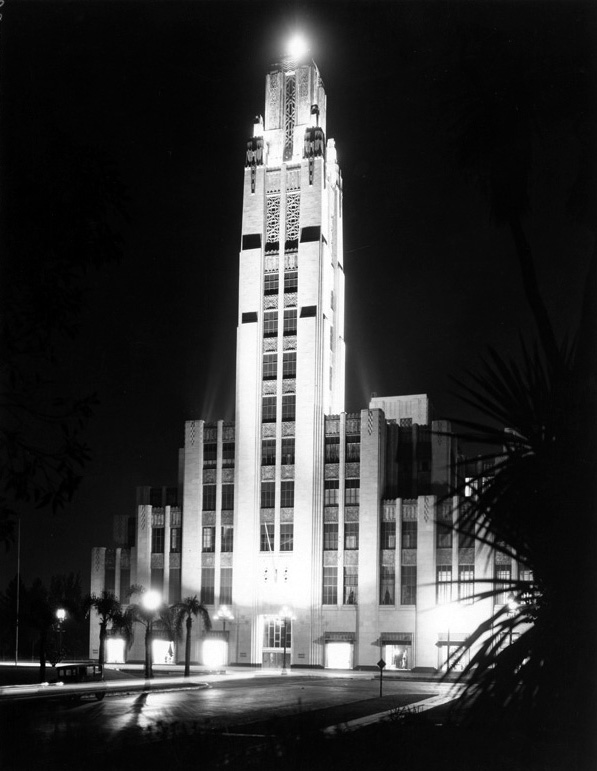 |
|
| (ca. 1933)^*# - Exterior night view of the Bullock's Wilshire Building. |
Historical Notes In 1968, the Bullock's Wilshire Building at 3050 Wilshire Boulevard was designated Los Angeles Historic-Cultural Monument No. 56 (Click HERE to see complete listing). In 1978, the building was also listed in the National Register of Historic Places as No.78000685.^ |
 |
|
| (2010s)^x^ - View showing the renovated Bullock's Wilshire Building currently owned by Southwestern Law School. |
Historical Notes After facing an uncertain future in the 1990s, the building was purchased by neighboring Southwestern Law School, which spent ten years and $29 million to restore historic elements while adapting the building for state-of-the-art academic use. This world-renowned landmark now enjoys new life as an inspirational learning environment and a prime example of adaptive reuse.^^ Because it is part of the Southwestern campus, the Bullock's Wilshire Building is not open to the public on a day-to-day basis. However, special tours are offered to Friends of Bullocks Wilshire in the summer. |
* * * * * |
Burkhard Residence
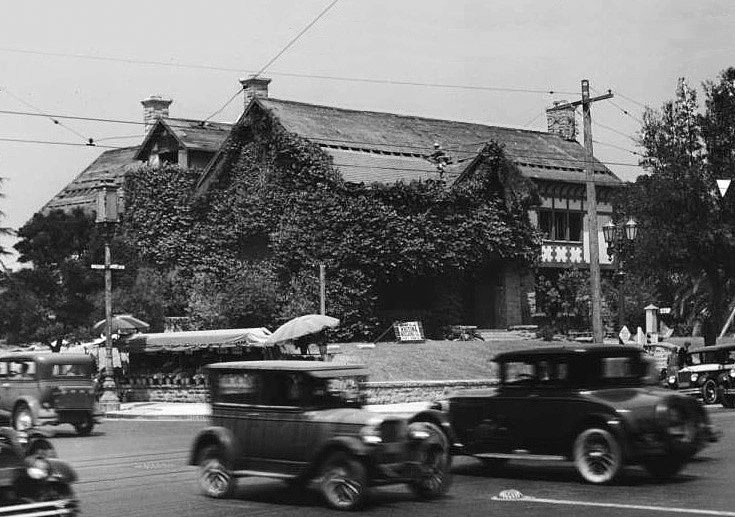 |
|
| (1928)*#* – View looking at the NW corner of Wilshire Blvd and Vermont Ave showing the Burkhard Residence in its last days of existence. The house is seen in the beginning stages of demolition. |
Historical Notes Between 1905 and 1928, the Burkhard Residence would stand on the northwest corner of Wilshire and Vermont. The lot would sit empty for a while and then be occupied by a florist shop and billboard for a short 5 years (1928 – 1933). The building that went up on the site in 1933 was first occupied by restaurateur Harry Bogen; two years later, it became a branch of the popular Carpenter's Drive-in chain. |
* * * * * |
Ralphs Market (Miracle Mile)
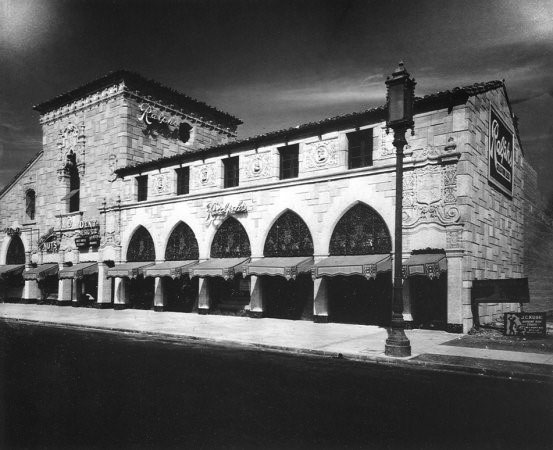 |
|
| (1928)* – View looking northwest showing the newly constructed Ralphs Grocery Store located at 5623 Wilshire Boulevard. |
Historical Notes The Spanish Colonial Revival building with a sidewalk arcade was designed by Morgan, Walls and Clements and constructed in 1928. |
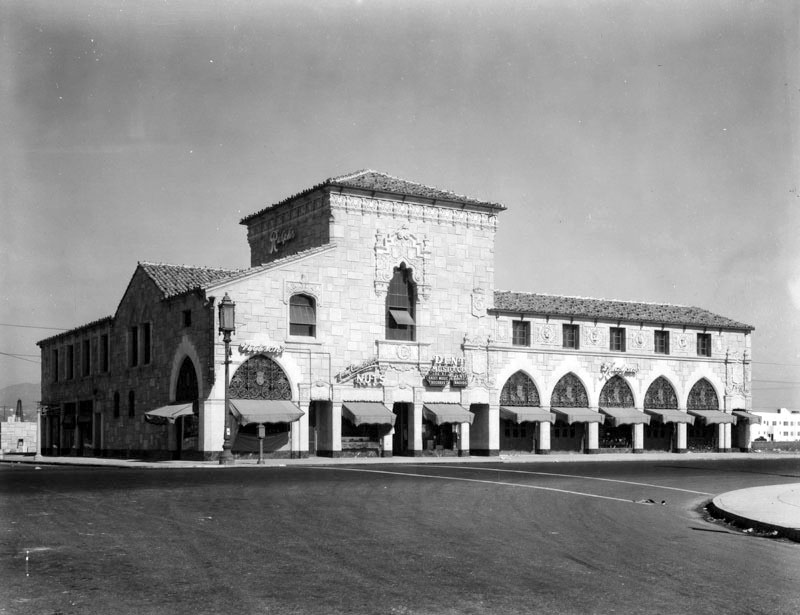 |
|
| (ca. 1928)* – View looking at the NE corner of Wilshire and Hauser boulevards showing Ralph’s Market. Small shops in the building include Dent Music Company and Tom Campbell Nuts. |
Historical Notes Founded in downtown Los Angeles by George S. Ralphs in 1873, Ralphs Grocery was a national pioneer in the grocery industry. Click HERE to see the 1st Ralphs Grocery Store. By the twentieth century, Ralphs stores featured innovative self-service aisles and included a wide variety of foods and services under one roof. As Ralphs' business grew along with the city, he hired the noted architectural firm of Morgan, Walls, and Clements to design a series of grocery stores promoting a clean and substantial image.^ |
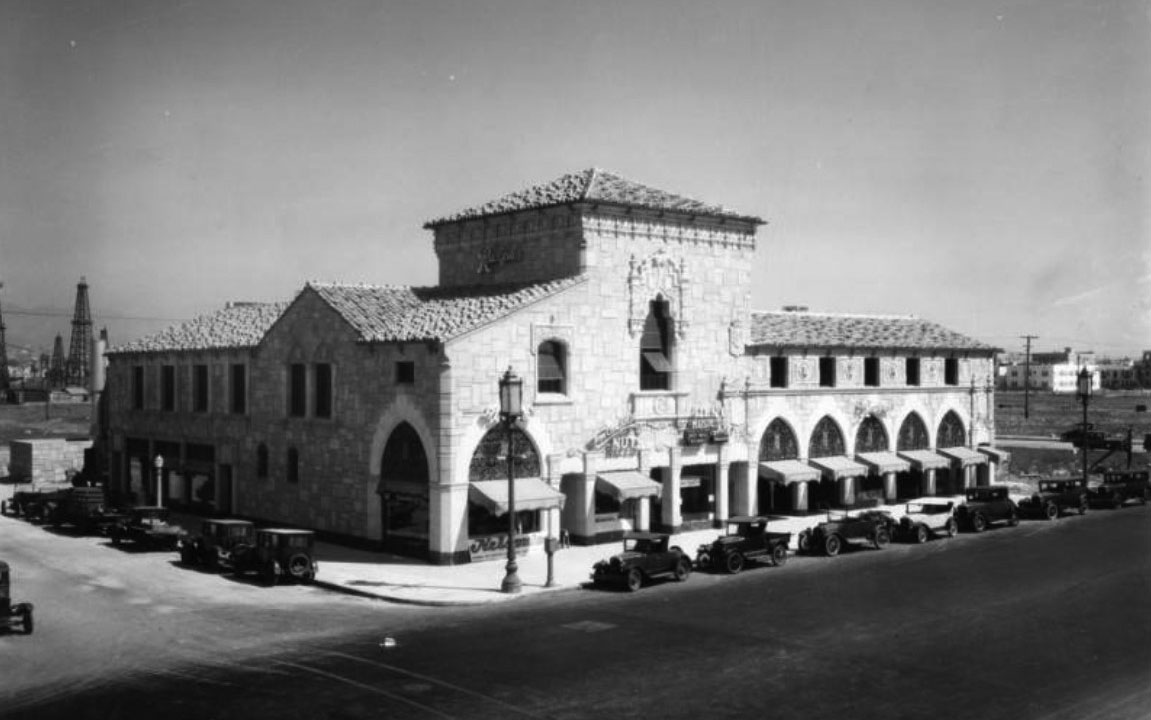 |
|
| (1928)* – View showing the Ralphs on Wilshire and Hauser soon after it opened for business. Note the oil derrick in the distance on the left. |
Historical Notes When the Miracle Mile store was constructed, the neighborhood was full of fallow fields and oil derricks. Clements' design integrated separate commercial spaces into the grocery building for rental tenants, heralding a promising future for the area while giving Ralphs another source of income.^ |
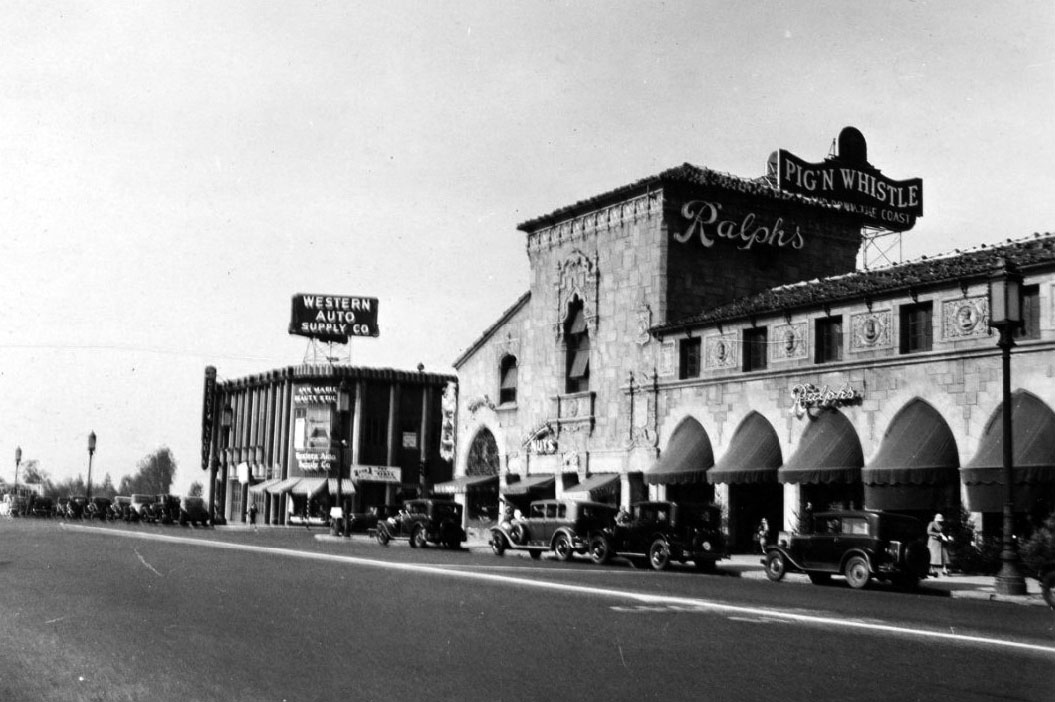 |
|
| (1932)* – View looking northeast on Wilshire toward Hauser showing Ralphs Market on the right with a new Pig’n Whistle sign on top of the building. Western Auto Supply Co. Building can be seen in the distance on the NW corner of Wilshire and Hauser. Click HERE for contemporary view. |
Historical Notes At the time, all the new Ralphs stores were built in the Churrigueresque style popular in Southern California, an ornate Spanish Revival style that architect Stiles O. Clements defined and perfected. Each of the new Ralphs was unique yet similar, exuding strength through large blocks of faux masonry, intricate wrought ironwork, prominent display windows, and Spanish tile roofs.^ |
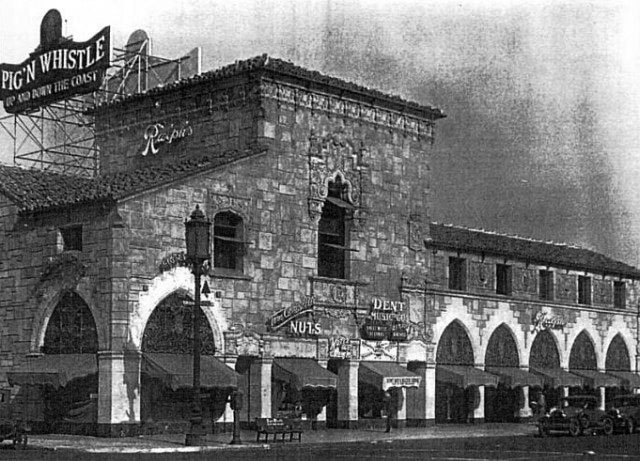 |
|
| (1930s)* - Two popular Angeleno institutions under one roof: Ralphs arcade-style supermarket on Wilshire Blvd at Hauser Blvd with a Pig’n Whistle restaurant (their neon sign says “Up and down the coast.) |
Historical Notes The Pig’n Whistle was there from 1929 to 1938, when the Pig’n Whistle company opened its new upscale restaurant, Melody Lane, at Detroit and Wilshire. |
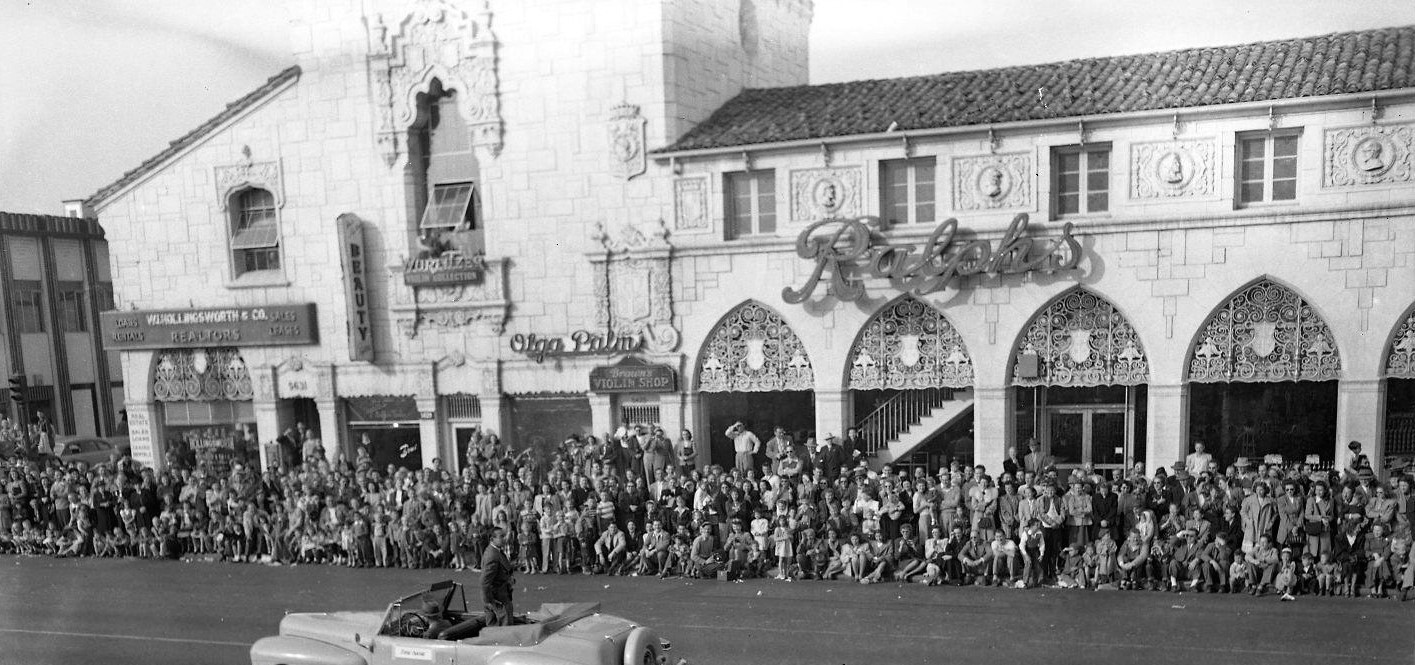 |
|
| (ca. 1950)* - View showing what appears to be a parade in front of the Ralphs Market Building at 5623 Wilshire Boulevard. |
Historical Notes The Miracle Mile quickly filled with residences and shops, increasingly in the Art Deco style that would eventually overshadow Spanish Revival as the district's distinctive architectural style. |
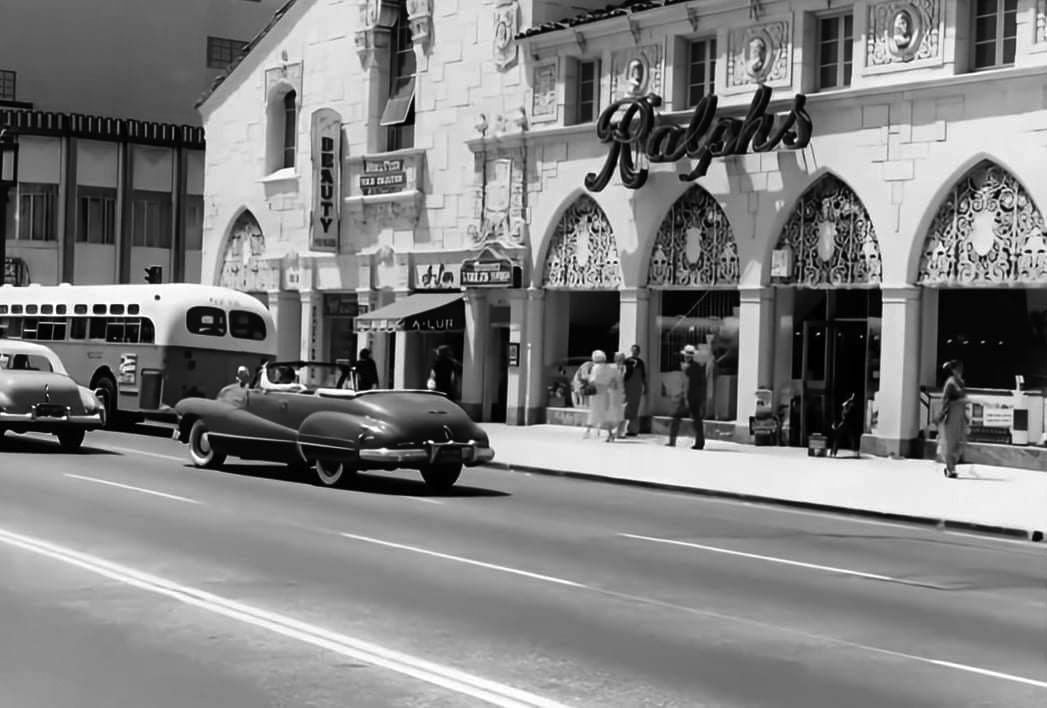 |
|
| (1950s)* - Ralph’s Market located at 5598 Wilshire Blvd. |
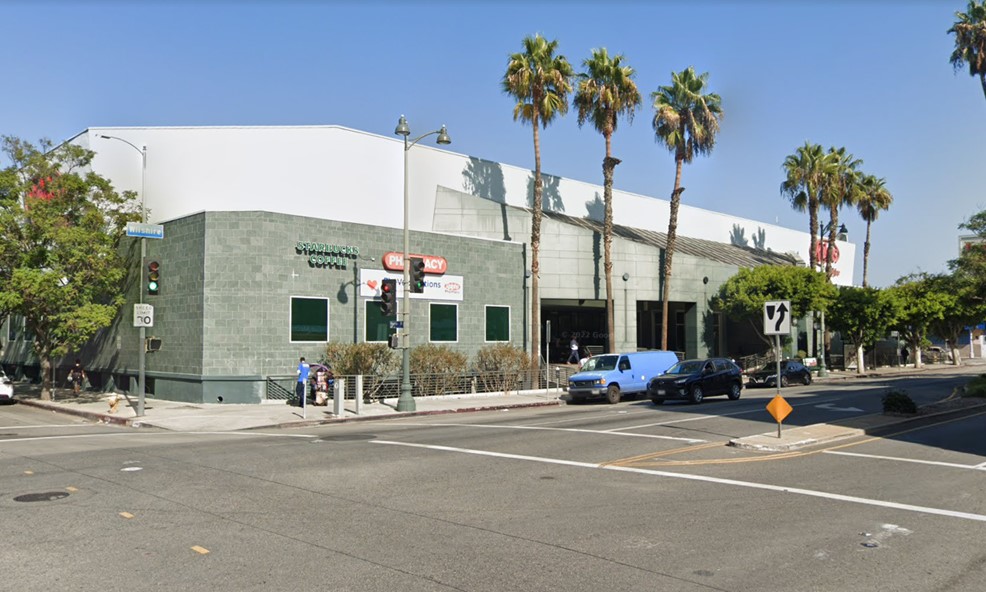 |
|
| (2021)*– View showing the new Ralphs Market located on the NE corner of Wilshire and Hauser as it appears today. |
Historical Notes In the 1980s, Ralphs fell to the wrecking ball along with its midcentury neighbor, Du-Pars Coffee Shop. Unlike the area's Art Deco structures, neither building was protected from demolition. They were replaced by a block-long Alpha Beta grocery store, which was eventually bought out by Ralphs, unintentionally bringing the property full circle.^ |
* * * * * |
Chapman Park Market (aka Chapman Plaza)
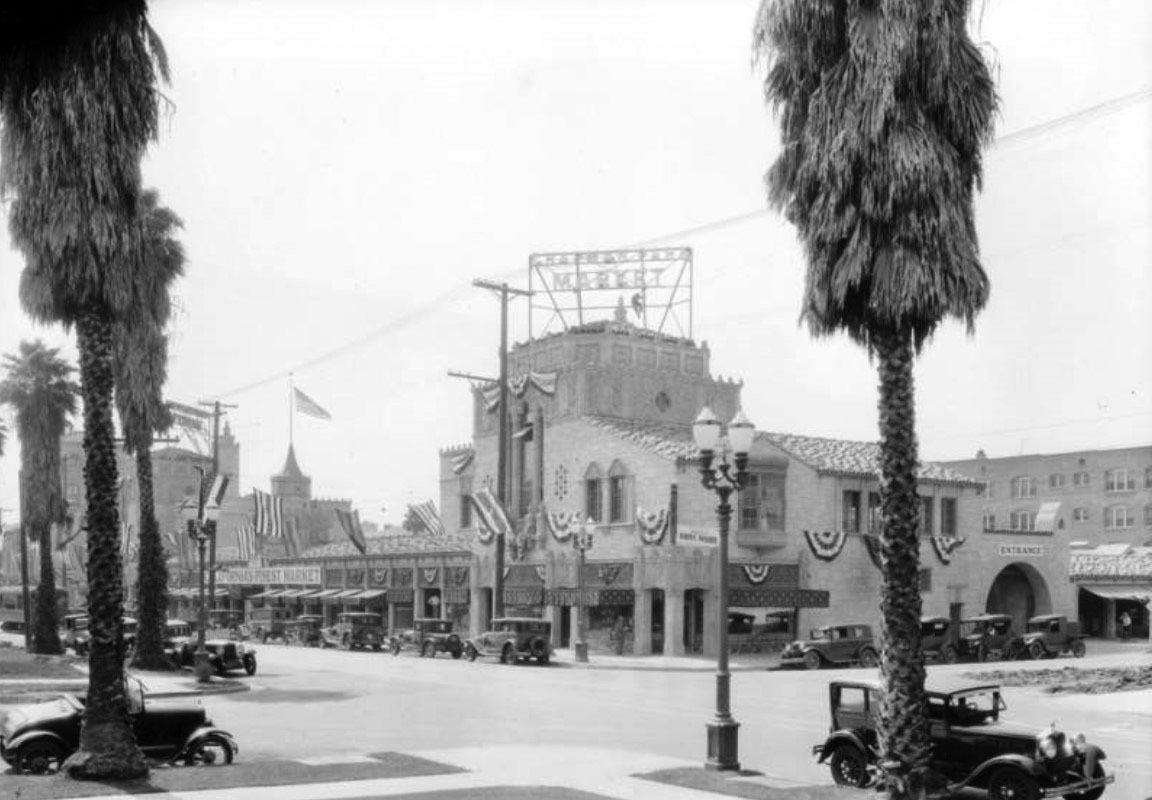 |
|
| (1929)* - View looking at the northeast corner of West 6th Street and Alexandria Avenue showing what appears to be the Grand Opening of the Chapman Park Public Market. |
Historical Notes After its construction in 1928, the Chapman Park Plaza (aka Chapman Plaza) opened in 1929 and was one of the first markets designed for easy access of automobiles. The plaza was constructed with big parking spots in the middle with numerous stores surrounding the lot. It served higher class neighborhoods such as Fremont Place, Windsor Square and Hancock Park in Los Angeles. Also, the plaza was built in set with Chapman Park Studio Building on the other side of Alexandria Avenue. ^ Charles Chapman was the first mayor of Fullerton, California and a relative of John Chapman, the legendary "Johnny Appleseed." He was a native of Illinois who had been a Chicago publisher before settling in Southern California. In 1894, Chapman moved from Chicago to Southern California, where he and his brother, Frank, soon acquired citrus and fruit ranches in Covina and the Fullerton-Placentia area. With Valencia orange trees already planted from the buds of Alfred Chapman's grove, a new family of Chapmans established themselves as pioneers in the citrus industry. Chapman was a supporter of the Disciples of Christ, who was a primary donor and fundraiser for California Christian College, which in 1934 changed its name to Chapman College, and is now Chapman University, in his honor. Chapman Avenue, a major Orange County thoroughfare, is also named in his honor.^^ Also, the Chapman Brothers donated the land on which the first church on Wilshire Boulevard was built in 1911, Wilshire Christian Church. |
 |
|
| (1929)* - View of the Chapman Park Market located on the north side of West 6th Street stretching from Alexandria to Kenmore Avenues. Built in 1928-1929, it was designed by architects Morgan, Walls and Clements. Click HERE to see contemporary view. |
Historical Notes The plaza was built during the Spanish Revival movement period in 1920s to 1930s in Los Angeles by renowned architecture firm Morgan, Walls & Clements. The architects practiced Art Deco and Streamline Moderne architecture creating buildings in Los Angeles such as the El Capitan and Mayan theaters. As one of Spanish Revival style building, Chapman Plaza has “fortress-like façade, with thick concrete walls and ornate Churrigueresque towers. The interior of the building has high ceilings, arched windows, double-wide hallways and an artisan showroom with the exterior consisting courtyard, fountains/statues, gardens patios and rooftop views.^ The market and its companion Chapman Park Studio Building across Alexandria Avenue were envisioned, along with the since-demolished Chapman Park Hotel, as fashionable anchors of the neighborhood. |
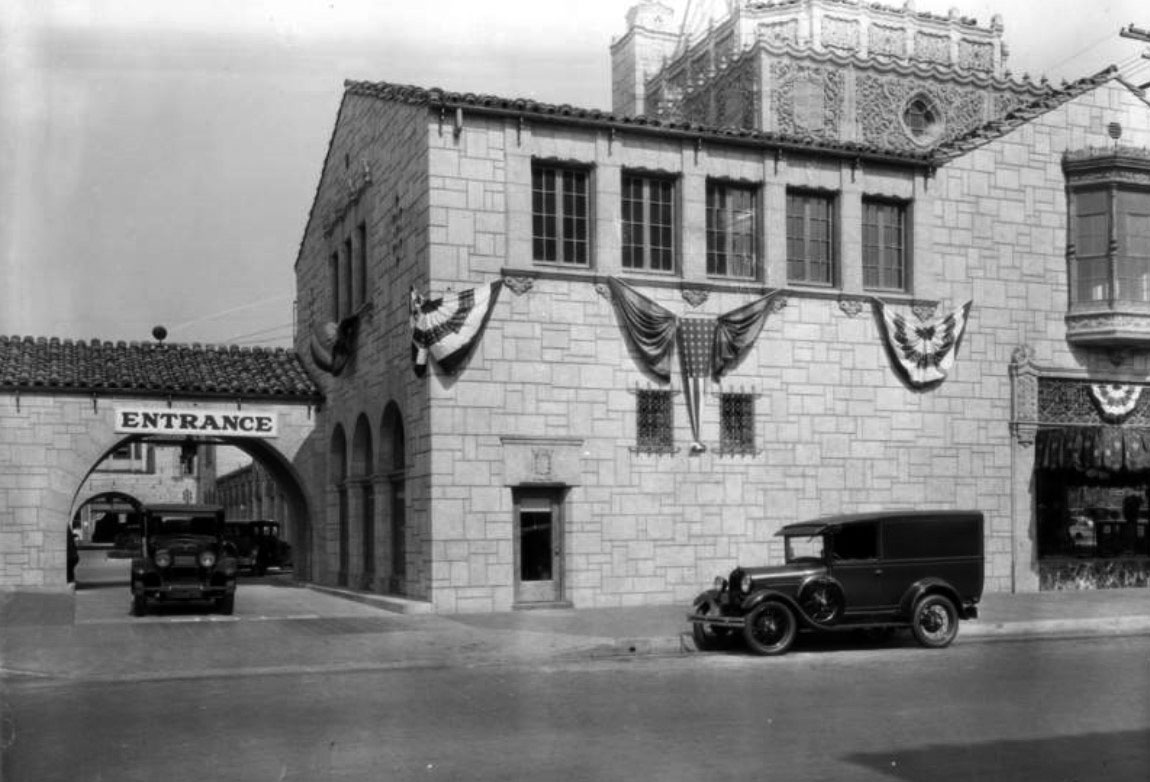 |
|
| (1929)* - View looking at the east side of Alexandria Avenue near West 6th Street (out of view to the right) showing a car exiting the parking lot in June 1929. Click HERE for contemporary view. |
Historical Notes A large rooftop sign invited motorists off Wilshire. Patrons drove in through a Spanish Revival archway to find an inner courtyard surrounded by various grocers. |
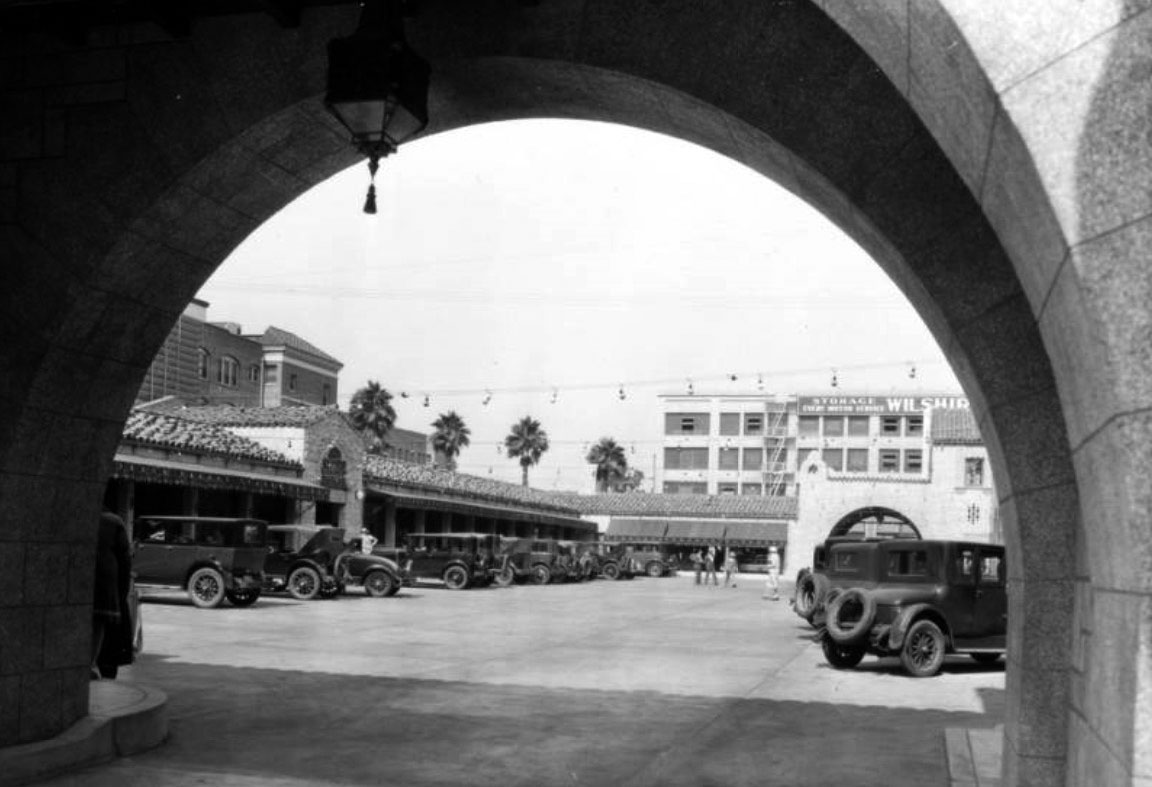 |
|
| (1929)* - View is looking from the parking entry, towards the parking facilities at Chapman Park Market. |
Historical Notes Southern California was the principal center for the development of drive-in markets between the mid-1910s to the early 1940s. Other notable early drive-in markets included: Mandarin Market (Hollywood), Plaza Market (LA), and the Sunset Clock Market (Beverly Hills). |
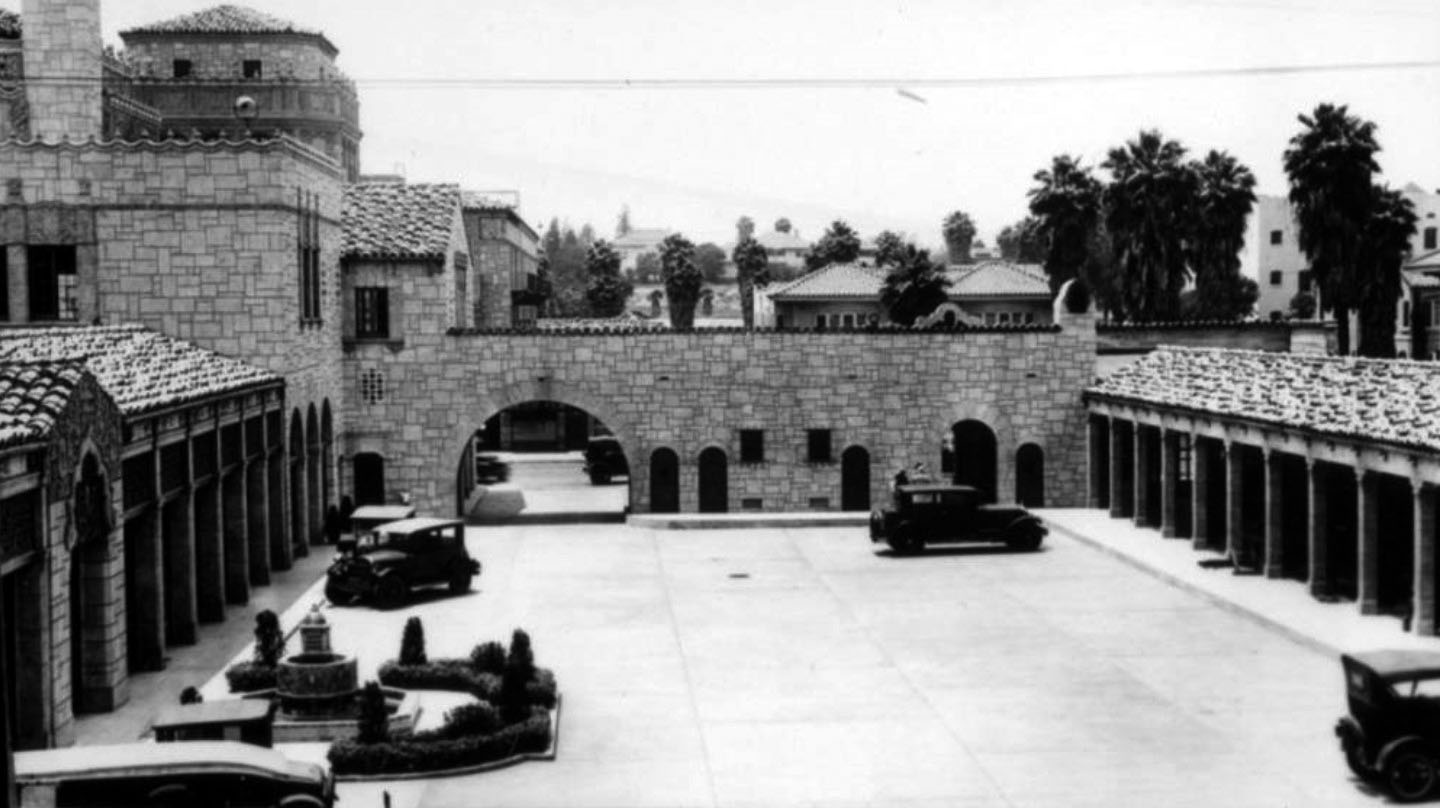 |
|
| (1929)* - Overall view of the parking facilities at Chapman Park Market on the northwest corner of West 6th Street and Alexandria Avenue (the entire block). Note fountain on the left, and the architectural design over the entrance. |
Historical Notes The market presented a fortress-like facade, with thick concrete walls worked to resemble sandstone and ornate, Churrigueresque towers on the corners. |
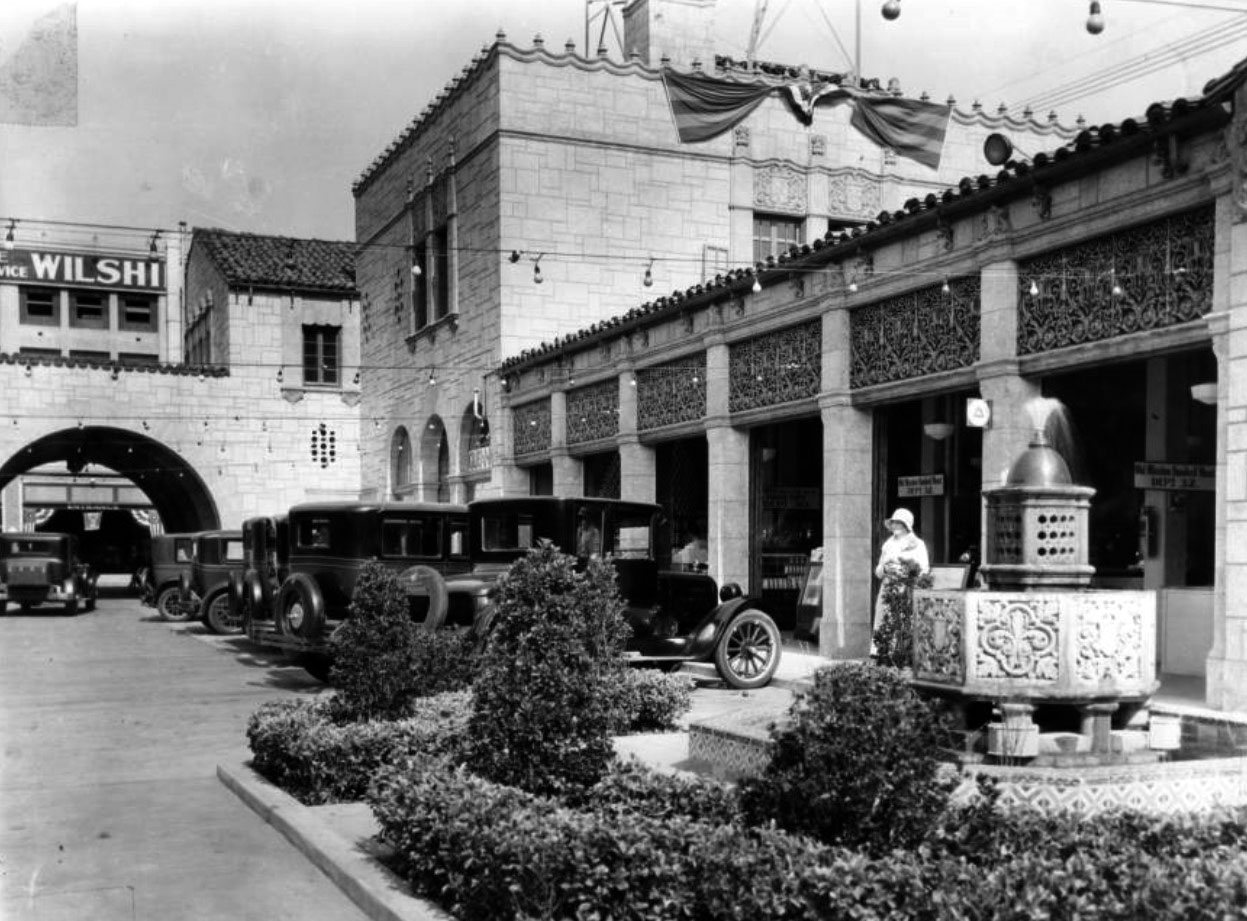 |
|
| (ca. 1929)^^ – Chapman Market, showing an interior view where cars are parked. Plants surround a fountain in the right foreground while automobiles sit parked in a row behind them at center. A woman in a lightly-colored jacket and hat stands on the sidewalk of the market building on the right. |
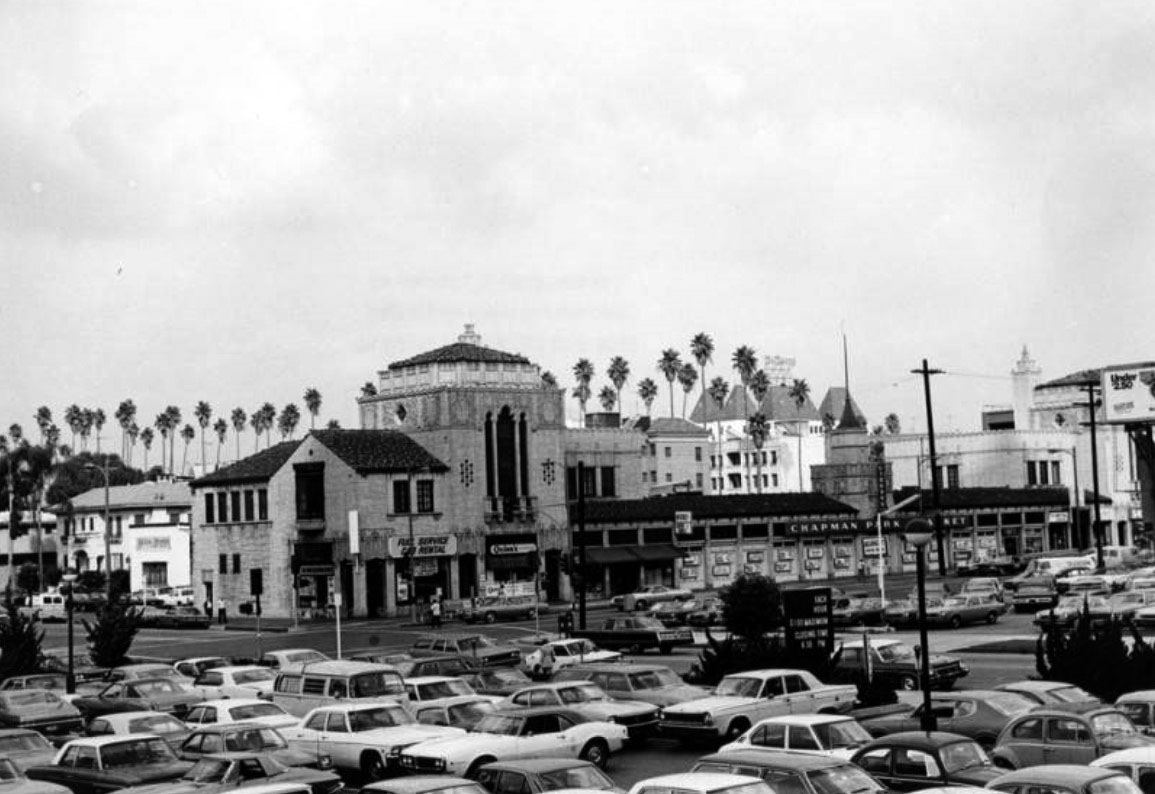 |
|
| (1974)* - View of Chapman Park Market, located on the northeast corner of West 6th Street and Alexandria Avenue, taken from the parking lot of the Equitable Building, which was originally where the Chapman Park Hotel once stood. |
Historical Notes On August 30, 1988, the building was named as Los Angeles Historic-Cultural Monument No. 386. Chapman Plaza was planned for renovation with $4.5 million budget in order to transform the space into a “place of beauty and an urban meeting ground” and bring back the “charm of early Los Angeles”. It went through big renovation project in 1990 with The Ratkovich Company (owned by Wayne Ratkovich) and architect Brenda Levin^ |
 |
|
| (2013)*^ - Panoramic view showing the Chapman Plaza with Chapman Park Studio Building on the left, 3451 W. 6th Street. Photo by Downtowngal via Wikipedia |
Historical Notes In 2016, Chapman Plaza was sold to new owner ArcWest Partners who proposed to “restore the structure to ‘its historic grandeur’” including some of the historic elements like the façade. Chapman Plaza continues to be one of the remaining Spanish Revival style architecture in Los Angeles. |
Chapman Park Stuidio Building
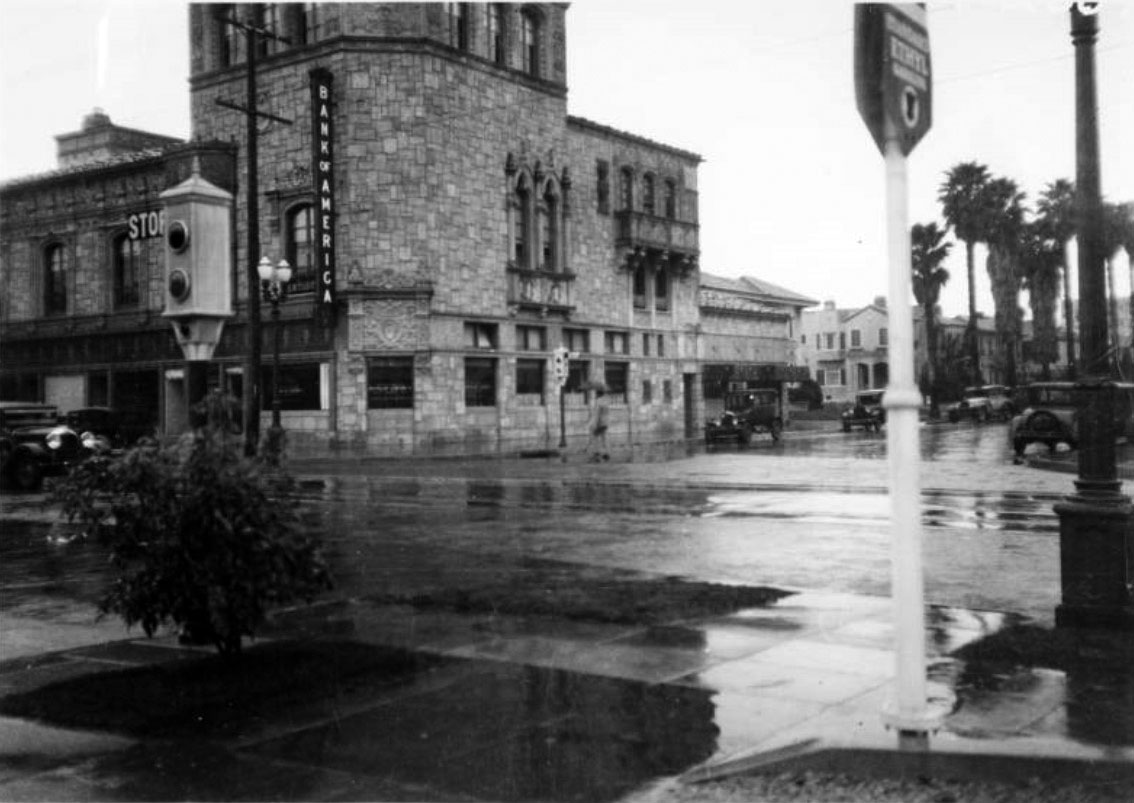 |
|
| (ca. 1929)*# – View looking at the NW corner of 6th Street and Alexandria Avenue showing the Chapman Park Studio Building on a rainy day. Sign on side of building reads: Bank of America. |
Historical Notes The Chapman Park Studio building was designed by famed architects Morgan, Walls, and Clements and is an example of Spanish Revival architecture. The Churrigueresque style buildings of both Chapman Park Studio and the neighboring Chapman Park Market were owned by the Charles C. and S.J. Chapman Company. Charles C. Chapman and the Charles C. and S.J. Chapman company owned many significant buildings in Los Angeles in the early 1900s including Chapman’s residence at Figueroa and West Adams which later became the headquarters for AAA, the Charles C. Chapman building in Downtown Los Angeles (original headquarters for Bank of America), Chapman Market and the Chapman Park Studio building. # |
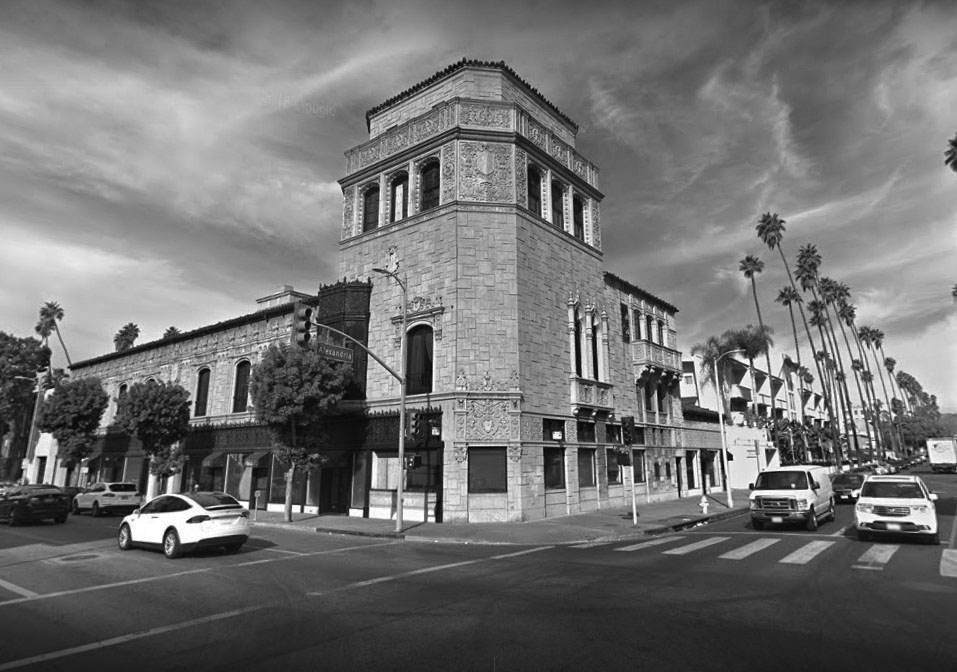 |
|
| (2014)^* – View looking northwest showing the Chapman Park Studio Building at 6th Street and Alexandria Avenue. |
Historical Notes On July 24, 1984 the Chapman Park Studio Building was granted historical status and designated as Los Angeles Cultural Historic Monument No. 280. |
* * * * * |
Walt Disney Studios (1926 - 1940)
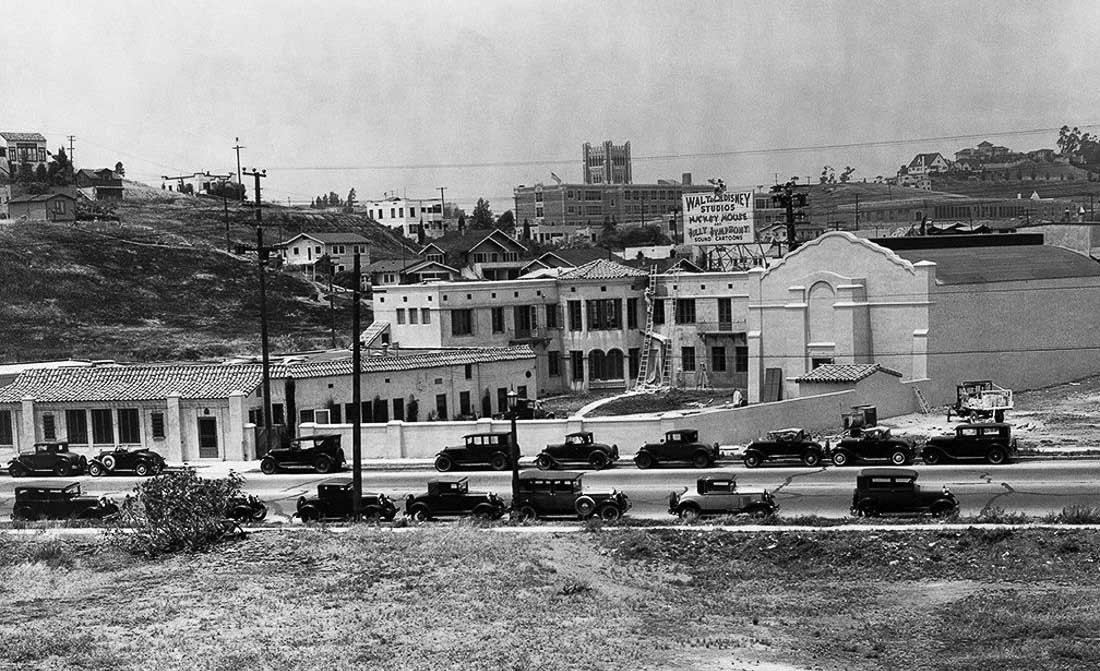 |
|
| (ca. 1931)^.^ - View looking west showing the original Disney Studio located at 2710 - 2729 Hyperion Avenue in Los Feliz. Marshall High School (built 1930 – 1931) is seen in the background. Today, a Gelson’s Market and shopping center is located where the Disney Studio once stood. Also, a Trader Joes now stands in the empty lot seen in the foreground. Click HERE to see satellite map. |
Historical Notes Prior to the official opening of the Burbank lot in 1940, the Walt Disney Studios was situated at several different locations in Los Angeles. During summer 1923, Walt Disney created "The Disney Bros. Cartoon Studio" in his uncle Robert Disney's garage, which was located at 4406 Kingswell Avenue, in the Los Feliz neighborhood of Los Angeles (just east of Hollywood). During October 1923, Walt Disney and his brother (Roy) leased office space on the rear side of a real estate agency's office at 4651 Kingswell Avenue. In February 1924, the studio moved next door to an office of its own at 4649 Kingswell Avenue. The late Robert Disney's residence and the small office building that is home to 4649 and 4651 Kingswell Avenue have survived to the present and are still in use. In 1925, Walt Disney placed a deposit on a new, considerably larger lot at 2719 Hyperion Avenue, and the studio moved there in January 1926. It was here where, after a train journey with his wife Lillian, Walt fully created the character of Mickey Mouse in 1928. The first color animated film, the Silly Symphony Flowers and Trees and the first animated cartoon using the multiplane camera, The Old Mill was created.*^ |
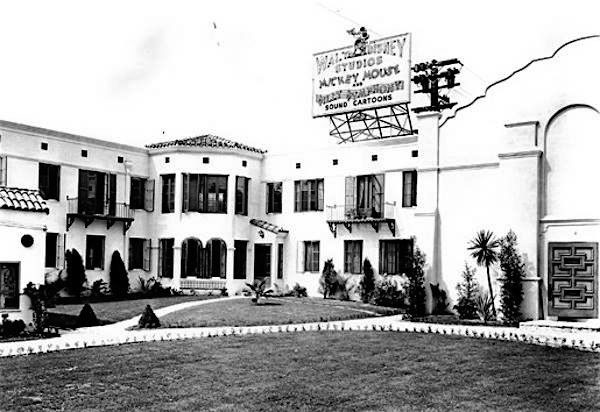 |
|
| (1931)+#+ – Close-up view showing the Disney Studio on Hyperion Ave in Los Feliz. Note how Mickey Mouse is prominently featured on the sign. |
Historical Notes In 1937, the Hyperion studio produced the world's first full-length animated feature film, Snow White and the Seven Dwarfs. Disney's staff began to grow to a substantial size at the Hyperion studio, and Disney Legends such as Disney's Nine Old Men began their careers there. |
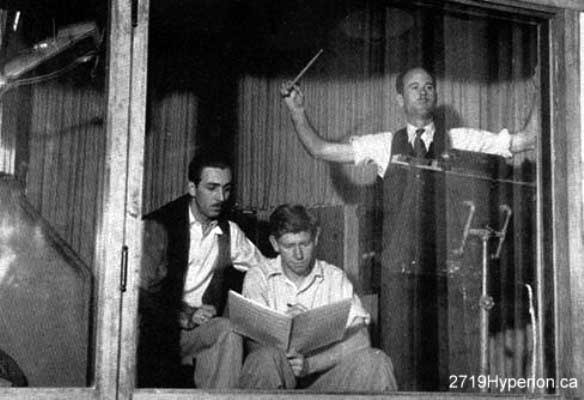 |
|
| (ca. 1930s)*v* - Walt Disney, animation director Wilfred Jackson, and music composer Frank Churchill in the Sound Stage Monitor Room. Image courtesy of David Lesjak. |
Historical Notes By 1939 there was no more room to grow on the Hyperion Studio lot. By this time, the Disney Studio had 1,500 employees and the layout of the Hyperion Studio was so haphazard there was a feeling among some that the Hyperion Studio could no longer meet the goals of the Disney Studios. |
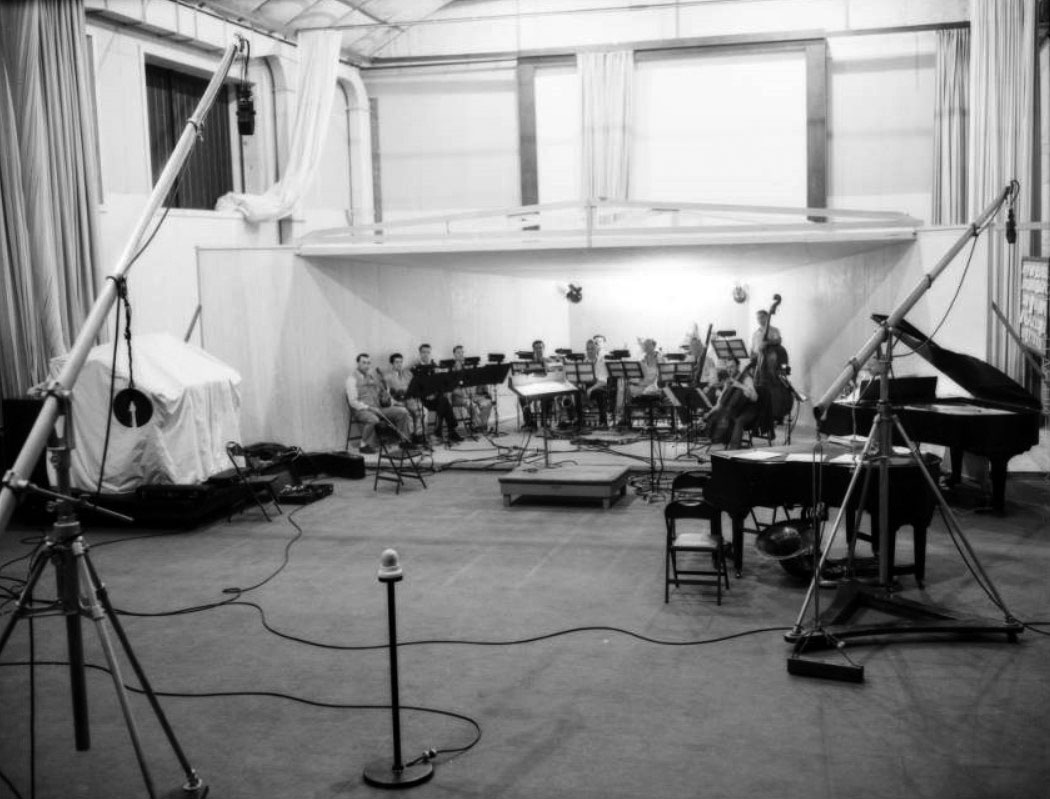 |
|
| (1935)^^ – Interior view of the Los Feliz Disney Studio showing a sound recording stage with an 11-piece orchestra. |
Historical Notes In June of 1938, Walt and Roy paid a $10,000 deposit for a 51 acre plot of land in Burbank and construction on a new studio began shortly afterwards. In the fall of 1939, the first staff moved into the new Burbank studios. The Hyperion studio site was sold in 1940 and divided between two different industrial manufacturers, and in 1966 a subsequent owner demolished what was left of the studio complex and replaced it with the supermarket and shopping center that stand there today. To honor the company's former headquarters from 1926 to 1940, the name 'Hyperion' has been reused over the years by the Walt Disney Company for multiple divisions and attractions, including Hyperion Books and the Hyperion Theater at Disney California Adventure Park.*^ During the Hyperion Studios short 14 years, Oswald the Lucky Rabbit, Mickey and Minnie Mouse, Donald Duck, Snow White, Pinocchio and many more beloved characters were given life. In many ways, the Hyperion Studios represents “the golden age” of Walt Disney’s imagination. ^ |
Now and Then
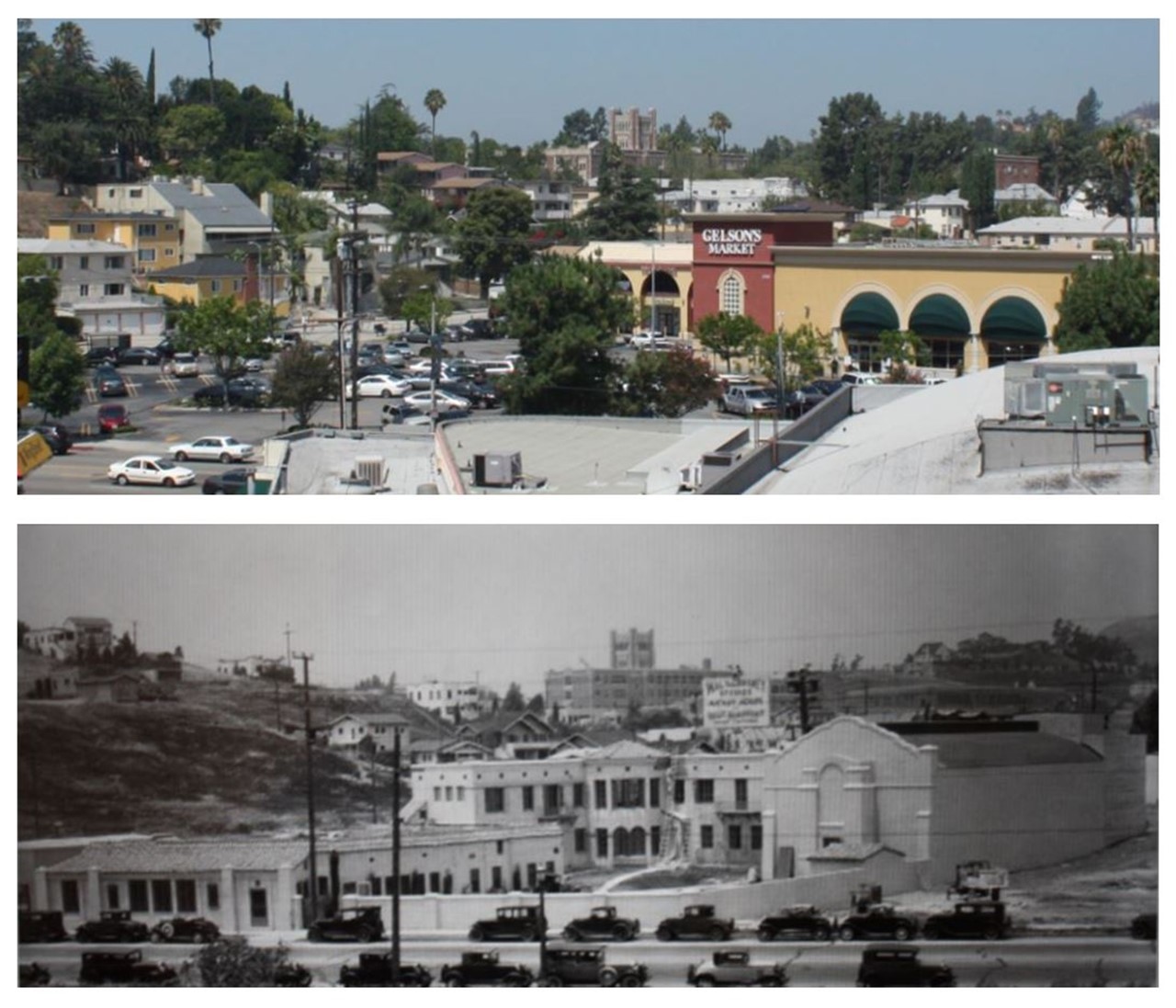 |
|
| (1931 vs 2020)* |
* * * * * |
Hattem's Market (Western and 45th - LA's 1st Supermarket)
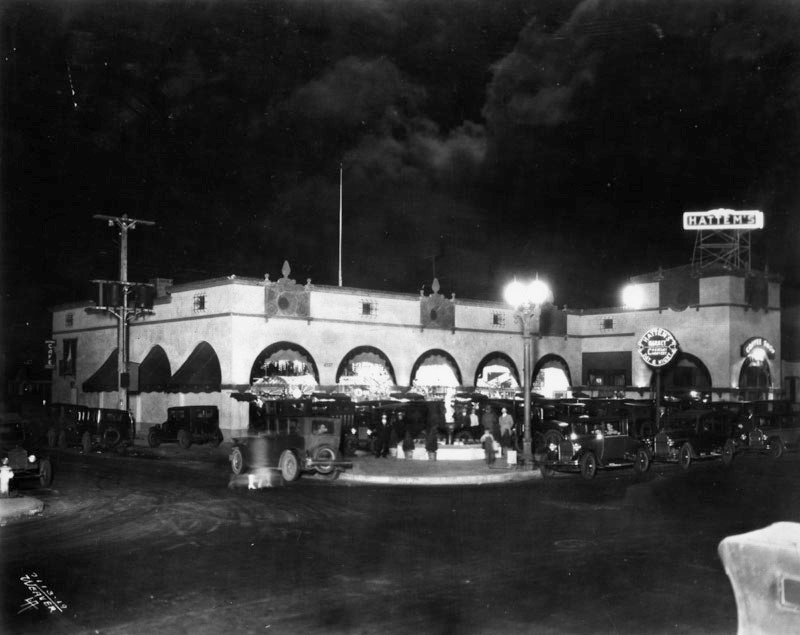 |
|
| (1927)* - View showing Hattem's Market on Western Avenue on Opening Night. |
Historical Notes Hattem's 24-Hour Drive-In Market was Los Angeles' first supermarket and possible the first grocery store to use trading stamps. Owned and operated by European immigrant, Isadore M. Hattem, it was located at the corner of 43rd Street and Western Avenue and was designed by Walter R. Hagedohm with construction costs around $30,000. It opened on December 27, 1927, and resulted in the coining of the word "supermarket" when the Southwest Wave, a community newspaper described its grand opening.* |
 |
|
| (1927)* - Hattem's Market, located on the corner of Western Avenue and 45th Street, decorated for opening ceremonies. |
Historical Notes Walter Roland Hagedohm was the architect who also designed Hattem's Shopping Center located on Vermont and 80th Street about four years later. In between, he designed the Balboa Inn of Newport Beach, which became a trendy getaway of Hollywood movie stars in the 1930s.* |
Hattem's Market & Shopping Center (Vermont and 81st)
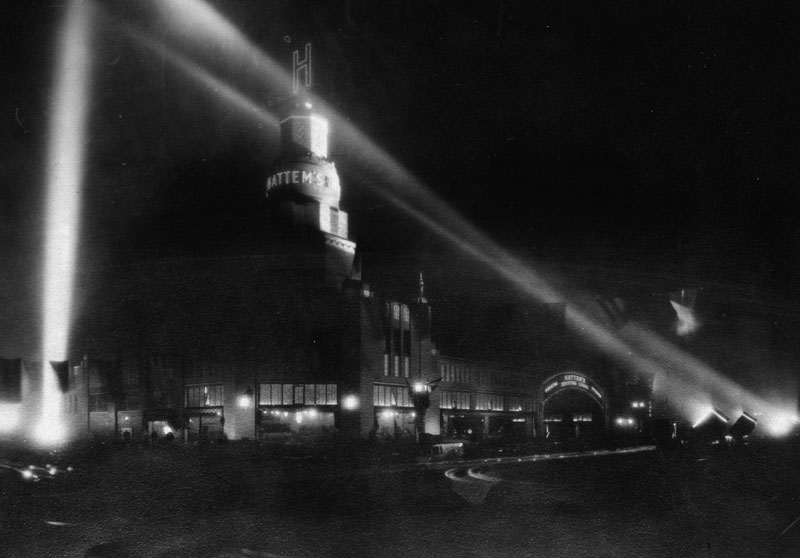 |
|
| (1931)* - Opening ceremonies at Hattem's Market and Shopping Center located on Vermont and 81st Street. |
Historical Notes Hattem's 24-Hour Drive-In Market was one of Los Angeles' first supermarkets. It was owned and operated by European immigrant, Isadore M. Hattem. The shopping complex, including the beautiful cake-like tower building, was designed by Architect Walter Roland Hagedohm who also designed Hattem's 1st 'Supermarket' four years earlier. It was located on Western and 45th Street. Isadore M. Hattem (originally spelled Hatem, but he changed it during the WWI years) was a Sephardic Jew and founding member of what is now the Sephardic Temple Tifereth Israel. Before opening his supermarket, Hattem was one of the early merchants in the Grand Central Market, which opened in 1917. |
.jpg) |
|
| (1931)* - Exterior view of Hattem's Drive-in Market at 8021-8035 South Vermont Avenue. The market building, which resembles a tiered cake with what appears to be a cupola, is topped-off with a large letter 'H'. |
Historical Notes Hattem’s was one of the first self-service markets in Los Angeles. Piggly-Wiggly in Tennessee was the first self-service market, but the trend spread west. I.M.Hattem had the first "Supermarket", the key difference being, the groceries, meat, produce, and bakery departments were all self-service and wrung up at a central check out. He also had trading stamps, and the market had a parking lot for cars, shopping carts and it was open 24 hours a day. |
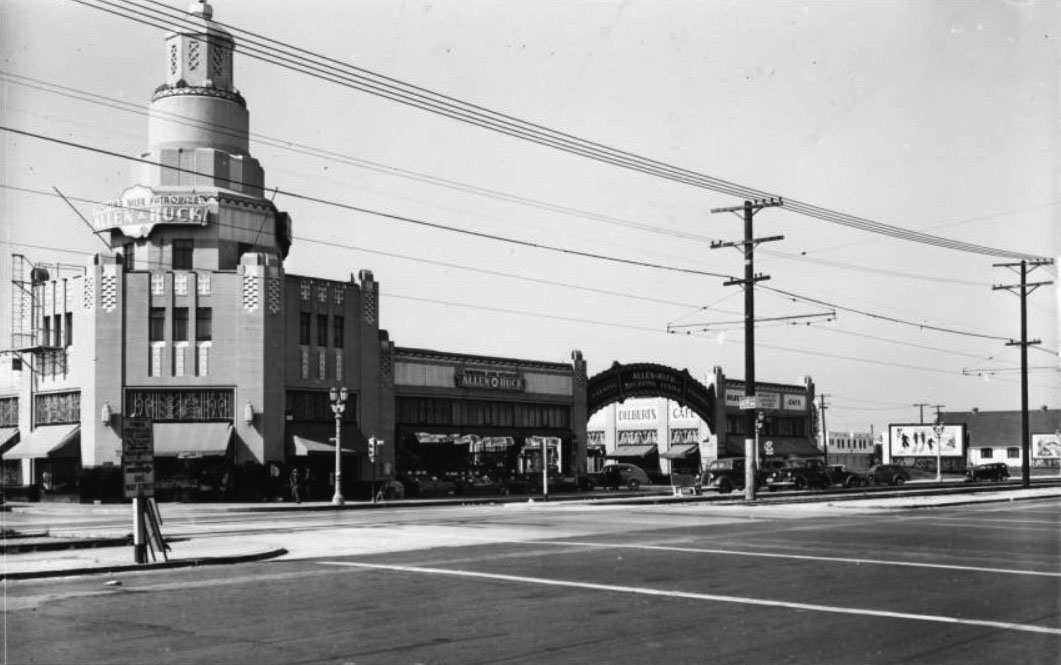 |
|
| (ca. 1940)^ – View showing the Allen and Huck Market (previously Hattem’s Market) located on the NW corner of Vermont Avenue and 81st Street. A large sign located on the second tier reads, "Shoppers Wise Patronize Allen and Huck". The structure extends to an archway a little right of center that leads to the parking lot and the storefront of Dilbert's Café. |
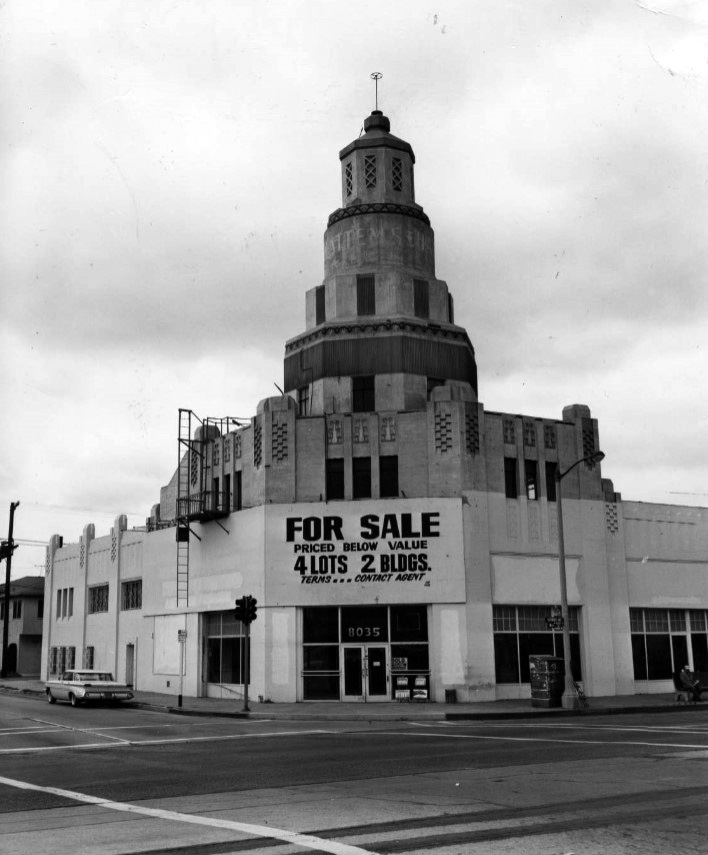 |
|
| (1961)^ - Hattem’s with a large ‘For Sale’ sign on front of building, 8039 S. Vermont Avenue. |
Historical Notes This building, formerly owned by a business enterprise, was sold to Pepperdine College along with a second building and four lots in 1961. Located down the road from the main campus on the corner of 81st Street and Vermont Ave., Los Angeles, this complex housed new administrative offices, more classrooms, and a coffee shop. This image captures the state of the building before it was remodeled for Pepperdine use. |
Pepperdine Adminstration Building (Previously Hattem's Market)
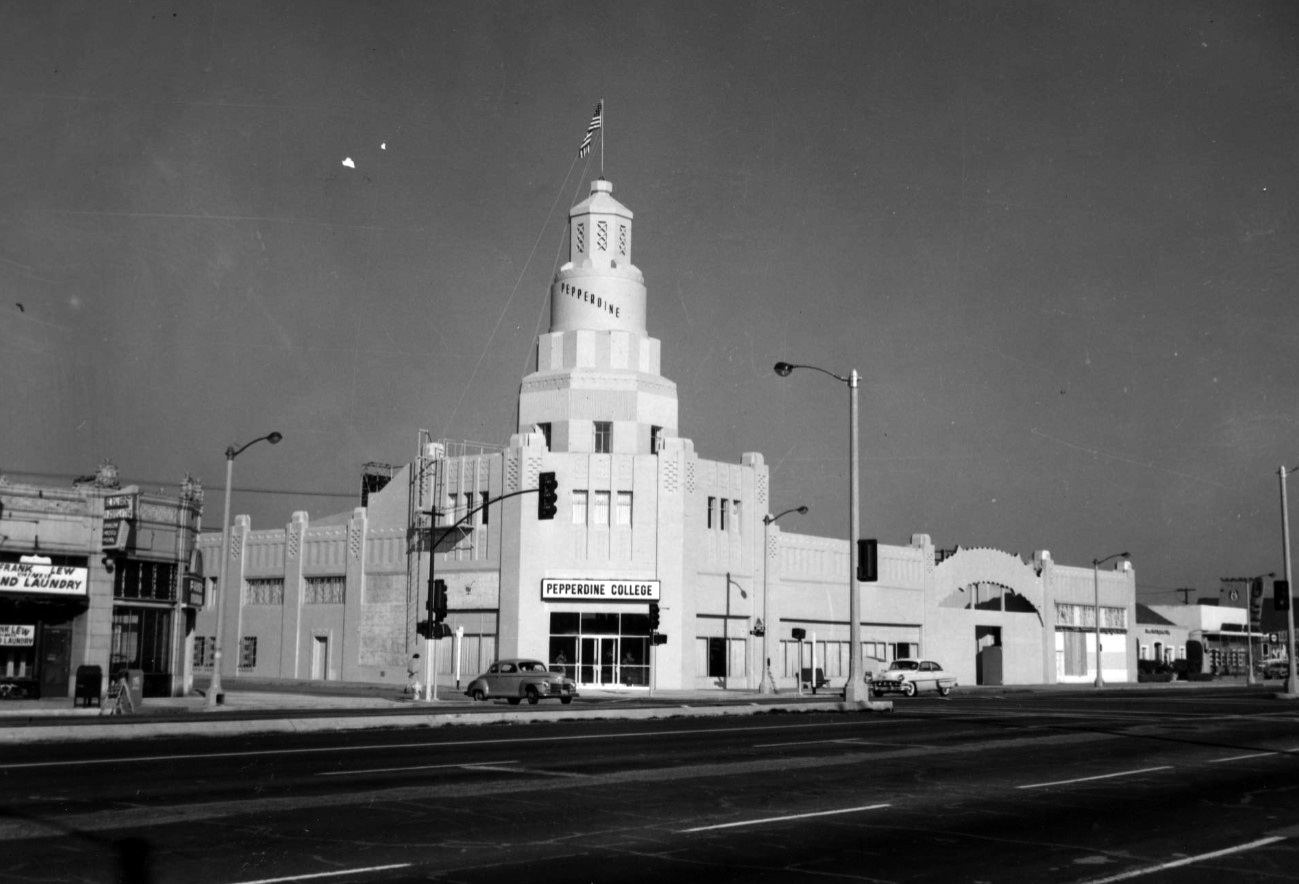 |
|
| (ca. 1962)^ – View showing the new Pepperdine College Administration Building (formerly Hattem’s Market). |
Historical Notes The second site for Pepperdine College's Administration Building was originally this shopping center complex at Vermont Avenue and 81 Street, just around the corner from the original southwest Los Angeles campus. Built originally in 1930 by I. M. Hattem as a "drive-in market"--a precursor to today's shopping malls--Hattem's Shopping Center was purchased by Pepperdine College in 1961. |
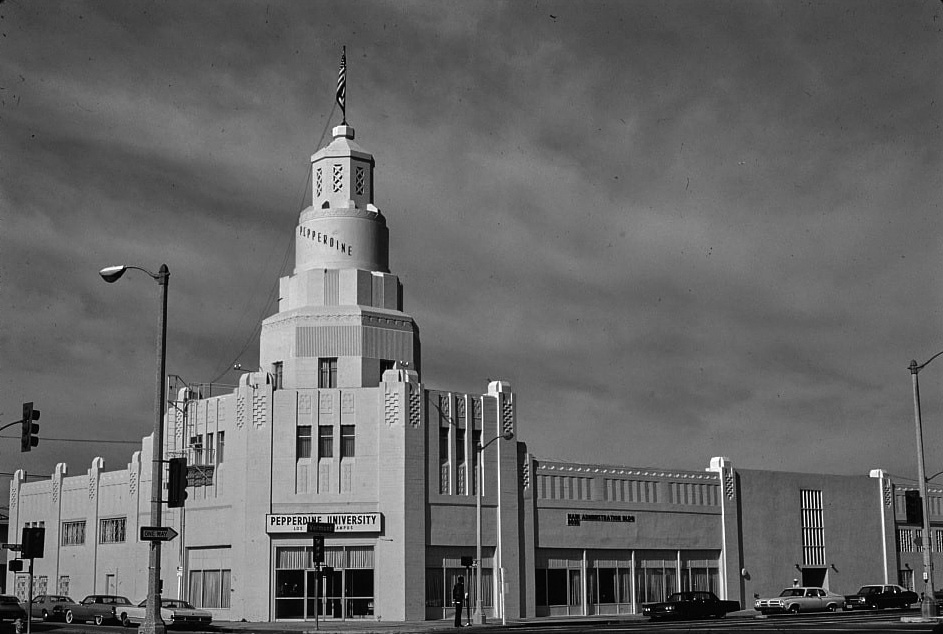 |
|
| (ca. 1971)^ – View showing the Pepperdine Administration Building located on the NW corner of Vermont and 81st Street. |
Historical Notes Pepperdine was founded by entrepreneur George Pepperdine in South Los Angeles in 1937, the school expanded to Malibu in 1972. George Pepperdine built his fortune largely through the Western Auto Supply Company, which he founded in 1909 with a $5 investment.* The main tower-building still exists today and is occupied by a Scientology Community Center. Click HERE for contemporary view. |
Then and Now
 |
|
| (1962 vs 2021)* - Pepperdine College located on the NW corner of Vermont and 81st Street, today a Scientology Community Center. |
* * * * * |
Plaza Market
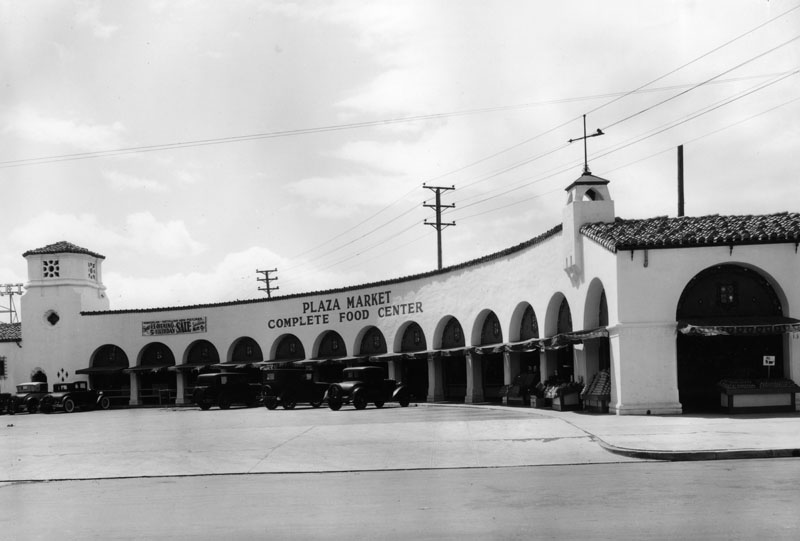 |
|
| (ca. 1929)* - Exterior view of Plaza Market, a Spanish-Colonial style drive-in market located at 4651-4663 Pico Boulevard. |
Historical Notes Los Angeles was the principal center for the development of drive-in markets between the mid-1910s to the early 1940s.^^^ |
* * * * * |
Mandarin Market (later Hollywood Ranch Market)
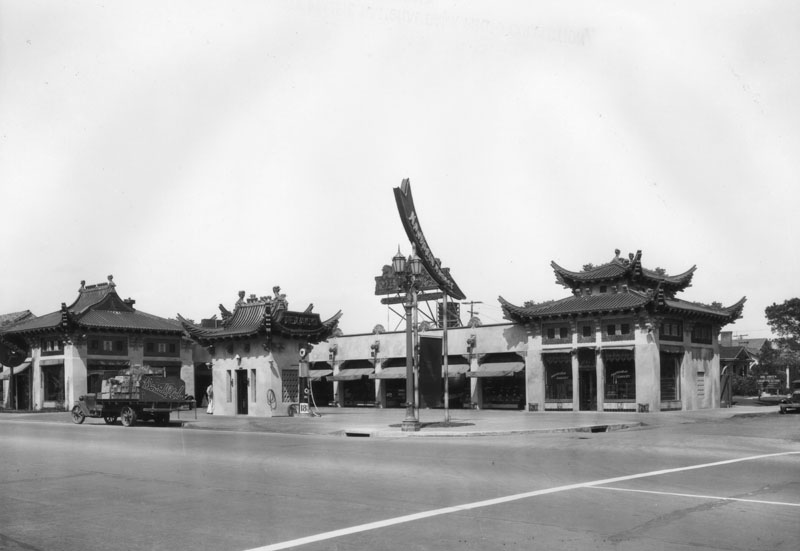 |
|
| (1929)* - Corner view of the Mandarin Market, a Chinese-style drive-in market located at 1234-1248 Vine Street, in Hollywood. A delivery truck full of crates of "Dorado Club," a brand of club soda, is parked on the street. |
Historical Notes The Mandarin Market with its unique Chinese profile, was designed by M. L. Gogerty and built in 1928-1929. It would later become the Hollywood Ranch Market.* |
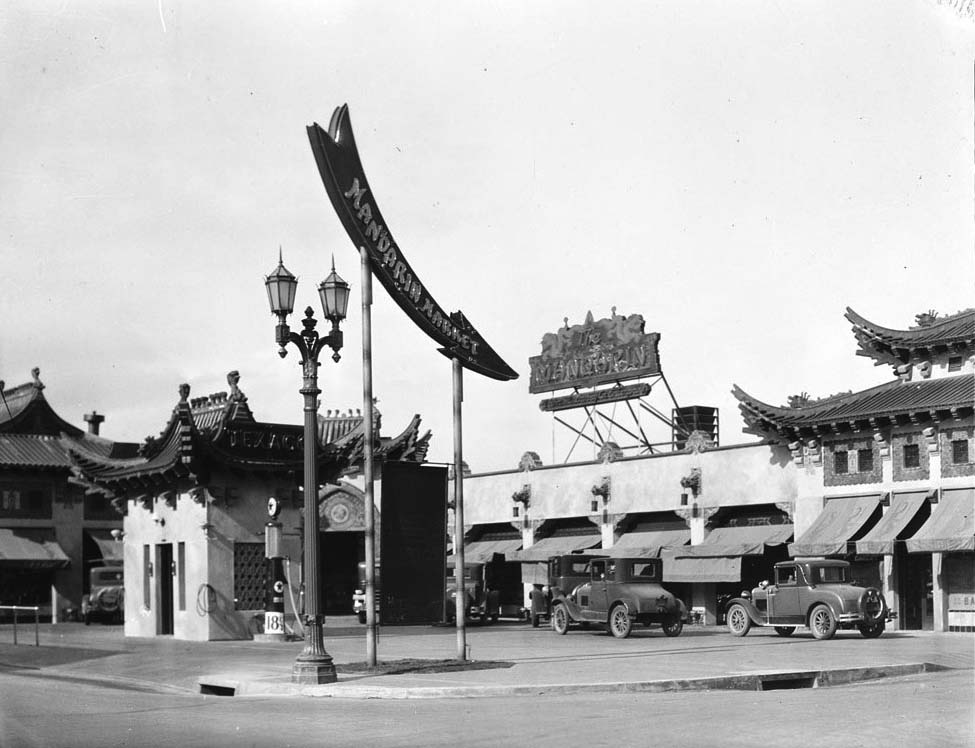 |
|
| (ca. 1929)^^ - Closer view of the Mandarin Market located on the northeast corner of La Mirada Avenue and Vine Street. The complex includes a Texaco service kiosk (center), a bakery (far right), a full meat and produce market, and a restaurant (left) known at this time as "Chinatown." Note the ornate two-lamp streetlight+ on the corner. |
Historical Notes + In the late 1920s and 1930s these type of streetlights (electroliers) were installed in many parts of Los Angeles, however, nowhere more than in the Hollywood District. Click HERE to see more in Early Los Angeles Streetlights. |
 |
|
| (1929)* - View of the Mandarin Market, a Chinese-style drive-in market located at 1234-1248 Vine Street, in Hollywood. The meat and produce sections, identified by signs placed up high near the roof line, are labeled from left to right: Meats, Vegetables and Fruits. The market's "The Mandarin" sign mounted on the roof states that the market is a "Wm. M. Davey Co. Enterprise." |
Historical Notes Built in 1929, the Mandarin Market was touted as being one of the first drive-in markets of its kind in Los Angeles. The architect was Henry L. Gogerty, who later designed "gliding acoustical walls" for classrooms, and assembly line buildings for Howard Hughes' Spruce Goose project. Southern California was the principal center for the development of drive-in markets between the mid-1910s to the early 1940s. Other notable early drive-in markets included: Aurora Market (Glendale), Plaza Market (LA), and the Sunset Clock Market (Beverly Hills). |
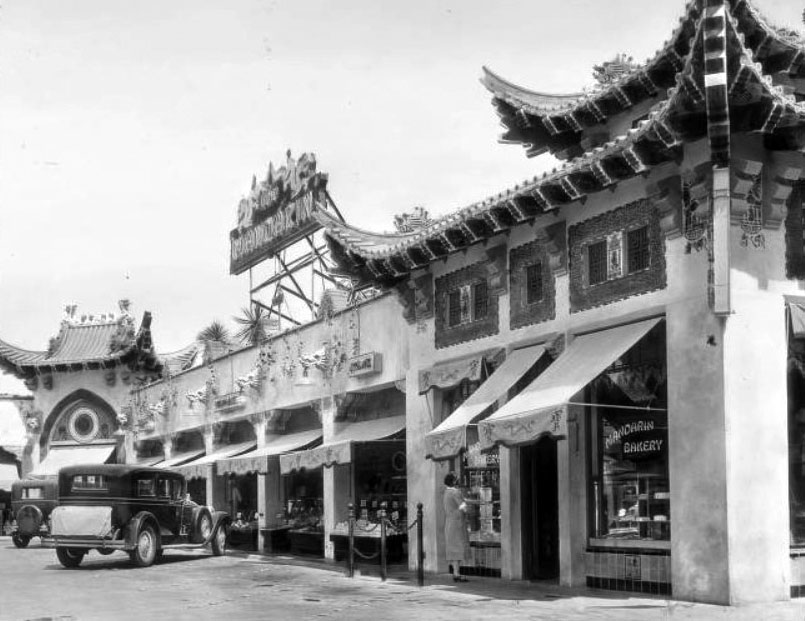 |
|
| (1931)+##^ – Postcard view of the Mandarin Market showing the details of its pagoda-style design. In the foregrond can be seen the Mandarin Bakery. |
Historical Notes Rather than have delivery trucks crowding the front of the marketplace, each store had a back entrance for deliveries. |
 |
|
| (1931)*- Partial view of the Mandarin Market, a Chinese-style drive-in market complex located on the northeast corner of La Mirada Avenue and Vine Street. |
Historical Notes The complex included a Texaco service kiosk (right), a bakery (not visible), a full meat and produce market, and a restaurant (left) known at this time as "John Tait's." |
.jpg) |
|
| 1931)*- Closer view of John Tait's Restaurant on the north side of the Mandarin Market. Note the detail design of the roof. |
Historical Notes The property sold in 1932 for $175,000 and, after some modifications, became Hollywood Ranch Market. |
* * * * * |
Hollywood Ranch Market (originally the Mandarin Market)
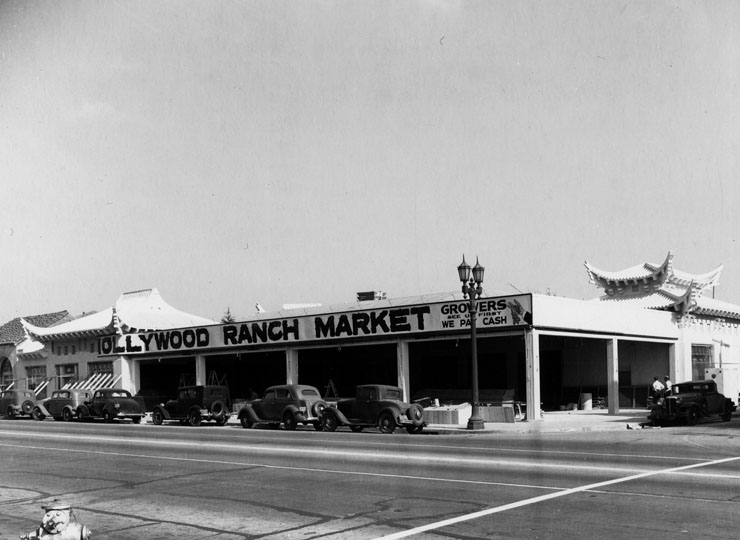 |
|
| (ca. 1932)* - View looking at the northeast corner of La Mirada Avenue and Vine Street showing the Hollywood Ranch Market (previously Mandarin Market) being expanded to include more indoor space. |
Historical Notes The Hollywood Ranch Market (previously Mandarin Market) took on a new look when the original outdoor area was enclosed. The Pagoda-style roofline remained intact around the periphery. |
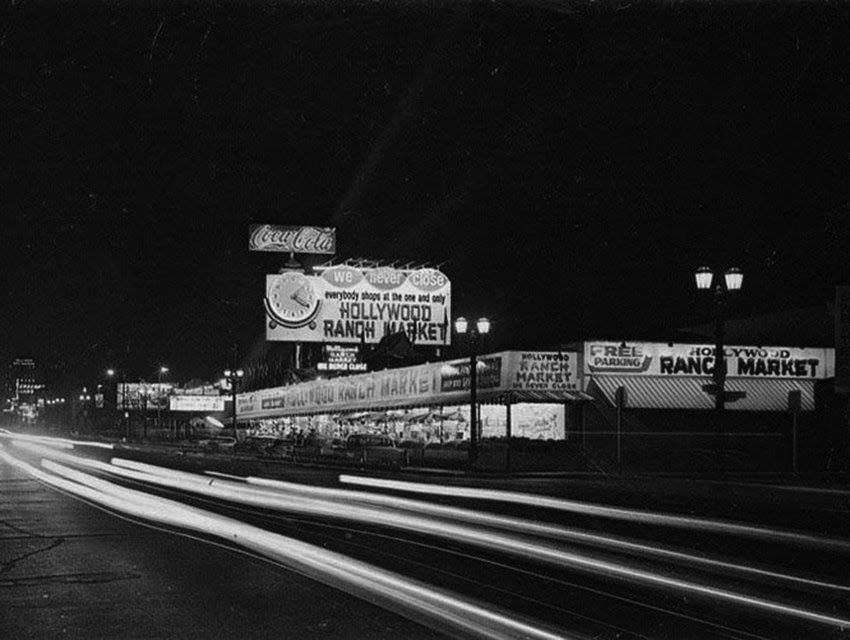 |
|
| (1950s)##++ – Nighttime view looking northeast showing the Hollywood Ranch Market with its new oversized signboard. |
 |
|
| (1950s)^.^ - Hollywood Ranch Market – even busy at nights. Sign in upper-left corner reads: WE NEVER SLEEP |
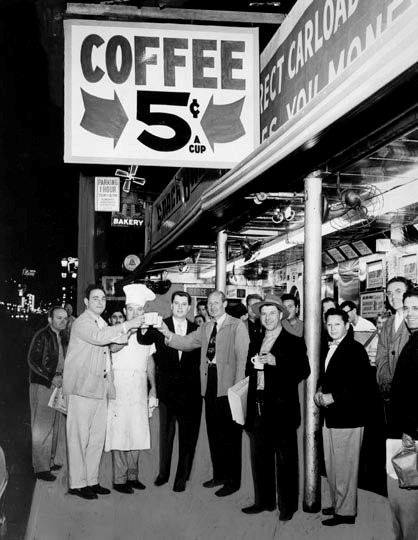 |
(1954)* - Herald Examiner photo showing several men toasting with a cup of coffee in front of Hollywood Ranch Market.
|
Historical Notes Examiner article reads: "The all-night Hollywood Ranch Market sidewalk lunch counter on Vine Street is one of many places revolting against the hike in coffee prices. This place reduced its price from 10 cents to 5 cents per cup. Celebrating with steaming mugs beneath the sign are, left to right: Richard Wilson, jazz musician-composer; night manager Roy McCully; co-owner Larry Frederick; writer Roger Fair; and newsboy Eddie Levin, on February 2, 1954." * |
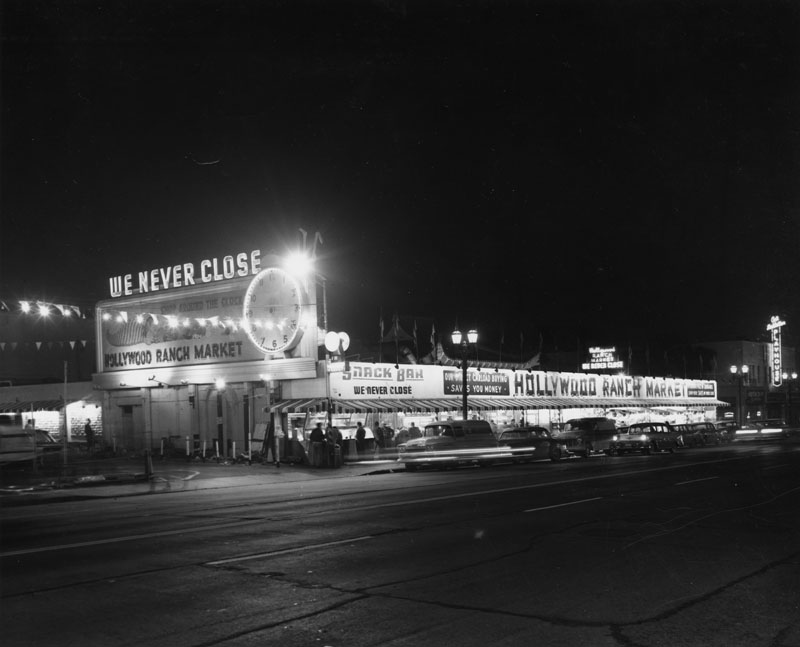 |
|
| (1961)* - Exterior view of the Hollywood Ranch Market, located at 1234-1248 Vine Street. The market with its large neon sign and the neighboring Art Linkletter Playhouse are clearly visible. Remnants of the original Chinese influenced architecture from when the building served as the Mandarin Market are visible above the roof line in the center of the photograph. |
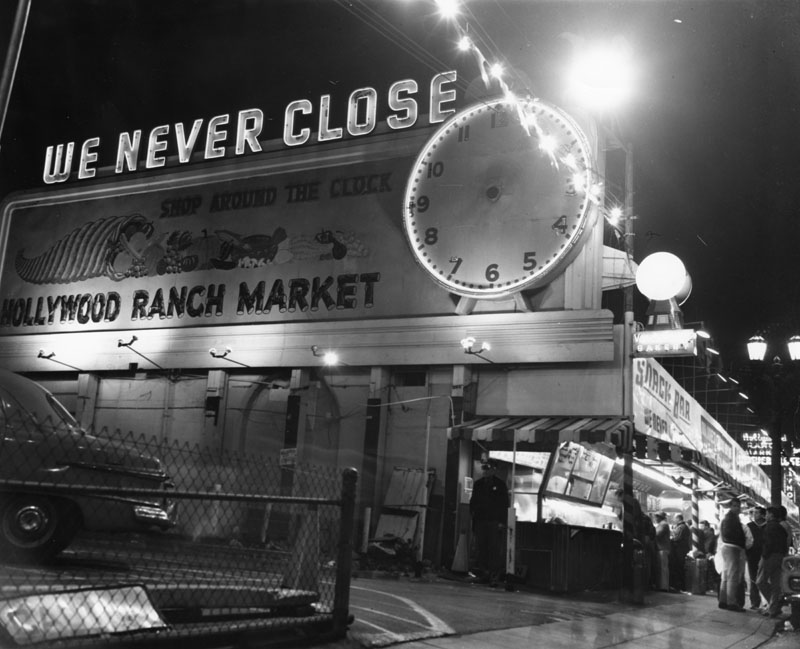 |
|
| (1961)* - Exterior night view of the Hollywood Ranch Market. The market's neon sign with a clock reads, "We never close" and "Shop around the clock." This side view only allows one of the market's vendors, the snack bar, to be visible. |
Historical Notes It wasn’t unusual to see such personalities as Frank Sinatra, Ava Gardner or Red Skelton or at the Hollywood Ranch Market’s snack bar. Steve Allen used to broadcast his shows from his studio close by. ^#^^ |
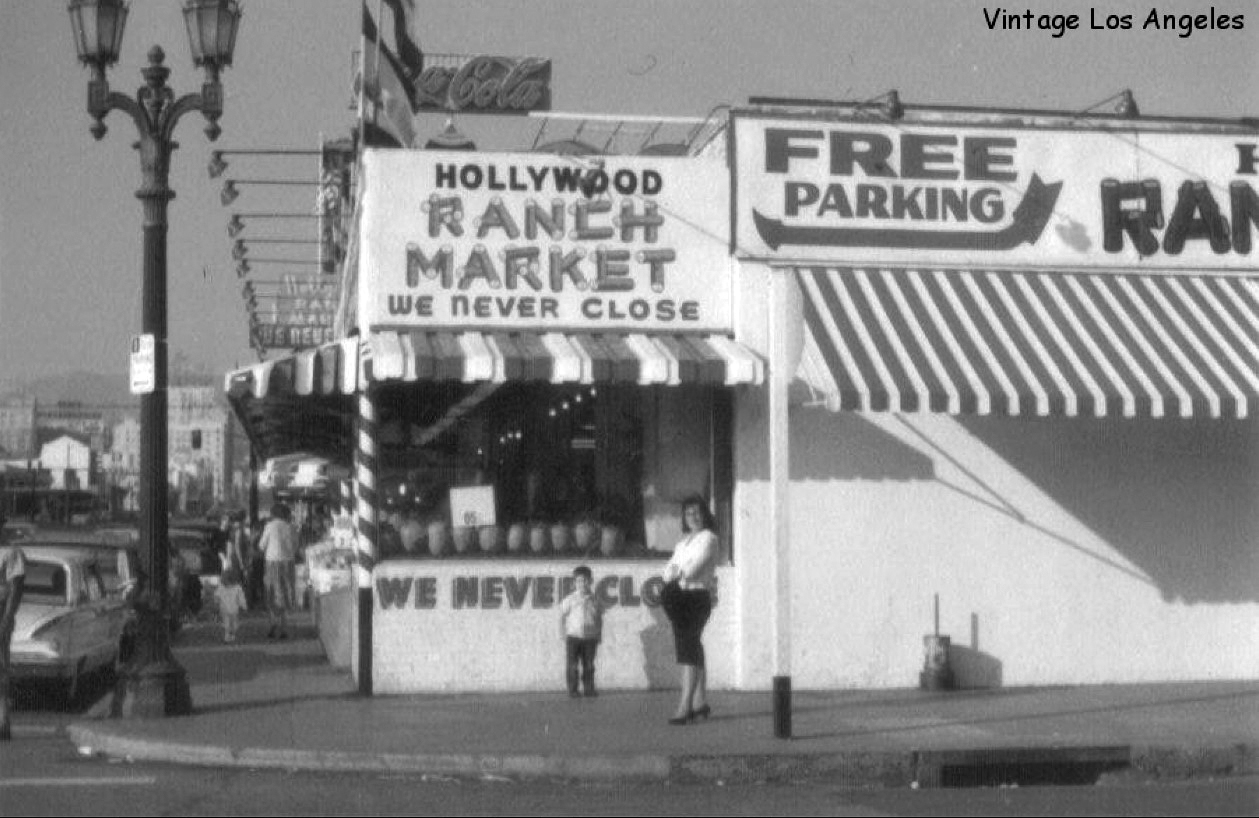 |
|
| (ca. 1960s)* – View looking north showing a woman and young child standing in front of the Hollywood Ranch Market on the northeast corner of Vine Street and La Mirada Avenue. Photo: Vintage Los Angeles. |
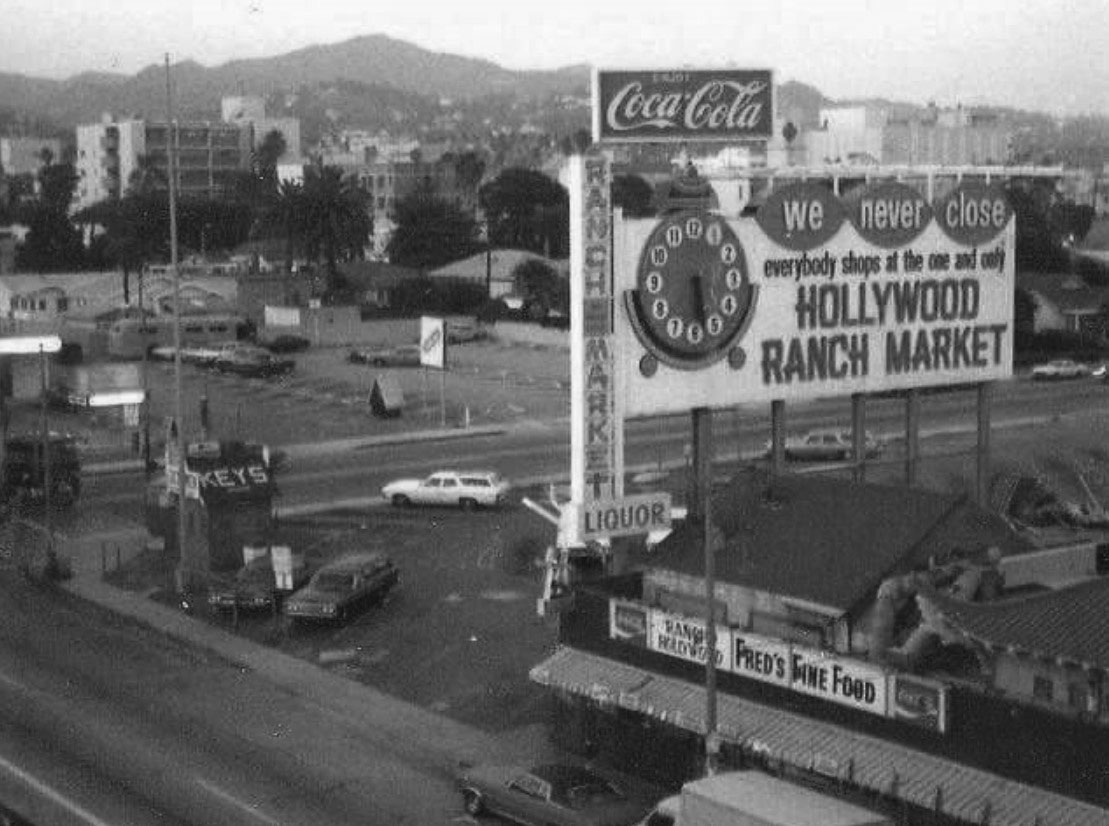 |
|
| (1970s)* – View looking northeast toward the Hollywood Hills and Mt. Lee with the Hollywood Ranch Market at lower right. The large sign reads: We Never Close – Everyone Shops at the One and Only HOLLYWOOD RANCH MARKET. |
Historical Notes The Ranch market burned down in the early 80s and is now a strip mall that includes an Office Depot and an El Pollo Loco. Click HERE to see contemporary view. |
* * * * * |
Hollywood Chamber of Commerce
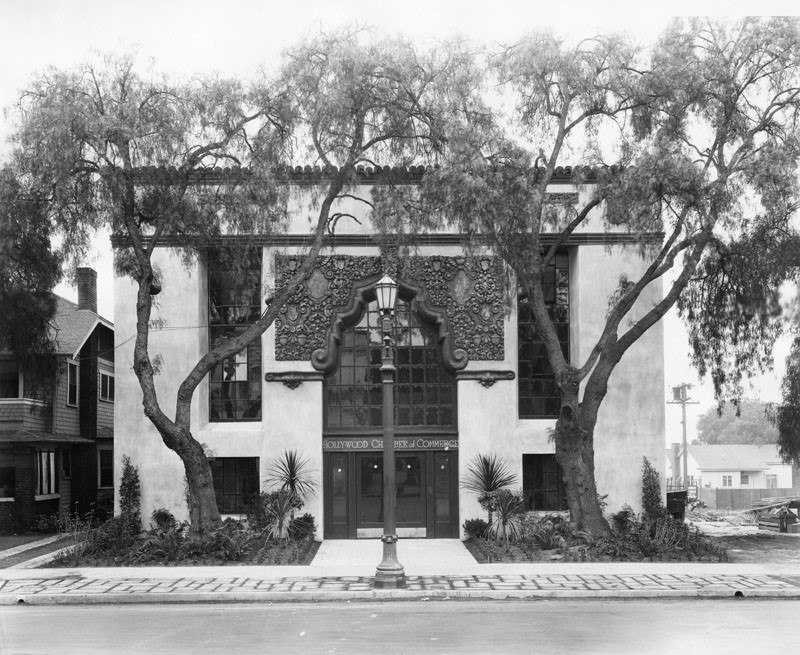 |
|
| (ca. 1929)* - Exterior view of Hollywood Chamber of Commerce at 6520 Sunset Boulevard. View shows the cast stone ornament over the main entrance and lower windows. Designed by Morgan, Walls & Clements, the building has a Spanish Colonial Churriqueresque design. Date built: 1925. |
Historical Notes The Hollywood Chamber of Commerce was formed in 1921 to replace the old Board of Trade. A five-day membership drive resulted in 2,517 members. The first order of business for the new organization was to raise funds for the grading and installation of 20,000 seats to create the Hollywood Bowl. In 1932, the Santa Claus Lane Parade was first sponsored by the Chamber. In 1978, the parade was given a new look, renamed the Hollywood Christmas Parade and grew to national prominence as the nation’s largest celebrity parade with national television distribution for the first time. In 1949, the Chamber entered into an agreement with the Department of Recreation and Parks to repair and rebuild the Hollywood Sign and to remove the “land” so that it would spell “Hollywood”. The cost was $4,000. A second restoration was done by the Chamber in 1973. #*^^ |
* * * * * |
Leonis Adobe
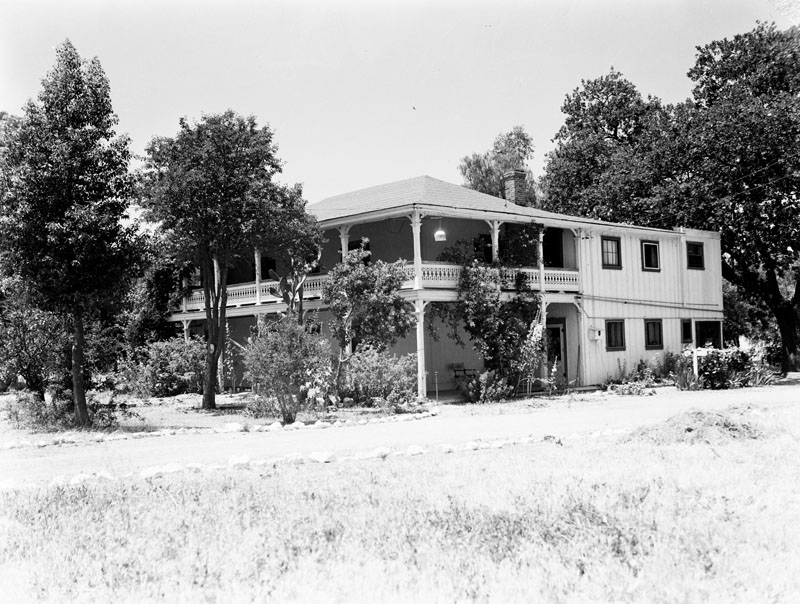 |
|
| (1929)* - Exterior of the Leonis Adobe at 23530 Ventura Blvd. in Calabasas. Said to have been built by Miguel Leonis in 1876, it was also known as the Menendez house. |
Historical Notes Leonis Adobe is one of only four surviving adobe residences remaining in the San Fernando Valley. When the Los Angeles Cultural Historical Board was formed in 1962, Leonis Adobe was the first designated as a Historic-Cultural Monument. By 2007, there were nearly 900 separately numbered sites that had received the designation, but Leonis Adobe has the prestige of having been designated as LA Historic-Cultural Monument No. 1 (Click HERE to see the complete list). In 1975, the adobe was also listed on the National Register of Historical Places.*^ For a number of years it was part of Warner Bros. ranch properties and resided in by actor John Carradine and family. In 1965 it was one of the few remnants of the San Fernando Valley's heritage standing in original form.* |
Click HERE to see more in Early Views of the San Fernando Valley |
* * * * * |
St. Charles Hotel (Originally Bella Union Hotel)
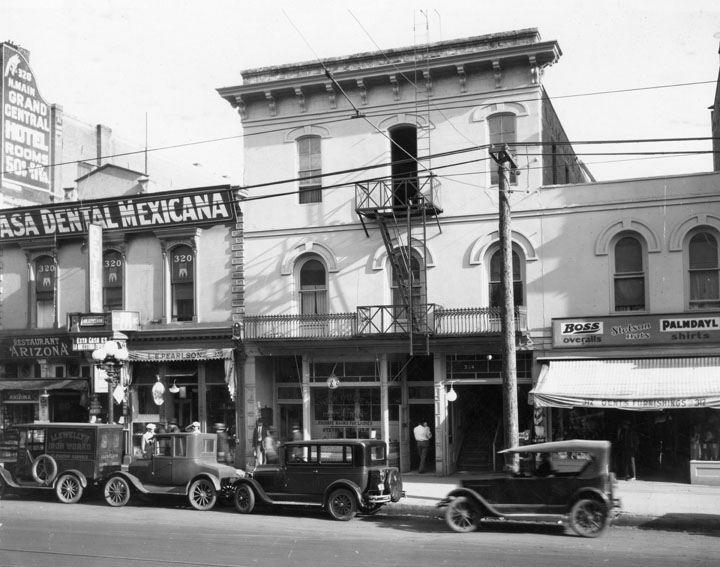 |
|
| (1929)* - The St. Charles Hotel, originally the Bella Union Hotel, as it appeared in 1929. Several businesses are seen on the bottom floors: Casa Dental Mexicana, Restaurant Arizona, Gents Furnishings (hats, overalls, shirts). |
Historical Notes During the 1930s, the St. Charles turned into a low-budget-lodging house and served a poor and ethnically diverse population. It was demolished in 1940 to make space for a parking lot. In the 1970s, architect Robert Stockwell designed the subterranean Los Angeles Mall, where the oldest hotel once stood.^#* The Bella Union Hotel site was designated as California Historical Landmark No. 656. Click HERE to see more California Historical Landmarks in LA. |
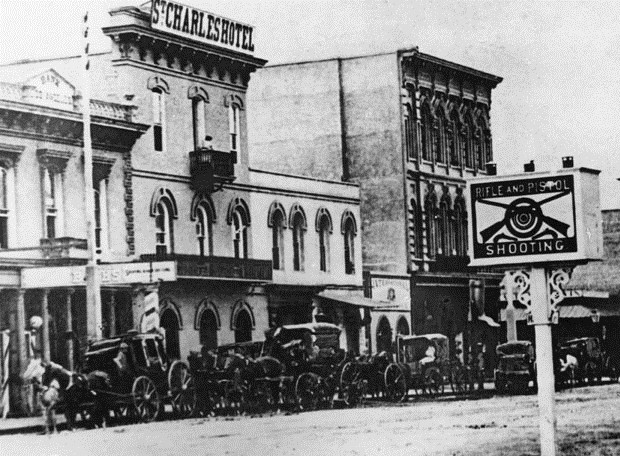 |
|
| (ca. 1875)* - Exterior view of the St. Charles Hotel, originally the Bella Union Hotel. Horses and buggies are lined up along the street. In the foreground a sign reads, “Rifle and Pistol Shooting,” a reminder that Los Angeles was a Western frontier town. Click HERE to see more in Early LA Buildings (1800). |
* * * * * |
Chester Williams Building
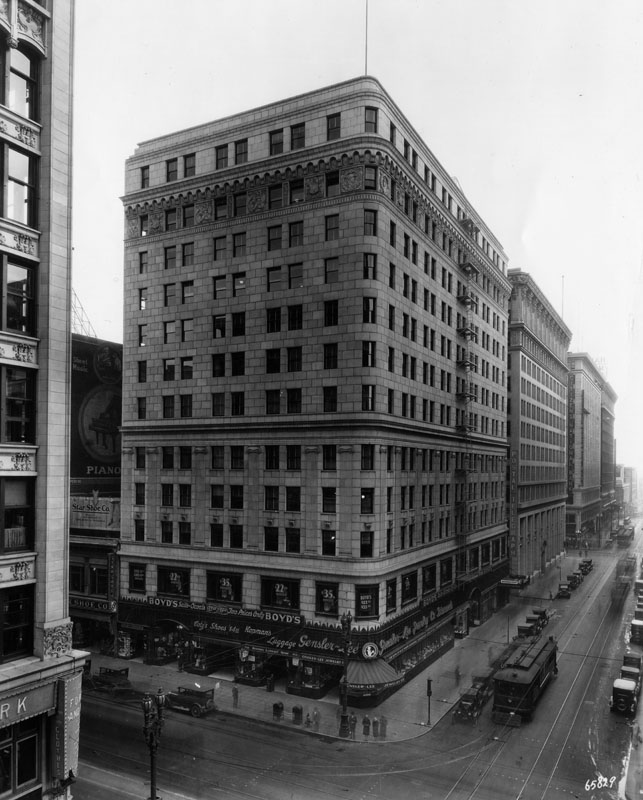 |
|
| (ca. 1927)* - Looking across the intersection of Broadway and 5th, showing the Chester Williams Building, occupied by Gensler-Lee Jewelry and Boyd's Suits and Coats. A glimpse of the Metropolitan Building at 315 W. 5th Street (far left), shows part of the sign for the Foreman & Clark's clothing store upstairs. |
Historical Notes The 12-story Chester Williams Building was constructed in 1926 and located at 215 West Fifth Street. The building also has the address 452 South Broadway. It was designed by Architects Curlett & Beelman. In 2012, the Chester Williams Building was converted to a 88-unit apartment complex. The opening of the renovated Chester Williams makes the intersection of Fifth Street and Broadway only the second Historic Core crossing where all four corners are occupied by residential buildings. The first such intersection, at Sixth and Spring streets, was marked in 2010 with the opening of SB Tower. |
* * * * * |
Architects' Building (later Douglas Oil Building)
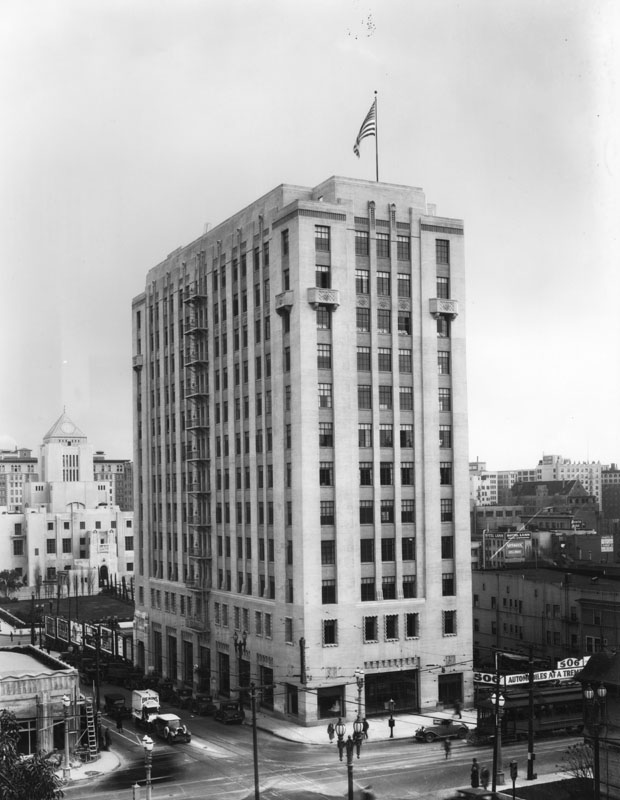 |
|
| (1929)* - View of the Architects' Building at 816 West 5th Street looking southeast from 5th and Figueroa. In the background is the Los Angeles Central Library. It was built from 1927-1928. |
Historical Notes The 12-Story Architects’ Building was the third whole structure in the U.S. to be exclusively devoted to the various branches of the construction industries (NY & Chicago being the other two). The building opened on January, 1928 and cost $662,000 to construct. |
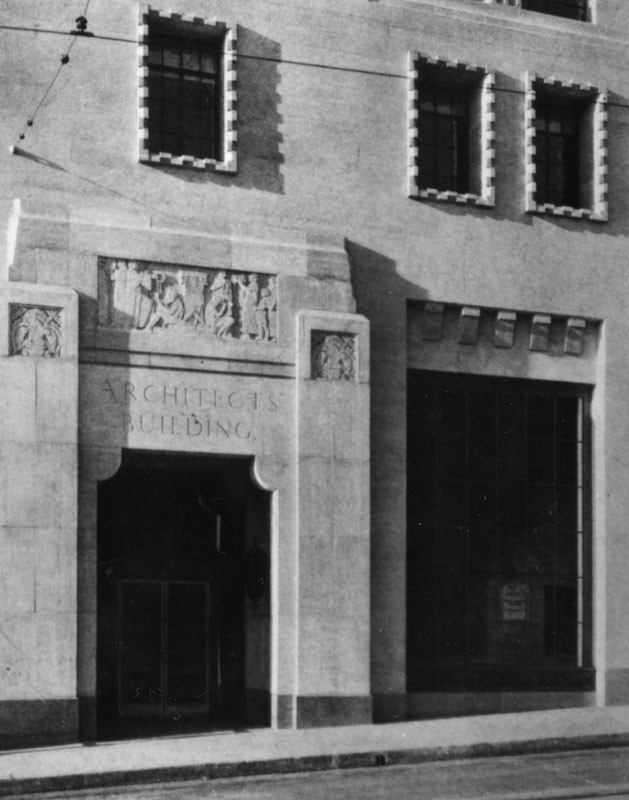 |
|
| (1928)* - Doorway of the Architects' Building at 816 West 5th Street, showing the ornamentation in the concrete. The building was located on the southeast corner of 5th and Figueroa Streets. Manufacturers' representatives went floor to floor, leaving product samples with architects. |
Historical Notes The seven upper floors of the building were leased to prominent architects, its first floor and mezzanine was occupied by the Metropolitan Exhibit of Building Materials—a massive exhibit of every branch of the building industry, renamed the Architects’ Building Materials Exhibit. |
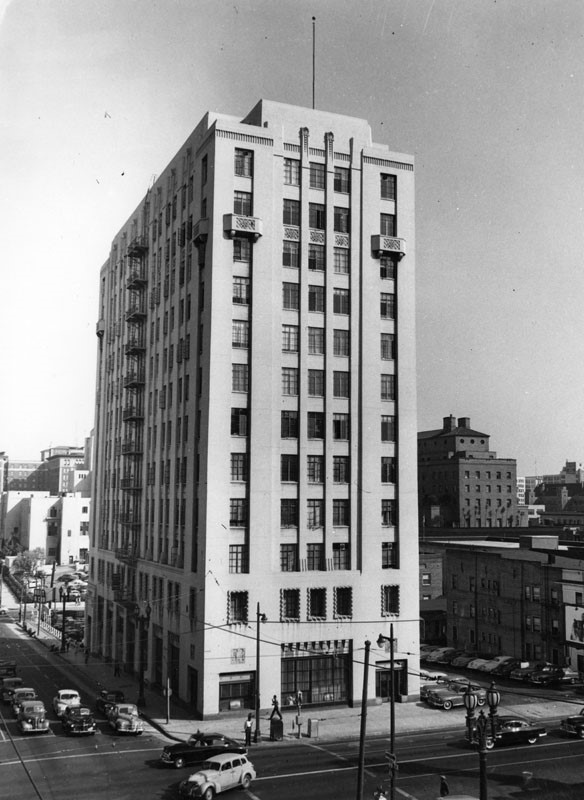 |
|
| (1952)* – View showing the Architects' Building located on the southeast corner of 5th and Figueroa streets. A glimpse of Central Library is visible on the left and the California Club can be seen on the right. |
Historical Notes In 1959 the Architects’ Building was purchased by Douglas Oil, a southern California independent who ran three refineries and 300-some gas stations in the Southland. The building's name was changed to Douglas Oil Building. |
 |
|
| (1959)* - View looking from west to east towards the intersection of 5th and Figueroa streets showing the Architects Building, now the Douglas Oil Building, on the SE corner. The vacant lot on the left (NE corner) is where the Westin Bonaventure Hotel is now located. In the background are the Los Angeles Public Library (left) and the Church of the Open Door, upon which the " Jesus Saves" sign is mounted. The Crocker Bank Tower at 6th Street and Grand Avenue is shown under construction. On the far right can be seen a glimpse of the Richfield Oil Company Building. |
Historical Notes In 1961, Continental Oil (aka Conoco) purchased Douglas Oil. The building, however, remained the Douglas Oil Building until it was demolished in 1969. |
 |
|
| (ca 1965)^*# - View from Bunker Hill looking southwest showing the Douglas Oil Building (previously Architects’ Building) at right, with vacant land and parking lots in the foreground. On the left can be seen at Richfield Oil Company Building. |
Historical Notes The Douglas Oil Building (Architects' Building) would be demolished in 1969 to make room for the ARCO Towers. |
* * * * * |
Wilshire Christian Church
.jpg) |
|
| (1927)* - Exterior view of the Romanesque Revival style Wilshire Christian Church during its construction, as seen from the western side of Normandie Avenue. The church is located on the northeast corner of Wilshire and Normandie. In the view above, the church's large rose window designed by Judson Studios has yet to be installed, but the window opening has been covered to protect the interior of the structure. |
Historical Notes After land was donated by Charles Chapman in 1911, a small bungalow style church was built at this corner of Wilshire Boulevard and Normandie Avenue. In 1927 the original church was replaced by this Northern Italian Romanesque style structure with a 200-foot tower, designed by Robert H. Orr. |
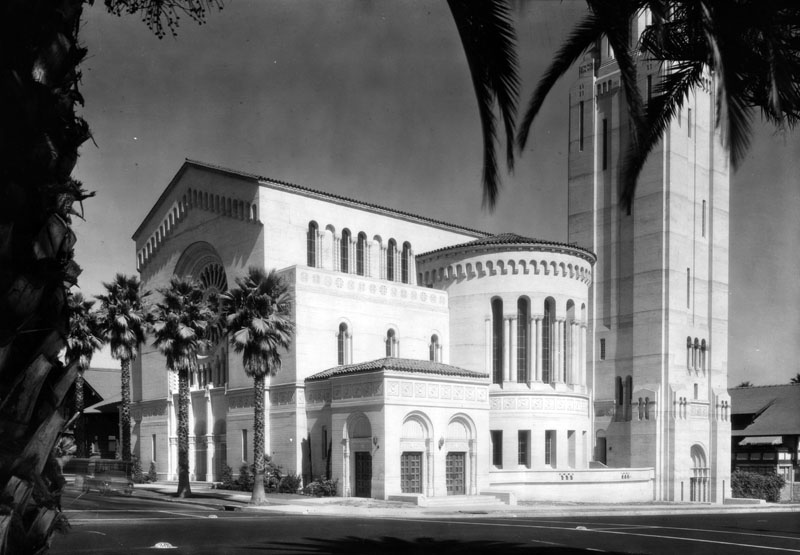 |
|
| (ca. 1927)* - Exterior view of the Romanesque Revival style Wilshire Christian Church located at 634 S. Normandie Ave, as seen from the southwest corner of the intersection of Normandie and Wilshire not long after it was constructed in 1927. |
Historical Notes The massive Romanesque structure with Byzantine elements was designed by Robert Orr, a prominent architect of Protestant churches in Southern California and a member of the congregation.^ |
 |
|
| (1929)* - A view looking east down Wilshire Boulevard past the painted arrow on the street telling traffic to "Slow - Crossing". On the right side is the Estrada's Spanish Kitchen Restaurant, and on the left side is the Wilshire Christian Church. On past the church is the Gaylord Apartment Building. |
Historical Notes The church was designed for maximum visibility for passing cars on the developing thoroughfare, with a 200-foot-tall tower and corner orientation. |
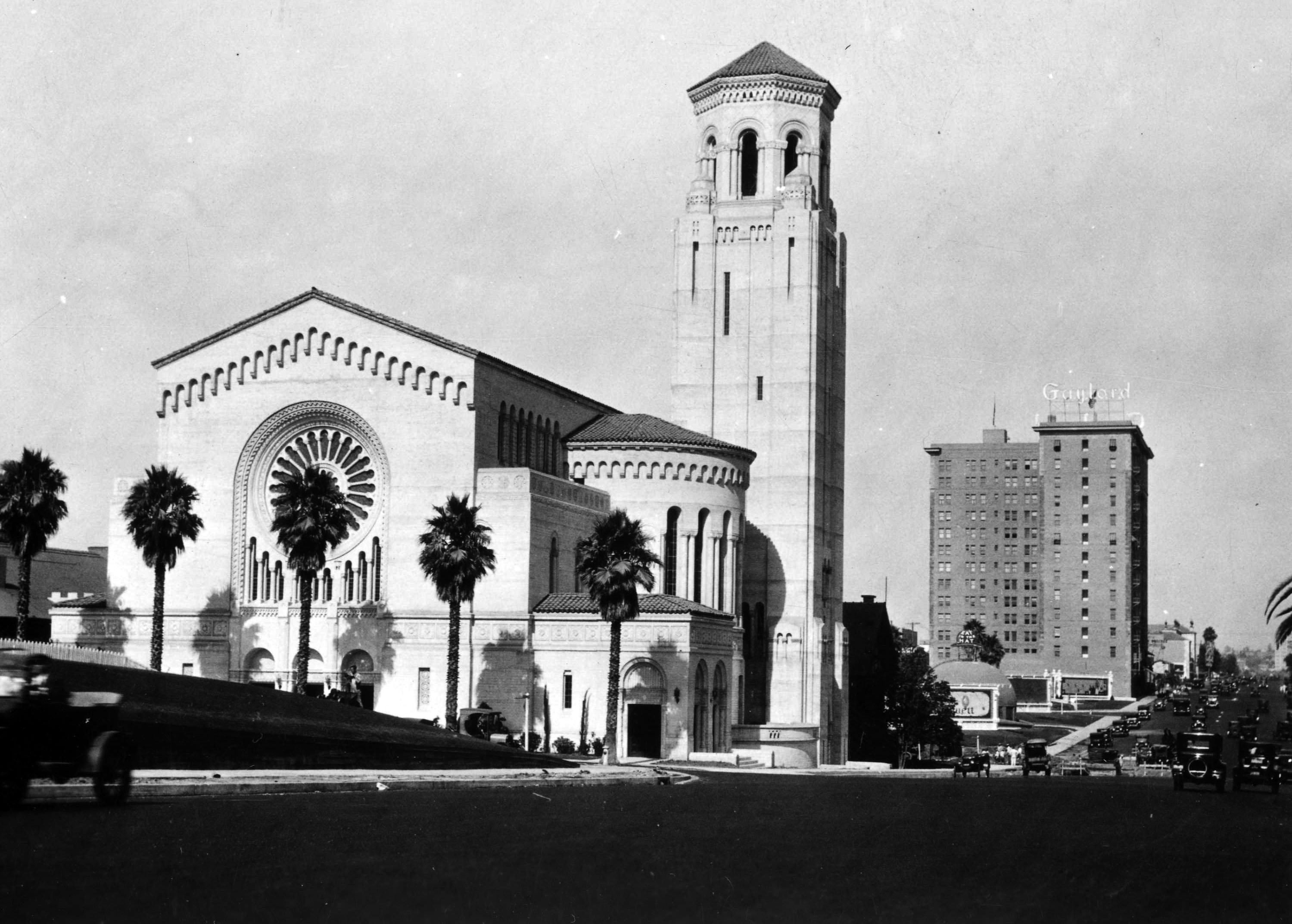 |
|
| (1928)^#^ – View looking east showing the Wilshire Christian Church on the NE corner of Wilshire and Normandie Ave. In the distance can also be seen the Original Brown Derby Restaurant and the Gaylord Apartment Building. |
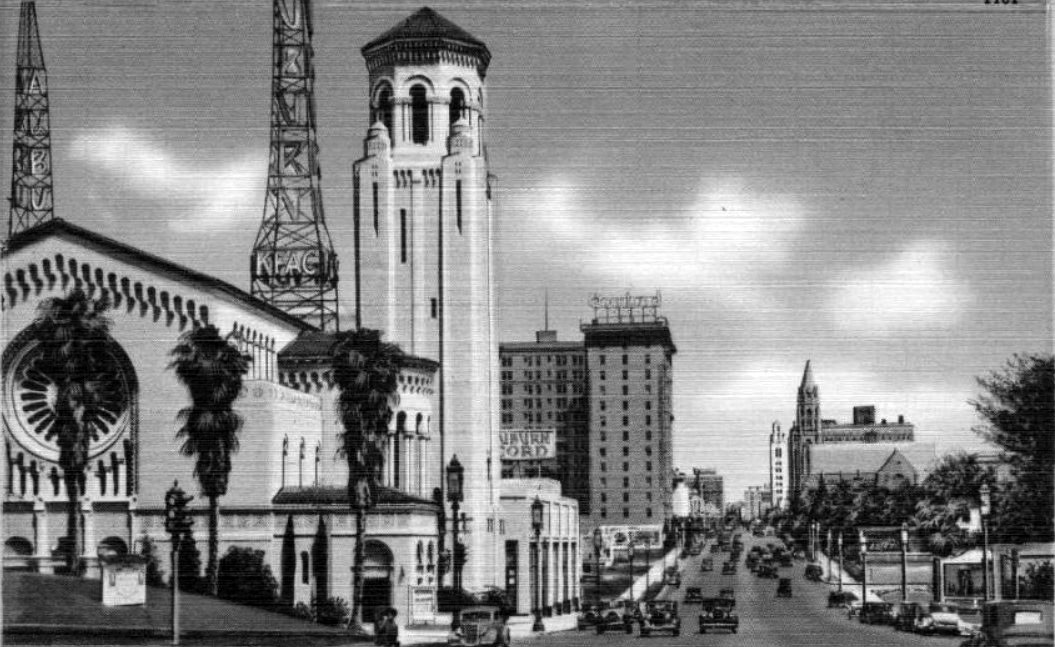 |
|
| (ca. 1935)^ – Postcard view of the Wilshire Christian Church and Gaylord Apartment Building on Wilshire Boulevard. The radio transmitting tower east of the church belonged to KFAC Radio Station, located at Mariposa and Wilshire. |
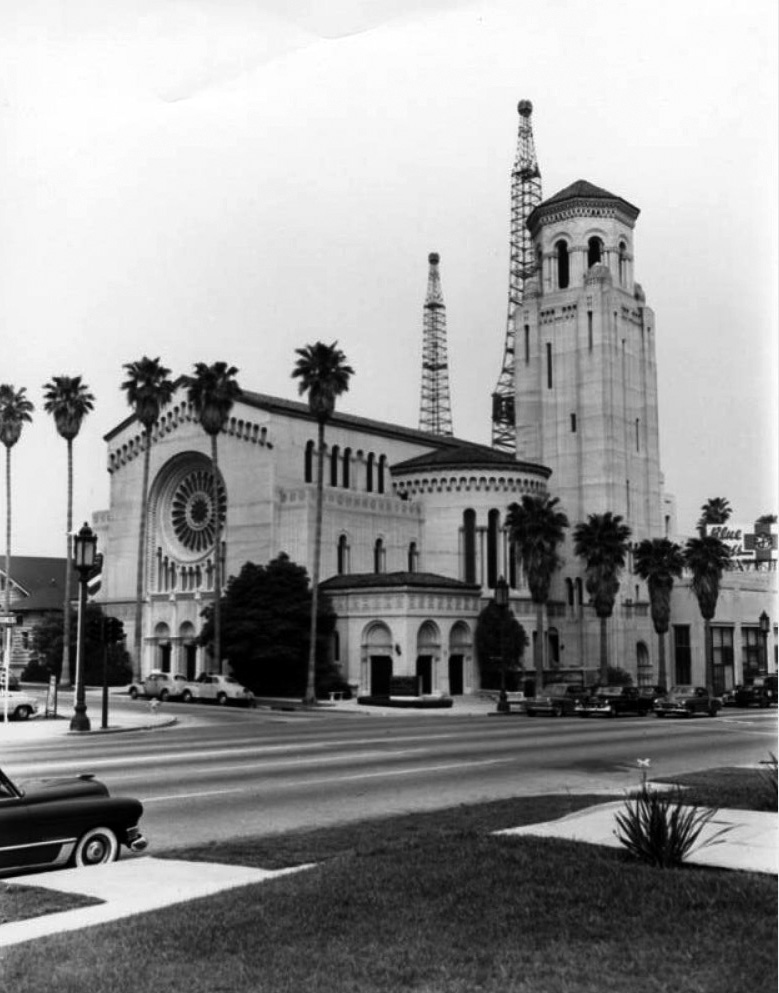 |
|
| (ca. 1948)* - View showing the Romanesque Revival style Wilshire Christian Church, as seen from the southwest corner of the intersection of Normandie Avenue and Wilshire Boulevard. The two towers of the neighboring KFAC classical music radio station are visible in the background. |
Historical Notes On May 19, 1940, First Christian Church of Los Angeles merged with Wilshire Boulevard Christian Church to become Wilshire Christian Church, which is of the Disciples of Christ denomination. |
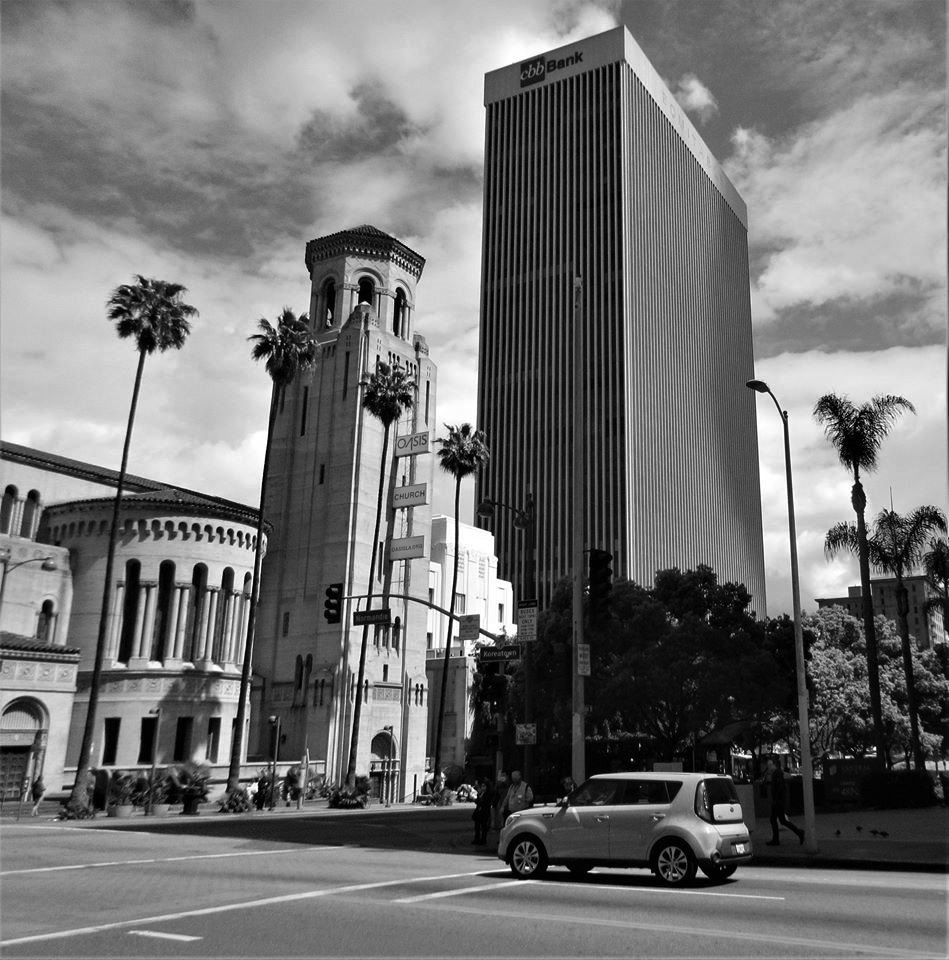 |
|
| (2020)^ - Oasis Church (previously Wilshire Christian Church) at 634 S. Normanide Ave in Koreatown with the Equitable Building seen in the background. Photo by Howard Gray |
Historical Notes The 1927-built Romanesque Revival-style building designed by Robert Orr was bought by Oasis Church in 2012. The Wilshire Christian Church congregation moved to a new location at 550 South Berendo Street. |
 |
|
| (2011)^ – View looking southwest showing the Equitable Building with the Wilshire Christian Church in the foreground. Photo by Michele Canonico |
Historical Notes The Wilshire Christian Church building (today Oasis Church) was dedicated Los Angeles Historic-Cultural Monument No. 209 in 1979. (Click HERE to see complete listing). |
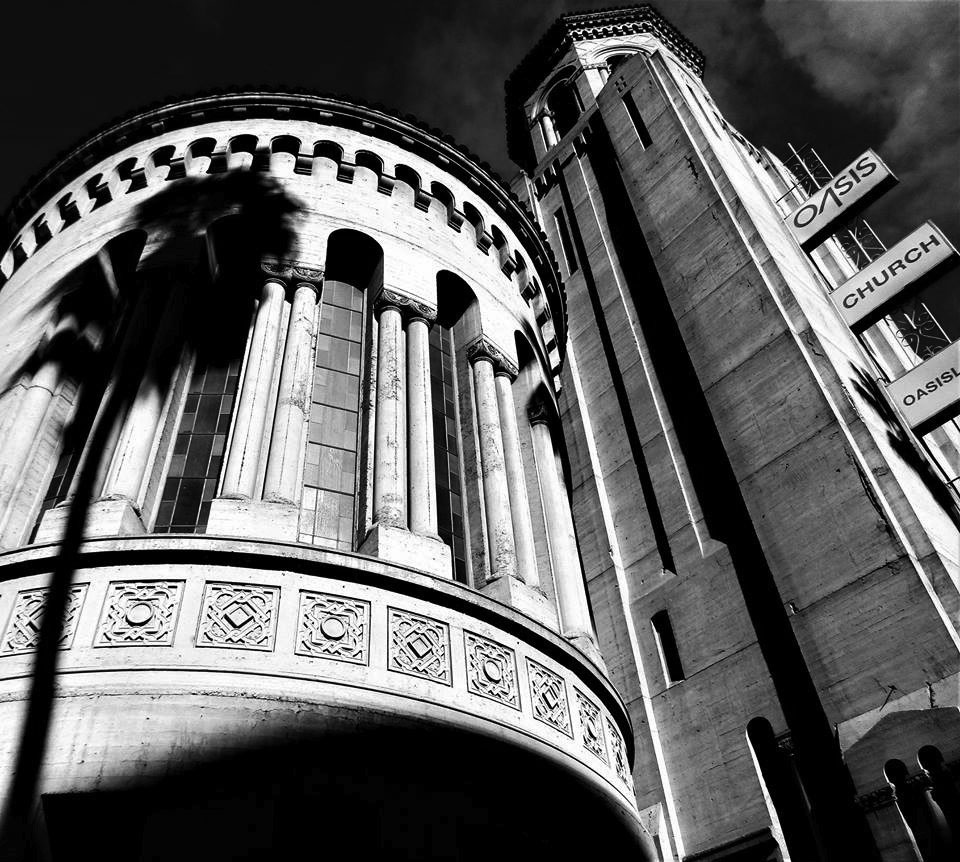 |
|
| (2018)^ – View looking up to the top of what is now the Oasis Church. The Wilshire Christian Church congregation moved to a new location at 550 South Berendo Street. |
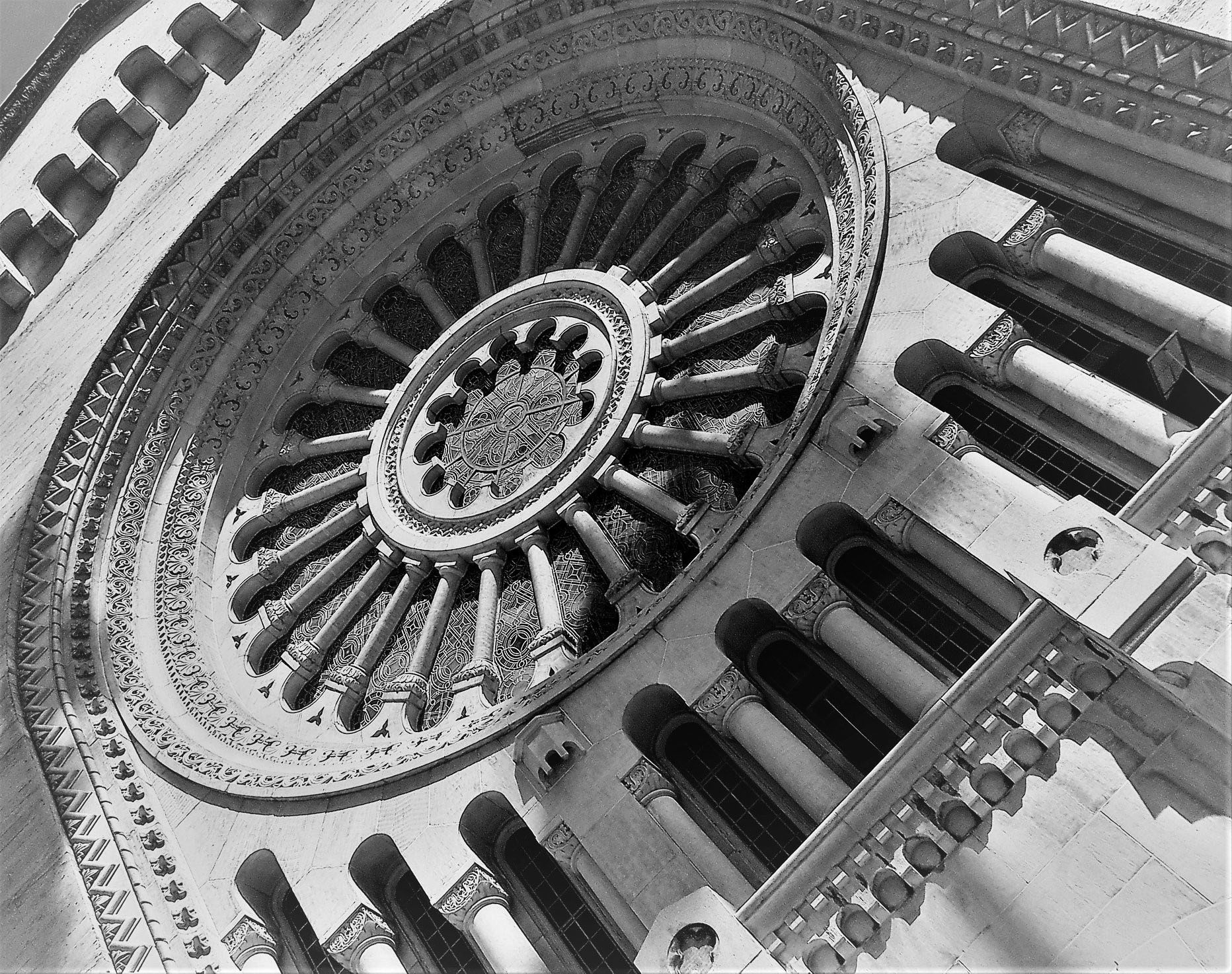 |
|
| (2018)^ - Close-up view of the Oasis Church Rose Window, previously Wilshire Christian Church. It is a replica of the one at the Reims Cathedral in France, created by the Judson Studios of Hancock Park and designed by Robert Orr. |
Historical Notes Oasis Church began as a Bible-study group of ten people in Beverly Hills. From that community, Philip and Holly Wagner decided to found a church, which had about thirty initial parishioners. One of the original members of the Bible-study group was singer Donna Summer, and more recent members include Viola Davis. The congregation moved to the Oasis Theatre in the 1990s, and to the Wilshire Christian Church during the 2010s. By the 2010s, the church had more than three thousand members. It is known for the diversity of its fellowship.*^ |
* * * * * |
Gaylord Apartments
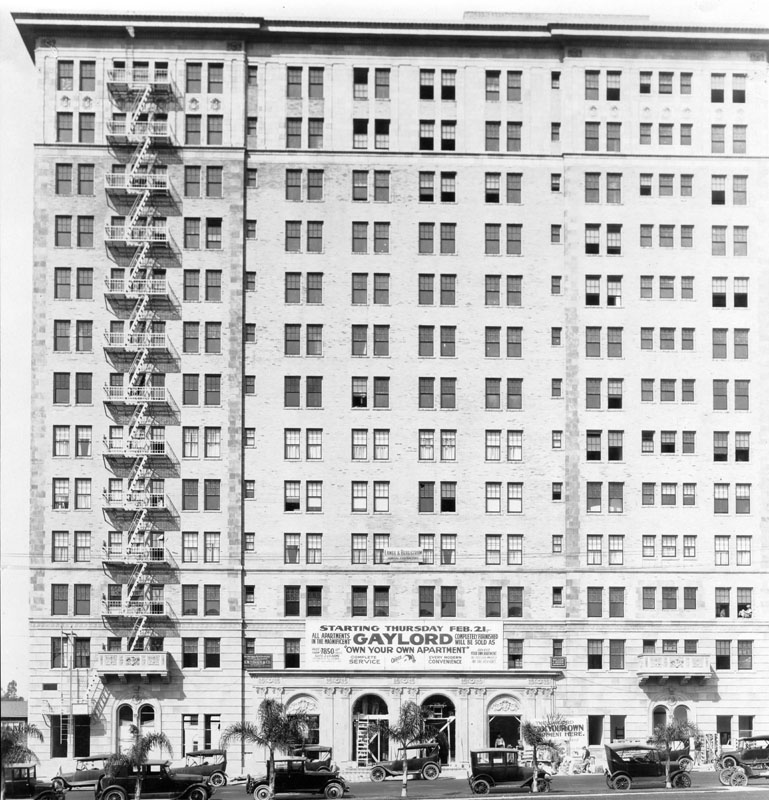 |
|
| (ca. 1929)* - View of the Gaylord Apartment house located at 3355 Wilshire Boulevard, directly across from the Ambassador Hotel. A banner above the main entrance reads: "Starting Thursday Feb. 21st - all apartments in the magnificent Gaylord - completely furnished will be sold as 'own your own apartment' - price from $7850 up furnished - suites 2 to 5 rooms - payments 1/2 down - balance over period of 17 years - complete service - every modern convenience - select your own apartment - take possession immediately and save high rents". Smaller signs on building read: "Walker & Eisen, Architects", and "Lange & Bergstrom, General Contractors". |
Historical Notes The Gaylord Apartment Hotel was named after Henry Gaylord Wilshire, who founded the famous boulevard; the 14-story building officially opened its doors in 1924. The entire area near the Gaylord became the site of New York style apartment buildings, and many film stars lived in these elegant high rises. Among them were the Ambassador, Asbury, Langham, Fox Normandie, Picadilly, and Windsor. In the mid-sixties, the Gaylord Apartment Hotel was converted into a charming apartment community.* |
 |
|
| (ca. 1929)* - Aerial view of The Gaylord Apartments at 3355 Wilshire Boulevard, across from the Ambassador Hotel. |
Historical Notes In 1895, Henry Gaylord Wilshire began developing 35 acres stretching westward from Westlake Park for an elite residential subdivision. He donated a strip of land to the city of Los Angeles for a boulevard through what was then a barley field, on the conditions that it would be named for him and that railroad lines and commercial or industrial trucking would be banned. In 1900, Wilshire was arrested for speaking in a public park in Los Angeles. A judge dismissed the charges, but the incident caused Wilshire to leave Los Angeles for New York. Wilshire eventually returned to Los Angeles and made much of his connection with the now famous Boulevard that bore his name, although he had no involvement with its gradual expansion in the years while he was absent from the region. He made and lost several fortunes during his lifetime and died destitute on September 7, 1927 in New York.^ |
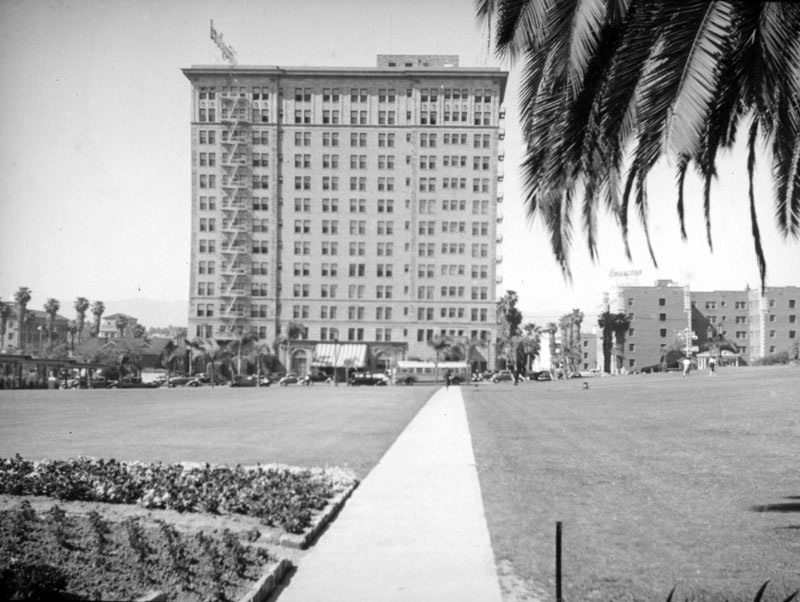 |
|
| (ca. 1938)* - View of the Gaylord and Evanston Apartments as seen from the Ambassador Hotel lawn. Some small shops in front of the Evanston on the 3340 block of Wilshire Boulevard are also visible. |
Historical Notes Architects Walker & Eisen designed the Renaissance revival style 1924 Gaylord Apartments, located at 3355 Wilshire Boulevard. The Gaylord was originally one of L.A.'s first co-ops, which offered all of the hotel amenities (but not a hotel). The six-story Evanston Apartments (east of the Gaylord) was built in the late 1920s and located at 630 South Kenmore. This building has been demolished and the site is now occupied by the 1967 Wilshire Square building designed by the architectural firm of Langdon & Wilson.* |
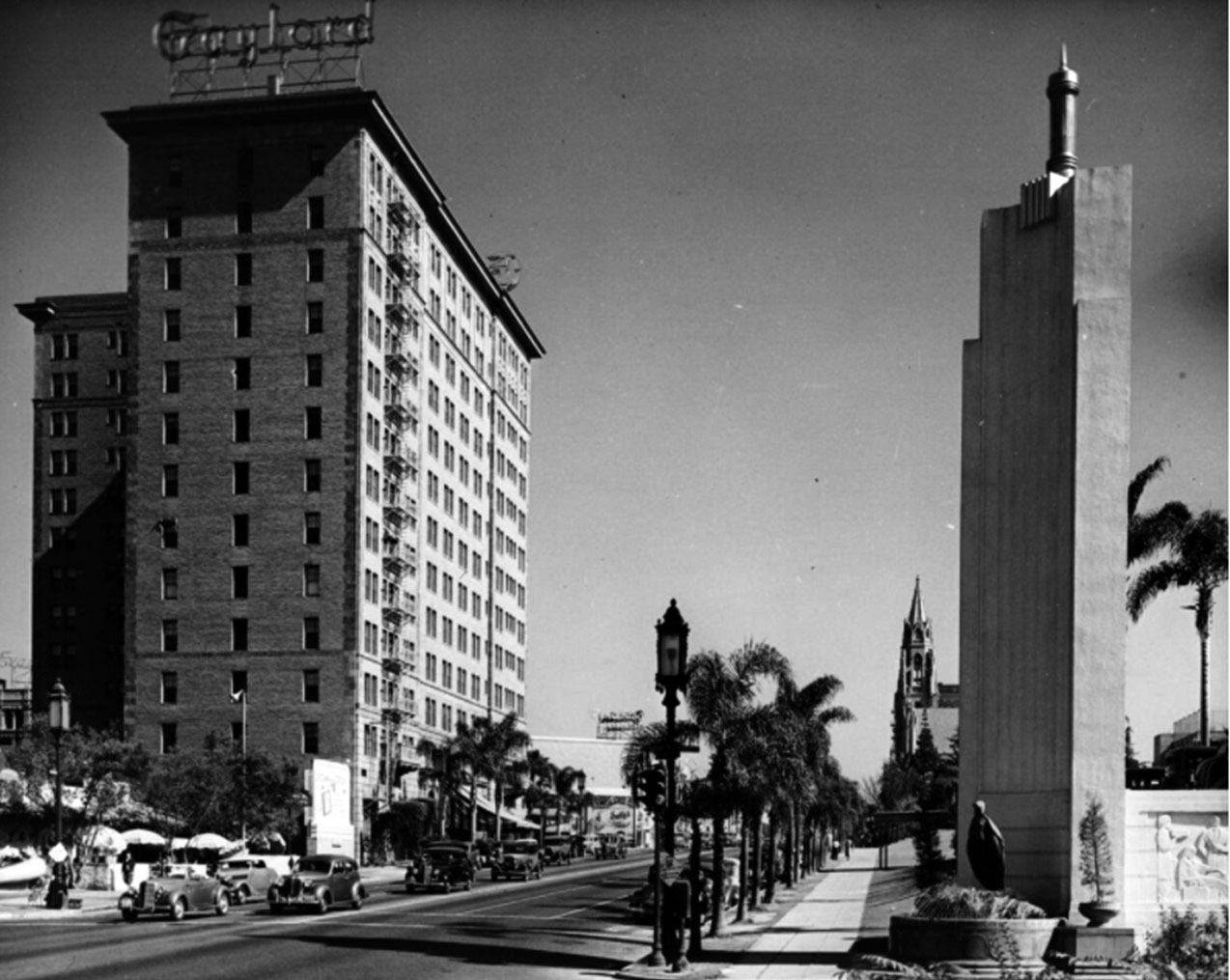 |
|
| (ca. 1938)^ - Looking east on Wilshire Boulevard at the Gaylord Apartments and the entrance to the Ambassador Hotel. |
 |
|
| (1938)^ - Looking west down Wilshire Boulevard with the Gaylord Apartments on the right. Also seen here is the Wilshire Christian Church, Wilshire Blvd Temple and, further in the distance, the Wilshire Professional Building. |
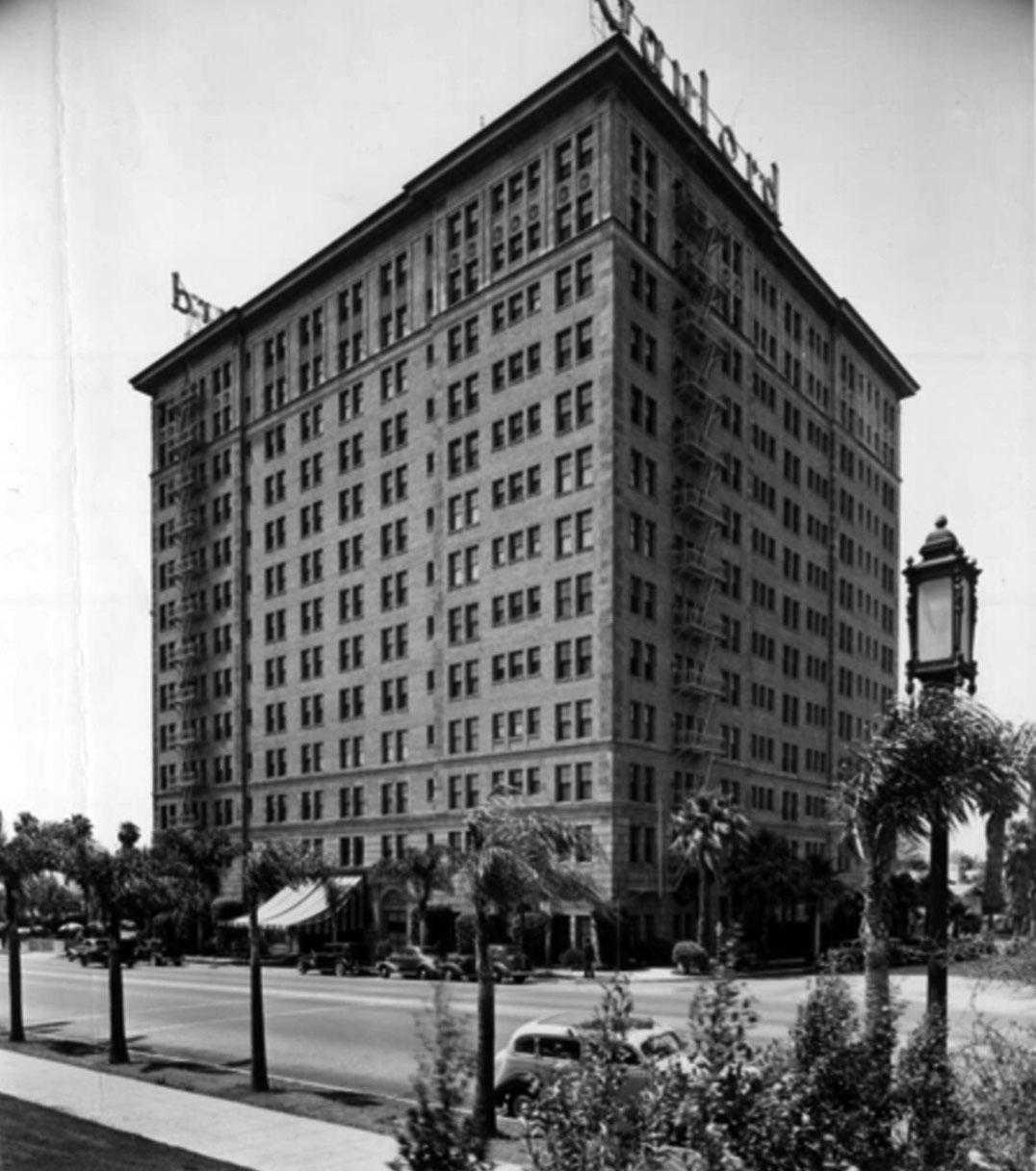 |
|
| (1940s)^ - The Gaylord Apartments Hotel located at 3355 Wilshire Boulevard. |
Historical Notes The Los Angeles Times called the Gaylord one of the largest and most pretentious apartment houses in the country. Since then, the building has been thoroughly renovated inside. The nautical-themed HMS Bounty restaurant on the ground floor opened in 1962 in a space formerly occupied by The Gay Room and later The Secret Harbor. The Secret Harbor opened in 1951 as an outpost of Wilshire's leading restaurant family of the 1940s and '50s, brothers Seymour and Harold Dimsdale. After The Secret Harbor, the space served a brief stint as the Golden Anchor before becoming the HMS Bounty.* |
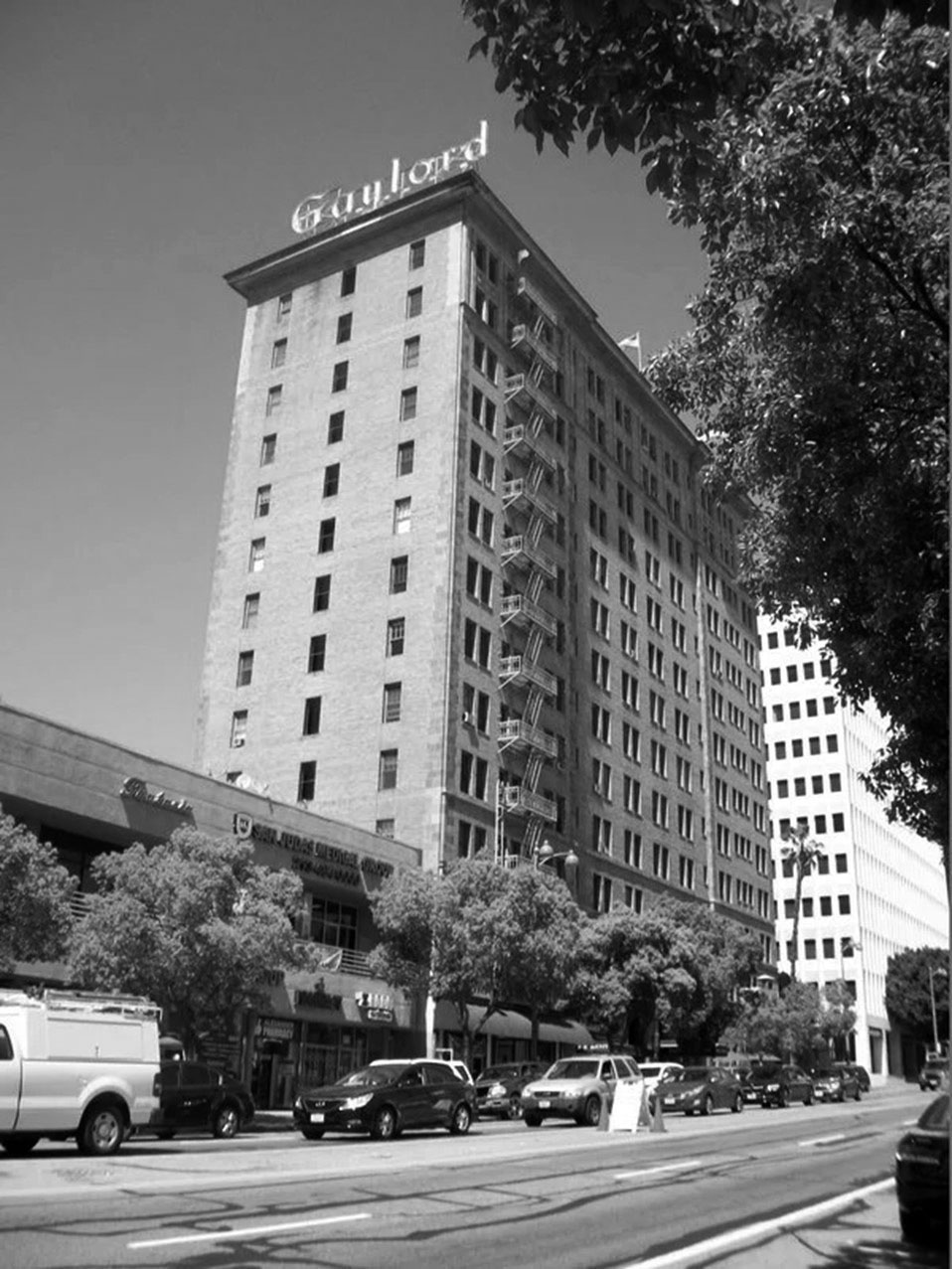 |
|
| (2013)* - Looking across Wilshire Boulevard toward the Gaylord Apartments. Photo by Hadley Meares |
* * * * * |
Richfield Oil Company Building
 |
|
| (1929)^^ - View of the Atlandtic Richfield Oil Company Building, 555 South Flower Street, shortly after it was constructed. Only the letter 'H' on the tower has been installed. |
Historical Notes Richfield Tower, also known as the Richfield Oil Company Building, was constructed between 1928 and 1929 and served as the headquarters of Richfield Oil. It was designed by Stiles O. Clements and featured a black and gold Art Deco facade. The unusual color scheme was meant to symbolize the "black gold" that was Richfield's business. Haig Patigian did the exterior sculptures.*^ |
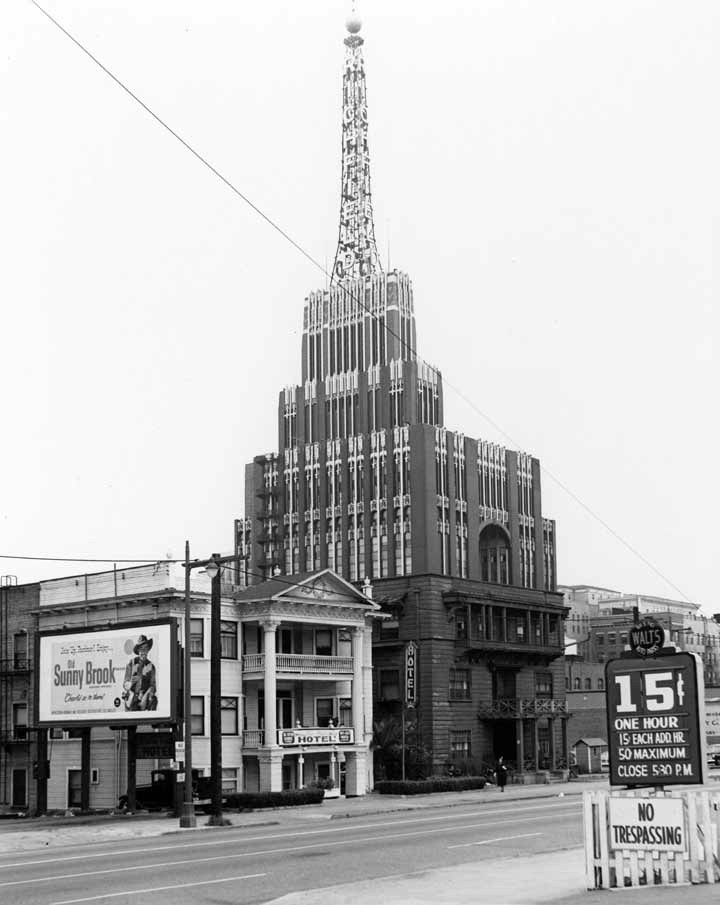 |
|
| (ca. 1929)^^ - View of the Atlantic Richfield Oil Company Building standing next to a 3-story hotel. Parking sign in the foreground reads '15 Cents ONE HOUR - 15 Cents EACH ADD HR.' |
Historical Notes The 12-floor Atlantic Richfield Building was 372 feet tall, including a 130-foot tower atop the building, emblazoned vertically with the name "Richfield". Lighting on the tower was made to simulate an oil well gusher and the motif was reused at some Richfield service stations.*^ |
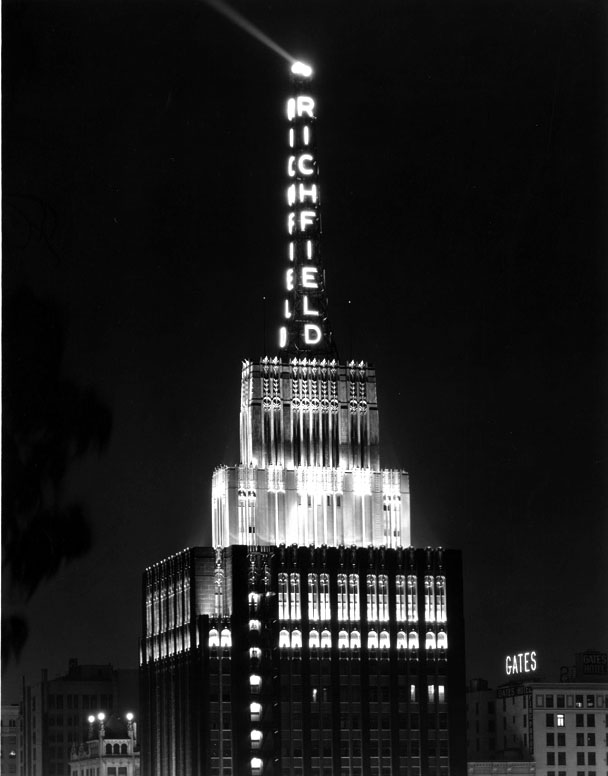 |
|
| (1929)^*# - Night view of the Atlantic Richfield Oil Company Building and its beacon, 555 S. Flower Street. |
Historical Notes The grandest of all the beacons in early Los Angeles was placed atop the Richfield Oil Company’s own magnificent headquarters building at Sixth and Flower surpassing in height even that of the beacon atop Los Angeles’ City Hall. It was the highest aviation beacon in all of Southern California and a pretty impressive advertising coup for Richfield Oil.*^#^ |
Click HERE to see more Early Views of the Richfield Oil Company Building |
* * * * * |
Edison Building
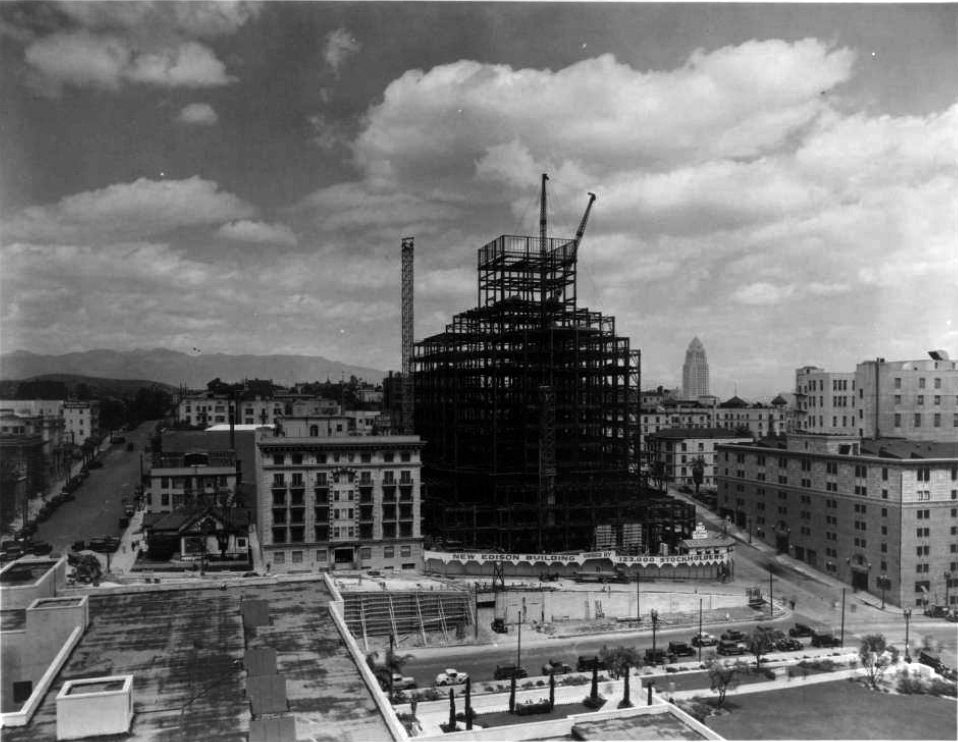 |
|
| (1930)* - View looking north showing the Edison Building under construction at the NW corner of 5th Street and Grand Avenue.City Hall is seen at a distance. |
Historical Notes The above photo was taken from the roof of the Central Library, the still under-construction Edison Building is taking shape. Next door to the left is the handsome, symmetrical Engstrum Hotel Apartments and on the corner of Hope Street is a single family residence and behind it the Pierce Apartments which will soon give way to the Engsrtrum's need for on site parking. Up Hope Street is the white Barbara Worth Apartments shown on the left. |
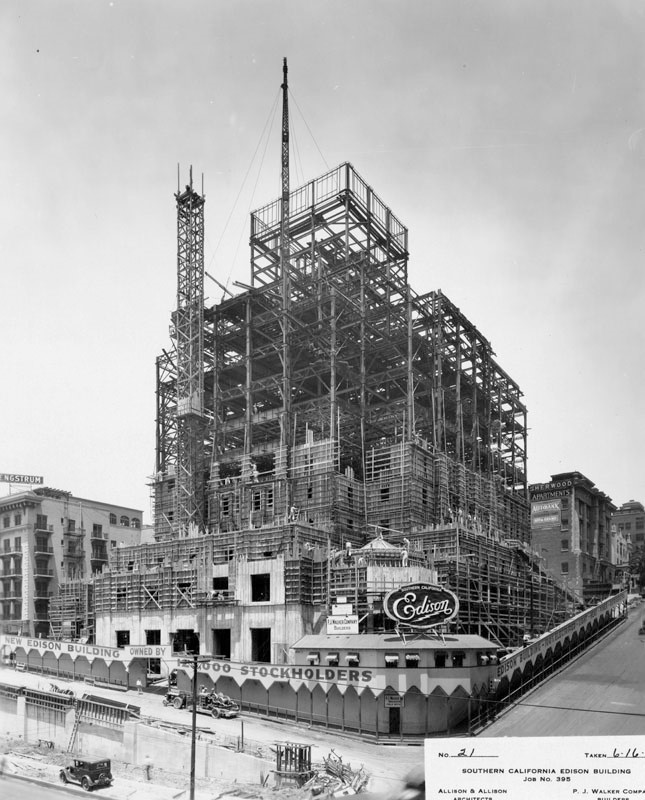 |
|
| (1930)* - View showing the Edison Building during the early stages of construction. Engstrum Hotel Apartments are on the left and the Sherwood Apartments on the right.. |
Historical Notes Located on the corner of Fifth Street and Grand Avenue the building opened on March 20, 1931 as the Southern California Edison Company corporate headquarters. |
 |
|
| (1930)* - View shows the Southern California Edison Company Building in the final stages of construction. |
Historical Notes The Edison Company Building was one of the first all-electrically heated and cooled buildings constructed in the western United States. Now known as One Bunker Hill, the Art Deco building located at 601 W. 5th Street was designed by James and David Allison. |
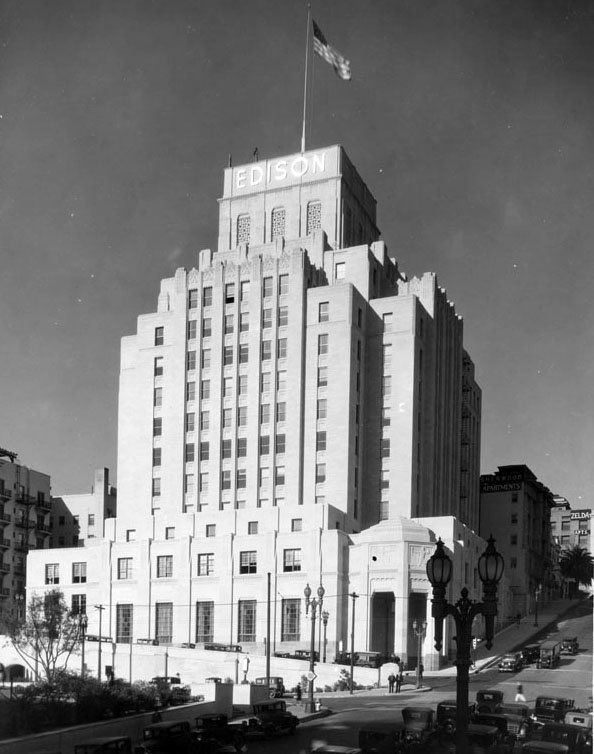 |
|
| (1931)^ - View of the Southern California Edison Building shortly after it was completed. |
Historical Notes The fourteen-story, steel-framed building follows a classically inspired Art Deco design. The lower three stories are of solid limestone, while the upper stories and central tower are faced with buff-colored terra cotta. On the façade, the spandrels contain a cubic Art Deco pattern, repeated in the central tower, lobby floor and elevator ceilings. On the entry façade allegorical figures by sculptor Merrell Gage represent, light, power and hydroelectric energy. In the two-story lobby, classical elements are treated with an Art Deco flavor.* |
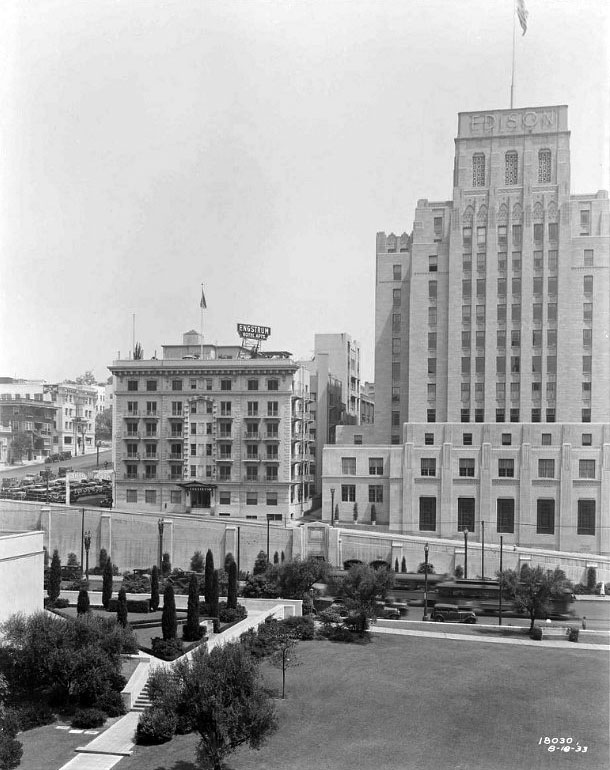 |
|
| (1933)^ - Slightly elevated view, probably from the Mayflower Hotel, looking north across the east library park to the Edison Building, the Engstrum Hotel Apartments, a small slice of the Barbara Worth Apartments, the Wickland Apartments (Rubaiyat), the Santa Barbara Apartments and part of the front of the Sons of the Revolution library. |
Historical Notes In 1939, Southern California Edison (SCE) and the Los Angeles Department of Water and Power (DWP) completed negotiations on the division of territory between the two utilities. SCE would supply the unincorporated areas within Los Angeles County and all other municipalities except for Pasadena, Glendale, and Burbank, while the DWP became the sole electrical service provider for the City of Los Angeles. Click HERE to see more in First Electricity in Los Angeles. |
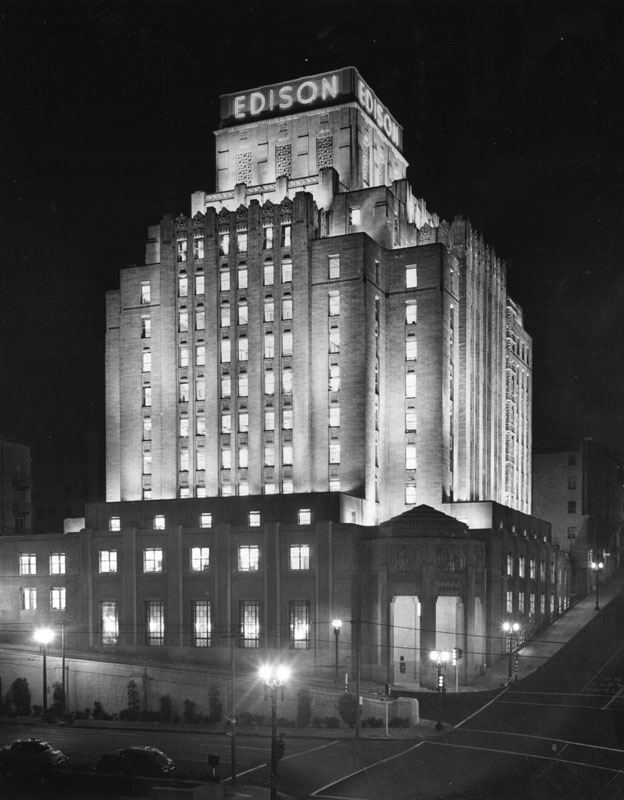 |
|
| (1970)* - Edison Building (later One Bunker Hill) on the northwest corner of Fifth Street and Grand Avenue lighted at night. The Edison Company moved out of this building on August, 15, 1971 to new headquarters in Rosemead, California, and the building and garage were sold to an investment firm. |
Historical Notes The building was renamed, The CalEdison. Before that, it was One Bunker Hill. Originally, the 14-story building, which opened in 1931, was the Southern California Edison Building and the headquarters for the Southern California Edison Company. One of the first buildings in the western U.S. with a heating and cooling system powered by electricity, it was, as the New York Times put it, a “monument to energy.” It’s not just the infrastructure; the entry facade features allegorical figures representing light and energy.^ In 1988, the One Bunker Hill Building was designated as Los Angeles Historic-Cultural Monument No. 347 (Click HERE to see complete listing). |
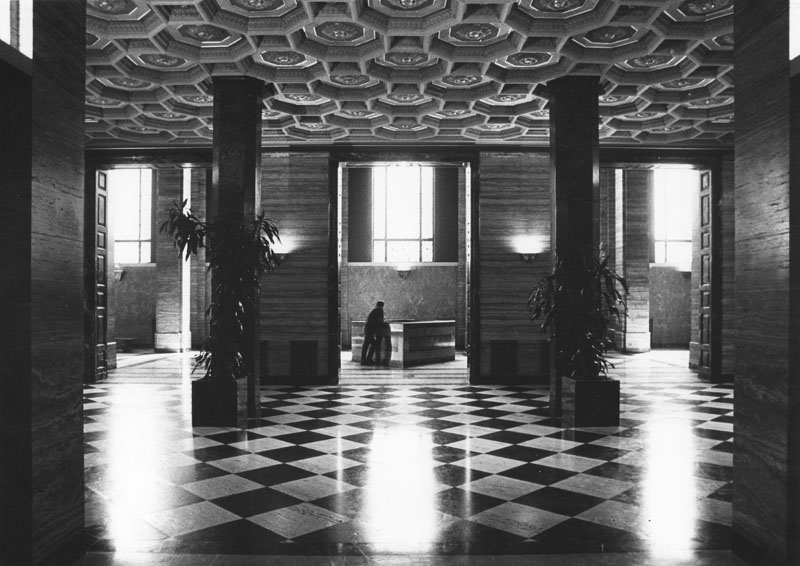 |
|
| (1987)* - The lobby of One Bunker Hill, at Grand and Fifth. The Art Deco building, also called the Edison Building, stands on the NW corner of W. Fifth Street and S. Grand Avenue. It was built from 1930-31 and the architects were Allison & Allison (Austin Whittlesey). |
Historical Notes Below the thirty-foot high coffered ceiling, the floor and walls are composed of at least seventeen different types of marble. At the end of the lobby is a mural by Hugo Ballin titled "Power." The exterior greenhouse-like structures were added in the 1980s and the street-level shopping corridor in 1993.* |
* * * * * |
Bendix Building (later Security-First National Bank)
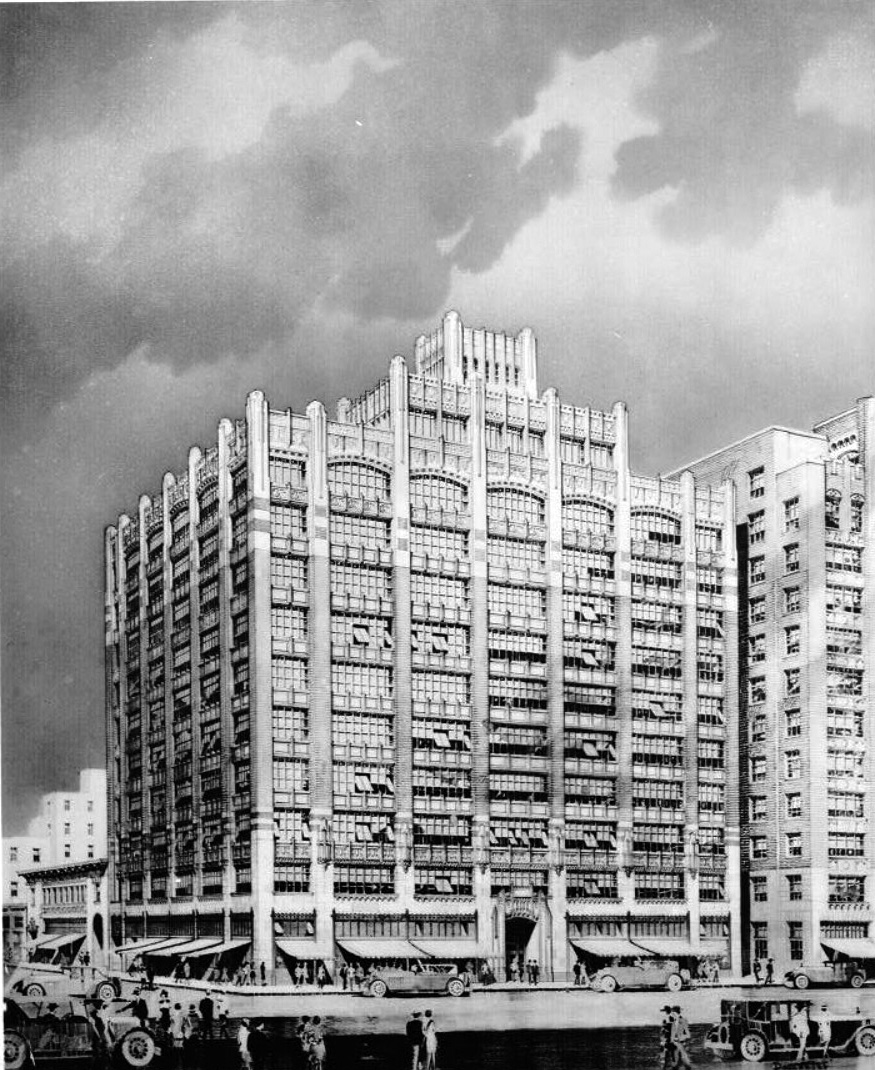 |
|
| (1929)*- View showing the design rendering for the Bendix Building located at 1206 Maple Avenue (SE corner of 12th St. and Maple Ave). |
Historical Notes The Bendix Building was constructed by developer Florence Casler in 1929. In the 1920s Casler stood out in the male-dominated commercial real estate business, putting together an empire that came to include at least ten downtown buildings worth an estimated $7 million in 1926. And she didn’t skimp. For the Bendix, she hired architect William Douglas Lee, who designed the Chateau Marmont Hotel and the El Royale apartments the same year. Lee ornamented the building’s Gothic façade with bas-relief male figures next to words such as Progress, Education, and Invention, and installed large windows that offer sweeping views of downtown. |
 |
|
| (ca. 1929)* - View looking south showing the newly constructed Bendix Building with tower located on the SE corner of 12th Street and Maple Avenue. |
Historical Notes In 1925, Florence Casler was elected director of the People’s Bank, making her the first female officer of a national bank in Los Angeles. She was also vice president of the Pico Street Association and a member of the Chamber of Commerce. In 1928, Florence officially struck out on her own when she formed the Casler Construction Company. That year, she scored her biggest client yet when she began constructing the Bendix Building at 1206 South Maple Avenue for the Bendix Aviation Corporation.* |
 |
|
| (1950s)* – View looking at the SE corner of 12th Street and Maple Avenue showing the Bendix Building. The Security First National Bank is next door, further up Maple Avenue. |
Historical Notes The Bendix Aviation Corporation was a manufacturer of aircraft parts based from 1929 to 1960 in Los Angeles. It was started by inventor Vincent Bendix in 1929 as a continuation of his auto parts company. Bendix ranked 17th among United States corporations in the value of wartime production contracts. The company was renamed to Bendix Corporation in 1960, and in 1983 was acquired by the Allied Corporation (later AlliedSignal, now Honeywell International Inc.) and combined with King Radio (company) company to form Bendix/King. Now owned by Honeywell, Bendix/King remains a brand of avionics.* |
 |
|
| (ca. 2018)* – Looking toward the intersection of 12th Street and Maple Avenue showing the 11-story Bendix Building with oversized tower-sign reading “BENDIX”. Photo by Matthew Anderson via Los Angeles Magazine |
Historical Notes Originally, the Bendix Building roof-top had one air beacon with a 50,000,000-candlepower light, 36 inches in circumference. Another of 8,000,000 candlepower, pointed to Grand Central Air Terminal, Glendale, nine miles away. The light tower's base was illuminated with a roof marker outlined in red neon, with a gigantic arrow pointing to the airport.^ In 2008, the Los Angeles Cultural Heritage Commission recognized Florence Casler as "one of the first women in the early 20th century to head a company in the field of development and construction of high-rise buildings." She was also appointed as the head of Peoples Bank of Los Angeles, making her the only female director of a bank in Los Angeles. |
* * * * * |
American Storage Building
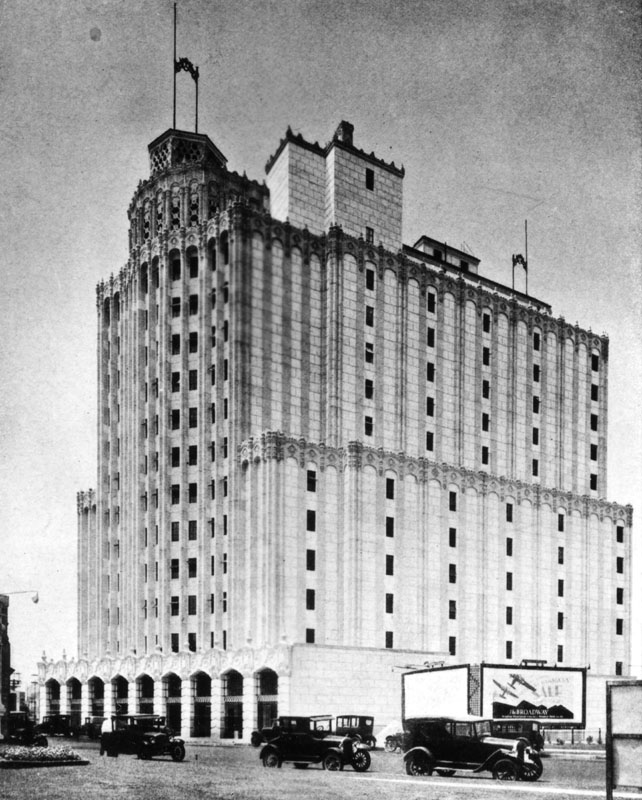 |
|
| (ca. 1929)* - The American Storage Company building located at 3636 Beverly Boulevard. |
Historical Notes This 13-story building began life in 1928 as the American Storage Building. In addition to storage units, the Bud Murray School for Stage and Lewis S. Hart Auctioneer were also early tenants of the building. Longtime cafe man E.W. 'Curley' Bordwell opened the Roof Garden in September 1928, a 'nite club de luxe' which featured dancing to the sounds of George Redman's Famous "Roof Garden Orchestra". They were apparently so famous that by early October a remote controlled broadcasting station operated by KMTR had been installed and George Redman's jazz orchestra could be heard nightly on KMTR from 10pm to 11pm. Curley's place must have been swinging during daylight hours as well - Chris Mann & His Roof Garden Melody Boys were broadcast live daily from 3:30pm to 4:30pm. Within just a year the Roof Garden had given way to 'Thirteenth Heaven', a night club with a rip-snorting theme. The elevator to the club was manned by 'St. Peter', the waiters sported wings and the musicians and attendants wore clothes 'intended to produce a spiritual illusion'. |
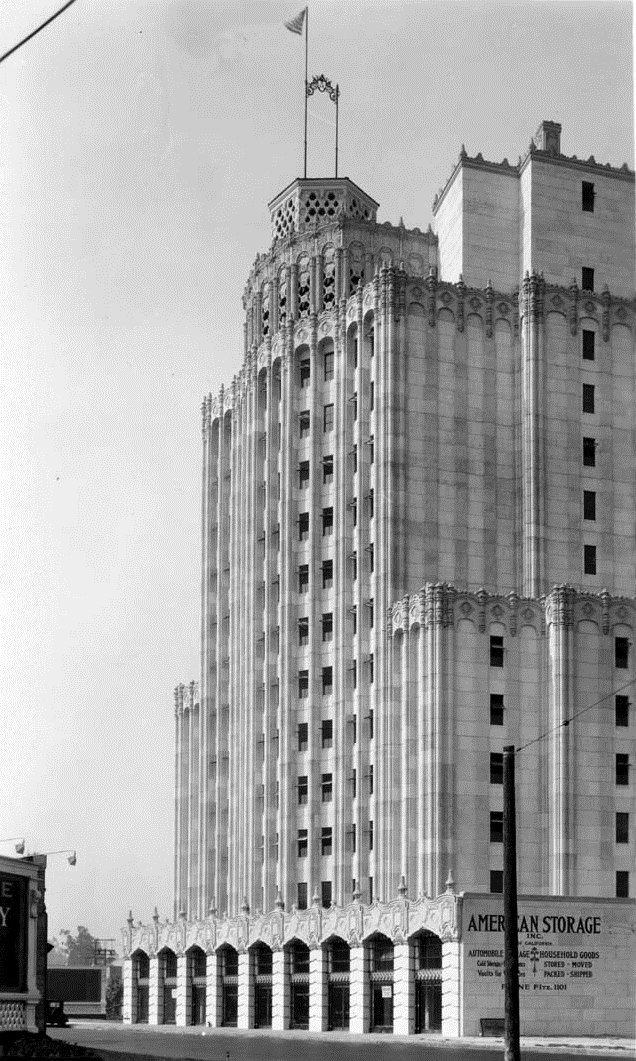 |
|
| (ca. 1929)* - View of the American Storage Building, Arthur E. Harvey, Architect. The building typifies the extent storage companies would go to disguise the mundane nature of their structures. |
Historical Notes In 1931 the 'Los Angeles Press Club' moved into the building and began having problems of their own. Their biggest problem was getting caught brewing beer during Prohibition. The 'Los Angeles Press Club' was raided March 18, 1931. Dry agents discovered a complete beer plant, 21 twelve-gallon crocks of beer mash, 203 bottles of beer - ninety of which were on ice (for the members no doubt). The 41 Club took up residence briefly in late 1931 before making the move to Spring Street. They too were raided, and approximately $10,000 worth of liquor was found in secret compartments. |
 |
|
| (ca. 1929)* - View of the front entrance to the American Storage Building showing the Art Deco/Gothic detailed design over the doorways. |
Historical Notes By the mid-1940s the building held various military organizations such as the Air Technical Service Command Headquarters and the War Assets Administration. For many years after the war it was also the headquarters for Pacific Telephone & Telegraph Company. Over the decades, the building has transformed from a cutting-edge storage and social venue to its current incarnation as a Public Storage facility, while maintaining much of its original architectural charm. Today, it remains a significant architectural landmark that offers a glimpse into Los Angeles's vibrant early 20th-century urban landscape, preserving elements of its colorful past while continuing to serve a practical modern purpose. |
* * * * * |
Hollywood Western Building
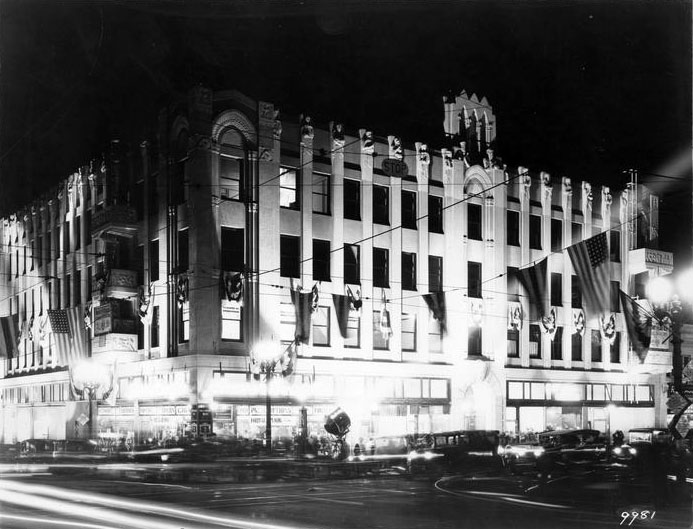 |
|
| (1928)**# - The grand opening of the Hollywood Western Building, 5500 Hollywood Blvd, on December 8th, 1928. |
Historical Notes The S. Charles Lee designed Hollywood Western Building, 5500-5510 Hollywood Blvd, was built in 1928. The building was financed by Louis B Mayer and Irving Thalberg for the Motion Picture Association of America (MPAA), including the Hays Office. The building also housed Central Casting. |
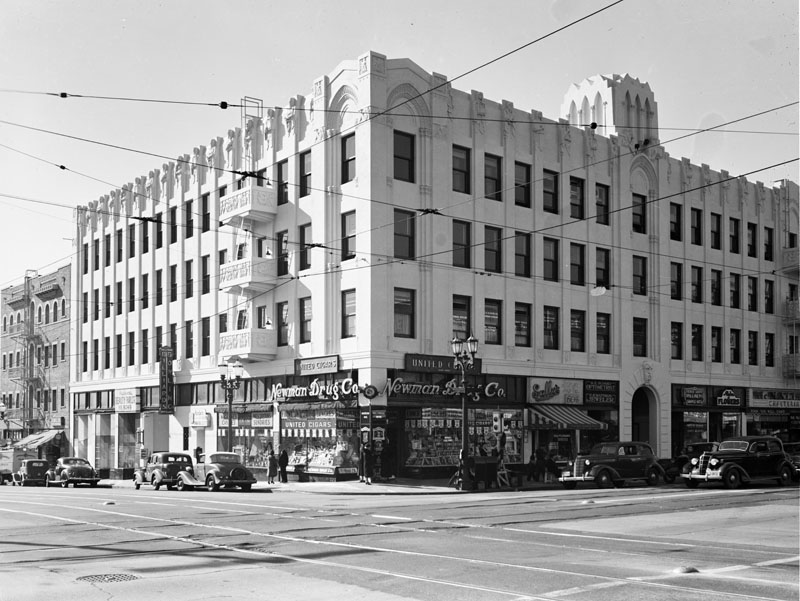 |
|
| (1930s)* - Exterior view of the four-story Hollywood-Western Building housing the Central Casting Corp. and various retail shops located on the southwest corner of Hollywood Blvd. and Western Avenue. Newman Drug Co. is on the corner. |
Historical Notes In 1988, the Hollywood Western Building was designated LA Cultural-Historic Monument No. 336 (Click HERE to see complete listing). |
* * * * * |
Powell Library (UCLA)
.jpg) |
|
| (1929)* - Exterior view of the library, now Powell Library, under construction at the U.C.L.A. Westwood campus in 1929. This building was built 1927-29 and designed by architect George W. Kelham. |
Historical Notes In 1919 the school obtained university status and became the Southern Branch of the University of California, located at 855 N. Vermont Avenue. In 1927 the name was changed to the University of California at Los Angeles. On May 31, 1929 the university opened its new campus in Westwood on land sold for $1 million dollars. In 1958, the name changed slightly again when the "at" was dropped, and became simply University of California, Los Angeles or UCLA.* |
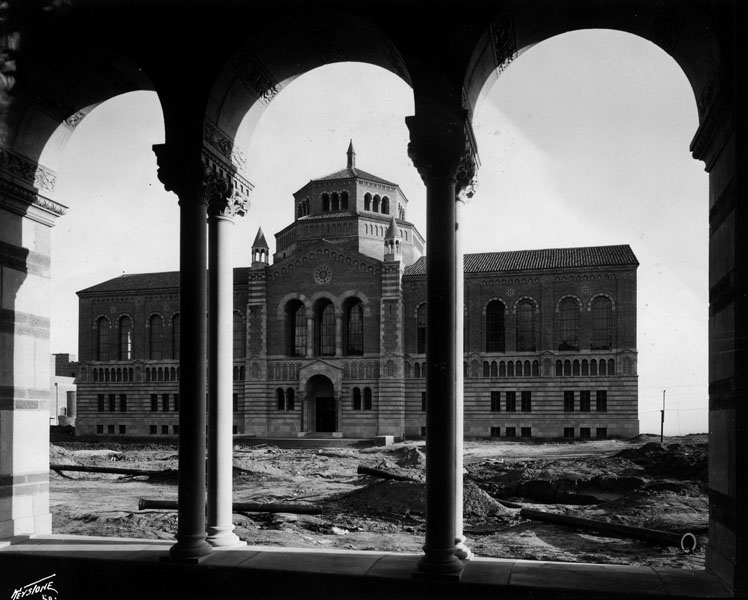 |
|
| (1929)* - Construction of the new U.C.L.A. Westwood campus in 1929. View is looking from Royce Hall's construction site, towards the near completion of Powell Library. |
Historical Notes Westwood and UCLA were developed on the lands of the historic 'Wolfskill Ranch', a 3,000-acre parcel that was purchased by Arthur Letts, the successful founder of the Broadway, and Bullock's department stores, in 1919. Upon Arthur Lett's death, his son-in-law, Harold Janss, vice president of Janss Investment Company, inherited the land and developed the area and started advertising for new homes in 1922.*^ |
.jpg) |
|
| (1929)* - Exterior view of Powell Library at the U.C.L.A. Westwood campus. Students are seen walking to and from the library, amid the construction activity. Building was built 1927-1928 in a northern Italian Romanesque Revival style. |
Historical Notes In 1925, in a deal to get the University of California, Los Angeles built, the Janss Investment Company sold 375 acres to the cities of Los Angeles, Santa Monica and Beverly Hills at the bargain price of $1.2 million — about a quarter of its value. The cities, whose voters had passed bond issues to pay for the site, turned around and donated it to the state. While the UCLA campus was being built, Janss Investment Company went to work developing the Westwood Village commercial area and surrounding residential neighborhoods.*^ |
 |
|
| (1929)* - View of Royce Hall, at the time that the U.C.L.A. Westwood campus opened in 1929. Building was built in 1928-29, in a northern Italian Romanesque Revival style designed by Allison and Allison, Architects. |
.jpg) |
|
| (1929)* - View looking west at the bridge which connects Hilgard Avenue to the main campus quadrangle at the U.C.L.A. Westwood campus. The gully over which the bridge passed was filled in after World War I. Bridge was designed by architect George W. Kelham. Powell Library may be seen on the left. Building was built in 1927-29 and designed by architect George W. Kelham. The twin towers of Royce Hall may be seen on the right. Building was built in 1928-29 and designed by Allison and Allison, Architects. Both campus buildings were constructed in a northern Italian Romanesque Revival style. |
Historical Notes The bridge seen above connected Hilgard Avenue to the campus. The gully over which the bridge passed was filled in after World War II.* |
.jpg) |
|
| (1929)* - Aerial view of the UCLA campus during construction. View shows Royce Hall, left rear, and the Physics building, center right. Both buildings were built in 1928-29, and designed by Allison and Allison, Architects. Haines Hall, right rear, was built in 1928. Powell Library, center left, was built in 1927-29. Moore Hall (under construction), in foreground, was built in 1930. These three buildings were designed by architect George W. Kelham. All five campus buildings were constructed in a northern Italian Romanesque Revival style. |
Click HERE to see more in Early Views of UCLA |
* * * * * |
Janss Dome Building
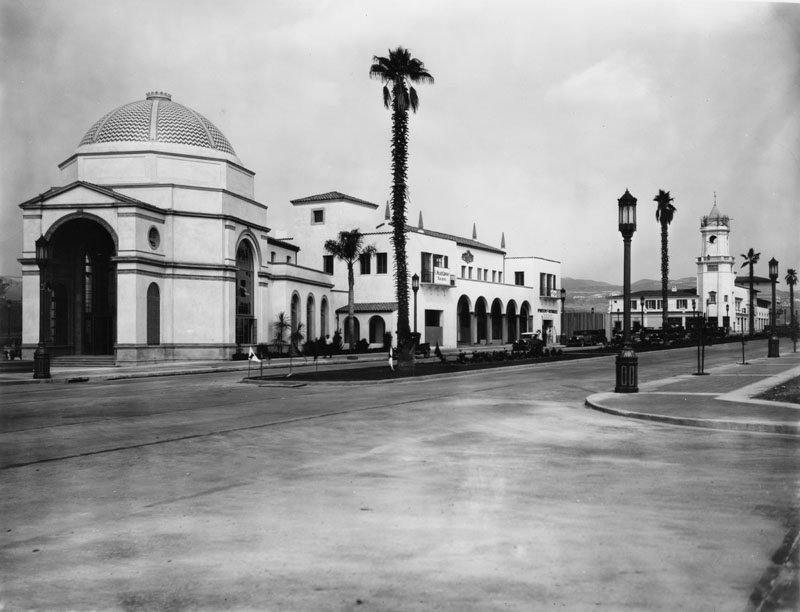 |
|
| (ca. 1930)* - A view of Westwood Boulevard's Bank of America building (also known as The Dome). P. J. Walker Company and Phelps Terkel. |
Historical Notes This northwest corner of Westwood Boulevard and Broxton Avenue is called "The Dome," and it served as offices for the Janss Investment Company when built. It was designed by Allison and Allison. The octagonal building remains the dominant structure within Westwood Village. Building at right in rear is the Holmby Building, designed by architect Gordon B. Kaufmann and built in 1930.* |
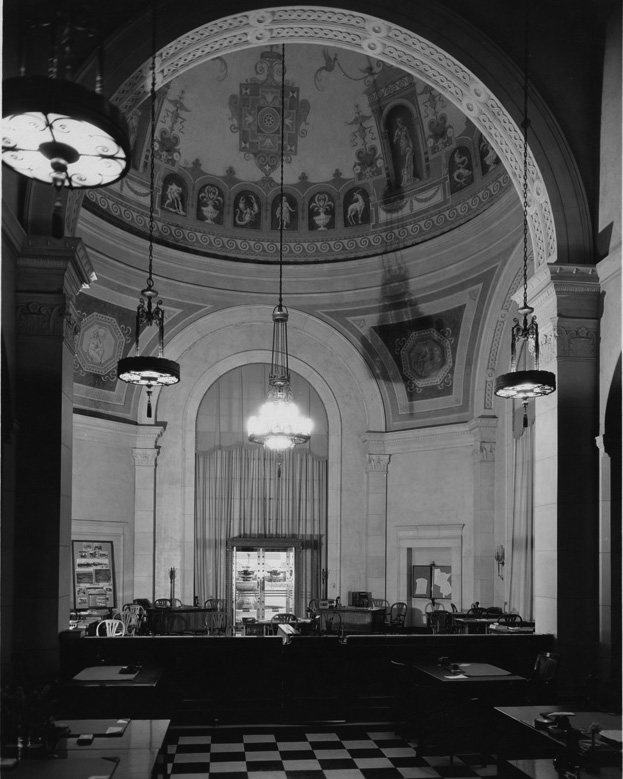 |
|
| (ca. 1930s)^*# - Interior view of the ornately designed Janss Dome circa 1930s. |
Historical Notes The Janss Dome was designed by the architectural firm of Allison & Allison who also designed UCLA’s Royce Hall and Kerckhoff Hall. Architectural features of the building include a high portico and arched windows with the main part of the building having an octagonal shape and being surmounted by its signature dome with its Moorish style aqua and white zig-zag pattern and gold leafing. Atop the dome is a cupola.*^ |
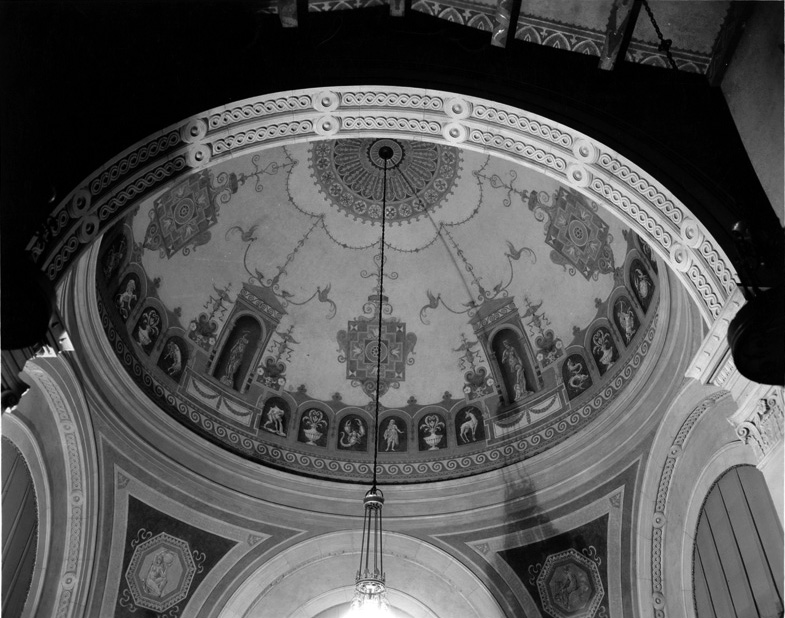 |
|
| (ca. 1930s^*# - Looking up at the beautiful rotunda ceiling of the Janns Dome Building. |
Historical Notes Around the beginning of the 1990s renowned architectural firm Morphosis adapted the Dome for use as a clothing store by Contempo Casuals, and later it was occupied by a Wherehouse Music store. In 1998 restaurateur Michael Chow remodelled the interior for a Eurochow restaurant but had the time-honored aqua and white zig-zag on the rotunda painted over in white. This caused the Westwood Design Review Board to order that the dome be restored to its traditional decoration. The Janss Dome currently houses a Japanese restaurant, the Yamato.*^ |
Click HERE to see more in Early Views Westwood |
* * * * * |
Holmby Building
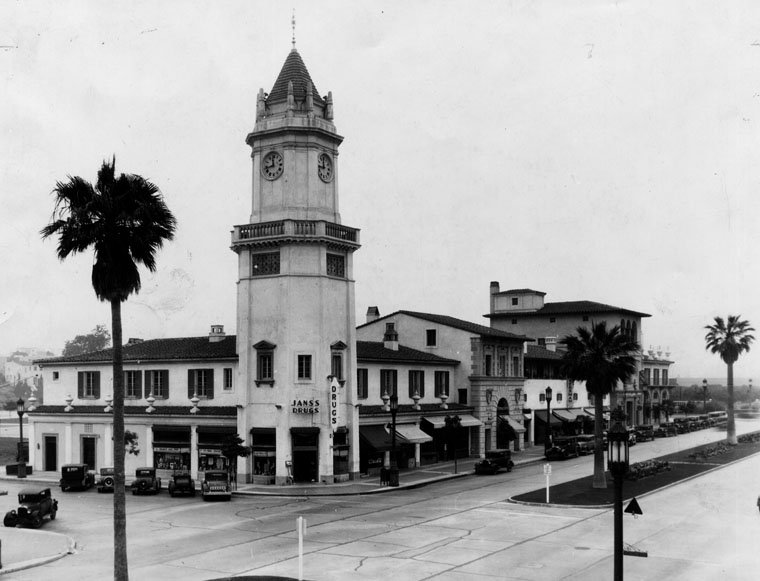 |
|
| (1932)* - Exterior view of Holmby Building, designed by Gordon B. Kaufmann, in Westwood Village. Photo caption reads: The Sawyer School of Commerce signed a 10-year lease on the greater portion of the second floor, and will open a branch in the fall. Photo dated: August 8, 1932. |
Historical Notes Built in 1929, Holmby Hall is a streetscape of six Spanish Colonial Revival storefronts and features a prominent white clock tower, capped by a green pinnacle. It was the first shop building to be erected in the architecturally significant cinema/shopping precinct of Westwood Village. Holmby Hall’s history is tied in with that of UCLA, as the building was used as the first dormitory for female students of that famous university.*^ |
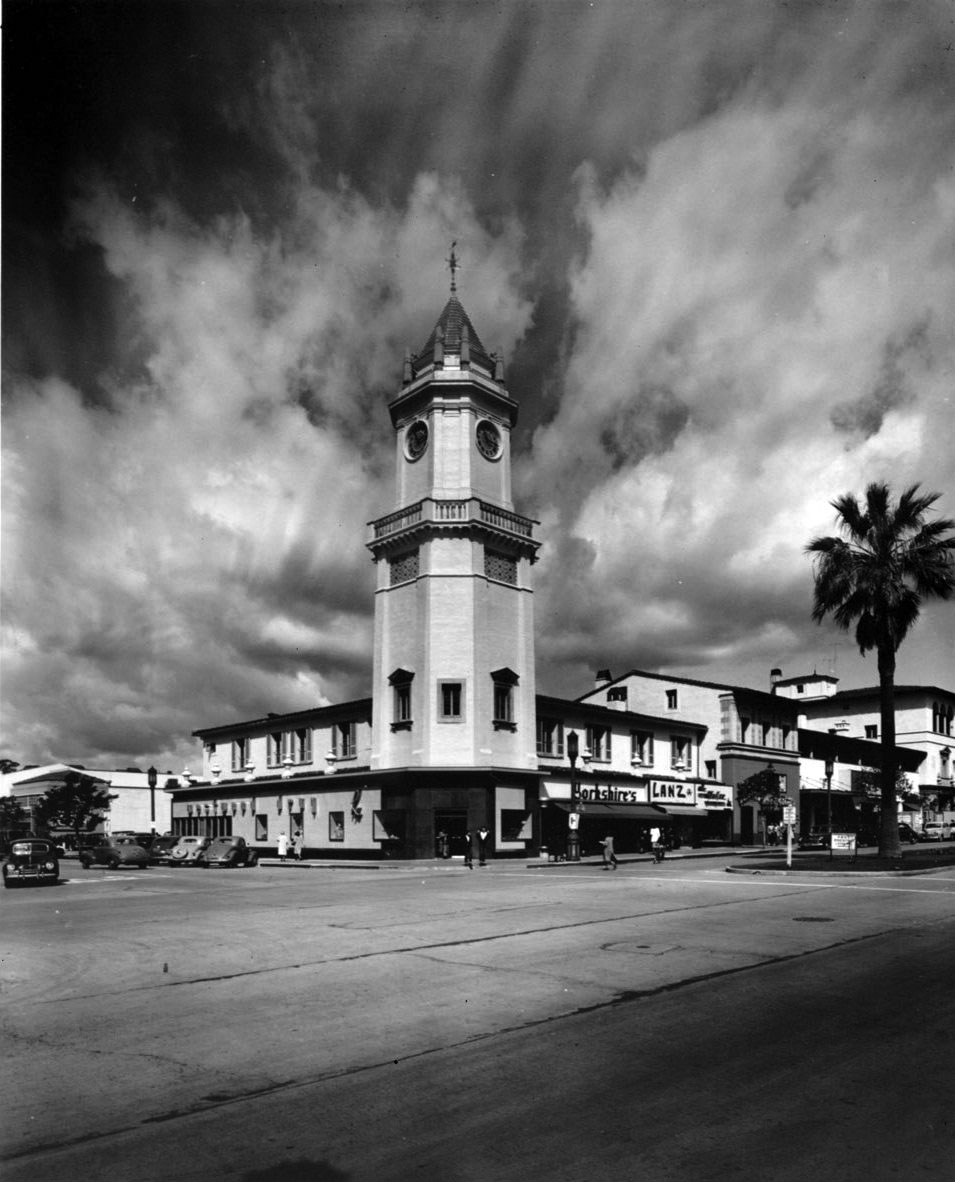 |
|
| (ca. 1948)^^ - A closer view of the Holmby Building (Hall) located at 921 Westwood Boulevard in the block between Weyburn and Le Conte Avenues, with the clock tower on the corner of Weyburn Avenue. |
Historical Notes Westwood Village was created by the Janss Investment Company, run by Harold and Edwin Janss and their father, Peter, in the late 1920s as an autonomous shopping district and headquarters of the Janss Company. Its boom was complemented by the boom of UCLA (which selected the Westwood Hills as its new home in 1926), developed as a shopping district not just for the residents of Westwood but also for the university.*^ |
Click HERE to see more in Early Views Westwood |
* * * * * |
Westwood Professional Building
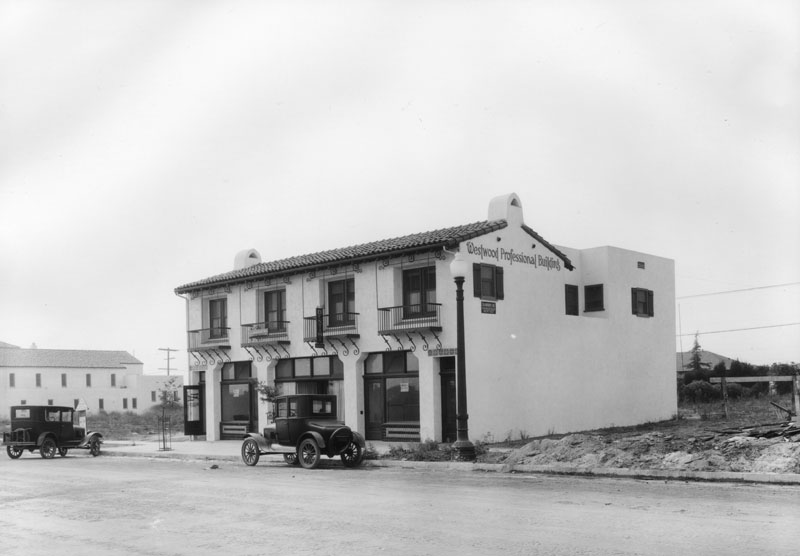 |
|
| (1934)* - A view of the Westwood Professional Building. Note the empty land surrounding the building, ripe for more development. |
Historical Notes Click HERE to see more of Westwood in Early Views of UCLA |
* * * * * |
Hess Tire Service
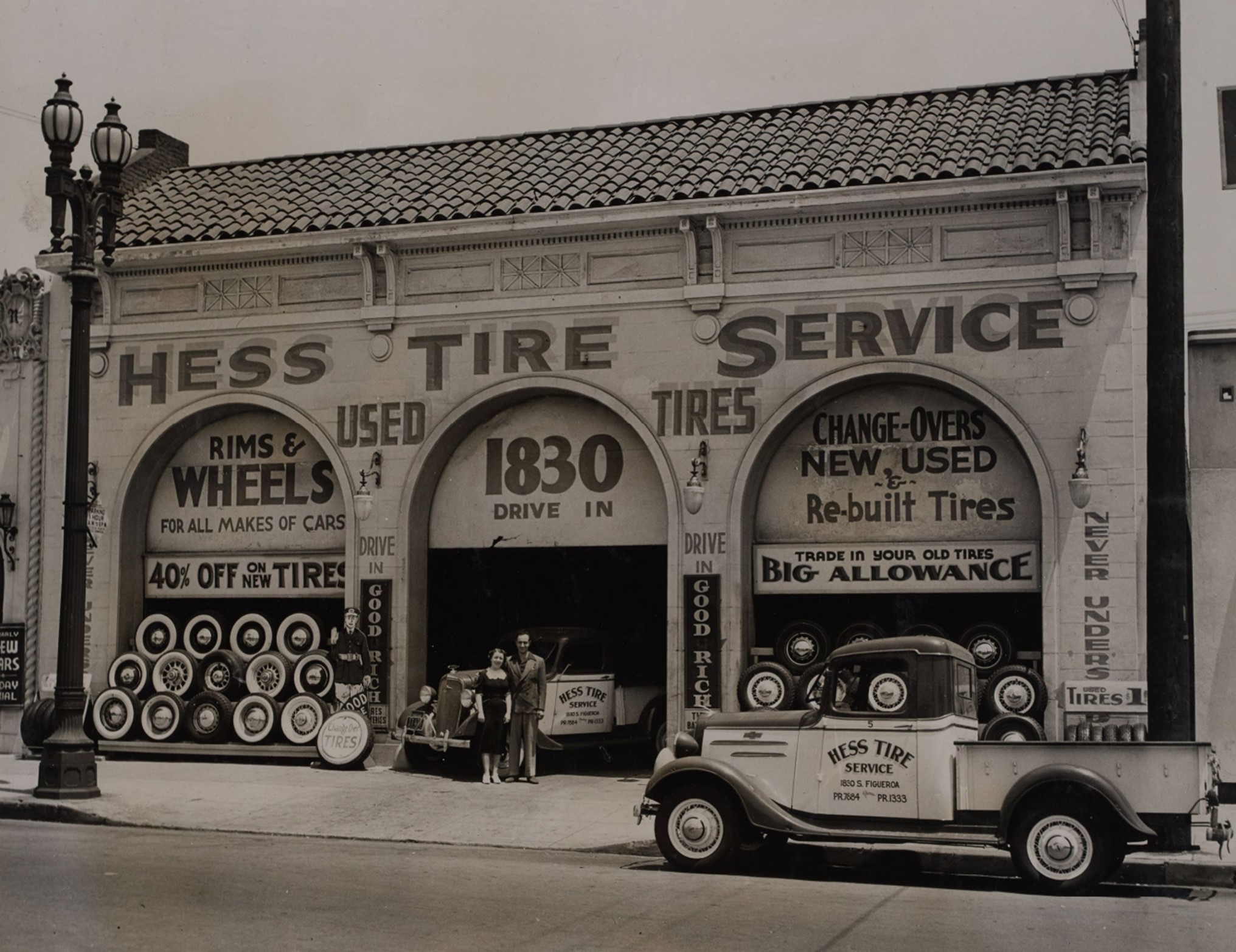 |
|
| (1930s)* - View of the Hess Tire Service garage storefront at 1830 South Figueroa Street in Los Angeles, California, with a couple standing on the sidewalk, and a truck at the curb. Signs on the building include "Rims & Wheels For All Makes of Cars," "Good Rich Tires," "Change-Overs, New Used & Re-built Tires," "Trade In Your Old Tires, Big Allowance." Photo from the Ernest Marquez Collection. |
Historical Notes There’s a lot to take in from this 1930s vintage image of Hess Tire Service at 1830 S. Figueroa Street. A couple, presumably the owners, stand in front of the ornate building, posing for the camera. The signage on the façade stands out, including one that boldly states, “Never Undersold” and advertises used tires for $1. On the left, a beautiful dual-lamp streetlight, known as a UM (Union Metal) 1906 electrolier, adds to the historic character of the scene. While common at the time, some retrofitted versions still exist in downtown Los Angeles today. |
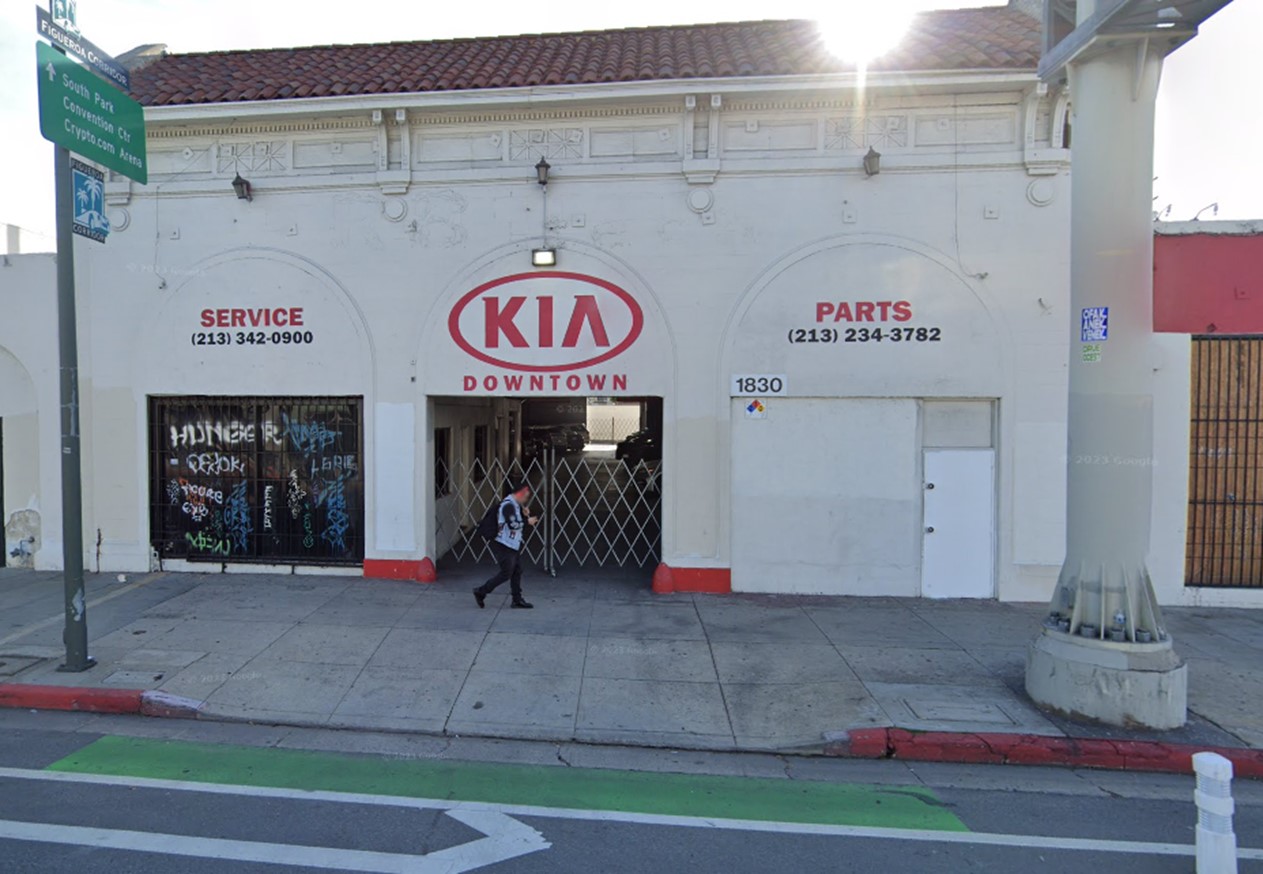 |
|
| (1930s vs 2023)* - A 'Then and Now' comparison of the building located at 1830 South Figueroa Street. Note: as of 2025, KIA no longer occupied the building. |
Then and Now
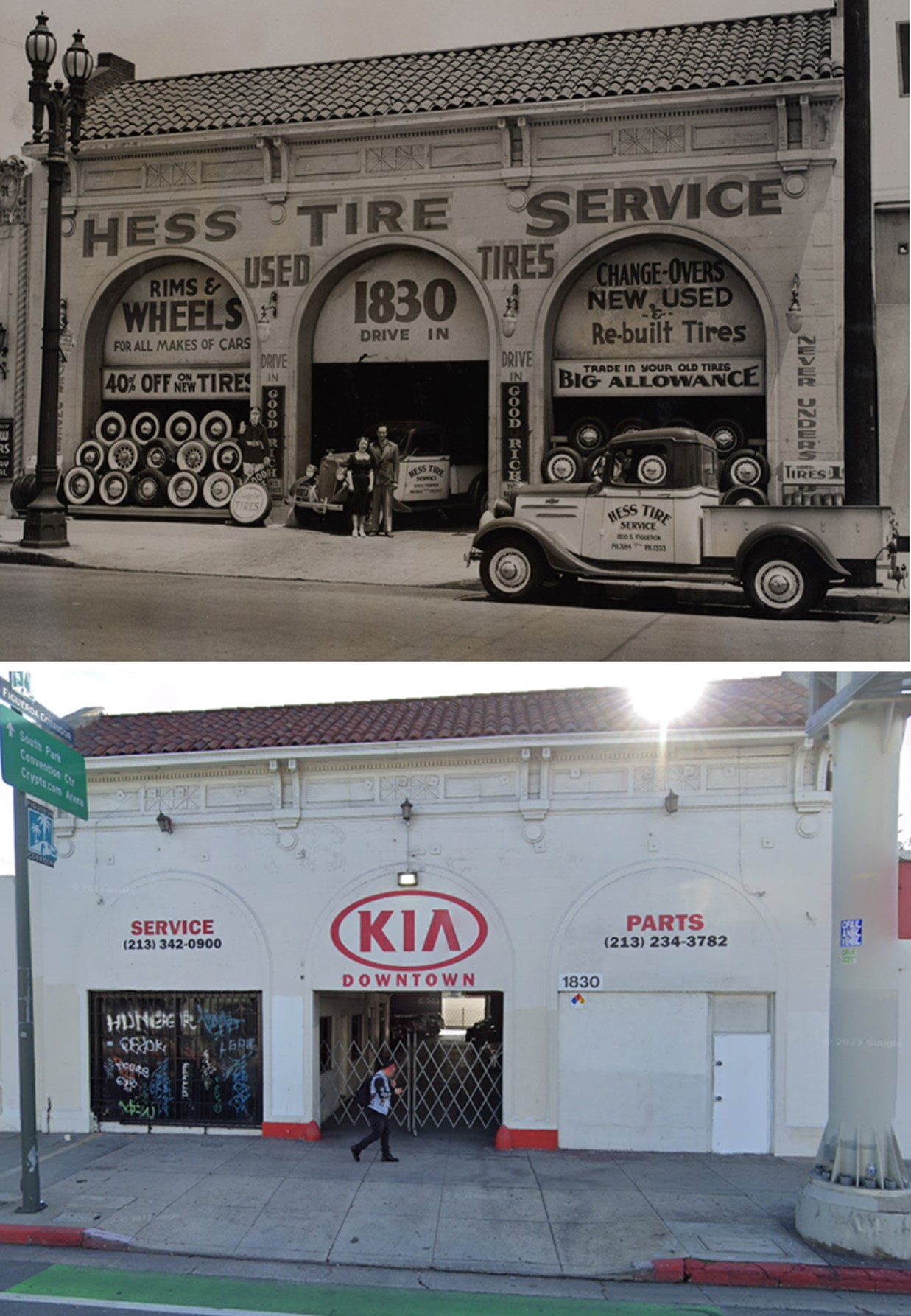 |
|
| (1908)* - Spring Street looking north from 7th Street. Note the horse-drawn wagon parked at the curb under an ornate 5-globe streetlight. Image enhancement and colorization by Richard Holoff. |
* * * * * |
Automobile Club of Southern California
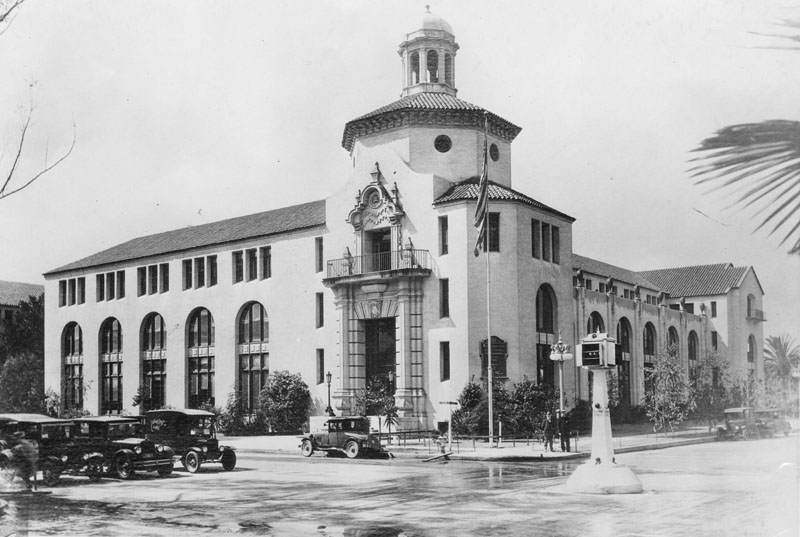 |
|
| (1930)* - The Automobile Club of Southern California, located at 2601 S. Figueroa St. Three cars traveling northbound can be seen on the left, waiting at the intersection; Adams Blvd is visible on the right. |
Historical Notes The Automobile Club of Southern California, one of the nation's first motor clubs dedicated to improving roads, proposing traffic laws, and improvement of overall driving conditions, was founded on December 13, 1900 in Los Angeles. The Auto Club was responsible for producing state road maps, as well as posting thousands of porcelain-to-steel traffic signs throughout the state to create a uniform signing system - which it continued to do until the task was taken over by the State of California in the mid-1950s. |
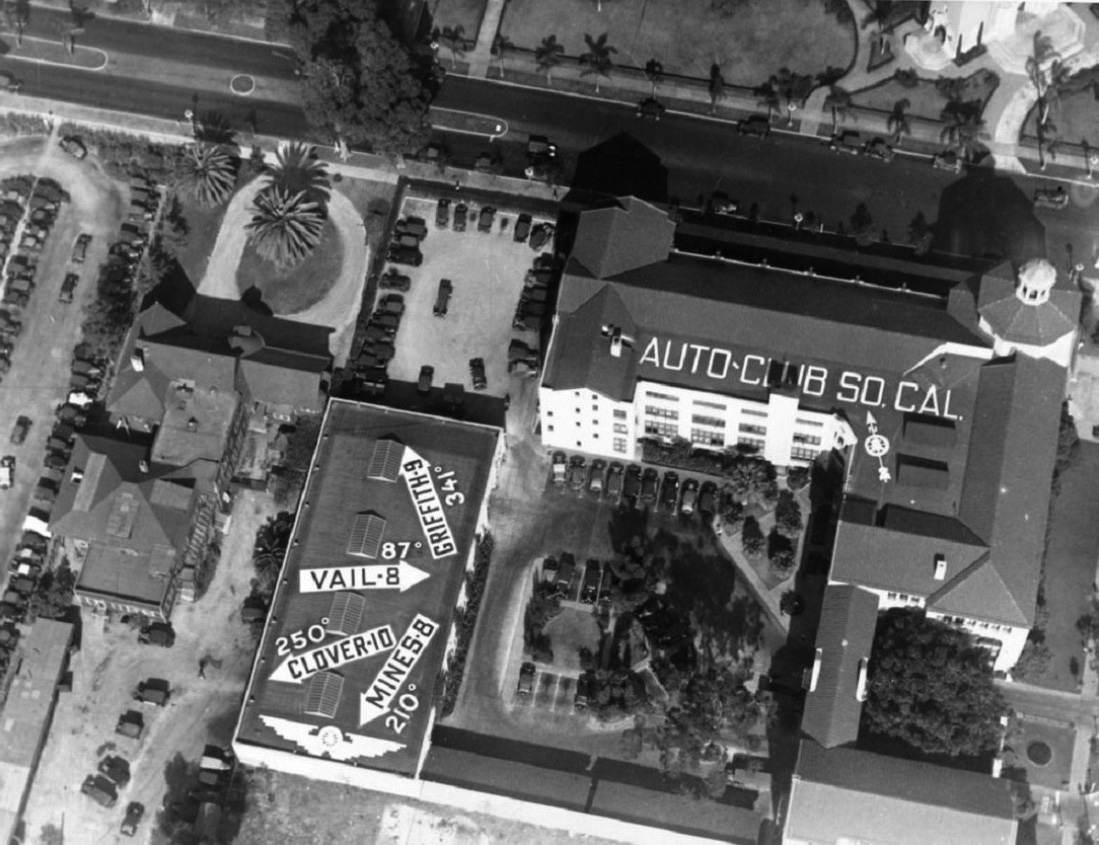 |
|
| (1930s)* - Aerial view directly over the Automobile Club of Southern California building on Figueroa St. in Los Angeles. Signs are painted on the building's roof indicating direction and distances to nearest airports. |
Historical Notes The arrow points to Mines Field (8 Miles) which became LAX. Click HERE to see more. |
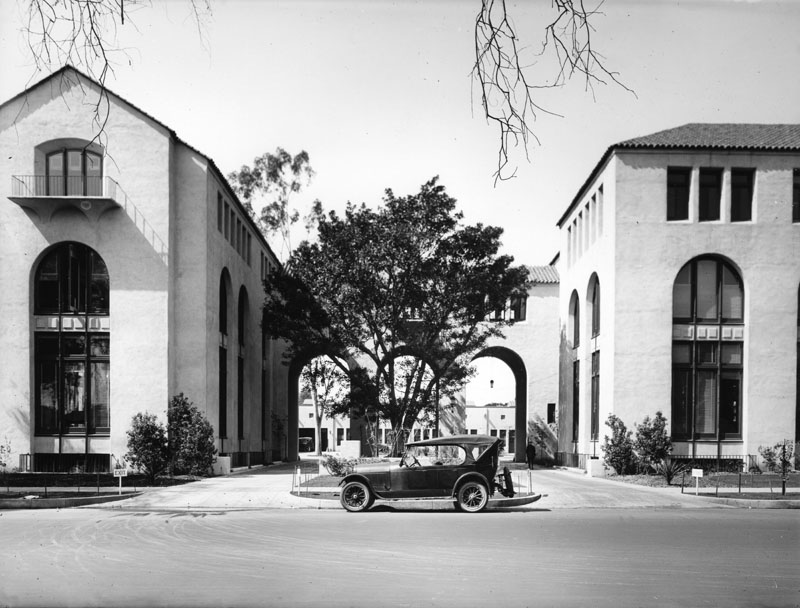 |
|
| (ca. 1930)* - Exterior view of the Automobile Club of Southern California, located at 2601 S. Figueroa St. at Adams Blvd. A car is parked is the entrance to the parking station on the east side of the building. |
Historical Notes The building pictured here originally served as the Auto Club's main office. It was built between 1922-1923 by architects, Sumner P. Hunt, Silas R. Burns, and Roland E. Coate in the Spanish Colonial Revival style. Today, this building serves as the Los Angeles district office, but the administrative offices are now located in Costa Mesa. |
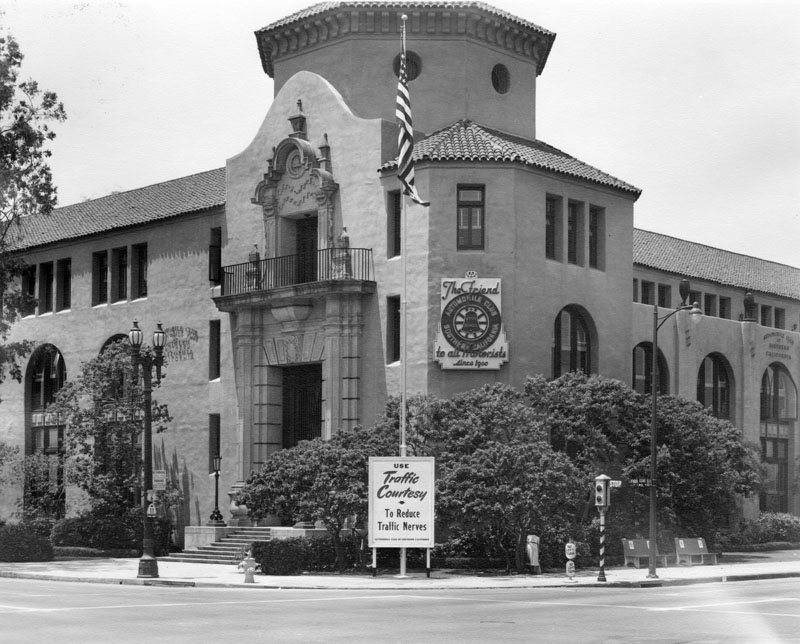 |
|
| (1951)* - View of the entrance of the Automobile Club of Southern California, located at 2601 S. Figueroa St. A sign posted on the corner reads, "Use Traffic Courtesy to Reduce Traffic Nerves". |
Historical Notes The Automobile Club Building was designated LA Historic-Cultural Monument No. 72 (Click HERE to see complete listing). The Auto Club was founded in 1900. It's first headquarters was located on the first floor of a three-story building (still standing) at 8th and Olive streets. Click HERE to see more. |
* * * * * |
Bovard Hall (USC)
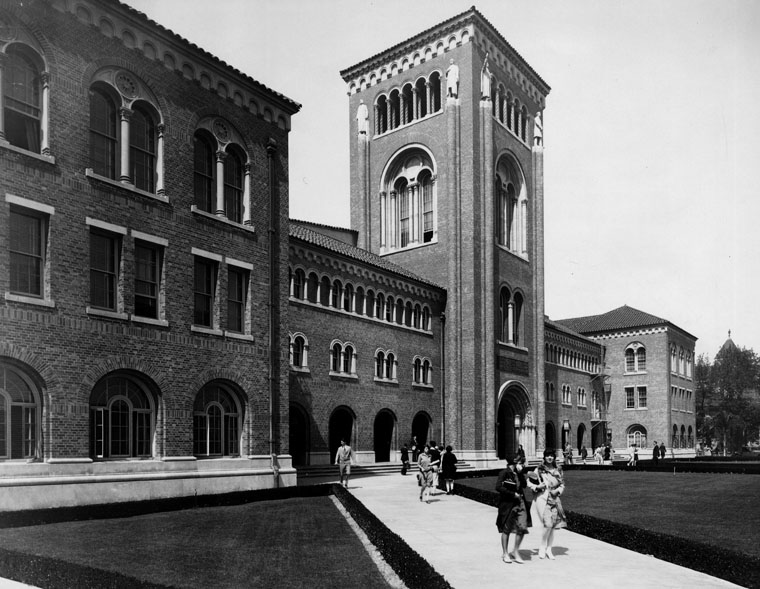 |
|
| (ca. 1930)* - Exterior view of Bovard Hall, U.S.C.'s Administration building. Note the architectural designs on the building and carved statues on the tower. Date built: 1921. Architects: John and Donald Parkinson. |
Historical Notes The University of Southern California (USC) was founded in 1880, making it California's oldest private research university. USC's development has closely paralleled the growth of Los Angeles, and the university historically has educated a large number of the city's business leaders and professionals.*^ |
* * * * * |
School of Law (USC)
 |
|
| (ca. 1930)* - Exterior view of the School of Law at U.S.C. Three high arches decorate the front entrance. Note the architectural designs on the building. Date built: 1928. Architects: John and Donald Parkinson. |
Historical Notes USC Law School had its beginnings in 1896 when Judge David C. Morrison opened his courtroom for 36 law apprentices, among whom were future California Supreme Court Justice Frederick W. Houser and his wife, Sara Isabella Wilde; the couple would soon form the Los Angeles Law Students Association to discuss the concept of a formal law school. Their efforts resulted in the incorporation of the Los Angeles Law School in 1898. The first law degree was awarded in 1901 to Gavin W. Craig. Over the next several decades, USC Law rose to become one of the most prominent national law schools, priding itself on an interdisciplinary form of study. 2002 saw the beginning of the USC Law Graduate and International Programs. It is an American Bar Association (ABA) approved law school since 1924. It joined the Association of American Law Schools (AALS) in 1907.*^ |
* * * * * |
Edward Doheny Jr. Memorial Library (USC)
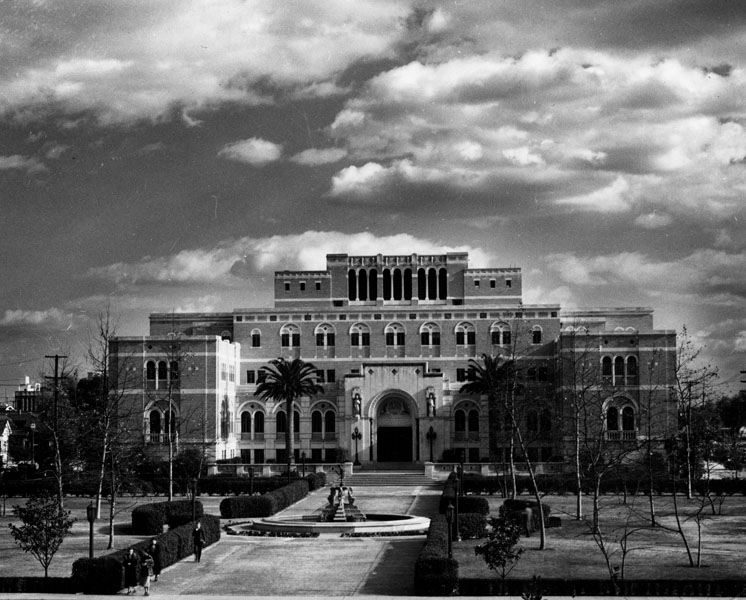 |
|
| (1932)* - Exterior view of Edward Doheny Jr. Memorial Library on the U.S.C. campus. A large fountain graces the middle of the walkway leading to the front of the building. Note the architectural designs. Building was built in 1931 and designed by architects Cram and Ferguson with Samuel Lunden. |
Historical NotesIn 1892, Edward Laurence Doheny Sr. struck oil in Los Angeles, setting off a major land boom. The Dohenys built a financial empire based upon their success in the oil-producing business. Their son, Edward L. 'Ned' Doheny Jr., studied at USC and remained involved in the university after his graduation in 1916. Tragically, he was murdered at his home in Beverly Hills in February 1929. As a memorial to their son, the Dohenys contributed the entire $1.1 million needed to build the Edward L. Doheny Jr. Memorial Library and actively participated in the design and construction of the facility.^ |
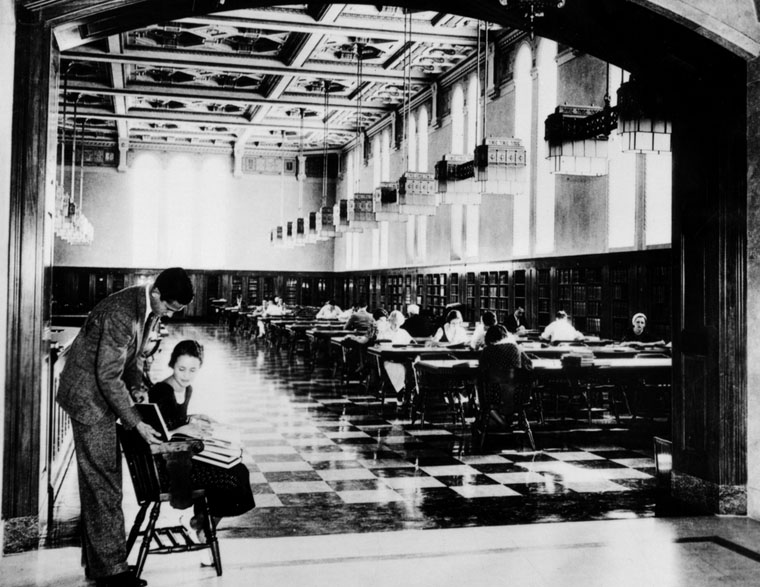 |
|
| (ca. 1932)* - Interior view of Edward Doheny Jr. Memorial Library at the University of Southern California, showing students studying in the main reading room. |
Historical Notes The Times Mirror Reading Room is one of Doheny Library’s most popular study locations. The exquisite architecture includes bronze and pewter chandeliers as well as American walnut bookshelves. The room is 131 feet long, 46 feet wide, and 27 feet high. It has shelves for 6,000 books and accommodates 400 readers.^^ |
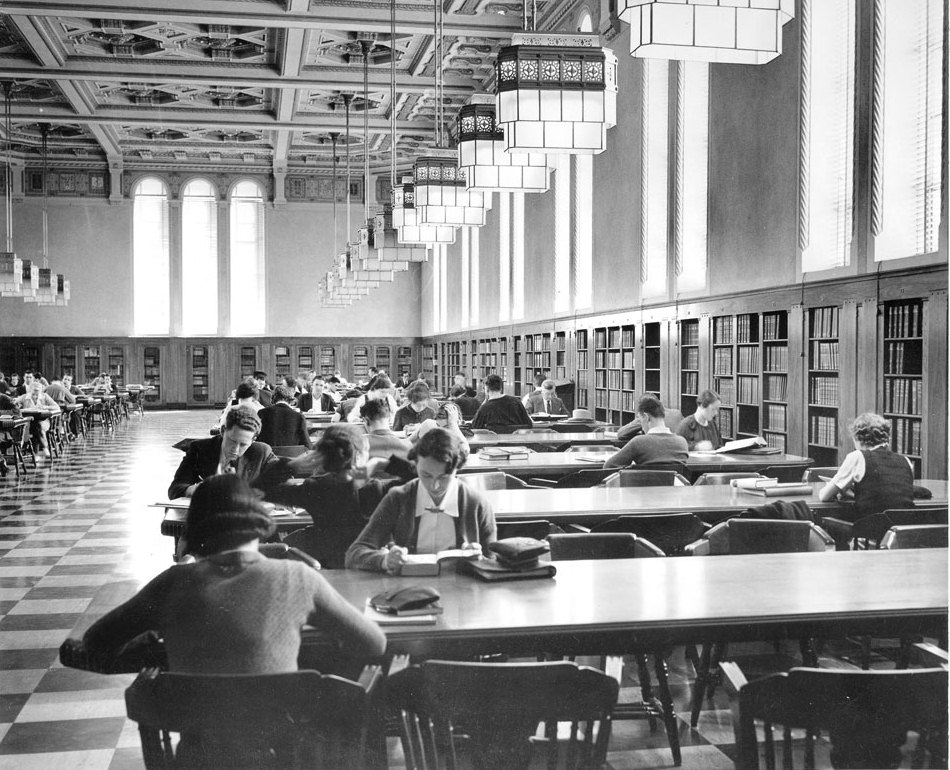 |
|
| (ca. 1950s)^^ - Closer view of students studying in the Times Mirror Reading Room of the Doheny Library. |
* * * * * |
Student Union (USC)
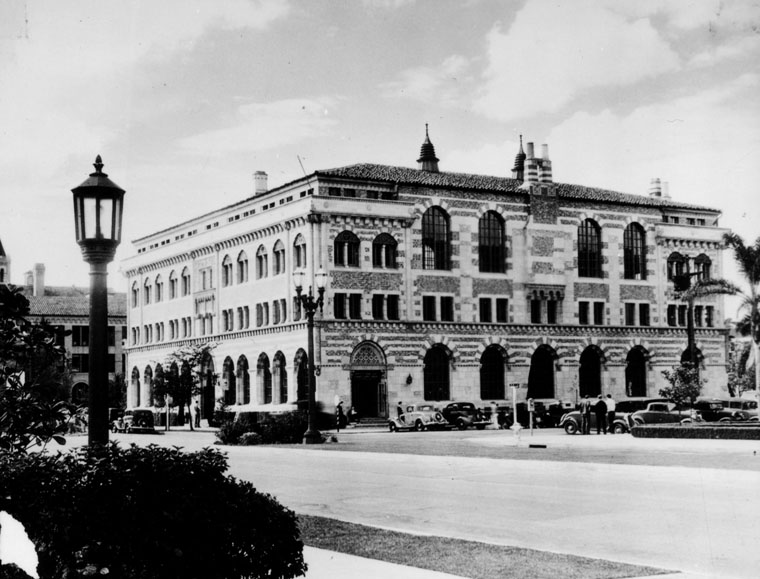 |
|
| (ca. 1935)* - Exterior view of the Student Union building at U.S.C. Date built: 1928. Architects: John & Donald Parkinson. |
Click HERE to see more in Early Views of U.S.C. |
* * * * * |
Barkies Sandwich Shops
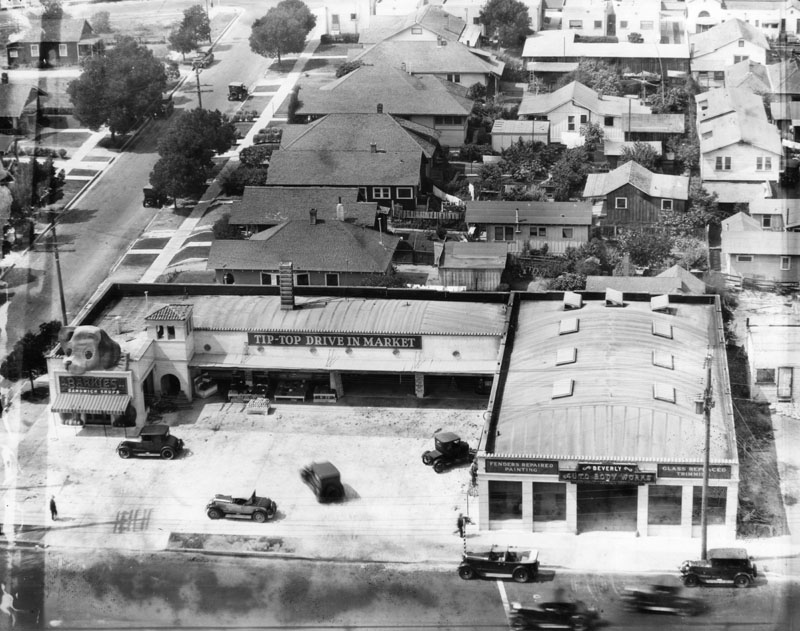 |
|
| (1929)* - Aerial view of an early "mini mall" at 3649 Beverly Boulevard, consisting of Barkies Sandwich Shops, which features a puppy's head on the roof and paws by the entrance. Also shown are the Tip-Top Drive in Market and a bodyshop. |
Historical Notes Barkies Sandwich Shops was a 1920s Los Angeles restaurant chain, featuring a larger than life mascot named “Ponderous Pup.” These types of shops were an early precursor to the mini-mall idea.* |
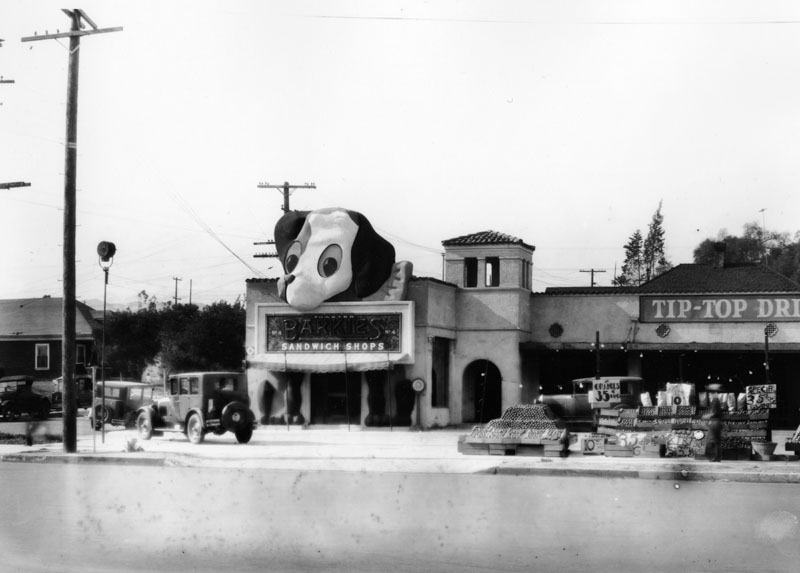 |
|
| (1930)* - Closer view of Barkies Sandwich Shops located on the northeast corner of Beverly Blvd and Westmoreland Ave. A larger than life image of a mascot named the 'Ponderous Pup', graces the entrance way with his head on the roof and paws on either side of the door, a huge sign hanging from his mouth which reads: "Toasted Barkies Sandwich Shops, No. 4"; and on the right of the photo, Tip-Top Drive In Market. Crates of oranges, grapefruit, lemons, and other fruit have been placed next to the sidewalk, giving cars enough space to drive between those and the market entrance. |
 |
(ca. 1930)^*^# - View showing a woman in a fur coat posing next to an early model car with Barkies Sandwich Shops No. 4 in the background.
|
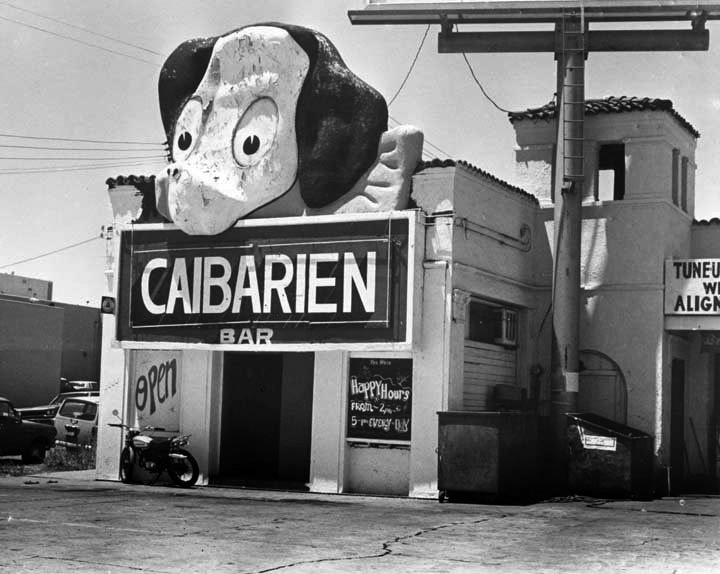 |
|
| (1974)^ – View showing the Barkie’s Sandwich Shop No. 4 building seen here as the Caibarien Bar, with 'Happy Hours from 2 – 5 pm Every Day'. |
* * * * * |
American Legion Building (Hollywood)
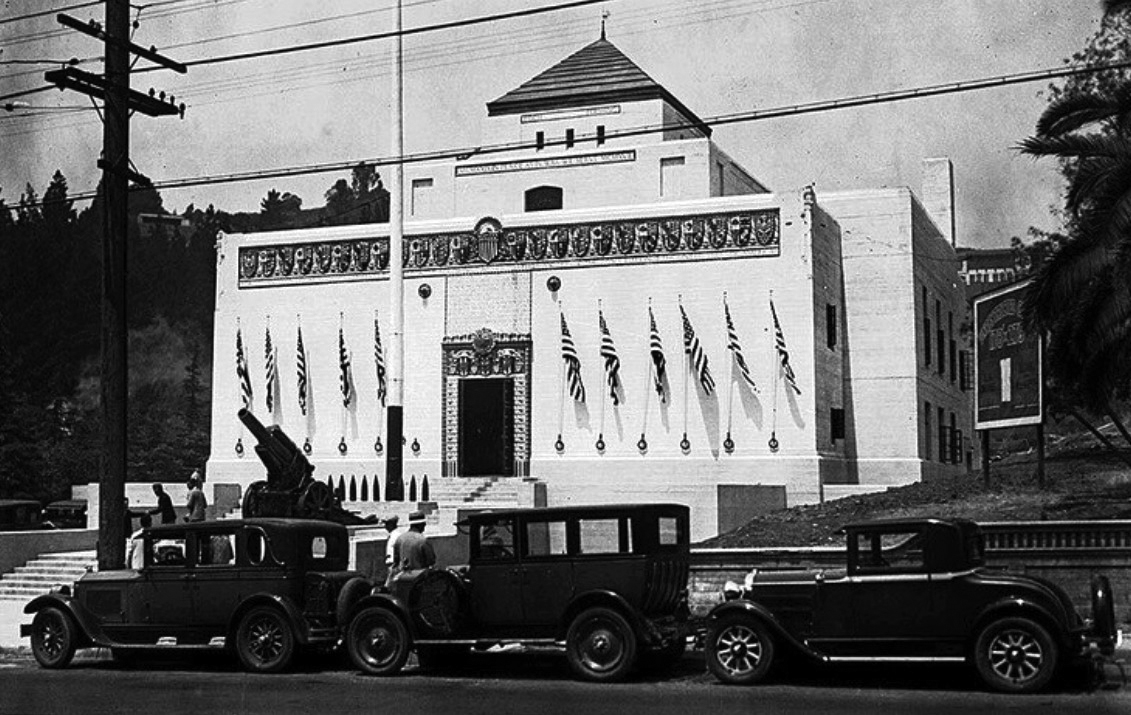 |
|
| (1929)^^* – Front view of the new American Legion Building located at 2035 N. Highland Avenue on the day of its dedication, July 4, 1929. |
Historical Notes Hollywood Post 43 began in an old church building on El Centro Street near Hollywood Boulevard and grew to the largest in the State, having 1,285 registered members. It was organized in 1920.^^* The American Legion is an organization of U.S. war veterans formed in Paris on March 15–17, 1919, by delegates from all units of the American Expeditionary Forces. Their main mission is to sponsor programs that improve veterans communities, such as scholarships, veterans help programs (i.e. ending veterans homelessness), and youth sports. They also promote national security, patriotism, and devotion to veterans.*^ |
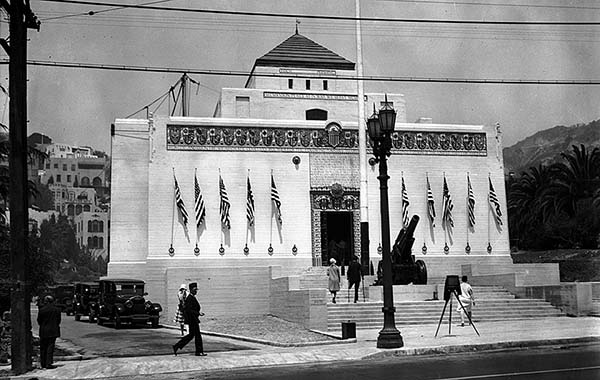 |
|
| (1929)^^* - Visitors enter the new American Legion Post No. 43 building in Hollywood, located on the west side of Highland Avenue, one block south of the Hollywood Bowl. |
Historical Notes The Egytian Revival-Morroccan Deco building was designed by architects Gene and Joe Weston and completed in 1929 at a cost of $270,000. The three-story 33,000 square foot facility has an ornamental entrance of colored terra cotta, set in a solid concrete, with broad steps and terraces in the foreground and graceful tower and pyramid surmounting it. In 1989, the Hollywood American Legion Building was dedicated LA Historic-Cultural Monument No. 462 (Click HERE to see complete listing). |
* * * * * |
B. H. Dyas Building (later Broadway-Hollywood Building)
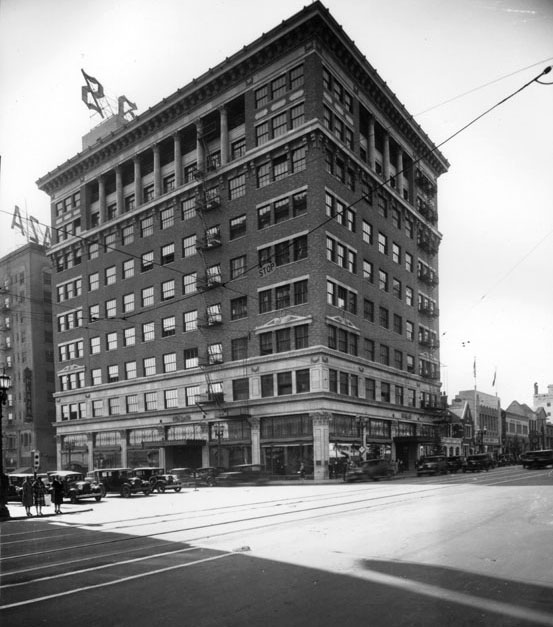 |
|
| (1929)* - View showing the B. H. Dyas Department Store located at 6300 Hollywood Boulevard, on the S/W corner of Hollywood & Vine. Street-railroad tracks run in both directions down Hollywood Blvd. This store later became Broadway-Hollywood, after Broadway purchased B. H. Dyas Co. |
Historical Notes The ten-story B. H. Dyas Building's (later the Broadway-Hollywood Building) construction in 1928 helped to usher in a spatial shift that opened the doors for large-scale retail development outside of downtown Los Angeles. It also was the first department store to introduce women’s slacks.^*## |
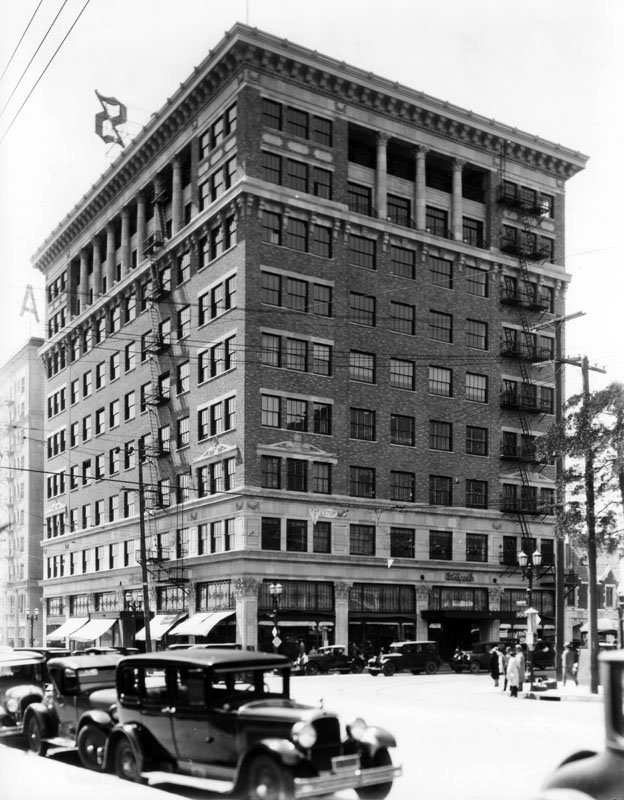 |
|
| (1929)* - View looking southwest at the B. H. Dyas Co. Department Store located on the corner of Hollywood Boulevard and Vine Street. |
Historical Notes Built by local businessman Frank R. Strong and designed in the Classical Revival Style by architect Frederick Rice Dorn, the building initially housed the B. H. Dyas Company Department Store. The move by B. H. Dyas to Hollywood was the first case of a department store developing a branch outside of the downtown core and helped to cement the idea of Hollywood as a retail destination. The store prospered for just a few short years until the Depression did the B. H. Dyas Company in and Broadway jumped in to take it over.^*## |
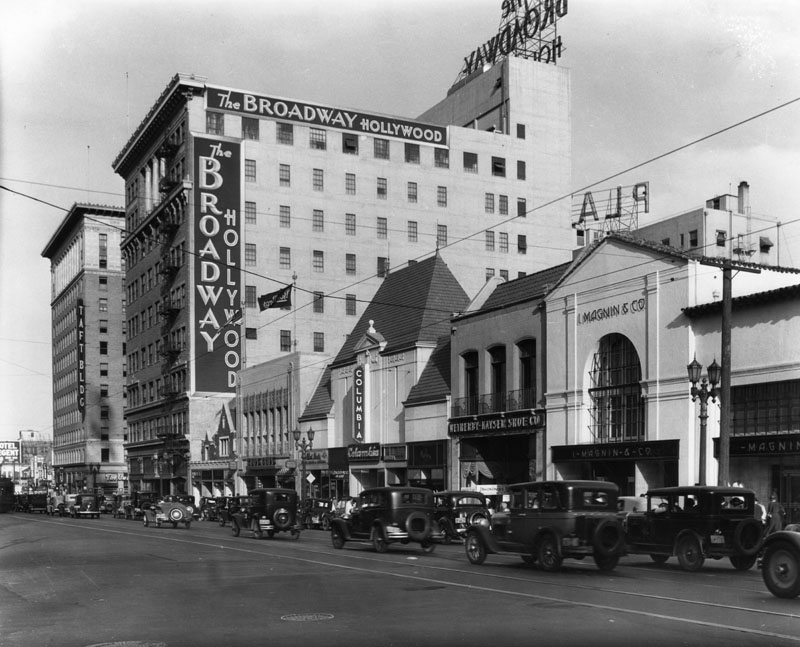 |
|
| (ca. 1932)* - View of the south side of Hollywood Boulevard looking east between Ivar and Vine. The Broadway Hollywood (previously B. H. Dyas) is on the corner of Vine, with the Taft Building across. I, Magnin & Co. is on the right. |
Historical Notes In 1932, the building became the keystone to the Broadway Department Store chain. In 1938, fueled by increased revenues, The Broadway Department Store constructed a seven-story addition to the building’s south side providing 52,000 square feet of additional retail space. |
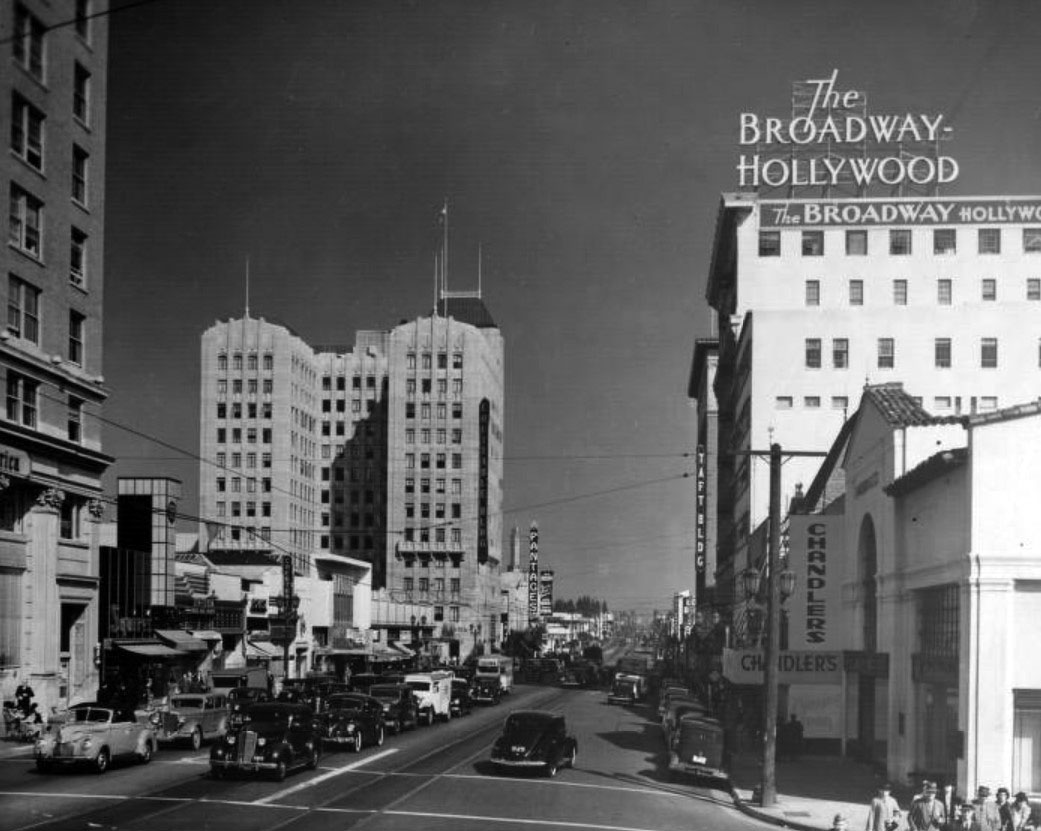 |
|
| (ca. 1939)^^ – View looking east on Hollywood Boulevard showing The Broadway-Hollywood building with its new roof-mounted sign and its new 8-story annex to the west. |
Historical Notes In 1939, an eight-story modern annex designed by Parkinson and Parkinson was built immediately to the west. The Broadway Department Store served as a tenant until the 1970s. In the 1980s, the building was reconfigured for office use. By 1987 the building was abandoned.*^ |
 |
|
| (ca. 1940)* – View looking east on Hollywood Boulevard at Ivar Avenue showing the Broadway-Hollywood with new addition. Click HERE to see contemporary view. |
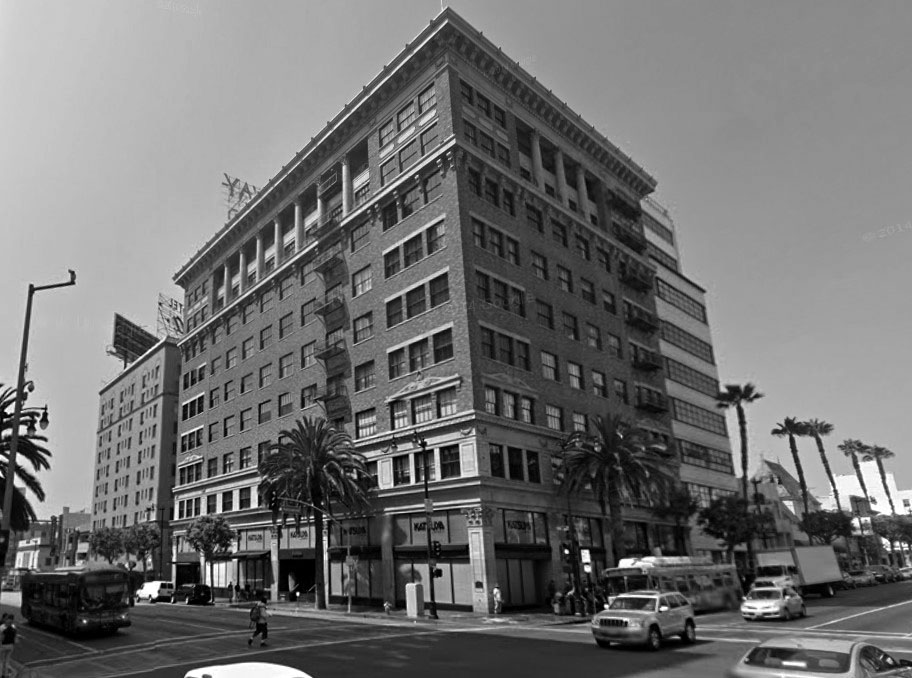 |
|
| (2014)^ – Google street view showing the Broadway-Hollywood Building located on the southwest corner of Hollywood and Vine. |
Historical Notes More recently, the building has been converted to condominiums on the top eight floors and is now called The Broadway-Hollywood. Atop the main building is the large, metal-formed, neon sign reading: “The Broadway Hollywood". ^*## |
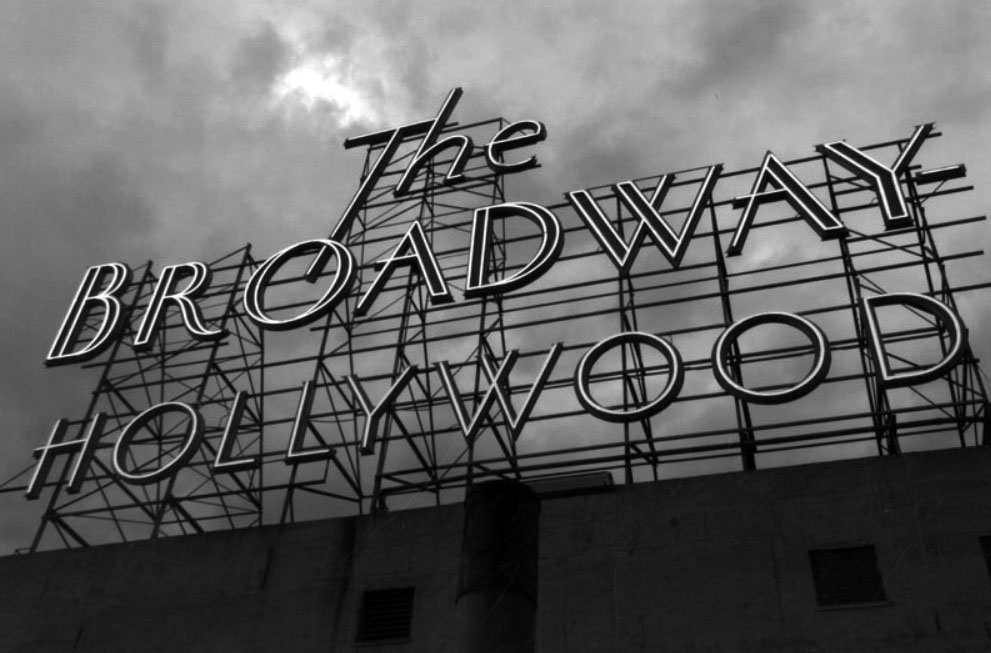 |
|
| (2005)* - Rooftop of the Broadway-Hollywood on Vine Street in Hollywood. The neon sign that reads "The Broadway - Hollywood" is lit and looks crisp against the gray sky. Architects were Walker and Eisen. |
Historical Notes In 1999, the Broadway Department Store and Neon Sign were designated Los Angeles Historic-Cultural Monument No. 664 (Click HERE to see complete listing). |
* * * * * |
Vine Street Theatre (Ricardo Montalbán Theater)
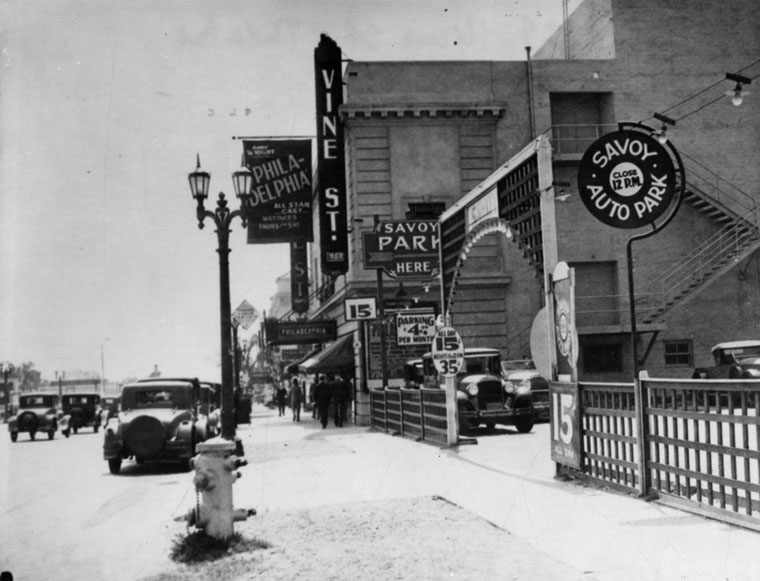 |
|
| (1929)* - View looking south on Vine Street showing the Vine Street Theatre (today the Ricardo Montalbán Theater) located at 1615 North Vine Street. Banner hanging from the front of the theatre reads. "Andy Wright presents, Philadelphia, all star cast. Matinees, Thurs. and Sat." Note the Savoy Auto Park adjacent to the theatre. Parking rates are 15 cents a day or $4.00 a month. |
Historical Notes Named the Wilkes Brothers Vine Street Theatre in honor of its builders, the Beaux Arts live-performance theater was built in 1926-1927. It was the first legitimate Broadway-style theatre in Hollywood. The theatre was designed by architect Myron Hunt, also known for other notable buildings including the Rose Bowl, Cal Tech, and the Ambassador Hotel. The premier performance was “An American Tragedy” by Theodore Dreiser. The theater also had a memorable run of the play “Philadelphia” during its early years. The theater features orchestra, mezzanine, loge and balcony seating. |
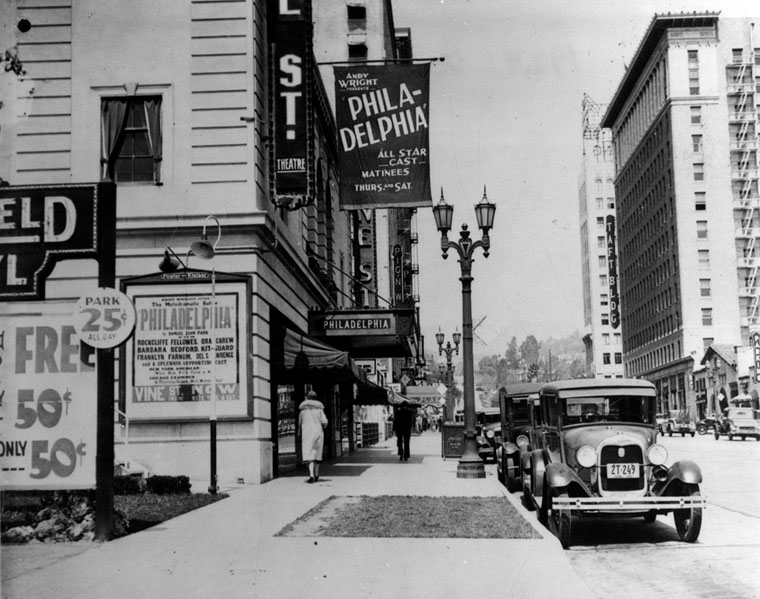 |
|
| (1929)* - View looking north on Vine Street showing the Vine Street Theatre. The Taft Building is seen on the right, located at the southeast corner of Hollywood and Vine. Banner reads, "Andy Wright presents, Philadelphia, all star cast, Matinees Thurs. and Sat." |
Historical Notes During the depression of the 1930’s, the theater was renamed Mirror and became a cinema. It later became the Lux Theatre when it was purchased by the Columbia Broadcasting (CBS) for local affiliate KNX radio and was used as a live performance radio auditorium and local radio station.^^# |
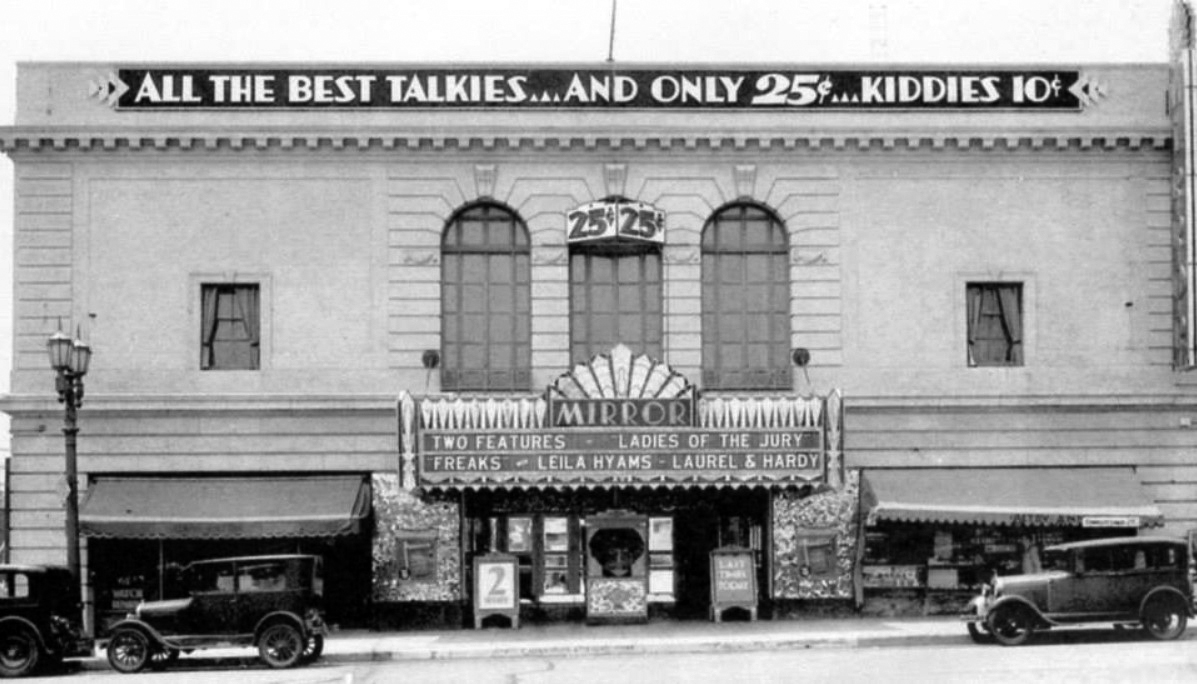 |
|
| (1932)##** – Panoramic view showing the Mirror Theatre (previously Vine Street Theatre). Now showing: “Ladies of the Jury”, “Freaks” with Leila Hyams, and a Laurel & Hardy short. Large sign on top face of building reads: "ALL THE BEST TALKIES...AND ONLY 25 CENTS.....KIDDIES 10 CENTS" |
Historical Notes When the Vine Street Theater opened at 1615 Vine St, just south of the Hollywood and Vine corner, it was a legitimate live theater. In March, 1931 it became a cinema called the Mirror, under the direction of Howard Hughes' Hughes-Franklin circuit. ##** In 1936 the theatre became the CBS Lux Radio Playhouse where the long-running “Lux Radio Theater” hosted by Cecil B. DeMille was made.*^ |
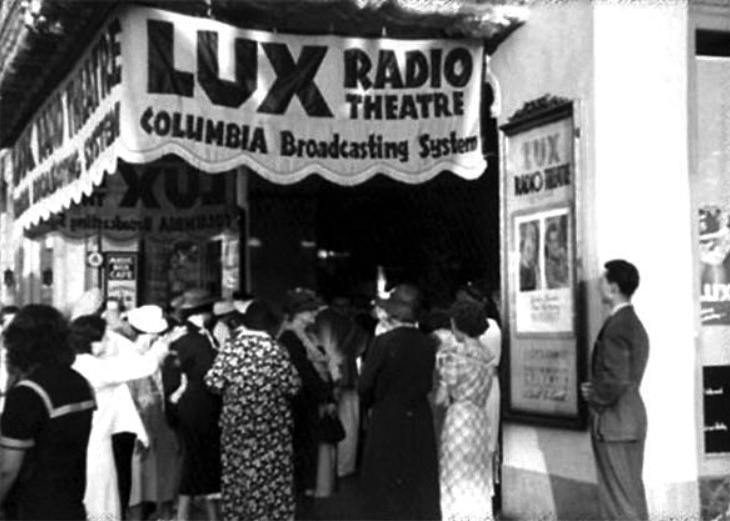 |
|
| (ca. 1930s)*^ - A studio audience gathers prior to a live production at Hollywood's Lux Radio Playhouse (previously the Vine St. Theatre and Mirror Cinema). |
Historical Notes Lux Radio Theatre was a long-run classic radio anthology series that was broadcast on the NBC Blue Network (1934-35); CBS Radio (1935-54), and NBC Radio (1954-55). Initially the series adapted Broadway plays during its first two seasons in New York before it began adapting films after moving to its Hollywood Vine Street location (1936). These hour-long radio programs were performed live before studio audiences. The series became the most popular dramatic anthology series on radio, broadcast for more than 20 years and continued on television as the Lux Video Theatre through most of the 1950s.*^ |
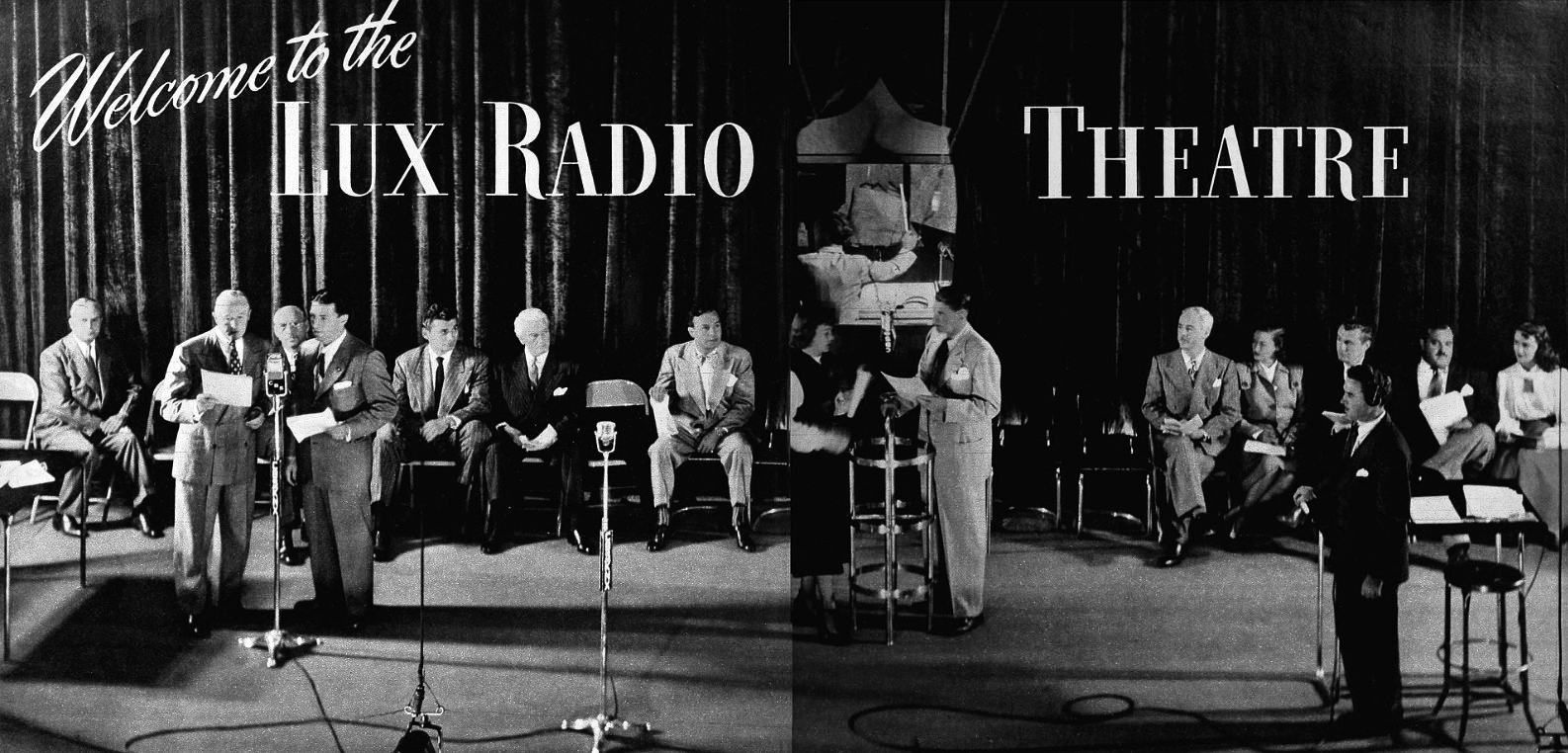 |
|
| (1948)*^ - Composite wide-angle view showing performance of Lux Radio Theatre before a studio audience. The actor standing at center-right is future U.S. President Ronald Reagan. |
Historical Notes Lux Radio Theatre strove to feature as many of the original stars of the original stage and film productions as possible, usually paying them $5,000 an appearance. In 1936, when sponsor Lever Brothers (who made Lux soap and detergent) moved the show from New York City to Hollywood, the program began to emphasize adaptations of films rather than plays. The first Lux film adaptation was The Legionnaire and the Lady, with Marlene Dietrich and Clark Gable, based on the film Morocco. That was followed by a Lux adaptation of The Thin Man, featuring the movie's stars, Myrna Loy and William Powell.*^ |
 |
|
| (1954)* - Opening night--celebrities and first nighters are shown arriving at the new million dollar theater, the Huntington Hartford Theater, for its premiere performance. Movie fans standing in bleachers cheer as screen stars enter the lobby of the theater. Photo dated: October 2, 1954. |
Historical Notes In 1954, George Huntington Hartford bought the building for $200,000 from Columbia Broadcasting and extensively remodeled and “modernized” the theater at an additional cost of $750,000. He streamlined the building from the facade, to the lobby and through the auditorium. Hartford ran the theater successfully for ten years.^^# |
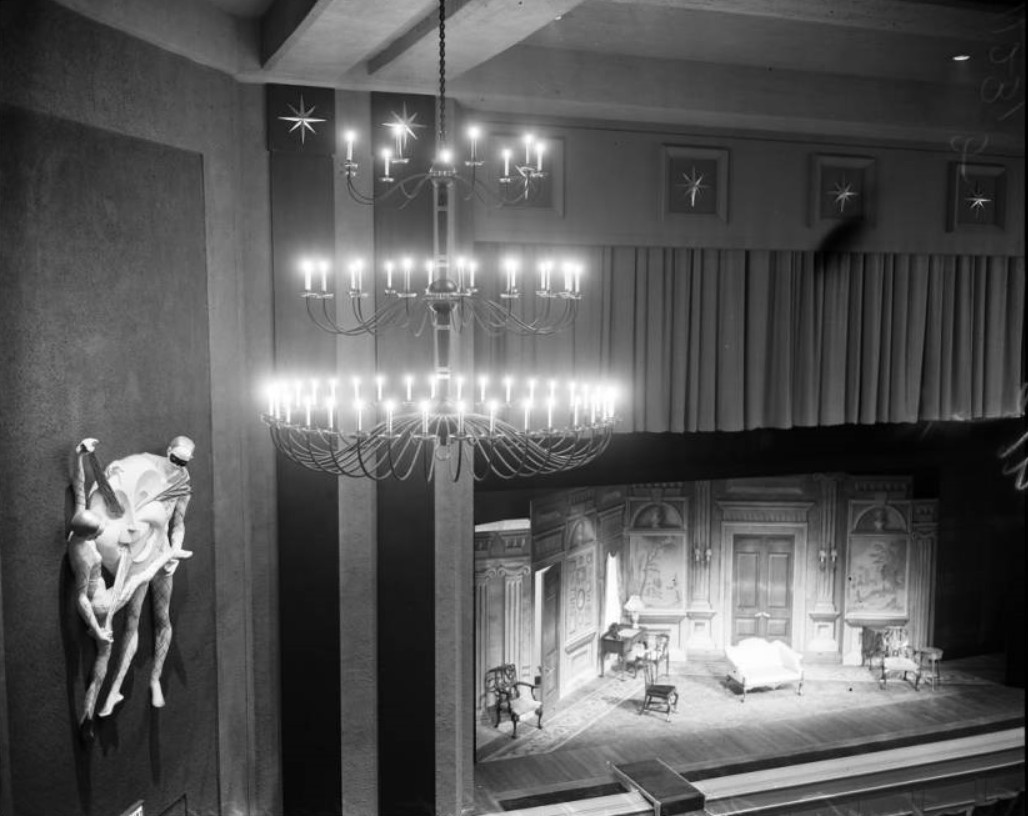 |
|
| (1954)^^ – Interior view of the Huntington Hartford Theater during the opening of "What Every Woman Knows" with Helen Hayes. |
Historical Notes In 1964 Hartford sold the theater to James Doolittle (owner of the Greek Theater in the Hollywood Hills) for $850,000. Cary Grant had tried to buy the building, but lost over Doolittle. The theater was (not surprisingly) renamed the Doolittle Theater. Eventually, the theater would run down into disrepair. Until bought in 2000 by the U.C.L.A. performing arts group “Nosotros”, an organization founded in 1970 by actor Ricardo Montalban “to help fulfill the goals of persons of Spanish-speaking origin in the motion picture and television industry”. The founding board included members Desi Arnaz, Vicki Carr and Anthony Quinn. In May 2004 the theatre reopened as The Montalbán. ^^# |
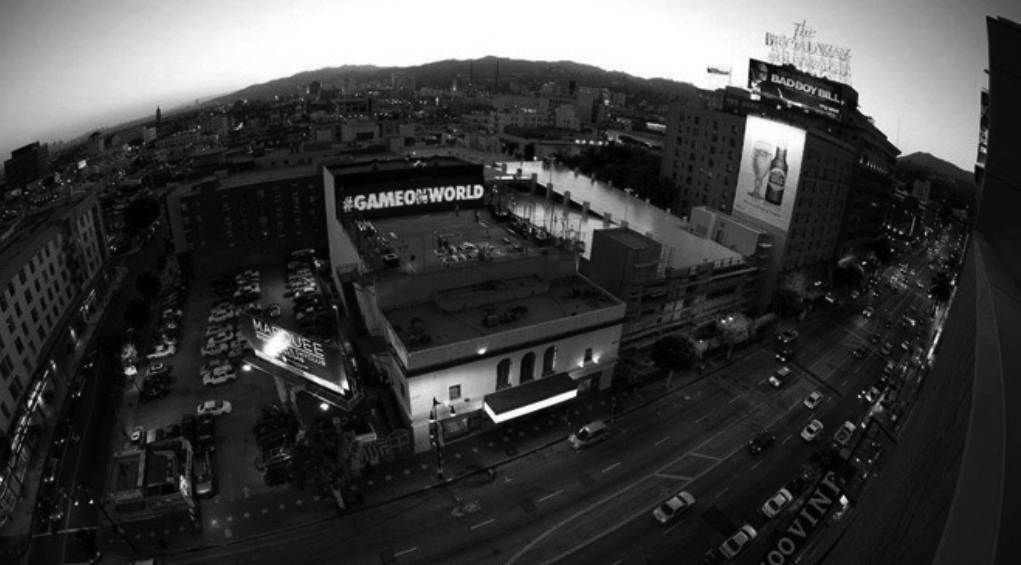 |
|
| (2010s)*- Bird's-eye view of the Montalbán Theatre located at 1615 N. Vine Street. The Broadway-Hollywood can be seen on the southwest corner of Hollywood and Vine. Photo courtesy of the Ricardo Montalbán Theatre |
Historical Notes In 2005, Nike entered into a partnership with the Montalbán Theatre and the theatre has since been used for special venues such as promotional events. |
* * * * * |
Sinai Temple (today the Korean Philadelphia Presbyterian Church)
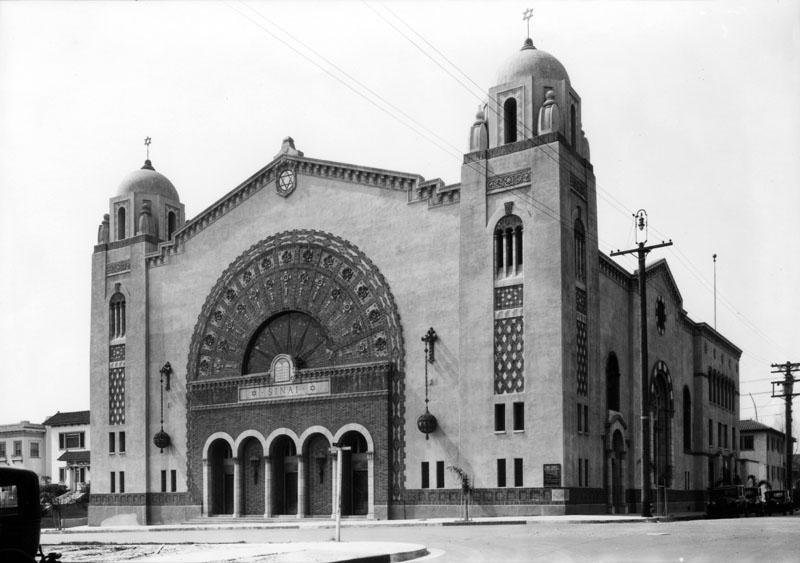 |
|
| (1930)* - Exterior view of the second location of Sinai Temple, located at 401 S. New Hampshire Street, on the corner of New Hampshire and 4th streets. |
Historical Notes The temple was built in 1924 and was designed by S. Tilden Norton in a combination of styles – Romanesque, Moorish, and Renaissance.**^^ |
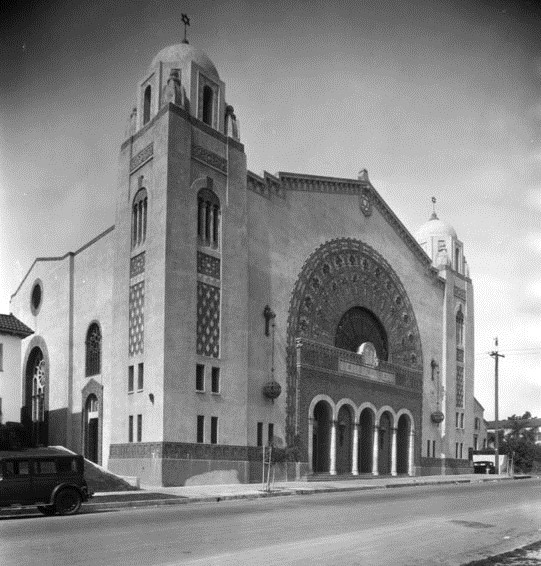 |
|
| (1930)* - Exterior view of Sinai Temple on New Hampshire Street, the first conservative congregation in Southern California. |
Historical Notes Sinai Temple was the first conservative congregation in Southern California, established in 1906. For nearly 20 years, the temple was located at 12th and Valencia Streets. A second facility, the 1,400-seat structure shown here, was designed by S. Tilden Norton and the first services were held in 1925. The synagogue served the community until 1960, at which time a new temple opened in Westwood.* |
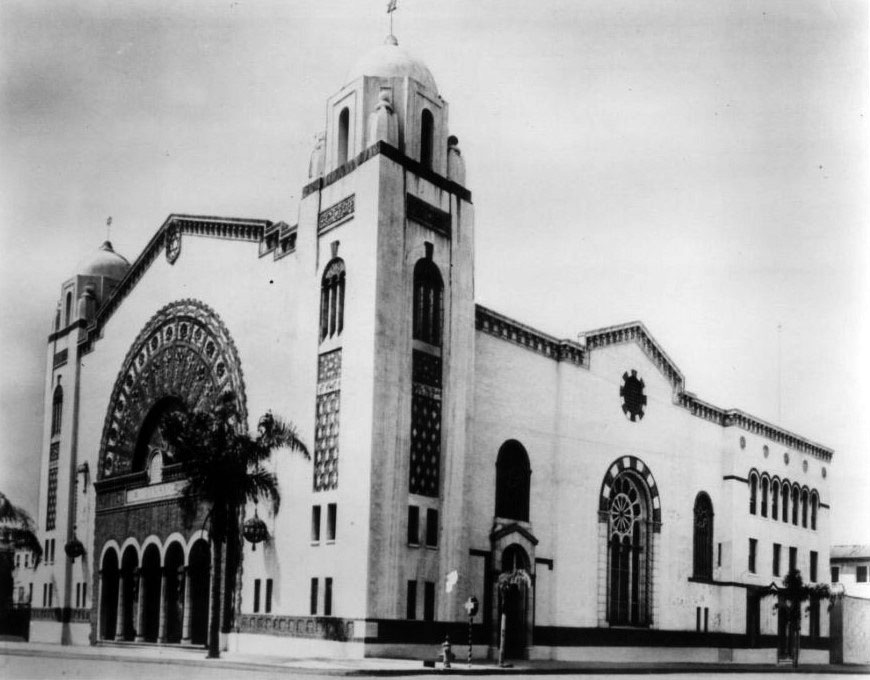 |
|
| (1947)^*# - View of Sinai Temple, located on the southwest corner of 4th Street and New Hampshire Avenue. Note the addition of a palm tree. |
Historical Notes This building, which later became the Korean Philadelphia Presbyterian Church, was declared Los Angeles Historic-Cultural Monument No. 91 on November 17, 1971 (Click HERE to see complete listing). |
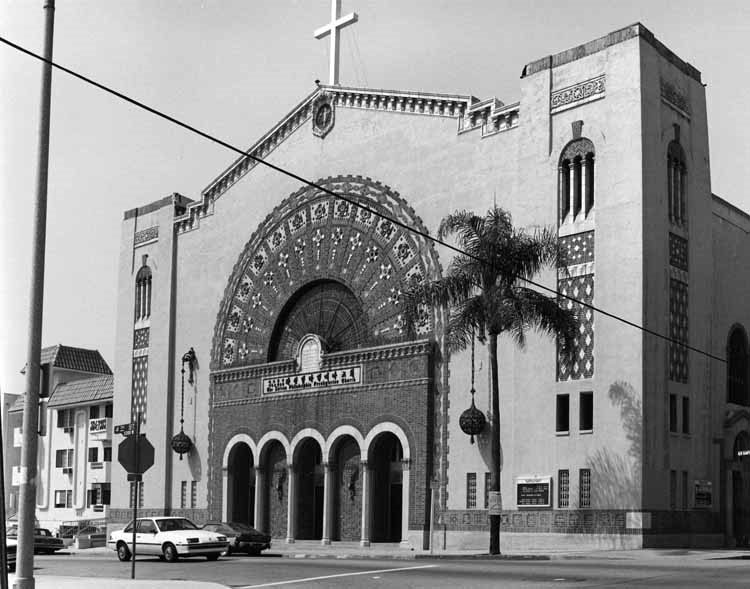 |
|
| (1988)^*# - View of the Korean Philadelphia Presbyterian Church (previously Sinai Temple), located at 407 South New Hampshire Avenue. |
Historical Notes Over the years, the building appears to have lost parts of its roof towers. |
* * * * * |
The Doria Apartments
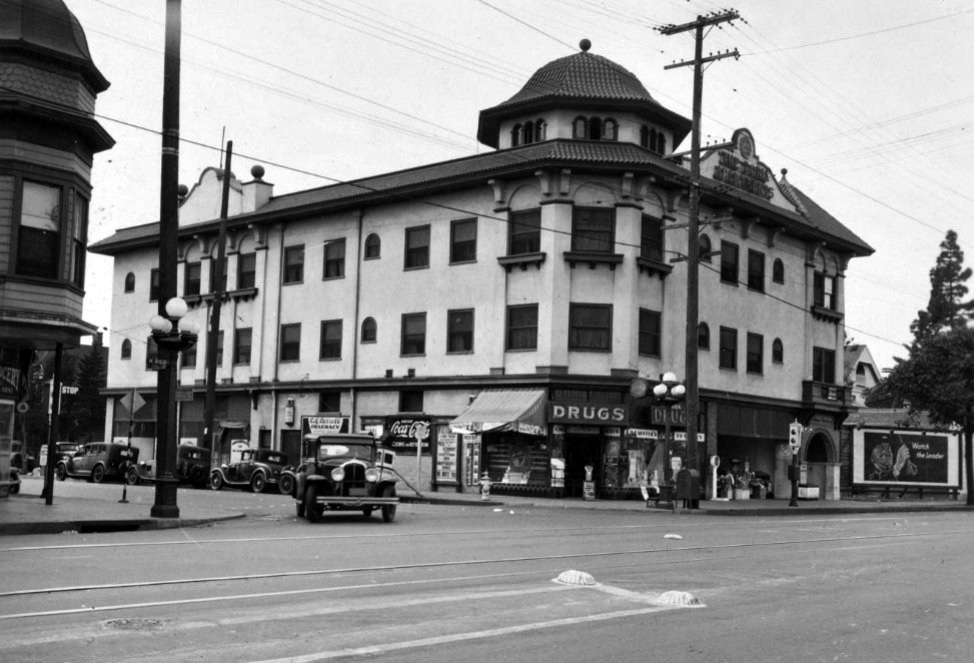 |
|
| (1932)* – View showing the Doria Apartments located on the SW corner of Pico Boulevard and Union Avenue. |
Historical Notes The Mission Revival style apartment building was designed by Gotfred Hanson for Doria Deighton Jones in 1905. Very few people in Los Angeles today know the name Doria Deighton Jones. However, she was an important figure when the city was in its infancy. Born in Scotland in 1824, she moved to San Francisco and then to Los Angeles. While in San Francisco, she married a Polish-born Jewish grocer, John J. Jones. After moving to Los Angeles, the Jones family lived in an adobe home facing what today is the plaza at the top of Olvera Street, and what at the time was a central part of the young city. The home’s prior occupant was Gov. John G. Downey. The old adobe home faced south onto the plaza and stood directly across from the home of Judge Agustin Olvera. It was diagonally opposite the Francisco Avila adobe, which still stands today and is the oldest building in the city. In an effort to straighten out the jagged street pattern in the neighborhood, two streets running north from the plaza were combined into one; the result was that the old Downey/Jones adobe house was demolished. A new building, which still stands, was constructed in 1894. It is known as the Simpson-Jones building, as the Jones’ youngest child, Constance Doria Deighton Jones Simpson, was born on the site. Today, La Luz del Dia restaurant occupies part of the structure. There were two older Jones children. One was Mark G. Jones, the head of Merchants Bank and Trust Company and the first president of Inglewood Park Cemetery. The beautiful cemetery has an elegant, classical outdoor shrine to Mark Jones on top of the hill near the chapel. The other child was Caroline Adelaide Jones, who married and became Mrs. James B. Lankershim. She spent most of her adult life in Paris, returning to Los Angeles to live during World War I, but moving back to France at the conclusion of the war. There was a commercial structure titled the Jones Block, in which the family had its offices. This building was at 175 N. Spring St., which today is where City Hall stands. In the past, Spring Street turned north of First Street and ran diagonally to meet Main Street, much as it does south of Eighth Street, where it runs at an angle to Main at Ninth Street. The office building is long gone, probably demolished when Spring was straightened to run parallel to Main north of First. This allowed the assembly of the property on which City Hall was constructed in the 1920s. When her husband died in 1876, Doria Jones continued to live in the adobe house on the plaza, later moving to South Hill Street between Ninth and Tenth streets. This home was in the upscale residential neighborhood south of Seventh Street, about a block from the home of her daughter and son-in-law, the aforementioned Lankershims. Then as now, South Park was an upscale neighborhood, though the single-family homes of Jones’ era have today been replaced by apartments and condominiums in luxurious high-rises. The Joneses also acquired a 53-acre property in the Westlake area, just west of Figueroa Street. It was an irregularly shaped parcel bounded by Pico Boulevard, Alvarado Street, Rouland Street (today’s Venice Boulevard) and a diagonal line connecting Rouland to Pico. Doria Jones developed the property in the early 1900s, turning it into a series of housing tracts. The jewel in the development was the Alvarado Terrace Tract at Pico Boulevard and Alvarado Street. The area contains many fine homes that are great treasures today; some have been designated as historical monuments. There is a Mission Revival-style apartment building at Pico Boulevard and Union Avenue with the words “The Doria Apartments” appearing in a block format above the roofline in a parapet. The building was named for and built by Doria Deighton Jones in 1903. It was declared a City Historical Cultural Monument on May 5, 1989. Doria Deighton Jones lived a long life. She died in 1908 in Los Angeles and was buried in the Jones hilltop section at Inglewood Park Cemetery. – Greg Fischer* Click HERE to see more Early Views of the Pico-Union Neighborhood. |
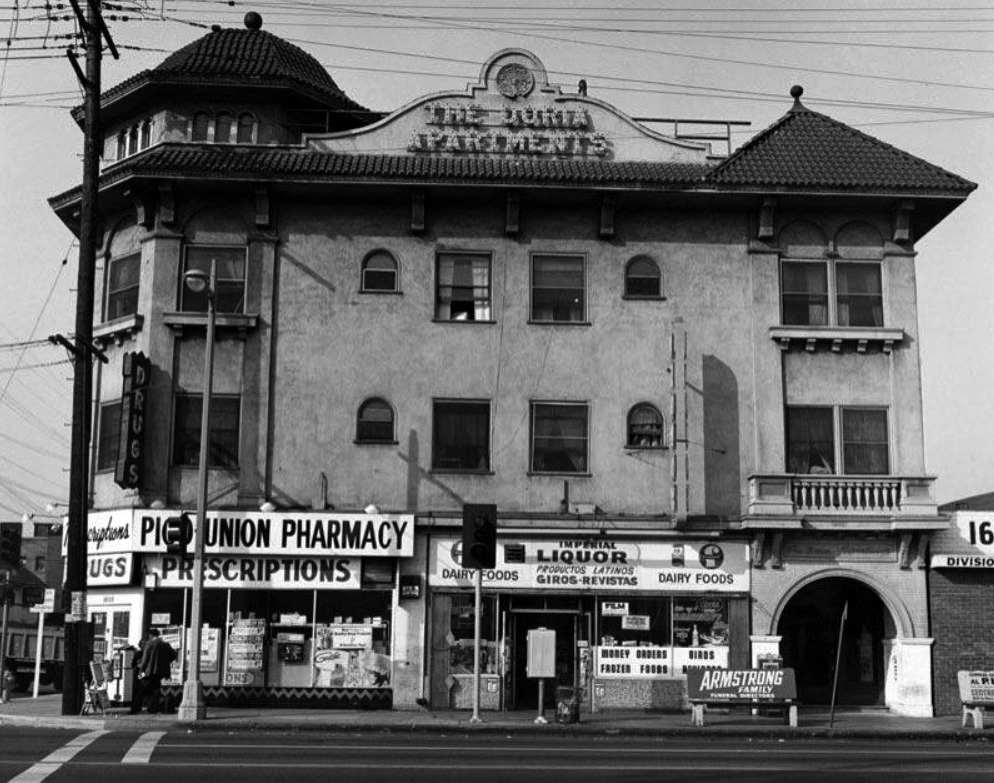 |
|
| (1970)^.^ – View of The Doria Apartments, with lower floor shops, at Pico Boulevard and Union Avenue. Pico-Union Pharmacy and Imperial Liquor are seen. |
Historical Notes This three-story, stucco-faced apartment block had storefronts on its first floor, residential units on the upper two. A red tile roof extended out over the eaves, supported by thick brackets. A large tower, octagonal in shape, stood raised one floor about the street corner. In 1970, this corner storefront was occupied by the Pico Union Pharmacy. (In 2007, this space was occupied by the Pico Free Clinic. Next door, was the Liquor Market.) A Mission Style scalloped gable rose above the eaves line and had a sign in its center spelling "The Doria Apartments," the letters illuminated by early light bulbs.^ |
 |
|
| (2007)^ – View showing the Doria Apartments located at 1600 West Pico Boulevard in the historic Pico Union District of Los Angeles. |
Historical Notes The Doria Apartments building was declared Los Angeles Historic-Cultural Monument No. 432 in 1989. Click HERE to see a more contemporary view. |
Then and Now
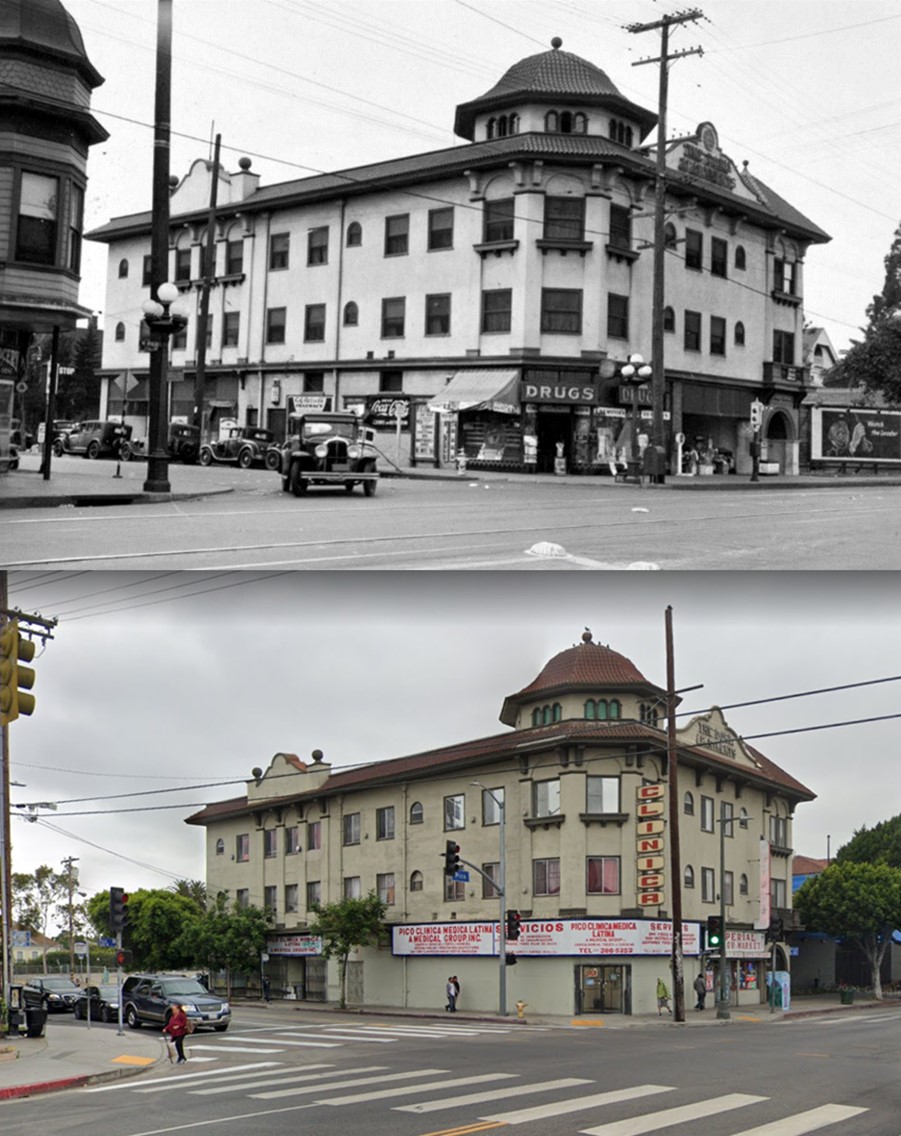 |
|
| (1932 vs. 2019)* – Doria Apartments, SW corner of Pico and Union. |
* * * * * |
Chateau Elysée
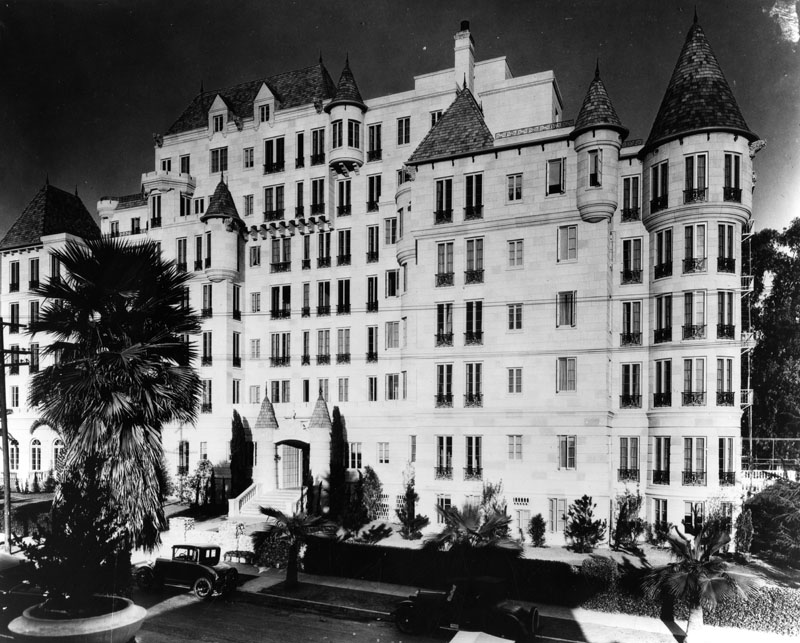 |
|
| (1929)* - Exterior view of the French style Chateau Elysée, located at 5930 Franklin Avenue in Hollywood. |
Historical Notes The Chateau Elysée was built as a luxury hotel/apartment house in 1929 by Eleanor Ince, the widow of Thomas H. Ince, the successful pioneer silent film producer. Designed by eminent architect Arthur E. Harvey as a prominent seven story replica of a 17th Century French-Normandy castle, the Chateau Elysée remains as the most impressive of several Hollywood chateaux built during the area's booming 1920s.*^ |
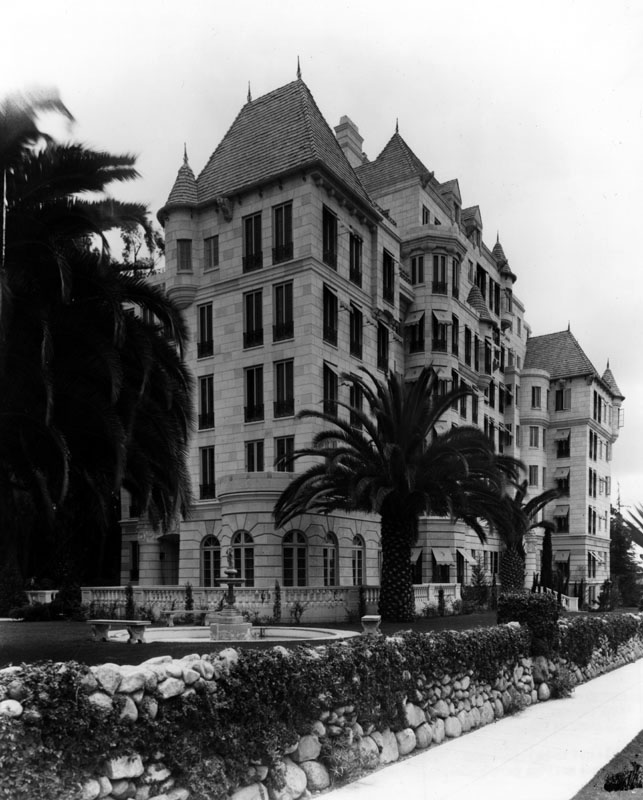 |
|
| (1929)* - Street view looking up toward the Chateau Elysée in Hollywood. |
Historical Notes The Chateau Elysée Hotel provided a home for many of the artists that were then being drawn to Hollywood. Residents included some of the most famous names of the 1930s and 40s. Most notably Bette Davis, Errol Flynn (room 211), Edward G. Robinson (room 216), Carol Lombard (room 305), Edgar Rice Burroughs (room 408), Humphrey Bogart (room 603), Clark Gable (room 604), Ginger Rogers (room 705), Ed Sullivan (room 501), Gracie Allen and George Burns (room 609) along with Lillian Gish, Katharine Hepburn, George Gershwin, and Cary Grant.*^ |
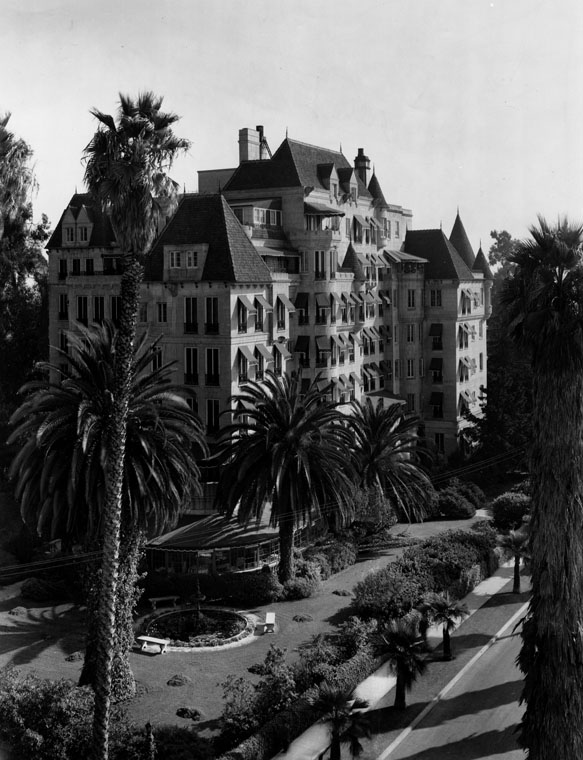 |
|
| (1951)* - Exterior view of the Chateau Elysée as it appeared in 1951. |
Historical Notes In 1969 the building began being used as the Church of Scientology's home for its Celebrity Centre; since 1973 the building has been owned by the Church. Several floors are now hotel rooms (for church members only), with the building's topmost stories serving as offices. Free guided tours of the historic building are available to the general public. The Château's conservatory building houses the acclaimed French rococo-styled restaurant, Renaissance.*^ On September 23, 1987, the City of Los Angeles declared the building as Historic-Cultural Monument No. 329 (Click HERE to see complete listing). |
* * * * * |
Villa Carlotta
 |
|
| (1926)^*# – View showing the Villa Carlotta Apartment Building located on the northwest corner of Franklin and Tamarind avenues. |
Historical Notes The developer Luther T. Mayo built the 50-unit Spanish Colonial-style apartment house in 1926 from a design by architect Arthur E. Harvey, with rumored financing from William Randolph Hearst. Upon completion, it belonged to Eleanor Ince, widow of silent-film magnate Thomas Ince. According to legend, Hearst gave her the building as a gift after accidentally killing her husband on his yacht in 1924. The bullet, so the story goes, was intended for Charlie Chaplin, whom Hearst suspected was having an affair with his mistress, Marion Davies (Rosebud herself). Supposedly, Ince’s wife received the luxury residence hotel for her grief.** |
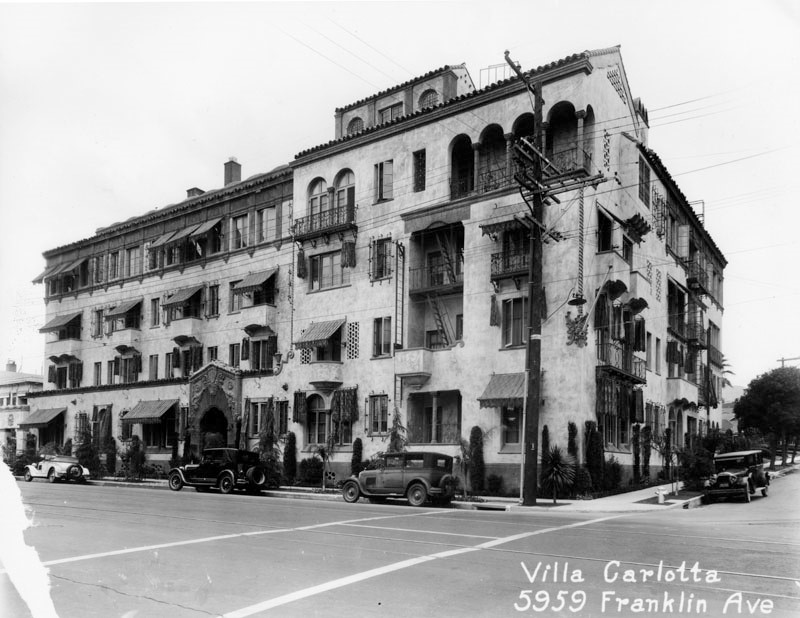 |
|
| (1929)* - Street view of the 4-story Spanish style Villa Carlotta apartment building, located at 5959 Franklin Ave. Pacific Electric streetcar tracks are visible on Franklin Avenue outside the building. |
Historical Notes Edward G. Robinson, George Cukor, and Marion Davies were among its early celebrity tenants. Louella Parsons, the most famous gossip writer of the era, penned her column from a two-story apartment on the courtyard. A personal favorite of Hearst’s, Parsons was on the yacht the night of Thomas’s alleged shooting, and is said to have received The Carlotta’s finest apartment for her silence.** |
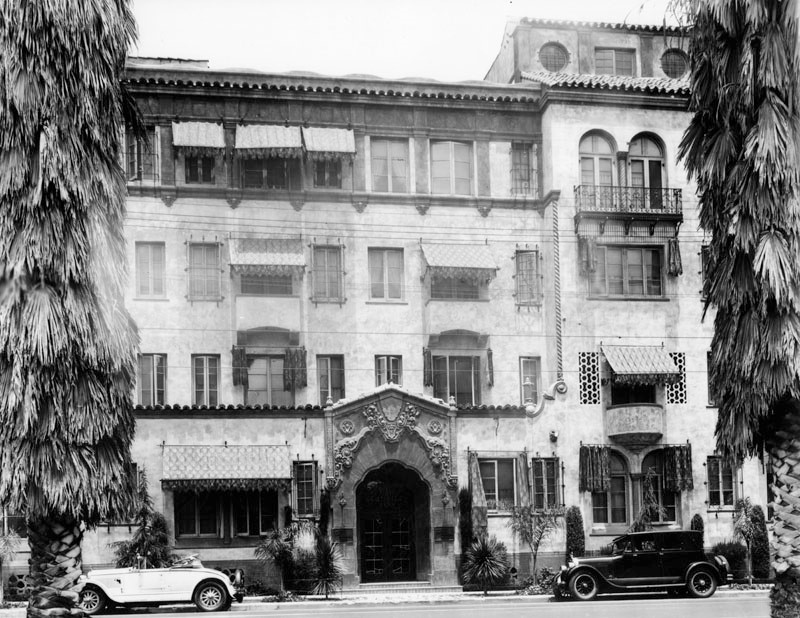 |
|
| (1929)* - Front view showing the main entrance of the 4-story Spanish style Villa Carlotta apartment building as seen from acroos the street. |
Historical Notes The four-story building was designed by Arthur E. Harvey, who also designed the nearby Chateau Elysée located across the street. |
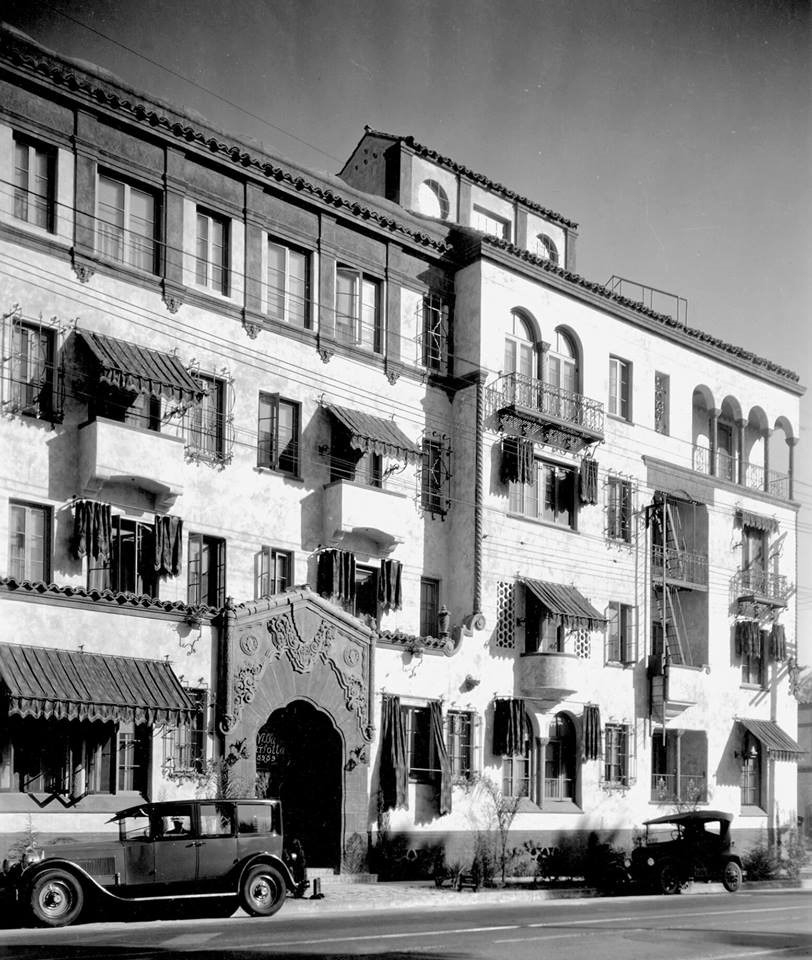 |
|
| (ca. 1929)* – Closer view of the Villa Carlotta apartment building at 5959 Franklin Avenue in Hollywood. |
Historical Notes The building is a Churrigueresque wonder of late Spanish baroque and filled with detailing they just don’t do anymore. |
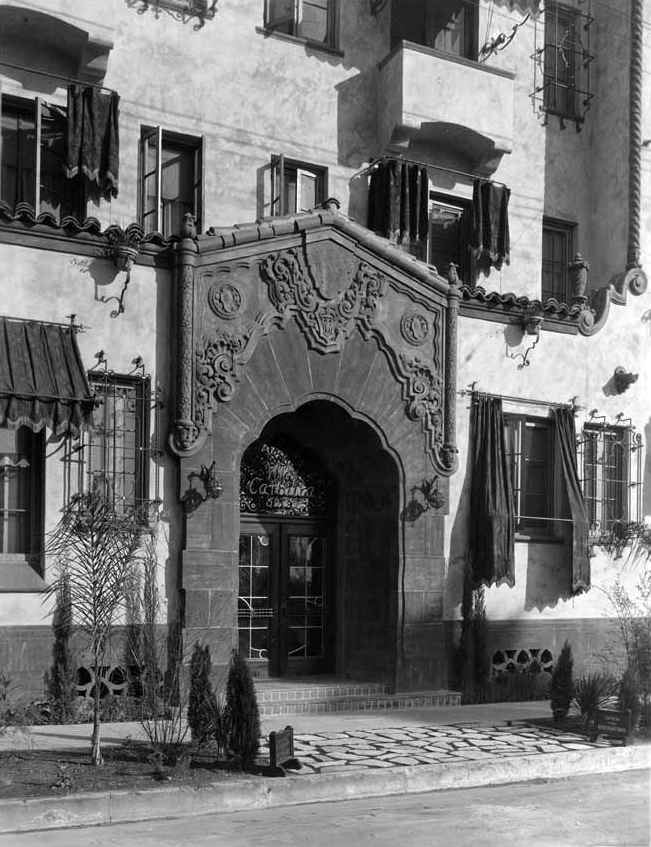 |
|
| (ca. 1928)^*# – Close-up view showing the entrance to the Villa Carlotta apartment building. Note the Baroque Churrigueresque design. |
 |
|
| (2015)** – Night view of the illuminated front entrance to the Villa Carlotta, 5959 Franklin Ave. Photo by Stinson Carter, Vanity Fair. |
 |
|
| (2015)*^ - The Villa Carlotta apartments, Los Angeles Historic-Cultural Monument 315, viewed from the southeast. |
Historical Notes The Lesser family trust owned the building from the 1950s to 2014, when it was bought by investment firm CGI Strategies. The new owner is restoring and renovating the historic building with a focus on preserving its architectural heritage, including keeping and refreshing the features and fixtures that made it a special place for so many residents and visitors.*^ |
* * * * * |
La Leyenda Apartments
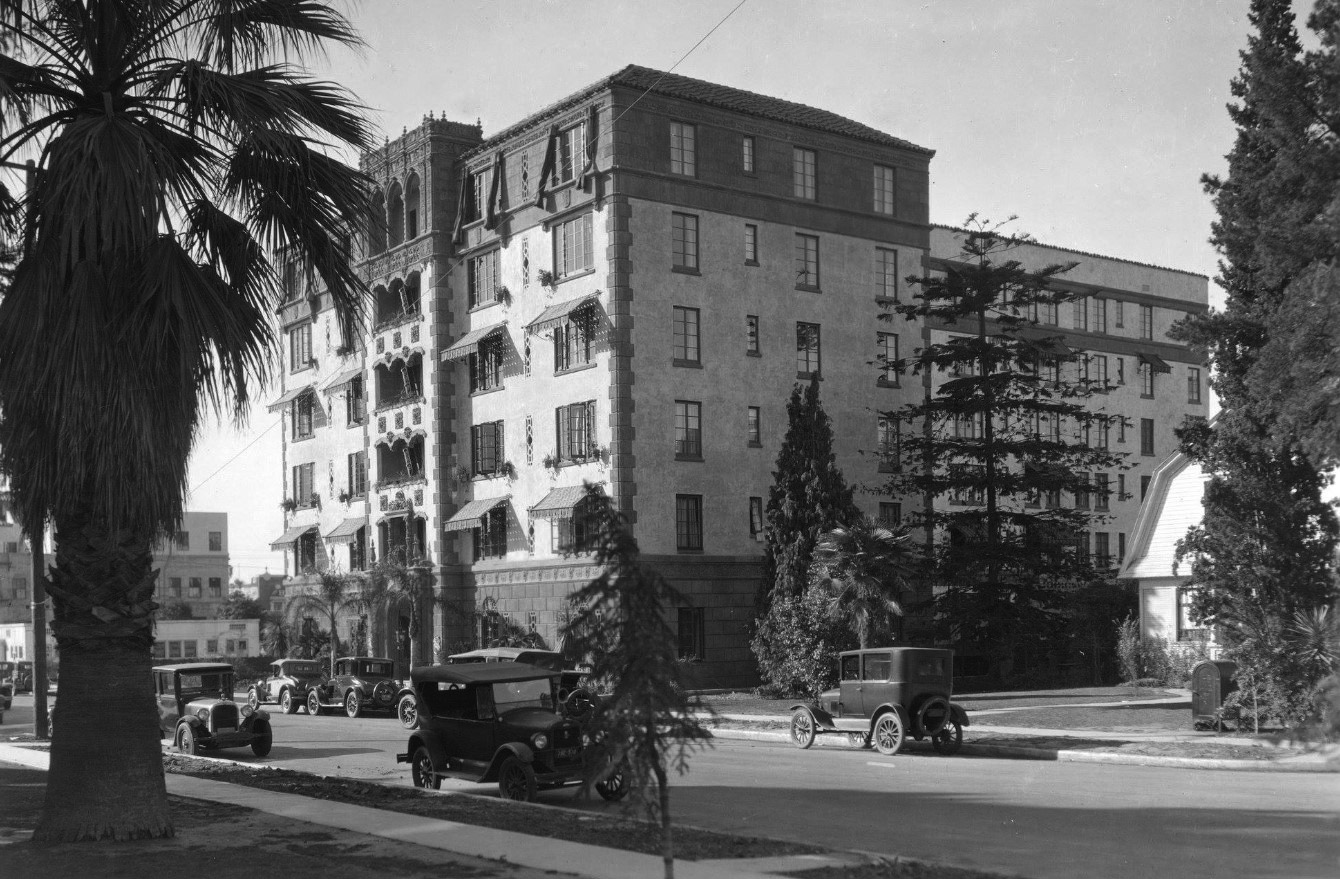 |
|
| (ca. 1929)^*# – View looking southwest showing the La Leyenda Apartments located at 1737 Whitley Avenue in Hollywood. |
Historical Notes Built in 1927, the 6-story La Leyenda Apartment Building is located in the residential neighborhood of Whitley Heights in the Hollywood Hills. |
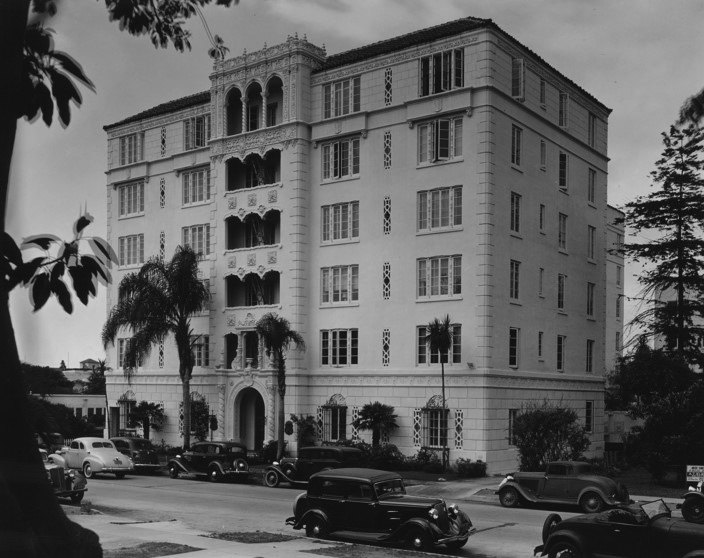 |
|
| (1930s)^*# - View showing the 6-story La Leyenda Apartments with cars parked in front. The building is ornamented with decorative work. |
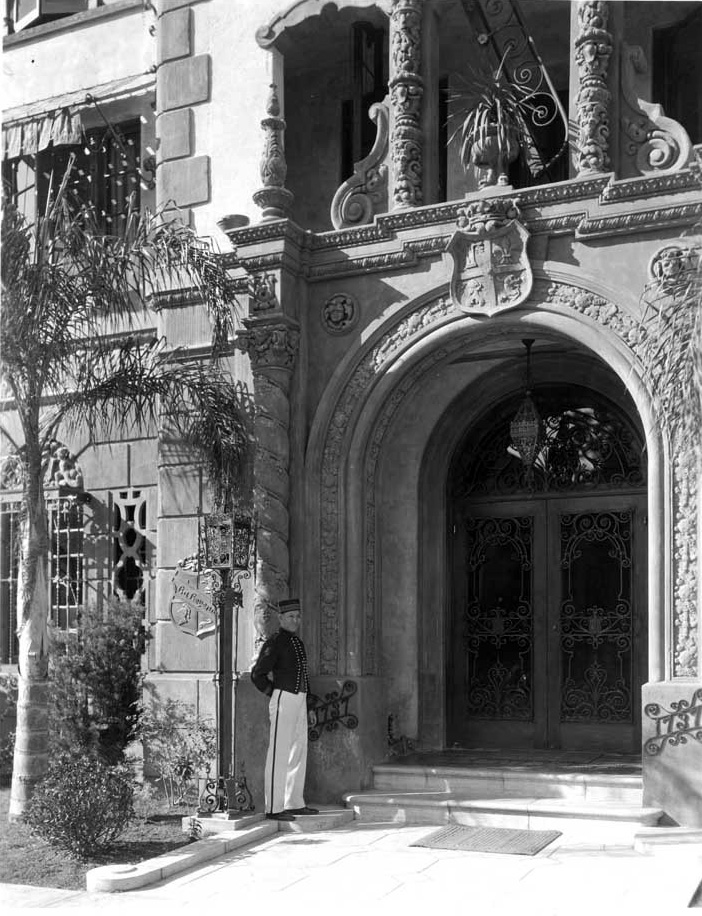 |
|
| (ca. 1929)^*# – Doorman stands by the front entryway to the La Leyenda Apartments. Note the ornate Churrigueresque stone design. |
Historical Notes The La Leyenda Apartment Building exhibits character-defining features of Spanish Colonial Revival architecture including stucco surfaces which predominate over the openings; low-pitched tile roof; limited number of openings; formal garden; use of decorative ironwork; ceramic tile walls and floors; and Churrigueresque cast stone detailing.^ |
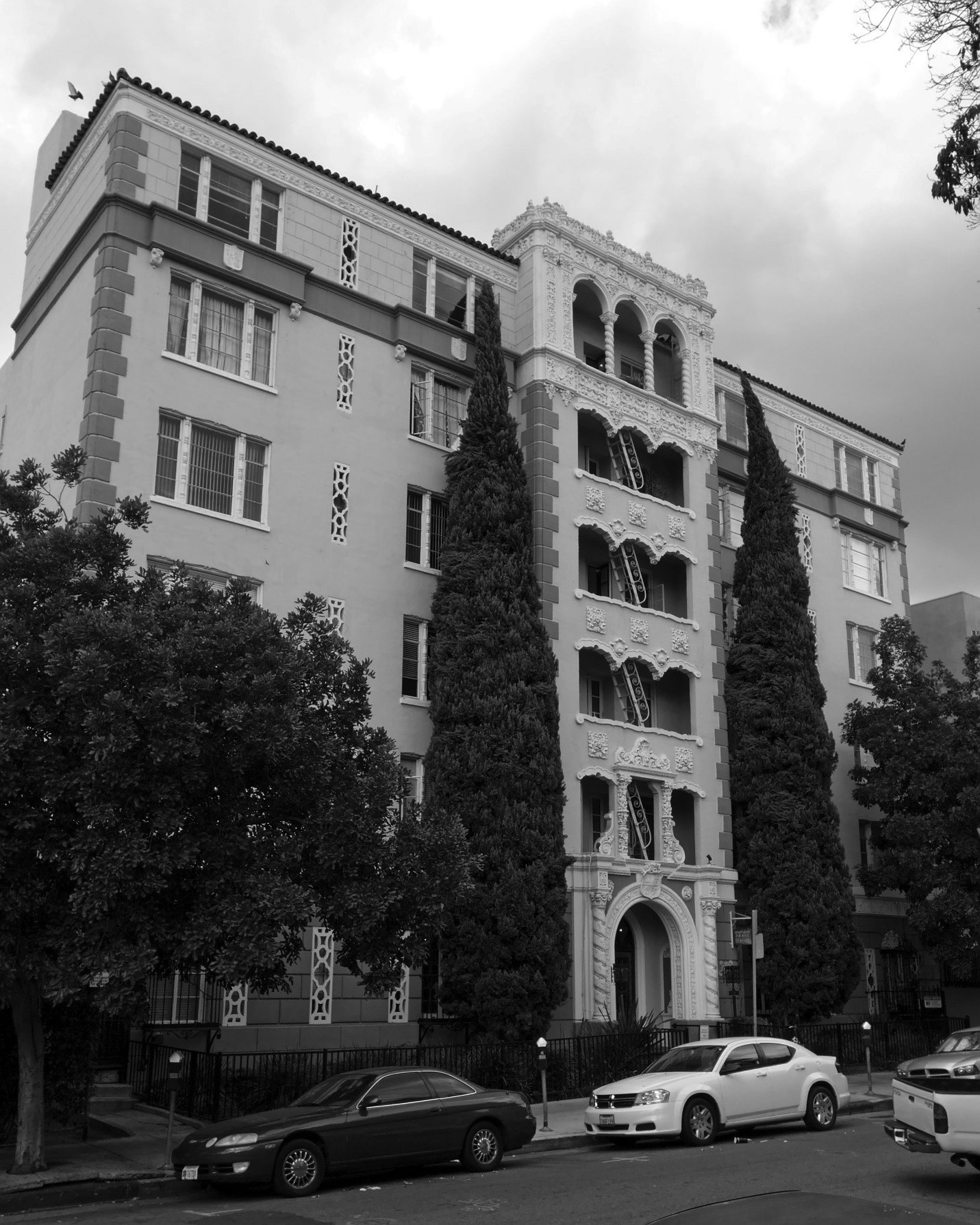 |
|
| (2015)*^ - La Leyenda Apartments as it appears today. Click HERE to see a more contemporary Google Street View. |
Historical Notes In 2005, the La Leyenda Apartment Building at 1735-1737 N. Whitley Avenue was dedicated as Los Angeles Historic-Cultural Monument No. 817. |
 |
|
| (2009)^ – Close-up view of the top two floors of the La Leylenda Apartments with its Churrigueresque cast stone detailing. Photo Courtesy: 'Just Above Sunset Photography' |
* * * * * |
Warner Bros Theatre (Hollywood)
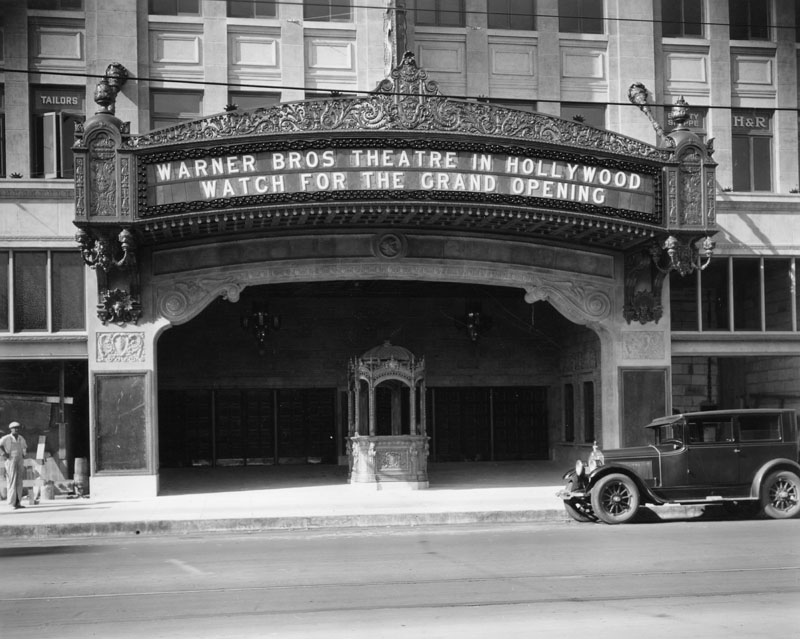 |
|
| (1928)* - Marquee says to "Watch for the Grand Opening" of Warner Bros. Theatre in Hollywood. |
Historical Notes Originally known as the Warner Bros. Theatre or Warner Hollywood Theatre, the Italianate beaux arts building was designed by architect G. Albert Lansburgh with approximately 2,700 seats. It opened on April 26, 1928, showcasing the studio's early Vitaphone talking film Glorious Betsy, starring Conrad Nagel and Dolores Costello.*^ |
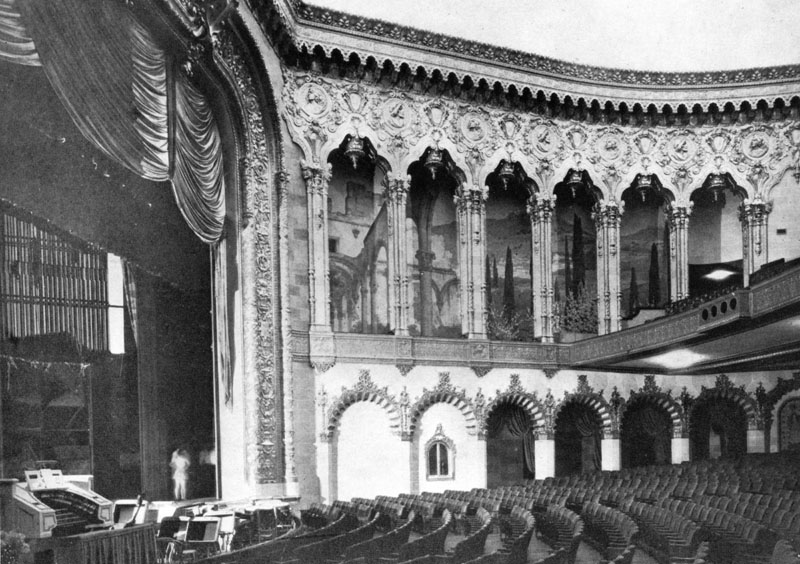 |
|
| (1928)* - Interior view of the Warner Bros. Theatre at the time of its opening. A very large organ can be seen to the left in the orchestra pit. |
Historical Notes The murals were designed by Albert Herter.*^ |
 |
|
| (ca. 1929)* - Full exterior view of the Warner Bros. Building and Theatre located at located at 6433 Hollywood Blvd. |
Historical Notes The theatre was sometimes called The Warner Hollywood Theatre to avoid confusion with another Warner Theatre in Los Angeles, known as "Warner Downtown Theatre" at 401 W. 7th St.*^ In 1993, the building was designated Los Angeles Historic-Cultural Monument No. 572 (Click HERE to see complete listing). |
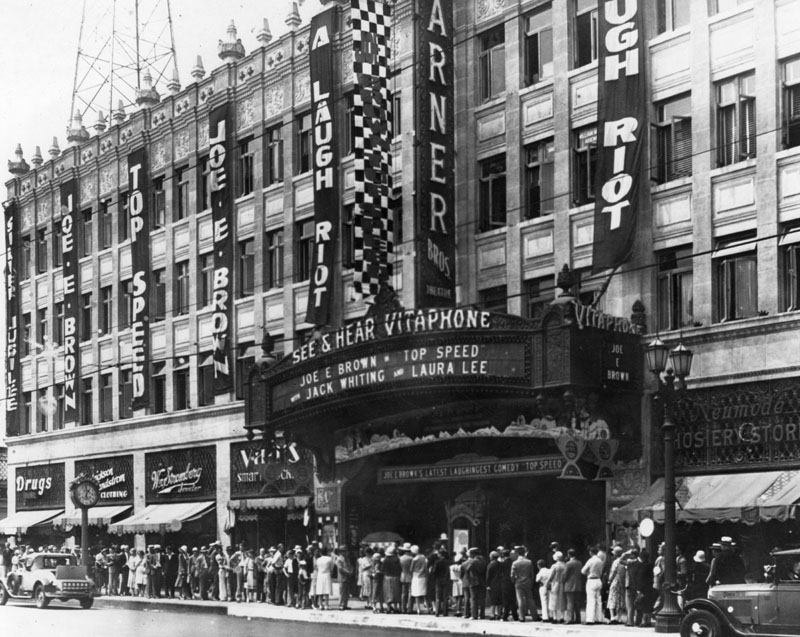 |
|
| (1930)* - Exterior with crowds for matinee performance of Joe E. Brown in "Top Speed" at the Warner Theatre on Hollywood Boulevard (Later the Hollywood Pacific Theatre). |
Historical Notes Warner Bros. owned radio station KFWB positioned its radio transmitter towers on top of the building, which remain to this day. Though covered by "PACIFIC" lettering, the original "WARNERS" lettering can still be seen inside each tower.*^ |
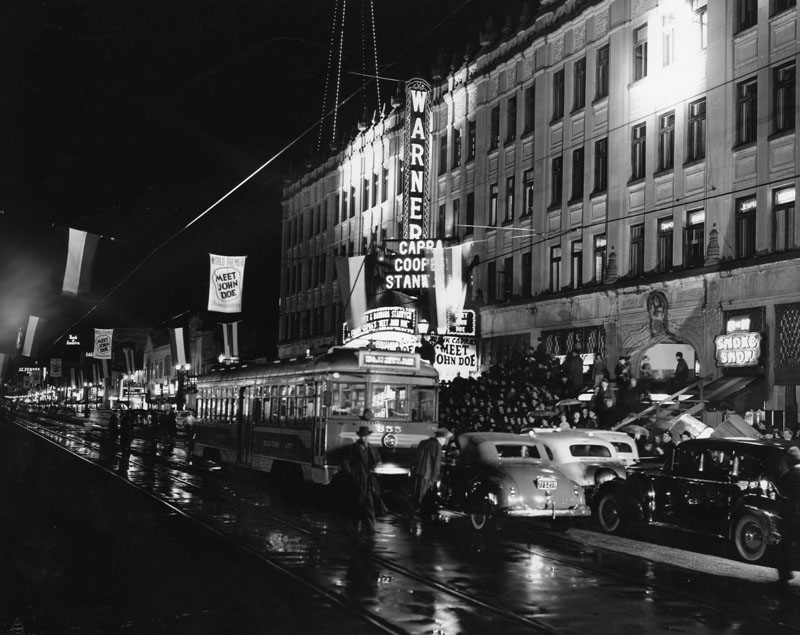 |
|
| (1941)* - Crowds in front of theatre on night of March 12, 1941, for world premiere of "Meet John Doe". |
Historical Notes The Hollywood Pacific Theater (previously Warner Bros.) finally closed its doors as a full-time cinema on August 15, 1994. This was mostly due to water damage to the basement caused by the construction of the Hollywood Subway Red Line and structural damage caused by the 1994 Northridge earthquake. The theatre is now occupied by Ecclesia Hollywood Church. Given the recent revitalization of Hollywood Boulevard in the early 21st century, it is often speculated that the theatre will one day be restored as a film palace.*^ |
* * * * * |
Pantages Theatre
.jpg) |
|
| (2019)* – Close-up view showing the front of the Pantages Theatre and its Art Deco intricate designs. Photo by Howard Gray |
Historical Notes Opened in the summer of 1930, The Pantages Theatre in Hollywood has become one of Los Angeles’ most enduring and recognizable cultural landmarks. |
Early Views and History
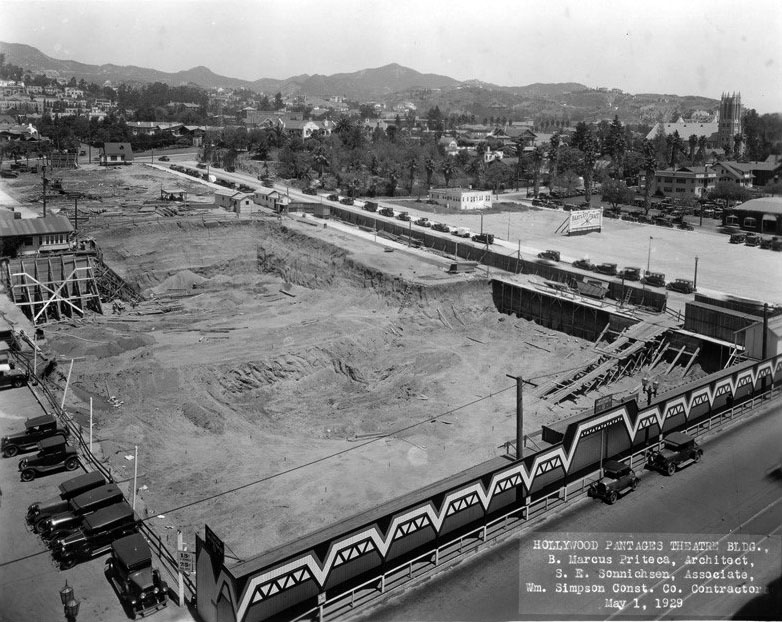 |
|
| (1929)^ – View looking northeast showing the construction site for the Hollywood Pantages Theatre, located on the northwest corner of Hollywood Boulevard and Argyle Avenue. The tallest peak in the distance is Mt. Hollywood, near where the Griffith Park Observatory would be built in 1933. |
Historical Notes The Pantages Theatre was constructed between 1929 and 1930 under the leadership of Alexander Pantages, and cost $1.25 million. |
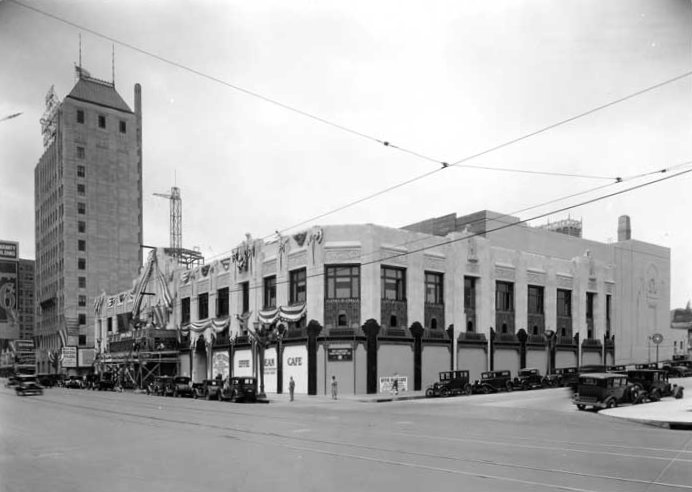 |
|
| (1930)* - View of the Pantages Theater still under construction in 1930, located on the northwest corner of Hollywood Boulevard and Argyle Avenue. The tall building to the west is the Equitable Building, located on the northeast corner of Hollywood and Vine. |
Historical Notes The Pantages Theatre, formerly known as RKO Pantages Theatre was the last theater built by the vaudeville impresario Alexander Pantages. The palatial Art Deco theater opened on June 4, 1930, as part of the Pantages Theatre Circuit. |
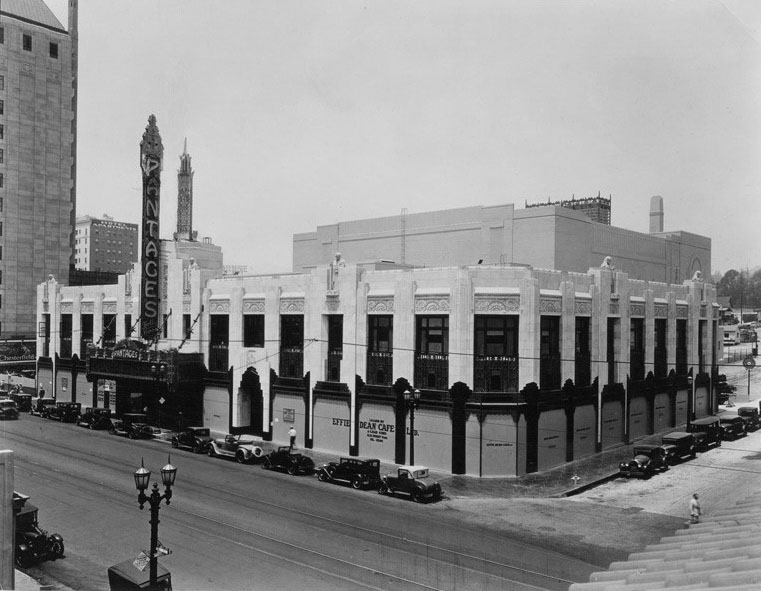 |
|
| (1930)* - View looking at the northwest corner of Hollywod and Argyle showing the newly completed Pantages Theatre. |
Historical Notes The original plans for the Pantages were for a 12-story building: 2 floors dedicated to theater and 10 floors of office space. Completion of the 10 upper floors was halted due to the 1929 stock market crash during construction. |
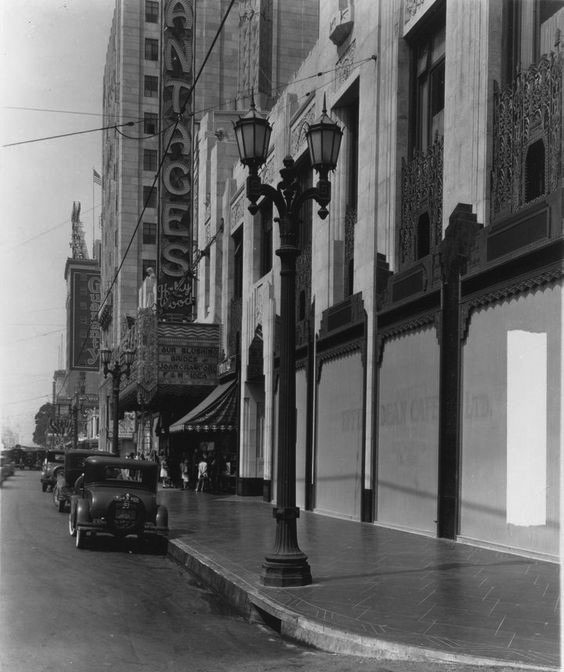 |
|
| (1930s)^v^ - Street view looking west on Hollywood Boulevard from Argyle Avenue showing the Pantages Theatre. Note the ornate streetlights that lined the street in front of the Pantages. These were commonly known as Metropolitan Electroliers and could be found throughout Hollywood in the 1930s. |
Historical Notes The Pantages Theatre can hold claim to two “lasts”: the last movie palace to be built in Hollywood and the last venue erected by vaudeville circuit owner, Alexander Pantages. |
 |
|
| (1930)+#+ – View showing the glitter and lights of the Pantages Theatre on what appears to be opening night. We’re looking southwest at the back of the theatre with cars parked along Argyle Avenue. Note the Art-Deco bas relief designs on the side of the building. |
Historical Notes The Pantages opened on June 4th, 1930 with MGM's “The Floradora Girl” starring Marion Davies. |
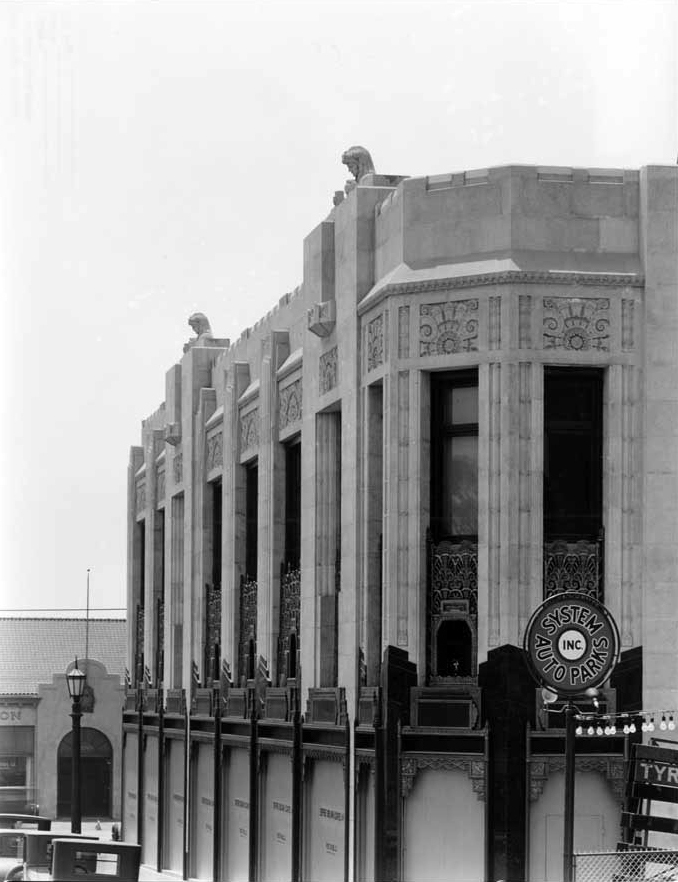 |
|
| (ca. 1930)* – Profile view looking toward Hollywood Boulevard at Argyle Avenue showing some of the Art Deco designs on the side of the Pantages building. Note the statues along the roof line. |
Historical Notes Designed by B. Marcus Priteca at the epitome of the Art Deco era, from sidewalk to stage, the Pantages dazzles theater-goers with chevrons, zigzags, starbrusts, and exotic figures.^ |
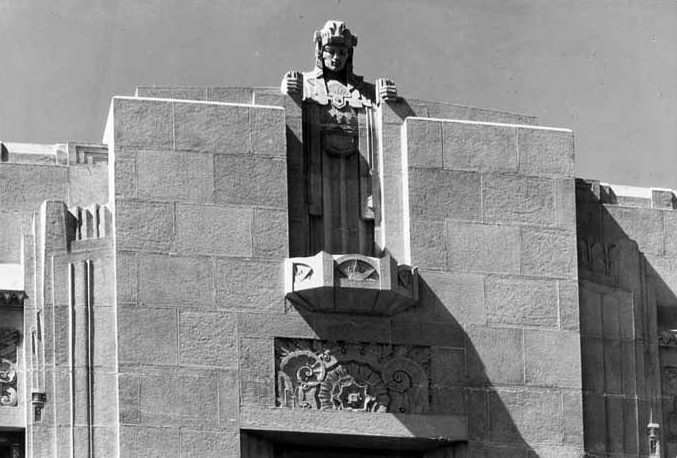 |
|
| (ca. 1930)* - Close-up view of one of the many statues that run along the Pantages’ roofline. They’re of a Mayan man with headdress. |
 |
|
| (1930)* - Exterior view of the Pantages Theatre located at 6233 Hollywood Boulevard shortly after it opened. Click HERE to see contemporary view. |
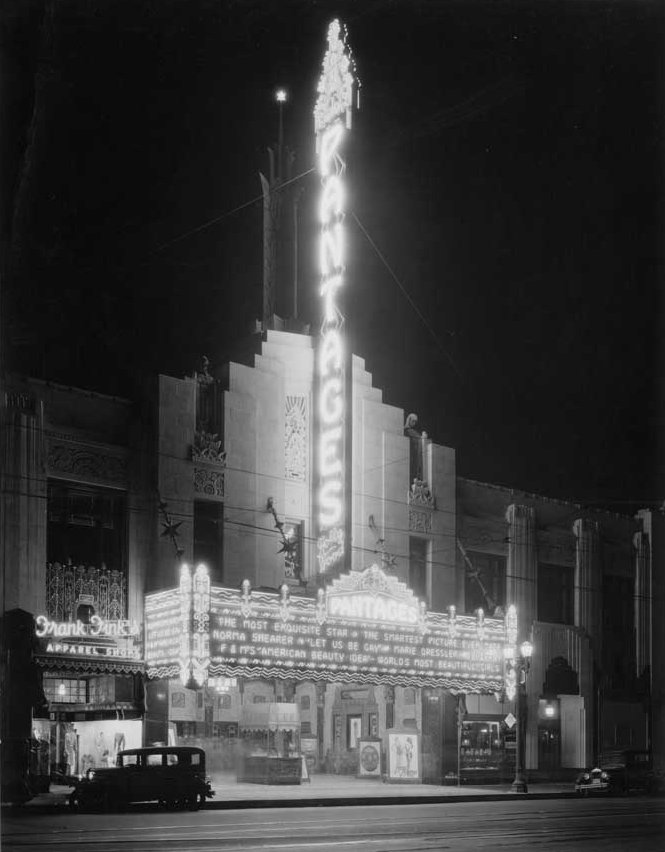 |
|
| (ca. 1930)* - Nighttime view of the front entrance to the Pantages Theater. Frank Fink's Apparel Shop is seen on the left. |
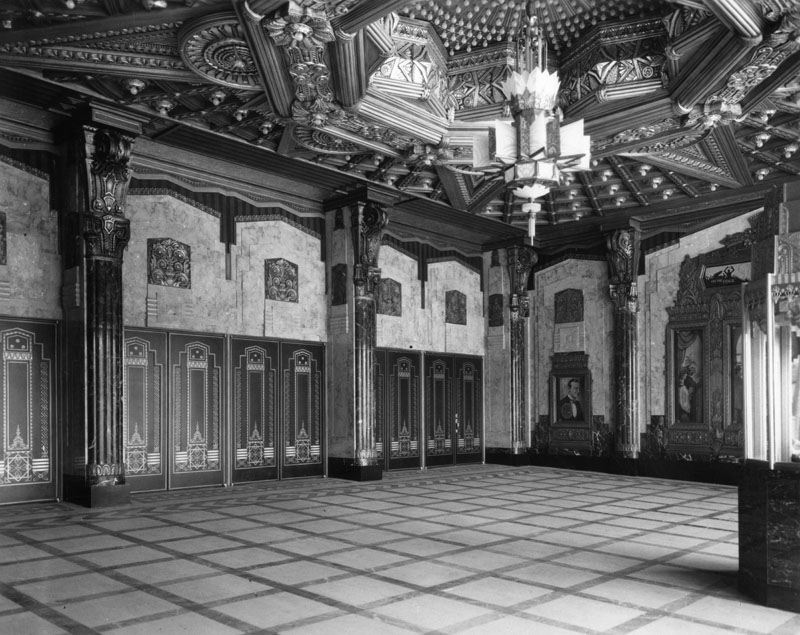 |
|
| (1930)* - View of the foyer at the Pantages Theatre with a close look at the ceiling. |
Historical Notes Alexander Pantages sold the Hollywood landmark in 1932 to Fox West Coast Theaters. In 1949, Howard Hughes acquired the Pantages for his RKO Theatre Circuit and moved his personal offices to the building's second floor. From 1949 through 1959, the theatre hosted the American motion picture industry's annual Academy Award Ceremonies. |
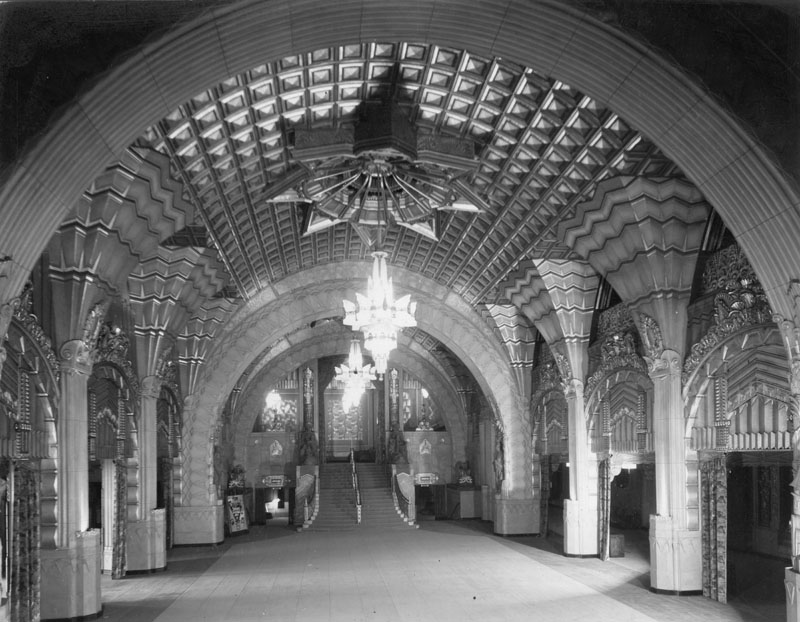 |
|
| (ca. 1930)* - Interior view of the Pantages Theatre. Designed by architect B. Marcus Priteca it is perhaps the most impressive of any Los Angeles theatre. |
Historical Notes The grand lobby is a magnificent poly-chromatic fan-vaulted space, that is 110 feet wide and 60 feet deep. It is decorated in a zigzag geometric design in gold and henna shades. The entire area was illuminated by three huge Moderne frosted glass chandeliers hanging from three star-shaped domes. |
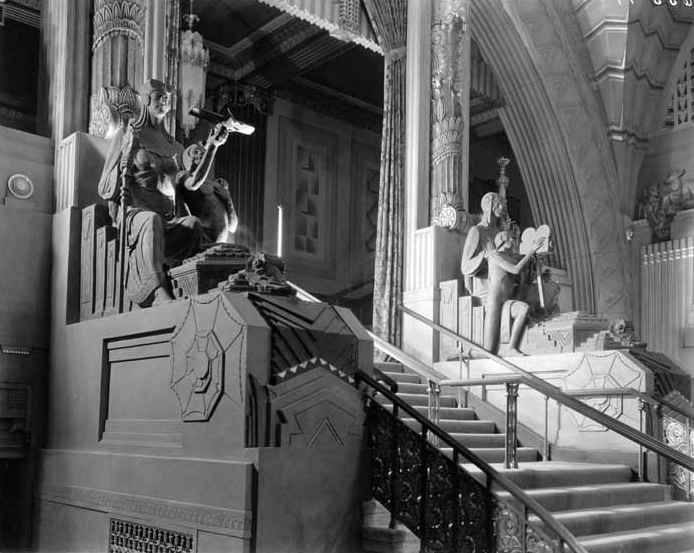 |
|
| (ca. 1930)^*# - View showing one of the two Art-Deco staircases decorated with Art Deco style statues. |
Historical Notes At each end of the grand lobby is a 20 feet wide stairway, lined with vaguely Egyptian and Assyro-Babylonian styled statues, one of which depicts in an Art Deco style, a camera crew filming. |
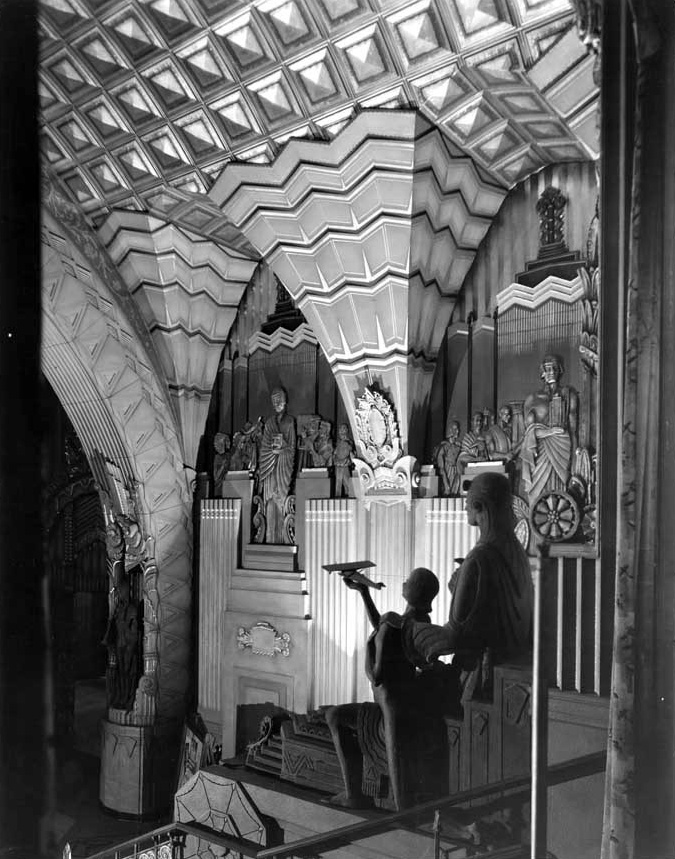 |
|
| (ca. 1930)^*# - View looking down into the grand lobby from top of staircase showing the magnificent zigzag geometric design of the pillars. |
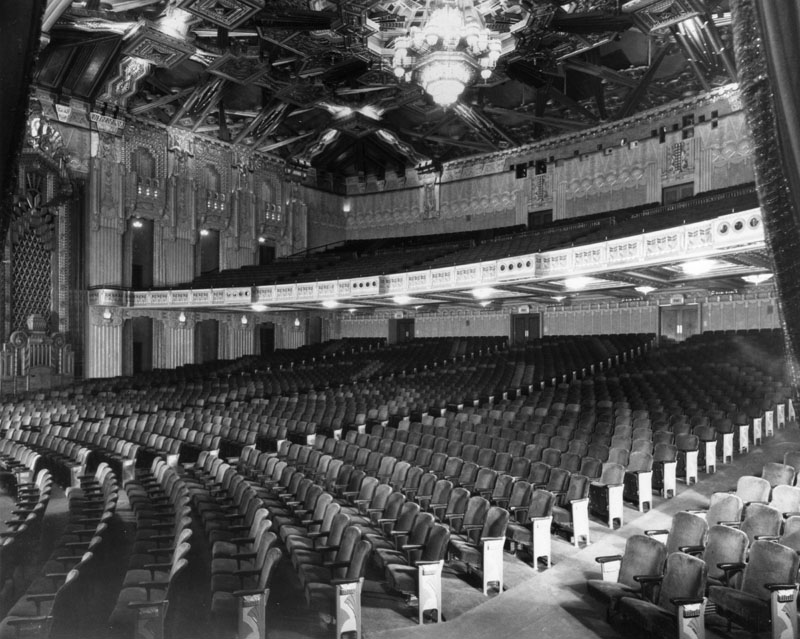 |
|
| (1930)* - View of the auditorium interior of the Pantages Theatre. |
Historical Notes The auditorium was designed to seat 3,212, but it opened with extra legroom and wider seats to give more comfort for its 2,812 patrons. |
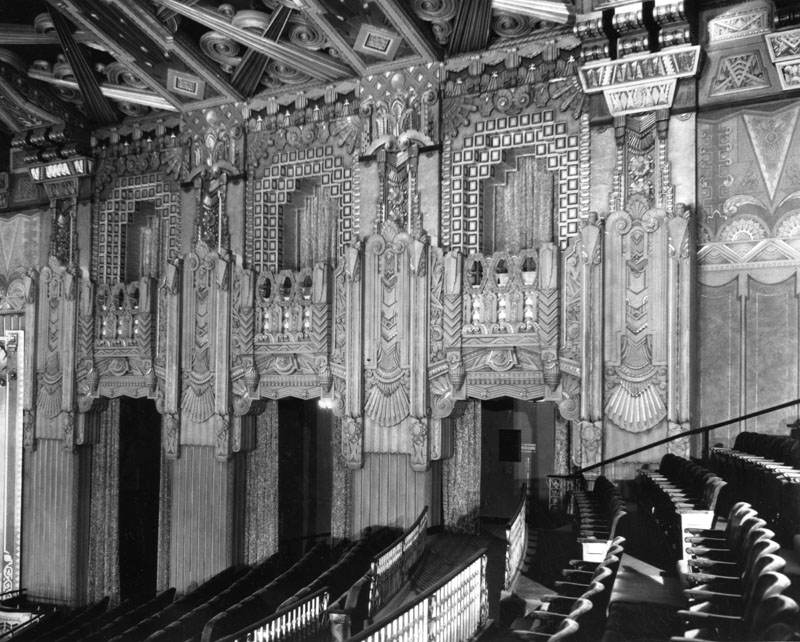 |
|
| (1930)* - A partial view of the balcony seats inside the Pantages Theatre. Note the details of the ornamental Art Deco designs on the wall. |
Historical Notes The crowning beauty of the dazzling Art Deco style decorations which cover almost every inch of the theatre interior, by interior designer/muralist Anthony B. Heinsbergen, is the double ceiling made in a series of ‘busy’ fretwork sunray effects which converge from the center, from which is hung a tremendous frosted glass and bronze chandelier. |
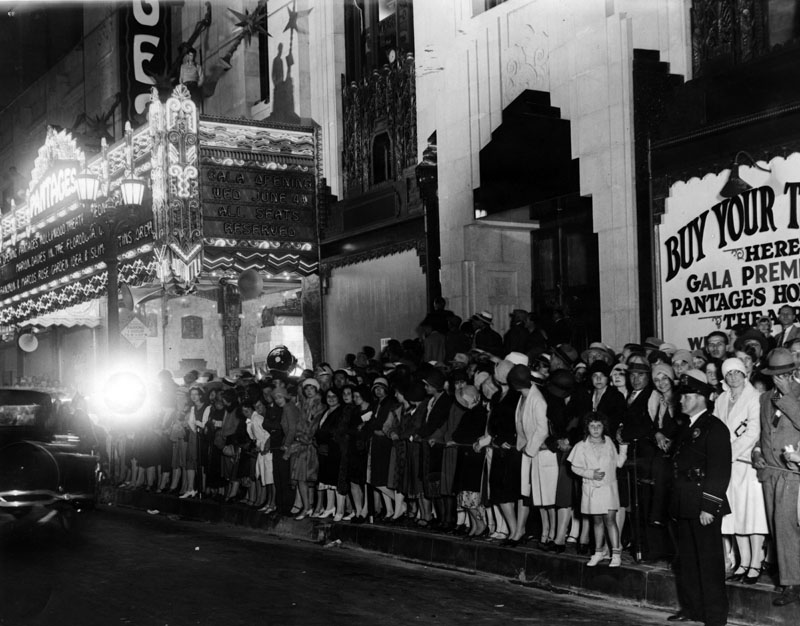 |
|
| (1930)* - Close-up view of fans awaiting the arrival of celebrities attending gala opening premiere of "Florodora Girl", starring Marion Davies. |
Historical Notes The Pantages Theatre was one of the first movie houses to be built after the advent of talking pictures and once boasted the most elaborate sound system in the world. It opened with Marion Davies in “The Floradora Girl” on screen, and “The Rose Garden Idea” a Franchon & Marco stage revue. |
 |
|
| (ca. 1930)* - Night view of the Pantages Theater featuring a Clara Bow movie. |
Historical Notes The Pantages Theater continued to be a major venue for road show movies into the 1970s. From 1965, it was operated by Pacific Theatres. It closed as a movie theater in January, 1977, and re-opened the following month with Bubbling Brown Sugar, the first of the many stage productions that have since become its regular fare. |
 |
|
| (1931)* - The lighted marquee at night of the Pantages Theatre. The main feature is 'Tarnished Lady' with Tallulah Bankhead and Clive Brook. |
Historical Notes The 1930 Pantages Theatre can hold claim to two “lasts”: the last movie palace to be built in Hollywood and the last venue erected by vaudeville circuit owner, Alexander Pantages. Designed by B. Marcus Priteca at the epitome of the Art Deco era, from sidewalk to stage, the Pantages dazzles theater-goers with chevrons, zigzags, starbrusts, and exotic figures. |
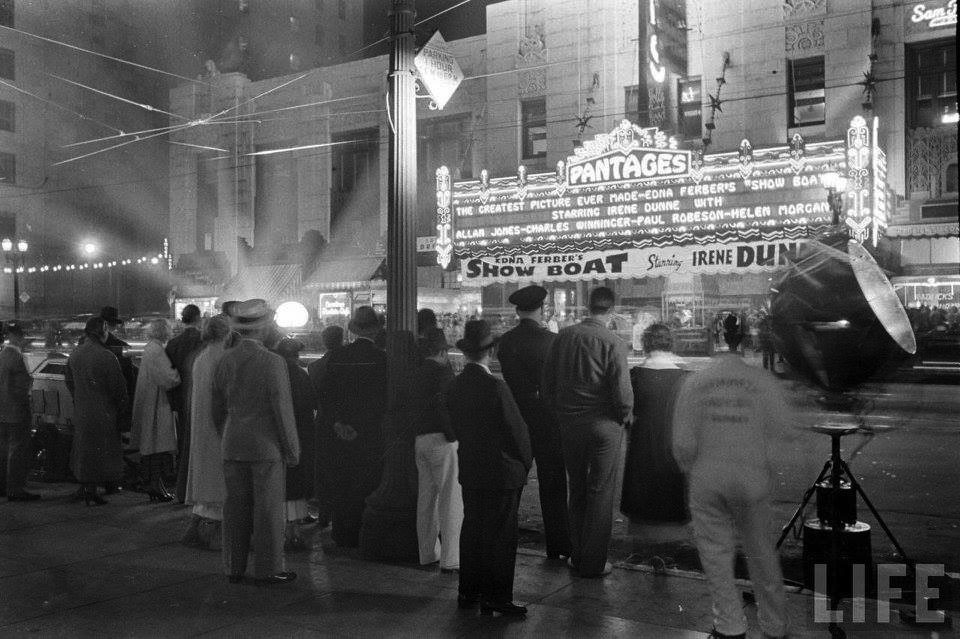 |
|
| (1936)+#+ – Life Magazine photo showing a crowd gathered across Hollywood Boulevard from the Pantages Theatre as Universal Pictures hold a whiz-bang premiere for “Show Boat”. Notice how the marquee claims it is “The Greatest Picture Ever Made”. |
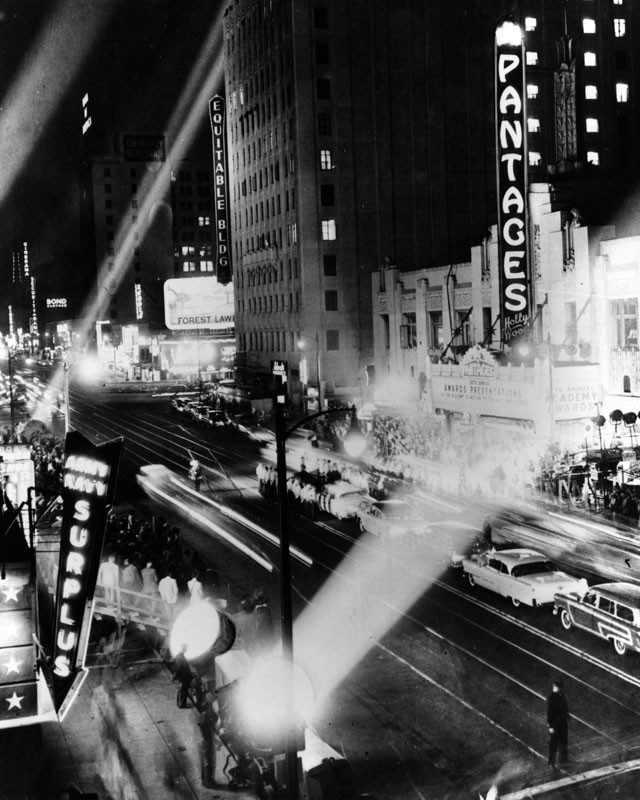 |
|
| (1950)* - Exterior view of the Pantages Theatre during the 20th Annual Academy Awards. Crowds of people are seated in bleachers directly outside the theater and on the south side of Hollywood Blvd. A line of cars is seen in the middle of the boulevard. Various signs identify neighboring buildings and businesses: Army Navy store, the Equitable Building, Bond Clothiers, Bank of America, Cinerama and the Guaranty Building. Street car tracks are visible on the street. |
Historical Notes From 1950 to 1960, the awards were presented at Hollywood's Pantages Theatre. The 22nd Academy Awards Ceremony awarded Oscars for the best in films in 1949. This was the last year for which all five Best Picture nominees were in black and white.*^ Best Picture: All the King's Men Best Actor: Broderick Crawford – All the King's Men Best Actress: Olivia de Havilland – The Heiress |
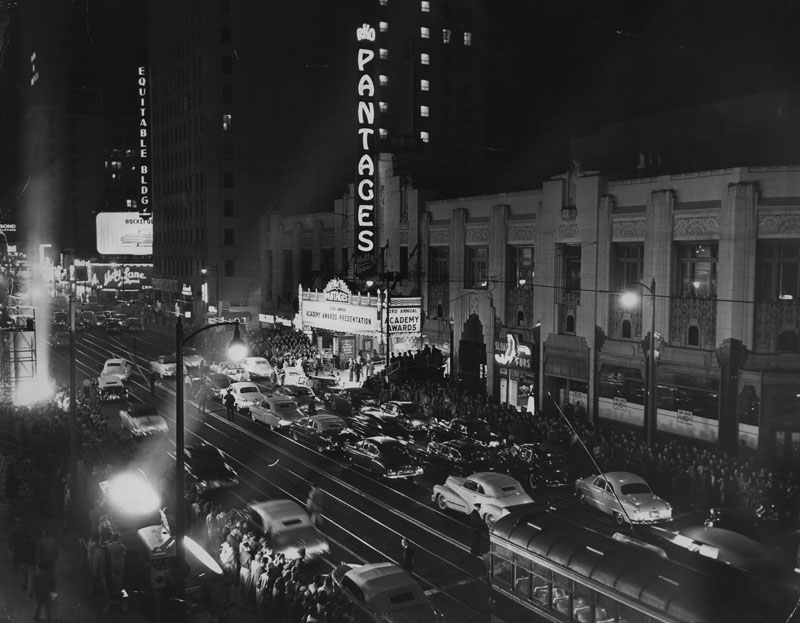 |
|
| (1951)* - The 23rd Annual Academy Awards at the Pantages Theatre in Hollywood. |
Historical Notes The 23rd Academy Awards Ceremony awarded Oscars for the best in films in 1950. The nominations were notable this year, as All About Eve was nominated for fourteen Oscars, beating the previous record of thirteen set by Gone with the Wind.*^ 23rd Annual Academy Awards (March 29, 1951): Best Picture: All About Eve Best Actor: José Ferrer – Cyrano de Bergerac Best Actress: Judy Holliday – Born Yesterday |
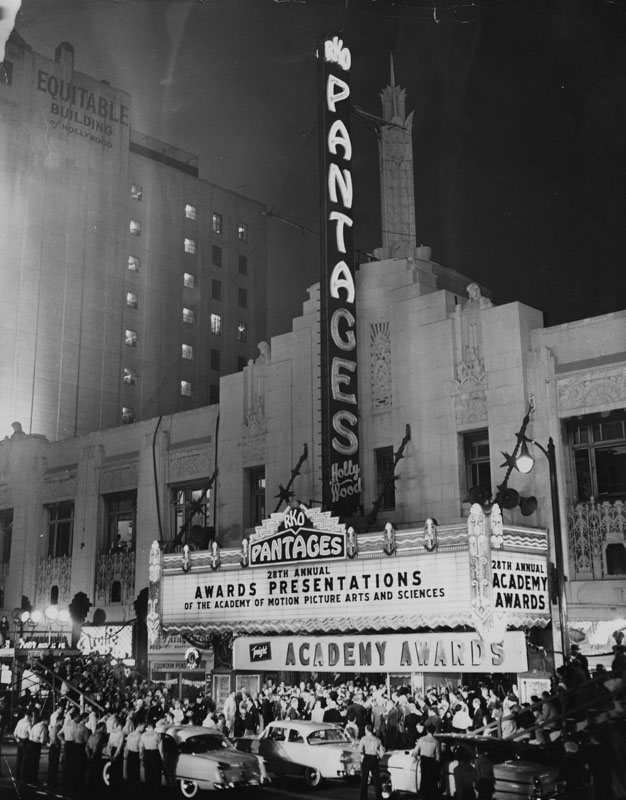 |
|
| (1956)* - View of the crowd gathered in front of the Pantages Theater in Hollywood to watch the stars come out for the Academy Awards. More than 10,000 gathered in front of the famed theater on March 21, 1956, to cheer their favorites. More than 90 regular and reserve policemen were needed to keep the crowd in order. |
Historical Notes The 28th Academy Awards, saw, Marty, a simple and low-budget film usually uncharacteristic of Best Picture awardees, became the shortest film (as well as the second Palme d'Or winner) to win the top honor.*^ 28rd Annual Academy Awards (March 21, 1956): Best Picture: Marty Best Actor: Ernest Borgnine – Marty Best Actress: Anna Magnani – The Rose Tattoo |
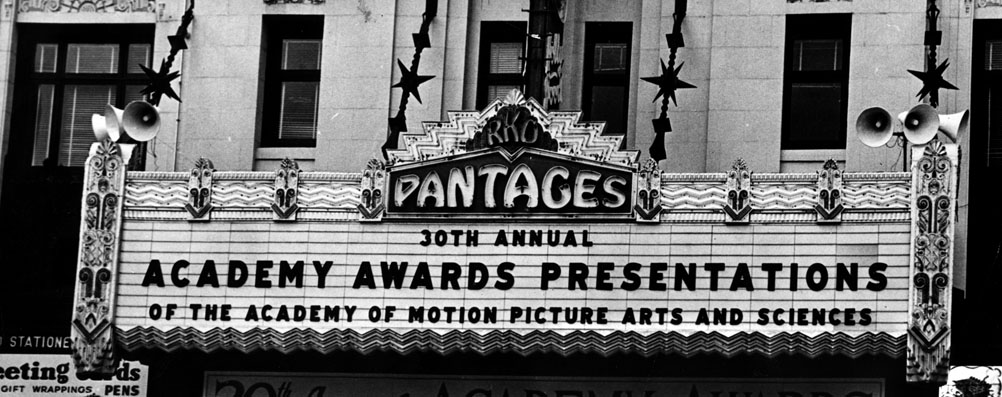 |
|
| (1958)* - 30th Annual Academy Awards at the Pantages Theatre. |
Historical Notes 1957's best films were honored at the 30th Academy Awards. The Oscar for Writing Based on Material From Another Medium was awarded to Pierre Boulle for The Bridge on the River Kwai, despite the fact that he did not know English. The actual writers, Carl Foreman and Michael Wilson were blacklisted at the time and did not receive screen credit for their work. Foreman and Wilson have since been acknowledged by the Academy for their contributions. Joanne Woodward's win for Best Actress for her triple role as Eve White, Eve Black and Jane in The Three Faces of Eve marked the film as the last film to win Best Actress without being nominated for other awards. This was broken 31 years later when Jodie Foster won Best Actress for her role in The Accused, the film's only nomination. Peyton Place tied the record for the most nominations without a single win (9) with The Little Foxes. It would not be broken until 1977 when The Turning Point received 11 nominations without a win, which has not been broken since, though The Color Purple subsequently tied the record. Peyton Place also set the record for most unsuccessful acting nominations with five; this record has been tied once, by Tom Jones at the 36th Academy Awards. It was the first time the ceremonies were broadcast live.*^ 30th Academy Awards (March 26, 1958): Best Picture: The Bridge on the River Kwai Best Actor: Alec Guinness – The Bridge on the River Kwai Best Actress: Joanne Woodward – The Three Faces of Eve |
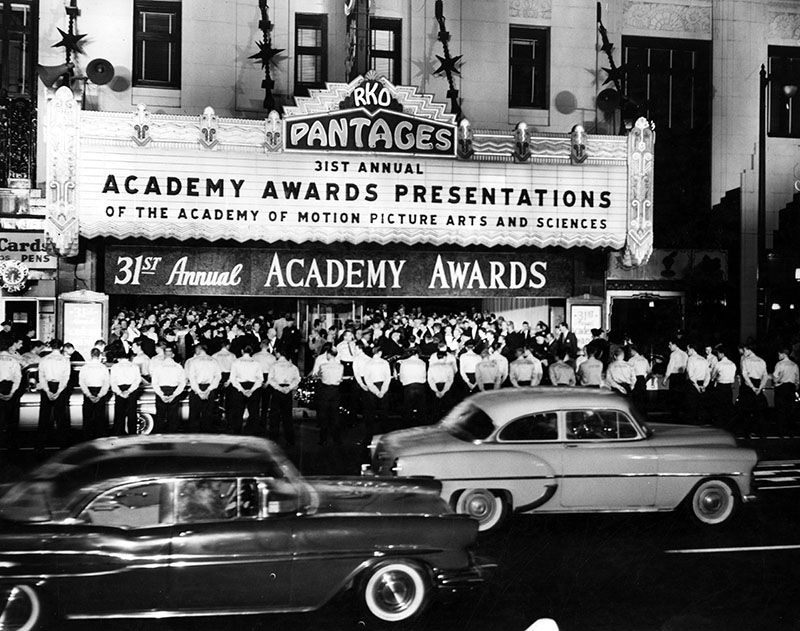 |
|
| (1959)* - Photograph caption dated April 7, 1959 reads, "Theater lobby packed - Here at the last moment, crowds of ticket holders make a rush for the Hollywood Pantages door in anticipation of the two-hour telecast of the Academy of Motion Picture Arts and Sciences' 31st annual awards presentation. More than 100 famed stars were on hand to regale the packed audience.". |
Historical Notes The 31st Academy Awards ceremony was held on April 6, 1959, to honor the best films of 1958. The show's producer, Jerry Wald, started cutting numbers from the show to make sure it ran on time. Unfortunately, he cut too much material and the ceremony ended 20 minutes early, leaving Jerry Lewis to attempt to fill in the time. Eventually, NBC cut to a re-run of a sports show. The film Gigi won nine Oscars, breaking the previous record of eight (set by Gone with the Wind and tied by From Here to Eternity and On the Waterfront). It would be shortlived, however, as Ben-Hur broke the record with eleven Oscars the following year.*^ 31st Annual Academy Awards (April 6, 1959): Best Picture:Gigi Best Actor: David Niven – Separate Tables Best Actress: Susan Hayward – I Want to Live! |
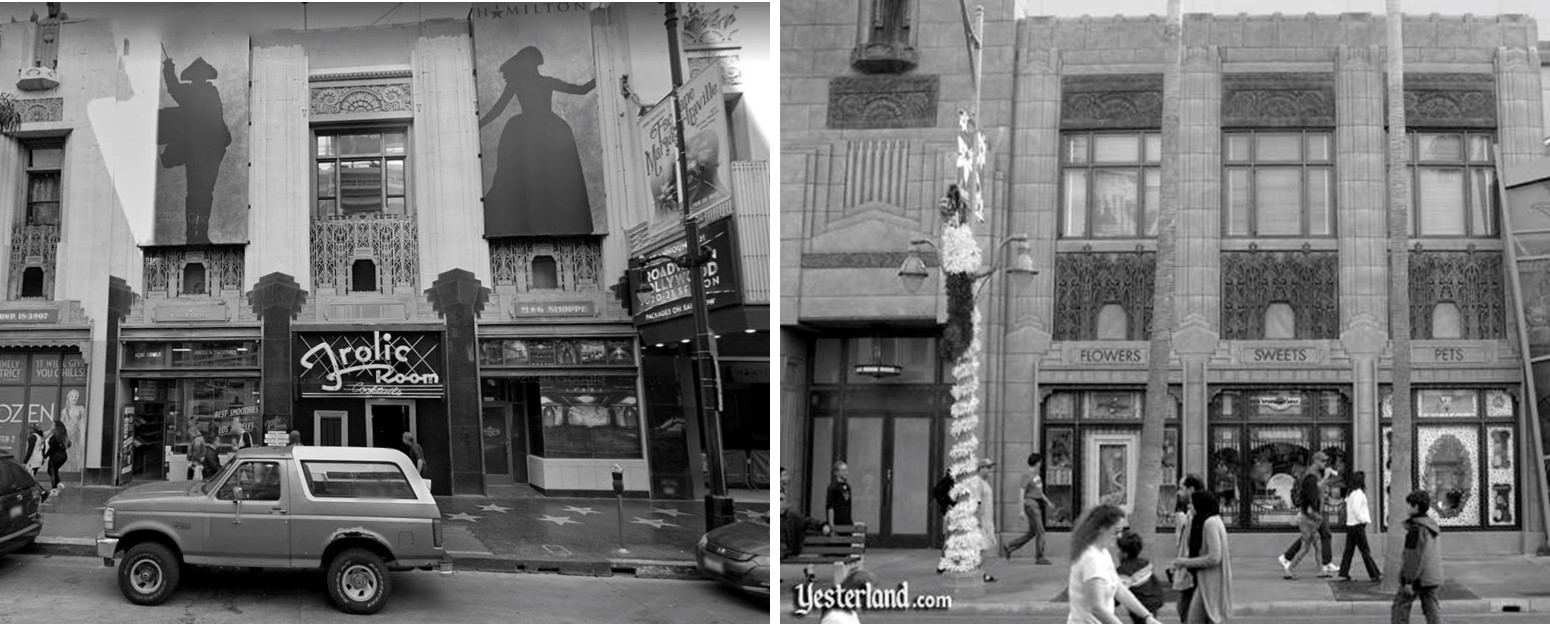 |
|
| (2008)^v^ –On the right is Disney’s Hollywood Studios Backlot façade based on the Pantages Building design as seen to the left. |
Historical Notes The Hollywood Pictures Backlot façade with its signs, “Flowers, Sweets, Pets,” is based on the famed Pantages Theatre in Hollywood—but only the part of the Pantages that’s to the left of the theater’s entrance and marquee, which is why the Disney version doesn’t look like a theater. |
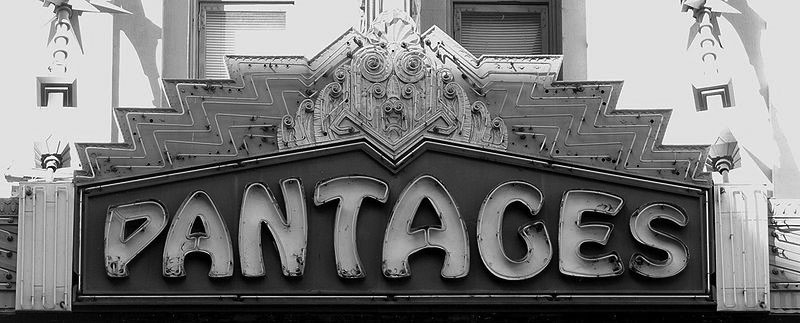 |
|
| (2008)*^ - Close-up view of the Pantages Theatre neon sign above the entrance to the Pantages Theatre. |
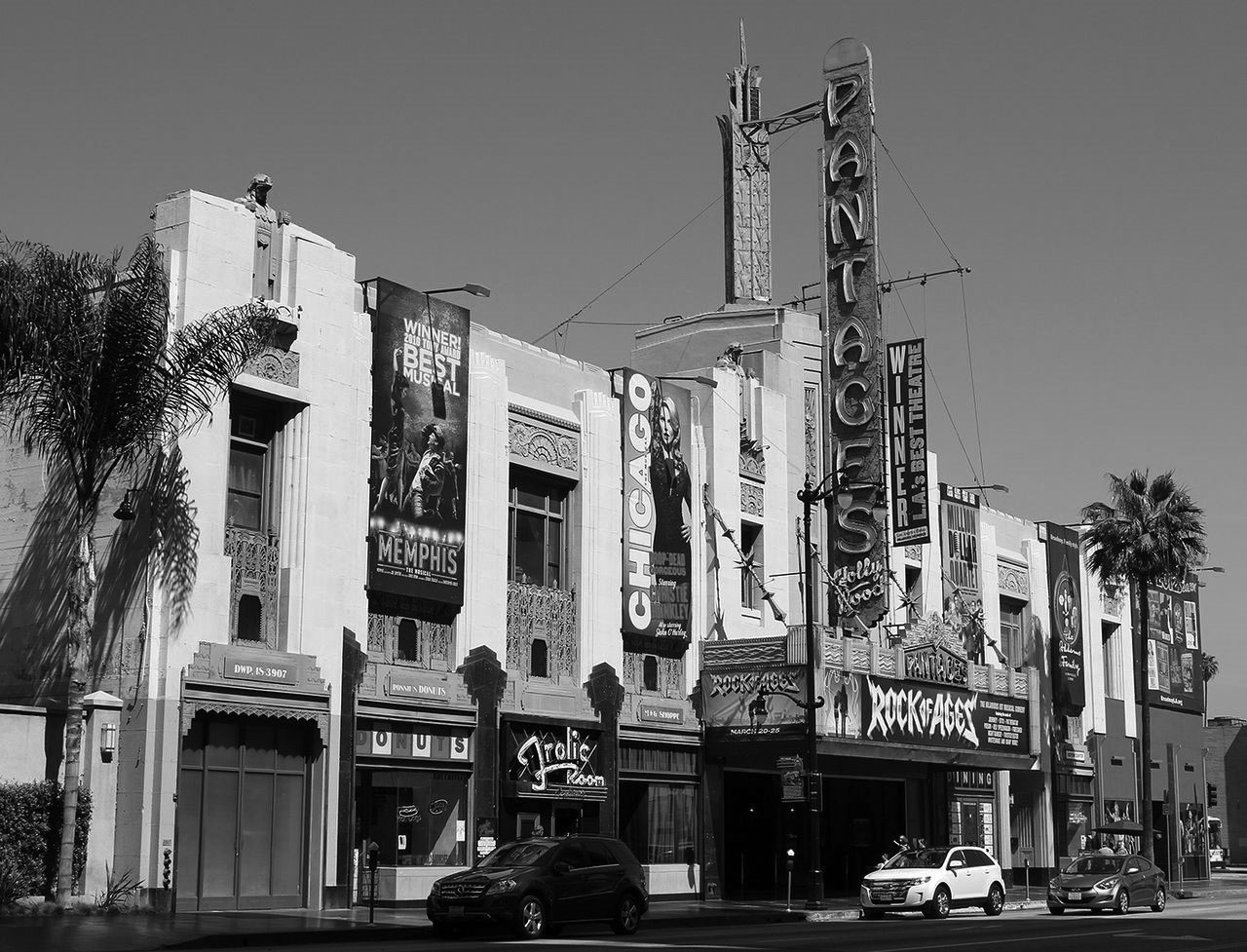 |
|
| (2012)*^ – View of the Pantages Theatre with the Frolic Room seen just left of the entrance. |
Historical Notes The Frolic Room, located next door to the Pantages Theater is one of the most historic and quintessential dive bar in Hollywood. This watering-hole has gone through a variety of permutations over the years. It began serving as a private speakeasy lounge originally called Freddy’s, then opened to the public in 1934, as Bob’s Frolic Room. The Frolic Room was reputedly the last place the real Black Dahlia, Elizabeth Short, was seen alive. Both Frank Sinatra and Judy Garland also imbibed here. Howard Hughes owned both the Pantages and the bar from 1949 to 1954. He added the colorful, artistic neon bar sign above the door that still welcomes patrons today, as well as throwing lavishly wild parties.^ |
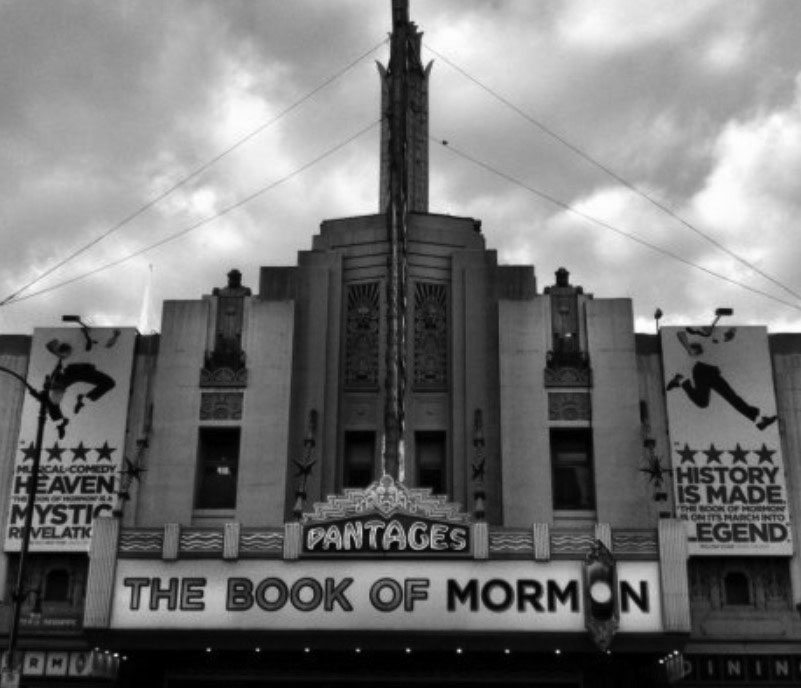 |
|
| (2014)* – Pantages Theatre marquee reads "The Book of Mormon". Photo by Adrian Scott Fine - LA Conservancy |
Historical Notes In 2000, the theater underwent a massive rehabilitation project, uncovering its Art Deco grandeur, receiving a Conservancy Preservation Award in 2001. |
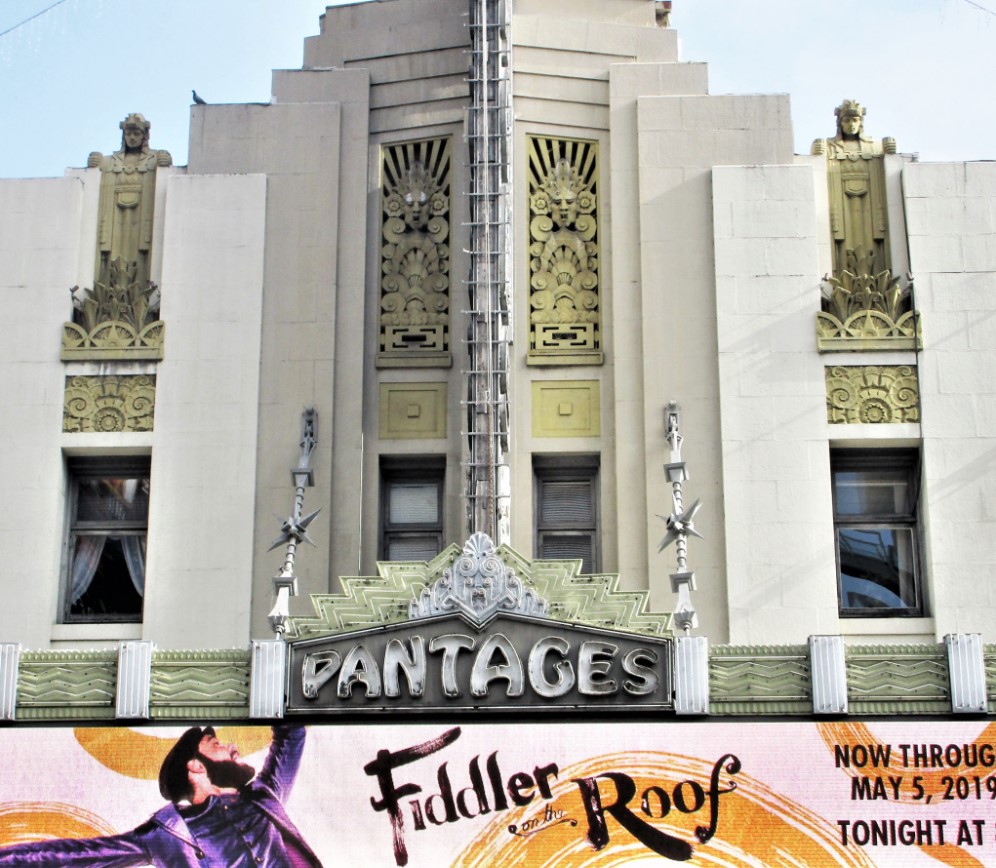 |
|
| (2019)^.^ – Pantages Theatre marquee reads "Fiddler on the Roof". Photo by Howard Gray |
Historical Notes Now operated by a subsidiary of The Nederlander Organization, the fully-restored Pantages is one of the city’s highest-grossing venues for live stage and Broadway-style productions, packing in audiences for such lavish hits as The Lion King, Wicked, The Book of Mormon, Fiddler on the Roof, and Hamilton. With a location a few steps from “Hollywood and Vine,” a major hotel complex and a subway station directly across the street, and numerous development projects newly-announced or underway, the best years of the Pantages may well lie in the future.^ |
* * * * * |
Click HERE to see more in Early Views of Hollywood (1920 +) |
* * * * * |
Please Support Our CauseWater and Power Associates, Inc. is a non-profit, public service organization dedicated to preserving historical records and photos. Your generosity allows us to continue to disseminate knowledge of the rich and diverse multicultural history of the greater Los Angeles area; to serve as a resource of historical information; and to assist in the preservation of the city's historic records. |
For more Historical Los Angeles Views click one of the following:
For Other Historical Views click one of the following:
See Our Newest Sections:
To see how Water and Electricity shaped the history of Los Angeles click one of the following:
Water:
Power:
* * * * * |
References and Credits
* LA Public Library Image Archive
** DWP - LA Public Library Image Archive
^* Oviatt Library Digital Archives
*# Blogdownton: State Building
#^Historic Hotels of Los Angeles and Hollywood (USC - California Historic Society)
**#UCLA Library Digital Archive
^**Flickr:: Disney Hall: Jeffrey Bass; Steel and Sky: alanek4; Staples Center: jaubele1; Wilson Building - paulsp23; Bas Relief - LA Times Building
^#^Los Angeles Conservancy: LA Stock Exchange Building; Downtown Jewelry Exchange/Warner Bros. Theatre; Pantages Theatre
*#*Project Restore: Van Nuys City Hall
#*^Historylosangelesblogspot.com: Hattem's Supermaket
#^*Facebook.com - Vintage LA: Hollywood Palladium; Wilshire Blvd - Westlake Theater; Canter's Deli (Interior); Cantor's Deli (Exterior); LA County General Hospital; Profile View County General Hospital; Schwabs Sunset; Shrine Auditorium: Farmers Market; Capitol Records Building; Hollywood Ranch Market
+^^Panoramio.com: Equitable Building
*^#Historical Los Angeles Theatres: Downtown Theatres; Mayan Theatre; Warner Bros.Theatre
^^*LA Times: Easter at the Hollywood Bowl; Drive-ins Roared into LA Country; Little Joe's Restaurant; Zanja Madre; Blossom Plaza; Sunkist Bldg.; Demolition of Old Times Bldg; Alhambra Airport Dedication; Farmers Market; Hollywood American Legion Post 43
^*#California State Library Image Archive
*#^historylosangeles.blogspot.com: Ice Skating in Westwood
*##LA Weekly - Warner Bros. Theatre
##*Mr. Cecil's California Ribs
##^Pinterest.com: Favorite Places and Spaces
#*#Everything2.com: Hattem's Market
#^#Deadhistoryproject.com: Silent Movie Theater
^##This Moderne Life: Simon's Drive-In
***Los Angeles Historic - Cultural Monuments Listing
*^*California Historical Landmarks Listing (Los Angeles)
^#*Historic Hotels of Los Angeles and Hollywood (USC - California Historic Society): St. Charles Hotel
^^^The Drive-In, the Supermarket, and the Transformation of Commercial Space in Los Angeles, Richard Longstreth
*^^Nuestra Señora la Reina de los Ángeles: losangelespast.com; Bob's Airmail Service Station
*#*#I Love Los Angeles But...: Sontag Drug Store
****Gramfeed.com: Los Angeles City Hall
^***Griffithobservatory.org: History of Griffith Observatory
^**^Griffith Observatory: laparks.org
^^**Flickr.com - Floyd B. Bariscale Photostream; Villa Madama
^^*^Tumblr.com: DWP Office Building
^^^*Flickr.com - Debit72: Staples Center; Jerical Cat: Mullen Bluett Bldg.
*^*^Beverly HIlls Patch: Beveryl Hills City Hall; A New City Hall for a New City
**^^Big Orange Landmarks: Los Angeles City Hall; Automobile Club Building; Drive-ins Roared into LA Country; Sinai Temple/Korean Philadelphia Presbyterian Church
**##Spring Arcade Building - panoramio.com
^^#*Huntington Digital Library Archive
^^##Mercantile Arcade Building - laconservancy.com
^##^Mattconstruction.com: USC Mudd Hall
^^#^Facebook.com - Great Photos from Los Angeles's Past:: Farmers Market
^^^#Publicartinla.com: Building on the USC Campus
***^Pinterest.com: Bertrand Lacheze; La La Land: Canter's/Pup o' Tail; Thanks for the Memories/Drive-In 1950s; Drive-in Speakers; Aerial Westwood - Rancho Park
*^^*Los Angeles: Portrait of a City
^*^*LAist.com: The Pan Pacific Auditorium; Century Plaza Hotel; Dorothy Chandler Pavilion
^*^^Los Angeles Past: Temple and Main Streets, Los Angeles - Then and Now
^**#Los Angeles Movie Palaces: Leimert / Vision Theatre; Fairfax Theatre; Fox Stadium Theatre
^*^#Facebook.com - Bizzare Los Angeles
^#^#A Sanctuary for Women, Even Today - nytimes.com
*#^#An Architectural Guidebook to Los Angeles
*###World Travel List: Not Just a Hot Dog
^###Examiner.com - Taix French Restaurant
*^^^Art Deco in Mono
*##^gogonotes.blogspot.com: Cool Places On La Brea
+##^UC Santa Cruz Digital Archive
^##*LAheyday.blogspot.com: American Storage Building
*#*#Los Angeles Almanac: LA County-USC Medical Center
*^*#Sketchup.google.com: Dominguez-Wilshire Building
*^^#Curating the City: Sunset Clock Market
*#**Elvis Blog
^*#*Library of Congress Image Archive
##*#Peacelovelunges.com: El Coyote Cafe
^#^*Elcoyotecafe.com: El Coyote Mexican Cafe History
^^*#Flickr.com: El Coyote Neon Sign; LA County General Hospital; General Hospital Bas Relief
**^*MTA Transportation and Research Library Archives
^#*#Eyes of a Generation: RCA Camera
*#**Historic Hotels of Los Angeles and Hollywood (USC - California Historic Society); U.S. Hotel
*#*^LA County Sheriff Department: Hall of Justice
*#^^Philippes The Original Home Page
*^#*Franklinavenue.blogspot.com: Mullen and Bluett Bldg.
**#^LAPL-El Pueblo de Los Angeles Historical Monument Photo Archive
*^#^Paradiseleased.com: Lighting Up the Coast
^*#^Art Deco Architecture: LA Radio City
^#**Facebook.com - City of Angels: Hotel Somerville; Brown Derby
^#*^LA Times: Amestory Building
##**MartinTurnbull: Cross Roads of the World; Earl Carroll Theater; Mirror Theatre
##*^Hollywood Walk of Fame Historic Buildings
##^*blogdowntown 6/24/10 Article - 45 Years Ago: New Water and Power Headquarters Dedicated
##++Facebook.com: Classic Hollywood-Los Angeles-SFV
#*#*Facebook.com - Los Angeles Theatres: Warner Bros. Downtown
*#^*MartinTurnbull.com: Hollywood-Western Building; Nickabob Restaurant; Biff's Coffee Shop
^#^^Twentieth Century Architecture and Interiors: The May Co. Wilshire Building
^#^^Flickr.com: Michael Ryerson
#^#*Flickr.com - Army.Arch: Bankers Building
#**#On Bunker Hill: Architects' Building
#^*^Calisphere: University of California Image Archive
#*#^Groceteria.com: A&P History
###*The Go Go's: Local Coffee Shops and Diners
###^Pinterest.com: Los Angeles
##^#Facebook.com: San Fernando Valley Relics
####Southern Pacific Coast Daylight
#^#^Pinterest.com: Old Hollywood
#*^^Hollywood Chamber of Commerce History
#***Canter's Deli: cantersdeli.com
#**^Starlinetours.com: TLC Chinese Theatre
#*^*MusicCenter.org
#^*#Pinterest.com: Old Hollywood
#*^#TheHollywoodMuseum.com: Max Factor Building
#*##Facebook.com: Classic Hollywood-Los Angeles-SFV
***#Pinterest.com: Vintage Los Angeles; Los Angeles - Carey Vance; Art Deco - Sears Building; Art Deco - Val D'Amour Apartments; Drive-in Speakers; Mayan Theatre
^###The Historical Marker Database: Stephen M. White Statue
#^##Timeout.com: Ricardo Montalban Theatre
**^^^Facebook.com - San Pedro's Original Website, San Pedro.com
^^***Pinterest: Diners
^*^*^You-Are-Here.com: Los Angeles Architecture
^^*^*Los Angeles Magazine: Capitol Records Building Christmas
*^#^*Port of Los Angeles: portoflosangeles.corg
^*#*^Whiteargyle.com: Tommy's Burgers
*^*^*Wehadfacesthen.tumblr.com
*^*^^Facebook.com: West San Fernando Valley Then And Now
*^^^*Vintage Everyday
*#*#*WesClark.com: Burbankers Remember
^***^Campus Destinations: UCLA Kerckhoff Hall
#^^^#Times Quotidian: Original Spanish Kitchen
#**^#Historic Hollywood Theatres: Grauman's Chinese Theatre
**^#Vintage Los Angeles: Facebook.com; Sunset Clock Market 1; Sunset Clock Market 2; Gilmore Stadium and Field; County Courthouse Clock; Castle of Enchantment; Palladium; Sunset Tower Apartments; Capitol Records; Pico Drive-In; Vons - Van de Kamps; Farmers Market; Town House; Earl Carroll Revolving Stage; Philipe The Original
**^Noirish Los Angeles - forum.skyscraperpage.com; Yucca Vine Tower; Westwood-Life Magazine; Elvis at Knickerbocker Hotel; Century Plaza Hotel; Pan Pacific Auditorium; Hall of Justice; Bob's Airmail Service Station; California Federal Plaza Building; Specification Motoroil System; NBC Hollywood Radio City; Cross Roads of the World; Wich Stand; Gilmore Aerial; Zephyr Room and Brown Derby Postcard View; Barlow Medical Library Interior; Max Factor Building; Alhambra Airport; Griffith Observatory; May Co. Building
^^# Cinema Treasures: Academy Theatre; The Gilmore Drive-In; Mayan Theatre; Vogue Theater; Bay Theater; Pico Drive-In Theater; Fairfax Theater; Pantages Theater; Ricardo Montabaln Theater; Warner Bros.Theatre; Esquire Theatre; Fox Stadium Theatre
*^ Wikipedia - Leonis. Adobe; Carthay Circle Theatre; Drive-in Theatres; Staples Center; Dorothy Chandler Pavilion; Hollywood Bowl; Los Angeles City Hall; Los Angeles Central Library; Ralphs; Hollywood Pacific Theatre; Hollywood Pantages Theatre; Pellissier Building and Wiltern Theatre; Adamson House and Adohr; Greek Theatre; Farmers Market; Hollywood Palladium; FOX Theatre, Westwood Village; Union Station; Westwood Village; Brown Derby; Big Boy Restaurant; CBS Television City; Spring Street Financial District; Gaylord Wilshire; Mark Taper Forum; Van de Kamp's Holland Dutch Bakeries; Van de Kamp Bakery Building; Egyptian Theatre; Phineas Banning; Safeway Markets; Janss Investment Company; Los Angeles Memorial Sports Arena; University of Southern California; Janss Investment Company; Westwood; Bullocks Wilshire; Terminal Annex; US Courthouse - Los Angeles; Shrine Auditorium; Walt Disney Concert Hall; LA Times Building; Westin Bonaventure Hotel; Wilshire Boulevard Temple; Hermosa Beach; Downtown, Los Angeles; Cinerama Dome; Broadway Theatre District - Los Angeles; S. Charles Lee; Los Angeles County Art Museum: Warner Bros. Downtwon Theatre; Los Angeles City Hall Lindbergh Beacon; Richfield Tower; May Company California; Miracle Mile; El Coyote Cafe; Mayan Theatre; Sears, Roebuck & Company Mail Order Building; Tower Theater; Capitol Records Building; Sunset Tower; Holmby Hall; USC School of Law; Banning House; Coca-Cola Building; Château Élysée; Los Angeles County General Hospital; Ebell of Los Angeles; Pan Pacific Auditorium; Crocker-Citizens Plaza (611 Place); CBS Columbia Square; Los Angeles Memorial Coliseum; Men's High Jump; International Savings & Exchange Bank Building; Silverwoods; Tail o' the Pup; Canter's Deli; Crossroads of the World; Fine Arts Building; International Savings & Exchange Bank Building; John Hanson Ford Theatre; St. Vincent Medical Center; Earl Carroll Theater; Clifton's Cafeteria; Los Angeles Stock Exchange; Pink's Hot Dogs; Original Tommy's; USC-Notre Dame Footbal Rivalry; The Forum (Inglewood); Dominguez-Wilshire Building; Century Plaza Hotel; Maddux Air Lines; Philippe's; Los Angeles Plaza Historic District; See's Candies; Broadway Tunnel; Hall of Justice; LA County Hall of Records; Hancock Park; Los Angeles Theater; California Federal Bank; Du-Par's Restaurant; The Church of Our Lady the Queen of Angels; Domingo Amestoy; Little Joe's Restaurant; Pasadena City Hall; MCI Center (Broadway Plaza/Macy Plaza); Janss Dome; Palladium; Lawrence Welk; Ben Bernie; Ambassador Hotel; Grauman's Chinese Theatre; Chili Bowl Restaurant - Art Whizin; Hollywood Playhouse (Avalon Hollywood); AT&T Madison Complex Tandem Office; 1932 Olympics; Crossroads of the World; Wich Stand; J. J. Newberry; Heinsbergen Building; Sheraton Town House; Lafayette Park; 2004 Los Angeles Skyline; LA Music Center; Dodger Stadium; Theme Building; Eastern Columbia Building; Hollywood Roosevelt Hotel; World Cruise Center; Precious Blood Catholic Church; Max Factor; Thrifty Drug Stores; Original Spanish Kitchen; Spanish Kitchen Photos; Lawry's; Lux Radio Theatre; American Legion
< Back
Menu
- Home
- Mission
- Museum
- Major Efforts
- Recent Newsletters
- Historical Op Ed Pieces
- Board Officers and Directors
- Mulholland/McCarthy Service Awards
- Positions on Owens Valley and the City of Los Angeles Issues
- Legislative Positions on
Water Issues
- Legislative Positions on
Energy Issues
- Membership
- Contact Us
- Search Index